July 18, 2024
Artist to Watch
GENEVIEVE GAIGNARD
NB: What are some of your earliest memories of making art and how does it relate to what you’re making now?
GG: I remember sketching faces from magazines, I would like the eyes of one person and the nose of another, and from there make unique portraits.
I often had a sketch pad with me, and I was also collaging the walls in my bedroom as the angsty teen I was. I grew up in an old house and the walls were covered in wallpaper. I didn’t plan to work with wallpaper as a material when I first started using it in my work, but now I can see the connection. I was using wallpaper pretty early on; it was instinctual and I was simply drawn to it.
NB: Can you tell us about your process and the different mediums you use in your practice?
GG: Let’s start with photography because I went to school for photography. Even though I was working in all these different ways and exploring all these different mediums while in school, photography was the medium that spoke to me first. I saw the work of Diane Arbus and I was just like “that’s what I want to do.” Then I got a camera like hers, tried to print like her. I wasn’t necessarily going up to strangers and photographing them, but I’d get my mom to do weird stuff that I thought felt like something Arbus would photograph. And then I slowly kind of started to turn the camera more on myself. Once I started photographing myself as these different characters, I often got compared to Cindy Sherman, and I understood that connection, obviously. Still I felt like I was trying to get at something beyond that, so I would make shoes. I’m not a cobbler, but I would use shoes that I had and add different materials to the exterior of the shoes. During this process I was often thinking–what does that shoe represent or tell you about the person that would be wearing them if the person wasn’t there?
Collage has always been there, too. I felt I was getting somewhere with photography, but because everyone takes in information differently, maybe they didn’t get the full story with the photo. So I thought about how I can expand on that with collage, and if they still didn’t fully get it, then how can I expand with installation? That’s how installation became a part of my practice. Today I think of installations as psychological spaces that give the viewer an insight on the character (me) that they are seeing in the photographs. In my installations there are many objects throughout that allow people to create some sort of vignette, and when looking at these things it might create a familiar feeling or spark some sort of memory, yet it might also put the viewer in a place that they’re not as familiar with.
At times there can be stereotypical things that you would find in a white family’s home and also in a stereotypical Black family’s home. So I ask, “what do those things look like together?” Because that’s more of the space I grew up in, and I think this is also a way to bring people together.
NB: How does each medium help you explore the different themes within your practice?
GG: It all starts with photography. I think specifically through photography I talk about my mixed race identity, and how I navigate the world. I didn’t want to do it by photographing other people because I barely knew what I was dealing with, so I ended up using myself as the subject. Working in that way allowed me to gain more understanding about how I can further that conversation through the other mediums.
I would say that collage is an expansion of that previous theme. Photography is more direct: you hit the button, you get the print, and when it’s good you move on. Yet I always get the feeling-I’ve got to do more with it, and so I incorporate collage which I think of as a “cut out of the installation,” in a way. The way I approach installation is similar to how I might create a collage, and so the two mirror each other at times, and work as a call back for the viewer. Wallpapers are a big part of it too, because you’re working with patterns and shapes, and they bring this nostalgic and comforting feel. I’m taking lots of pictures on my phone, simply gathering material that I’ll combine with magazine images or my family’s photo archive.
I have my own personal image archive of African American family photos and photo booth pictures because at the end of the day, I have a big love for photography. Growing up predominantly in white spaces, I didn’t often have access to these images, hence why I use Ebony, Life and Jet magazines because I needed my colleges to represent something that looks more like the diverse world we live in. To be clear, I used Ebony, Life and Jet because white America excluded imagery of Black folks from their popular magazines. I also collect vintage photographs, so I’ll have an array of images that I’ll use for collages.
NB: Could you expand on these themes and tell us about your work from the lens of a woman in America? How do you see this being affected by technology today?
GG: My work very much lives in a feminine space, and Americana is also quite present in my work. I am often speaking towards race and identity in America, which is inevitable because I come from a family of interracial parents in Massachusetts. My mom’s from Maine, my dad’s from New Orleans, so you get this northern and southern mix. For me this is a blend of two extremely different places and experiences.
I use materials that maybe seem less threatening, in a way, because they’re everyday materials, and if it smells like warm apple pie it brings the viewer into the familiarity of a domestic space. I like using these materials to slightly trick the viewer into thinking that the work will be light and breezy. Up close the work is actually much weirder, and you’re hit with the reality of these moments and themes in the work that people often don’t want to talk about. I just want to create a space where I can unpack these themes a bit more, not only speaking about my story, but where the viewer’s story impacts this story, and my story.
As far as technology goes, I’m kind of old school. I’m still excited about the fact that if I need a photo or any reference I just go out, take it on my phone or my camera, and then I can print it right away in my studio. Then I’ll use that image combined with hand painted wallpaper. It’s the old and the new, the hand painted wallpaper with iPhone photos. The use of Americana imagery and its materials is also a comment on class, giving information to the viewer about where I come from, and these items might be stained, torn, or tattered. The house I grew up in still has the same wallpaper from years ago; most households don’t have the means to upgrade their homes to each new decade or trend.
My favorite part of creating, especially with the collage works, is deciding what a piece is going to be about. Then I get distracted on Instagram for a minute, scroll endlessly, and see so many things that spark new ideas. Then I add layers to the work of what I was originally thinking, with the addition of the current news flash or trend that scrolled across my screen while creating a work.
NB: So do you have any upcoming projects or exhibitions you would like to share with us
GG: Yes, so you’re sitting with me here in the studio and you’re looking at works that will be part of a show opening in September at Vielmetter Los Angeles, called Thinking Out Loud – and I’m mostly in the midst of creating that show. I’m also in a traveling group show called “Multiplicity” which is all about collage. The last and final iteration of the show has just opened at The Phillips Collection in Washington, D.C.
June 5, 2024
Artist to Watch
RACHEL EULENA WILLIAMS
NB: What are some of your earliest memories of making art, and how does it relate to what you’re doing now?
REW: I’ve always been interested in collage, for me moving things around feels super powerful. I don’t know what it is, but I feel there’s so much interesting and amazing information in the world that there’s something very connecting about actually looking at an object and connecting with that object that you use in your every day. Collage is a way of inserting culture into any conversation that you’re having on a two dimensional surface. For me, collage has been that inspiration that began when I first started cutting up pictures or scrapbooking. Scrapbooking to me was so thrilling because information wasn’t just alone, it had a companion and a whole narrative around it. You could save a receipt, or save a little pressed flower, and those are simply really humble and sweet things that we naturally do as humans.
Then I turned it into my own practice. I feel like what I’ve done is I’m saving my own paintings and my own moments by creating those lines and marks, like scrapbooking them together so this collage is a kind of collective and personal memory. When I’m working I am remembering or going through a certain moment as I’m making something. A lot of times I’m looking at what I’m making, and it feels like there’s these really free open things that then I kind of layer into each other. I can remember each of those moments when I’m working, and I can see how they connect over different works. That’s something that will always be really exciting for me, and I love that the painting is time and energy and abstraction in itself – it becomes a ‘tool’ that I get to play with.
NB: Can you walk us through your process? Where do you begin? What guides you through your composition and how do you decide when the piece is finished?
REW: So as I mentioned, when I’m starting a piece I’m working freely and I’m not really thinking so much about the end product. I go into the studio and just work on these large splotches of paint and canvas. Then I sort of compose them and break them down and move them around. I usually have something in mind and I have sketches and I have drawings, but then those drawings usually just end up being more like a blueprint or a map.
I accumulate and gather all these elements over months and years, and then I work with them. I go into this awareness (or non awareness) and then build up the work over time. I know that for me, a painting is complete when every element is shining through and there’s a flatness that blends in and also moments that show the structure and the different color combinations. Each work is sort of a journey and it’s a lot like a mystery. It’s one of my favorite things to get lost in that journey.
NB: This is just tangential, but in your studio, do you have a cataloging of your materials or is it more of a free for all?
REW: I would say because of the way I’m working I usually collect a lot of things and save them. There’s tons and tons of cut moments on the wall, and then tons of like cut fabric moments, and then there’s painted moments. They all kind of live on the wall together. So there’s this wall with just tons of hanging things. Then I have another area for my panels, so everything is ready for me to grab – one of my favorite things is having everything ready and allowing there to be fluidity so everything can come together.
NB: So where do the materials in your paintings, like the pieces of canvas, rope, and paint come from? What do these represent?
REW: For me I’ve always been very interested in working with rope and string. There’s always this kind of dual or double meaning and function for things, and for me it’s about the freedom that I get to do all of this very freeing stuff with it, going past the representation of the rope and go into the function. This is a very metaphorical, and symbolic representation of life and living. I’ve always kind of described my works as this sort of portraiture in existence or of my own existence without my body or actual physical representation of me in it.
NB: So what are some artists that you’re looking at that inspire your practice?
REW: When I have to speak at different schools or connect with lots of different audiences, I usually like to express all of the artists that inspire me. Usually those are: Howardena Pindell, I love that there is both that function and symbology metaphor within her work, which is abstract, but also there’s just something that makes me feel so connected to her work. Then there’s Alma Thomas, who is a painter that I feel for me looks like collage. It feels like she’s painting a mosaic and she’s very intentional about how things don’t speak or touch each other. There’s also David Hammons, that I’m always thinking about, in some of his most simple works there is form, function, and materiality going past materiality. I think about Theaster Gates as well and how there’s a lot of works that make me feel validated, you know, and how those artists make me feel validated.
Yet, I think it’s important to look at all the work, you know? Especially as an artist, it’s important to appreciate the journey of art as much as you want people to appreciate the journey of your work. It’s critical because otherwise in your studio, you’re just painting in a vacuum in this kind of insular world, just painting iterations of yourself versus the actual world that we live in.
NB: Can you tell us about your most recent exhibition ‘Dream Speak’ at Canada Gallery?
REW: For me ‘Dream Speak’ is an interesting and complex exploration about symbols. I think symbols are like speech, and sometimes it’s hard to find the courage to figure out the perfect way to say things. I wanted to go through some of my thoughts through symbology.
There’s a lot of pillow shapes within the show and a lot of small moments of symbols within the work that are made with rope, drawn, or painted. For me, there was this kind of imaginary ‘journaling exploration’, sort of what we were speaking about earlier, where the work is this collective of memories put together. I have a lot of different books and different glossaries of symbols, so a lot of the symbols are added to the growth of previous symbols. Some of the first ones that I used were actually the inspiration for my first show at Canada Gallery and I wanted to create a second iteration of it.
NB: Just as a side question, when you speak about your work, how do you refer to them as paintings, sculpture and/or air reliefs? How do you prefer people to refer to your work?
REW: It’s a really hard question because some of the works feel so sculptural and others feel much more like painting, so there’s moments where I’m thinking of them as paintings and sometimes I’m thinking of them more as sculptures. For me, I find it really interesting that the canvas and the rope have the same properties – I use them together and there’s a transformation of what the canvas does and how it reacts gesso and paint and it all becomes one. I love the way that I’m looking at this canvas and I’m thinking of it as the fabric that it is and how I can sew it and move it around, playing with its physical properties. So I think that’s kind of where the painting and the sculpture are going in each other’s circles because the line becomes the rope and that’s sculptural, but it’s still a line within this painting.
April 24, 2024
Artist to Watch
JOSH PETKER
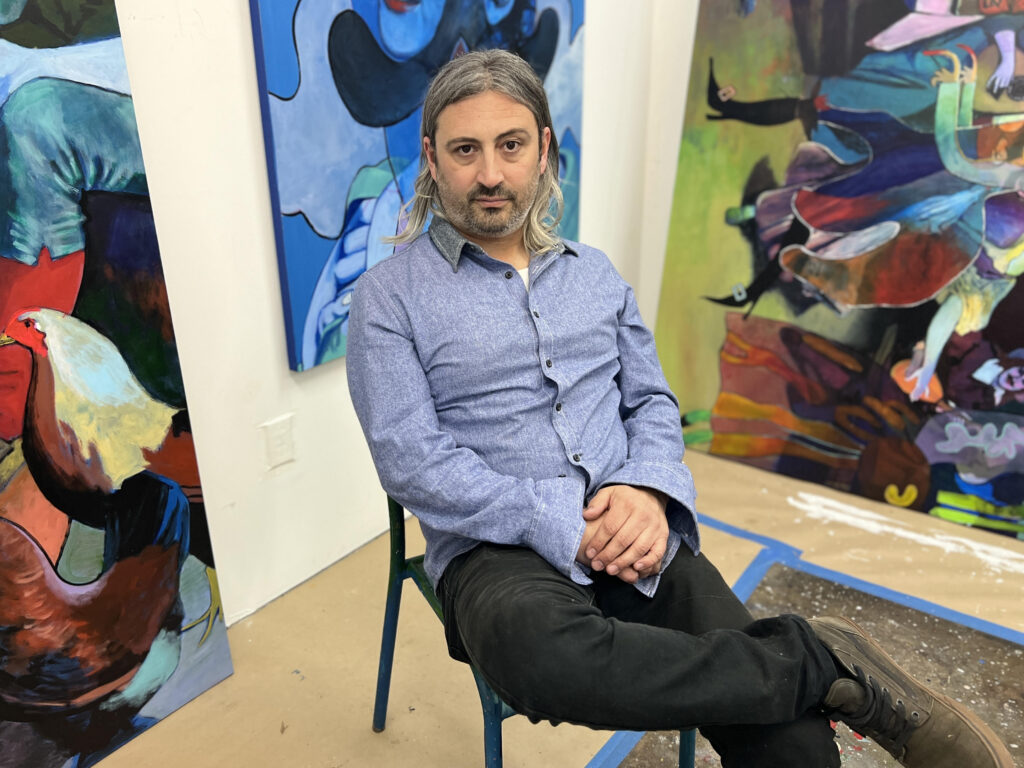
NB: When did you first pick up a brush and what drew you to becoming an artist?
JP: The short answer is I first picked up a brush and fell in love with art making in my early 20’s, by happenstance. I didn’t grow up around fine art or admiring museum artists. It was the making of a painting that awoke me to the realization that I’d be making paintings the rest of my life.
Growing up, most of my creativity was spent writing and playing music. My father is a musician so I grew up studying music and learning instruments which eventually led to playing in bands with friends. So, the discipline of studying a creative practice was imbued into me at an early age. Eventually, when I left home for college, I wasn’t in a musical band anymore, I was just a guy trying to figure things out. So in college I signed up for a foundational art course and I remember feeling a little guilty, like it was a waste of my education. I was thinking ‘why am I doing this? I’m not an artist’. However, I took the course and I absolutely fell in love with art making. It reminded me of making music because I experienced it as a meditative process where my brain was clear and I followed an inspiration to fruition. Making art has fewer rules than making music and you don’t have to perform for people which is a part of music making I don’t enjoy. I discovered that I enjoyed making art so much more than making music. I wasn’t thinking about becoming a career artist at this point, but that evolved over time.
NB: Your work is characterized by drawing inspiration from historical works. What are some of the artists or art history periods you draw inspiration from the most? Why these?
JP: The first thing to say is that many of the historic artists that inspire my work are historical inspiration as opposed to technical artistic inspiration. When I look at Frans Hals or Johannes Vermeer, for example, it’s the fact that they painted scenes of leisure and everyday life, where people relate to each other, that inspires me far more than their impeccable detail or technical virtuosity. Looking at art history allows one to time travel.
Visually, I feel that the way I employ layers of figuration atop the historical references creates an effect that appears similar to cubism at times, although I am not making cubist paintings. It’s the layering of references that naturally creates the result. Then there’s influence from the psychedelic rock n’ roll poster art from the 1960s, which combined Art Nouveau with clashing neon colors to make their look, and of course the musical references of the day.
When I was studying art history a lot of movements were introduced as if they’re in opposition to the movement before them, but I don’t feel like I’m on a timeline. I like it all: I love abstraction, I love surrealism, I love historical, academic, painting and all for different reasons. Why not use them all? In one sense, my work is about time, but it’s about how it all blends together and not so much about a chronological order.
NB: OK so then how do you approach the canvas? Do you do sketches at all first?
JP: No, I don’t plan out the compositions. In my studio I have numerous folders of inspiration, categorized by many things I’m interested in, including time periods, ideas, and moods. I use the folders like a DJ would use albums and turn to them over and over again. Once I land on an idea that I think is compositionally interesting, I start painting a version of it on canvas. I anchor the painting with a historical reference and then once that’s ready, the real painting, layering, and expression happens.
NB: So can you tell us about the characters and subjects in your paintings that are often drinking, celebrating, and performing? What is interesting to you about these scenarios?
JP: What’s interesting to me, and what’s the most fun about these scenes of taverns, is that they’re scenes of basic human nature. I feel like despite all the changes that happen through time with science and technology, human relations is still a universal theme. I recently marked out something that curator and writer Kathy Battista wrote that I loved: “Despite changes in technology, politics, fashion or health standards, humanity remains the same across epochs. We eat, we work, and we long for meaningful connection with our friends, lovers and community.” I feel that’s the gist of it.
In my paintings, I often include a Bard. It’s not a rule, but there is often a musician or someone playing music. I have an affinity for the multifaceted agency of the Bard: they are the fool, the story-teller, the brave traveler, and inebriated comedian. Though I prefer the solitude of my studio, I relate to the trope of the Bard.
NB: Yes, I remember your most recent show at Rachel Uffner was called ‘Serenade’.
JP: That’s right. And my last show at Anat Egbi was called ‘Tambourine’. That’s because they are about music and I think paintings can be heard like a ‘moment of still music’ somehow. I suppose I view myself as an ‘art Bard’ in some way. Shakespeare was a Bard. Bob Dylan is a Bard. A Bard is all about sharing stories about the human condition and then people hear the stories and retell those stories and so on. The literal embodiment of passing time through song and story. The Bard is akin to the fool in terms of historical work. It’s a character that can reveal universal truths while also making fun of the king and the absurdity of the system. I like Bards.
NB: As you were talking I thought that I see that the larger scale works are more of these group scenes and the smaller paintings appear to be more detailed shots. Could you just talk a little bit about that?
JP: I think of the smaller detail works as suggestive fragments or crops. It could be about the touch of one hand on a shoulder, or the dangling of a shoe that really exemplifies another layer of what’s going on at any moment. In the original painting that I’m pulling the crop from, let’s say there’s a wash maiden who’s just dangling a shoe – yet cropped on its own it suddenly becomes so much more, you know? It’s suggestive of domesticity, intimacy, leisure, flirtation, exhaustion, etc
NB:So let’s talk about color palette, and how this relates to the themes you explore.
JP: I’m very affected by the 1960s explosion of psychedelic art and the psychedelic music that the art corresponded with. I think of the psychedelic light shows taking place behind live music groups and how the colors and forms change and go with the music. These early pioneers of popular music were sort of like the Troubadours of new sounds and new ideas. In my work, like in those rock posters, I’m interested in colors that move and clash against each other. Glaring orange and green fonts outlined in neon pink make the eyes move all around the image and suddenly you’re in that dreamy, trippy place. That’s where I like to be.
The fragments or cropped paintings rely on color play a lot of the time. They’re mostly blue with just a hint of red that accentuates what I was describing as a ‘moment’.I’m painting historic images, but then by giving them these contemporary colors it makes them live somewhere in between past and present. The colors sing out to me, ‘life is but a dream’.
NB: So last question, what are some projects you’re currently working on? Any upcoming exhibitions you’d like to share with us?
JP: Right now I’m working towards a solo show that will take place in early 2025 with Rachel Uffner Gallery in New York City. I also work with Anat Ebgi Gallery in Los Angeles and things are coming up there soon as well.
April 1, 2024
Artist to Watch
MICKEY LEE
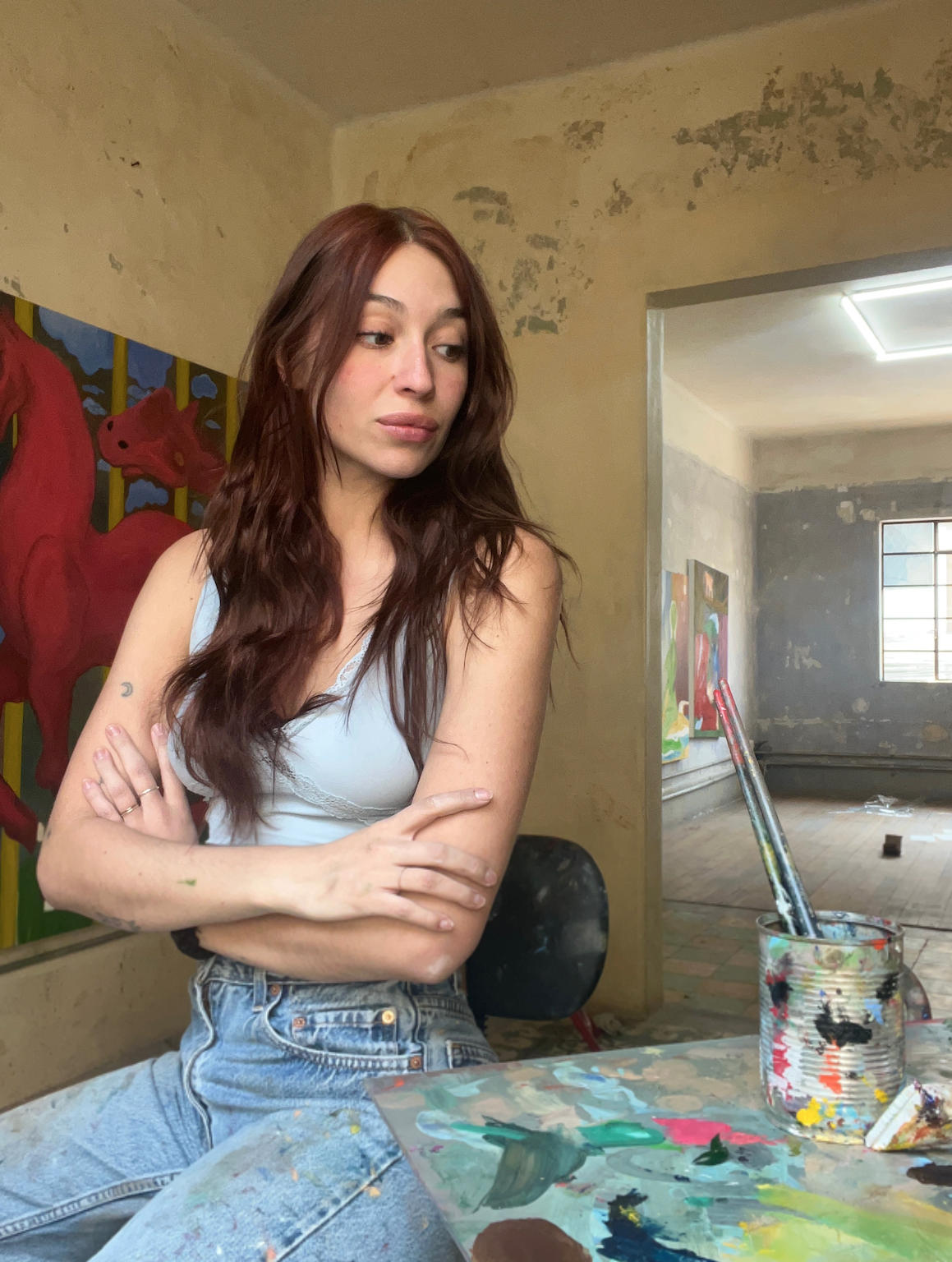
NB: So what are some of your earliest memories of art? What aspects of those early encounters remain relevant to your practice today?
ML: My earliest experiences with art are with my father. He is a woodworker and he had his own shop, so I would often go with him while he was working. To keep me occupied he would give me scraps of whatever was around, whether it was paper or pieces of wood. He had those pencils that carpenters use that are kind of flat and fat and thick or leftover house paint, just sort of whatever materials were there. Anything to keep my hands busy.
Also, when I was young, I struggled with speaking. Although I knew how – I refused to. So my dad realized that my way of communicating or to see what was happening within me and if I was OK was through my drawings. I credit him a lot for having that as a method of communication and it was something that just continued to develop.
The imagery in my work has a very honest, uninhibited quality to it, so maybe not much has changed from those early encounters.

NB: Great! So let’s talk a little bit about your process. How do you approach each new painting?
ML: That’s a good question. That’s a tough question. I draw almost every day, almost every morning. It’s the first thing I do when I wake up, it’s sort of my version of note taking. So if I have something going on in my brain, putting it to paper is the first thing I do. And then when I’m approaching a canvas, I look through my “notes”, my studies, and I kind of flesh out what story is being told and what images and characters are speaking to each other.
I think storytelling is really what my work is rooted in. Each piece is sort of its own ‘fable’. The story unfolds as I move through the canvas and build out these characters and the world they live in. I don’t always know where I’m going. It almost feels like working with a block of clay, you’re taking things out and then you’re putting things back in, there’s a push and pull to the painting. I’m surprised by it sometimes, just as much as the viewer. The paintings, moreso the figures, reveal themselves as I keep painting, I often feel as though I’m under their lead.
NB: Can you tell us about the way you portray the female body in your paintings and the characters that surround it, like the rabbits, the babies, wolves, and spiders?
ML: The figures are kind of me and kind of not. They’re an idea of something, whether it’s something ugly or beautiful, that is how they take shape. I enjoy playing with the idea of the nude figure, especially if I see myself in it, being distorted and exaggerated. I like them a little grotesque. You have to remember that the word grotesque is not necessarily a synonym with “gross” but an umbrella term for strange, mysterious, magnificent, as well as disturbing or ugly. That is how I feel. That is how this world is, and theirs too. Strange, mysterious, magnificent, disturbing and ugly.
Now the animals – I simply love them. They are fantastic story tellers, they’re such an excellent vehicle for conveying things that are unpleasant without being overtly salacious. They’re just as much, if not more, of the narrators of the painting.
NB: Where do you draw your inspiration from? What are some artists or aspects of life that are significant to you and your practice alike?
ML: Expanding on what I was discussing before with the animals- you know how Cecily Brown was able to do these orgy scenes with rabbits, right? Even though it is a violent orgy scene, it’s more palatable because they’re bunnies. I like that trickiness and I am always attracted to something that has a dark undertone or that is immediately unsettling. I want to be challenged. I enjoy having to visually dig through an image and having to keep coming back to it. I think a really great living artist that does that and who also explores sort of this mad genius ugliness is Dana Schutz.
Although my favorite artist in the entire world is, Maud Lewis, a folk artist from Nova Scotia. She too painted lots of animals in the bright and cheery landscapes of her home. The work is nostalgic though, there is something that makes your heart cry a little bit. Perhaps it is the honesty. I think she was ahead of her time.
I love pretty things like rabbits and trees and flowers, but I also want my stomach to turn a little bit, you know?
NB: So, you moved to New York last year and you’re now in Mexico City. What’s next? What are some future projects, exhibitions, or places that you’ll be visiting that you would like to share with us?
ML: Right now, yes, I am working in Mexico City. Though I return to New York in April, and all of the work I’ve made here will be coming back with me which is exciting. As for the near future, I have a small solo in East Hampton that I am very excited about, as well as a show in Stockholm with Loyal Gallery at the end of summer. The future looks bright, I get to keep painting, which is all I can ask for!
March 4, 2024
Artist to Watch
YIRUI JIA
NB: Your paintings evoke a sort of childhood nostalgia. Can you tell us about how your practice has evolved over time and how you either deal with this nostalgia or keep the inner child alive?
YJ: That’s just who I am, being honest about what I feel and being honest to the painting. My practice is more like a play, like flying a kite. I lose the string first and then it’s all between gaining and losing control. I always start with losing control then pull some control back. It’s always the painting that leads me, although sometimes it leads to a dead end. Then I just start over.
NB: Who are the characters in your paintings? Where do they come from and what do they represent to you?
YJ: I used to have many characters that went in and out of the frame, but for this new series I’m focusing more on their solo presence. A lot of my most recent works are about the astronaut, the bride, and the skeleton. This painting behind me is sort of a mix because I painted pharaoh figures before and I’m very amazed by the visual look of the pharaoh’s head cloth – its shape feels so fictionalized and scenic, the pattern and volume… So this figure is actually a mix of astronaut outfit and pharaoh head (Home…..sick, 2023-2024). Then there’s the girl, I call her ‘The Bride’, and there’s the skeleton, that little guy over there (pointing at skeleton painting).
For me, all these characters are connected and they morph between their visual forms. I began with the female character ‘The Bride’, which I think has some reflections of myself, fearless but at the same time sentimental. When I was painting the white dress, very loosely, I started to see this translucent, almost structured outfit. That’s how the dress evolved to a physical shell or a cocoon of the figure, similar to what an astronaut suit means to an astronaut. Conceptually the astronaut for me is about someone who’s devoted themselves to outer space – to the danger of the unknown. As for the skeleton I think about how we are all skeletons with different skins, which is also at the core of all the other characters. The skeleton resonates with the astronaut in a funny way visually because I like to think that this astronaut I paint could undress from their white NASA outfit into a skeleton. The astronaut sounds futuristic, and the skeleton belongs to the past, so you have the past and future meeting in one character.
NB: Would you describe your painting process more as storytelling, or as a play/game with paint? (Perhaps both?) What does that look like when you’re working on a new piece?
YJ: In some of my early paintings there may be a feeling or a sense of narrative in them, although the narrative parts seem very fragmentary and temporary to me. The parts that seem to be narrative are only fragments of information. In other words, the visual forms and shapes of objects are always more important in my paintings than how they serve the painting to ‘make sense’. My newer works start to lose that intentionality and external narrative, they rather feel more grounded and internalized, with more dimensions and depth of emotions.
NB: We are now in your studio. What do you keep in here that you draw inspiration from?
YJ: I draw inspiration from how I feel in my life. I had a honeymoon period with New York, because I moved to the city a few years ago from a small town, Gettysburg, where I went to college. So at the time the paintings were about all these sorts of objects, dissonance, speed and city life. There used to be a lot of objects that would fly in and out, like cigarettes, cherries, matches, lips.
As I stay longer in the city, I feel I’m more and more internalized. Now I tend to go back to natural things like flowers, weather, and seasons that are always around – I think they convey a more pure and liberating feeling.
NB: So can you tell us about your upcoming exhibition with Mitchell Innes & Nash? What would you like to highlight about this new body of work?
YJ: The show will open on March 14th, very soon! I’m done with the big works and now I am just spending the last months finalizing the sculpture and some smaller works. I think there’s been many changes since my last show. The latitude of the paintings is expanding, and there’s definitely more personal emotions and more sides of me reflected on the new works.
December 21, 2023
Artist to Watch
PATRICIA GEYERHAHN
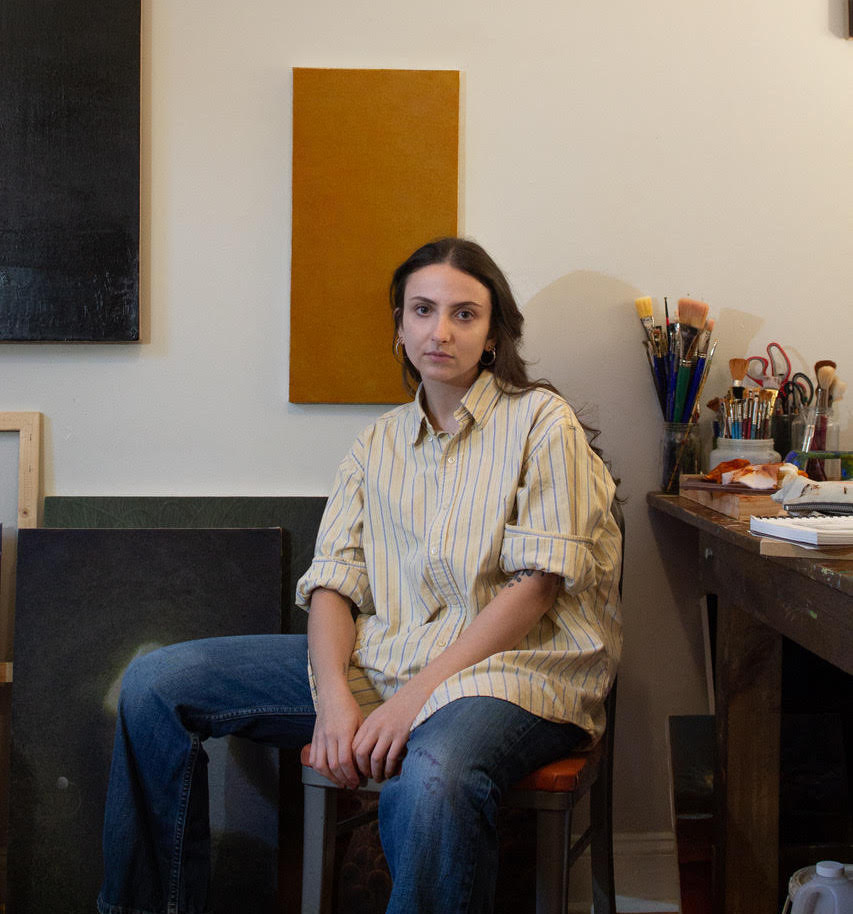
NB: Can you tell us about some of your earliest memories of art and your recent experience completing your BFA?
PG: My grand dad on my father’s side is an art collector in Brazil so I was exposed to a lot of art from a very early age. His house and our house were used as storage for art, so there were always paintings around. My grandmother was an artist too, a painter, poet, musician, and philosopher. She was probably the person who inspired me the most to become an artist. Although she passed away before I was born, I heard stories and was sort of identified with her a lot by my parents. I would be drawing all the time when I was younger, and they would be like “Oh! you’re just like her!”
In terms of my BFA I was doing a dual degree with philosophy and since I was partially educated during the pandemic, at times there was a big limit in terms of what I could make. Being forced to stay in made me obsessed with the idea of ‘internal worlds’ and ‘virtual worlds,’ ‘places’ beyond those that we physically exist within, and so I was painting a lot of smaller works that I could escape into.
Later on for my thesis, my sense of self felt very far from my body, so for my thesis I tried to bring myself back to my body through bigger body movements, therefore working at a larger scale. I went from painting small (more intimate) pieces where I was really isolated in my practice, where my movements and gestures were really small, to larger size canvases depicting more complex relationships. In some of my earlier works, I have this bulb-like kind of flower based on a dandelion, a symbol of a possible wish, that came back during my most recent work.
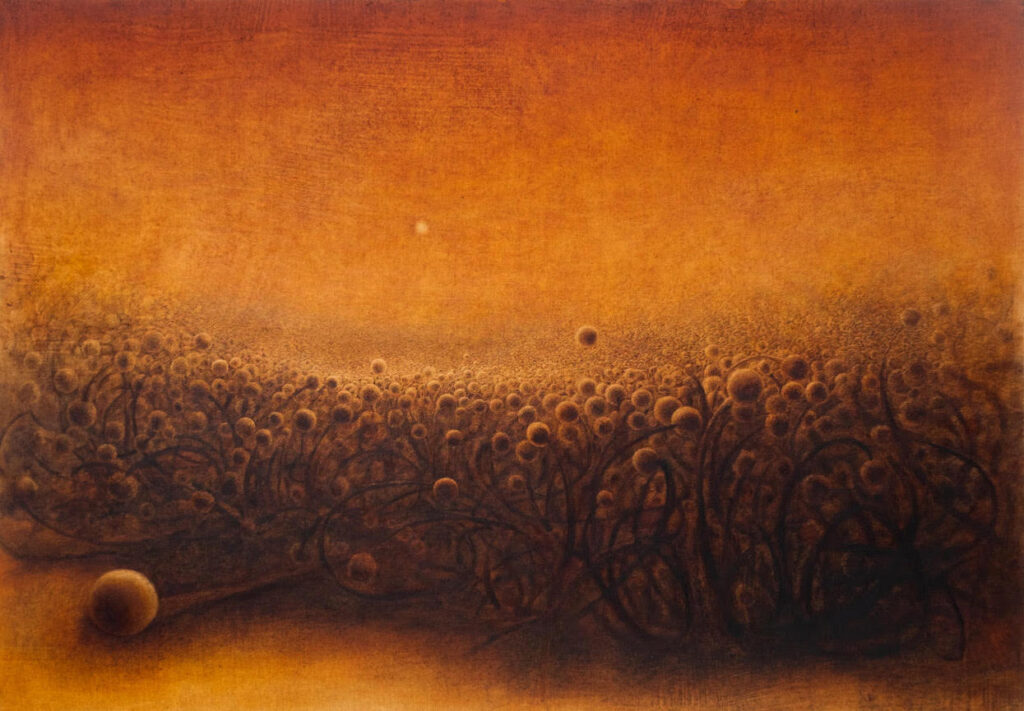
NB: What’s your process like? When you begin a new painting or a series of works, where do you draw your inspiration from?
PG: I think primarily it’s from emotion, because my works are metaphors of people and relationships. In terms of what the work looks like II’ll often get a vision or an image in my head that I think comes from my subconscious. There’s something about it that just really speaks to me even if I don’t fully understand it, so I try to understand as I work on it. There are times I try to depict ideas from a more intellectual route, where I think about how to use this language that I created for myself to illustrate an idea I think is important.
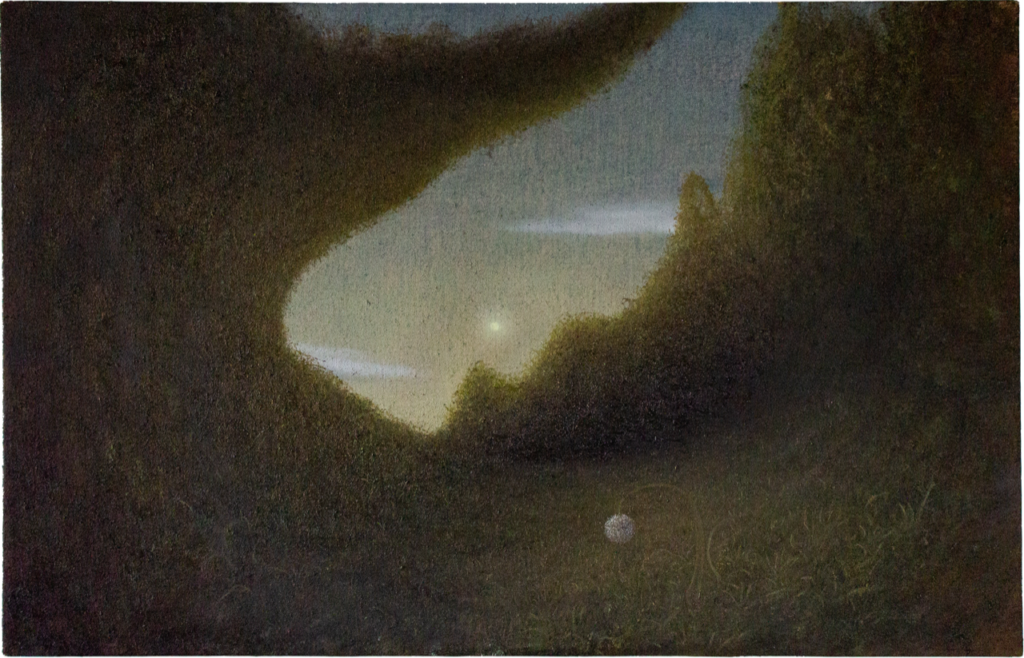
NB: Well, that’s actually a great segway into talking about your most recent show and recent body of work Doppelganger that was on view at Andrew Reed Gallery last month. Can you tell us a little bit about that?
PG: It was an amazing opportunity, my first solo show right out of my BFA. It started with Andrew seeing a piece from my thesis and really liking the work. We met up and after talking a bit he included some pieces in a group show and a few months later he asked me if I was interested in a solo show at his Tribeca gallery space. I was like ‘Oh my God, I can’t say no!’ And so he was like ‘OK great, it’s in four months and I think it should be a whole new body of work’. So it was a lot, and since I didn’t have much time I just pulled from whatever ideas I was thinking of at the time: After my thesis I was thinking about how I reduced all subjects to just this one icon, a sort of repetition or symbol, which made me think about how we’re all just people and we are all the same to some extent. There were also some painting marks I had noticed I kept making over and over, very repetitively without thinking. They were becoming copies of each other because I kept using that same motion, same symbols and color palette—so the word ‘doppelgangers’ kept playing in my mind.
Also, when I was brainstorming the show with Andrew we spoke about loss and it stuck with me. I began thinking about how, even if you lose a person, they still have an imprint on you and you have an imprint on them. In a way, if you spend time with someone for long enough, it’s almost like you become mirrors of each other in many ways, especially if you spend a lot of time with that person, or are codependent and enmeshed.
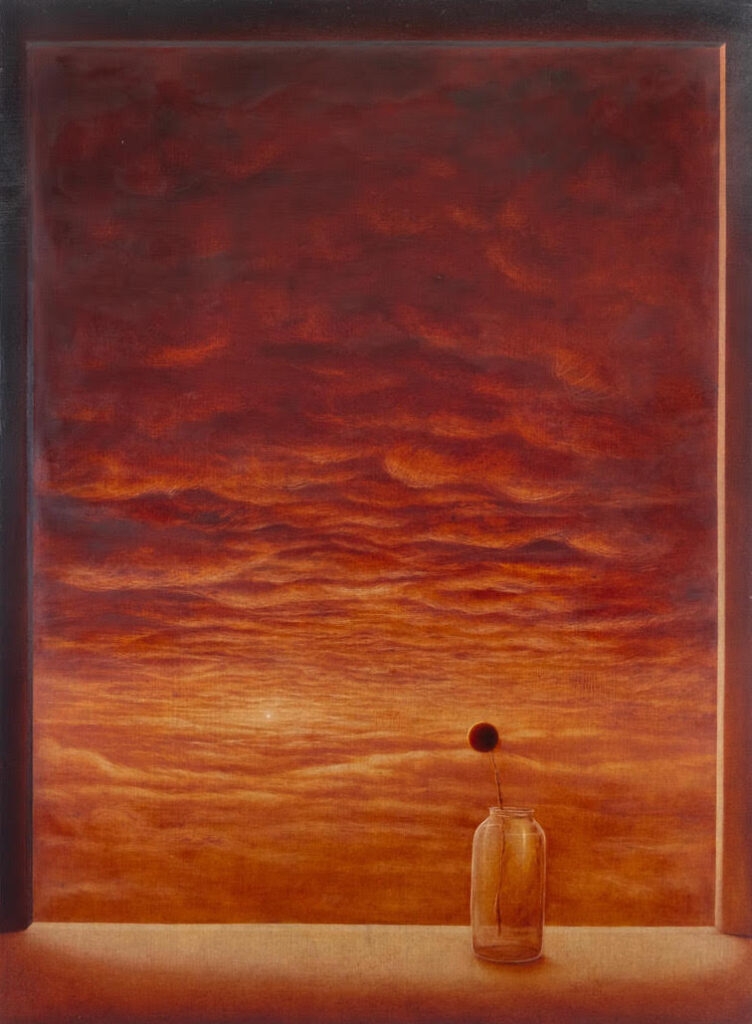
NB: Why don’t we talk about your use of color and how that is related to the themes that you explore in your paintings?
PG: The kind of red I have recently been working with in my thesis and Doppelganger was a bit of a random thing that just stuck with me. I heard this story on a podcast about a woman who had a fourth color cone (another red) in her eye. People usually have three color cones, and we see colors differently than other animals which have different sets of color cones. This woman specifically could see more reds than the average person, so when she looked at the sky she said she saw red in the sky.
There was another story in that episode where a color scientist asked his kid ‘what color is the sky?’ and the kid couldn’t answer, he hadn’t been indoctrinated into just labeling the sky ‘blue’. Red became this color my mind associated with whats beyond things, or with things being more than what they appear to be. When I paint with red, when I use repetitive symbols, I’m reducing the things I’m painting, like when I’m painting a flower but it’s just a ball and a stem, the simplicity leaves room for interpretation, for the stem and ball to be a head and a body, for red to be red but also subtly complex.
I also have a background in black and white photography, so I do tend to see things in light rather than in color, therefore ‘monochrome’ makes more sense to me. I was feeling very overwhelmed by color and limited by it because I felt like I had to do it correctly. There’s so much science to color theory I felt like it was holding me back to some extent because I’m a bit of a perfectionist.
NB: Can you tell us a little bit about your upcoming projects or exhibitions that you’re most excited about or are you in recovery mode?
PG: I’m in a little bit of a recovery mode. When you’re working in a big body of work you put away certain ideas, like random split offs that in this case didn’t necessarily make sense for Doppelganger, so I’m working on those pieces now that are fun and exciting to me but unrelated to a bigger project. Also, my partner Devin Düster is the one that made all the frames for the Doppelganger pieces, and I would like to learn how to make them myself.
I am also now represented by Andrew Reed Gallery, which is very exciting. So there will definitely be a few projects coming with him.
November 21, 2023
Artist to Watch
KATINKA HUANG
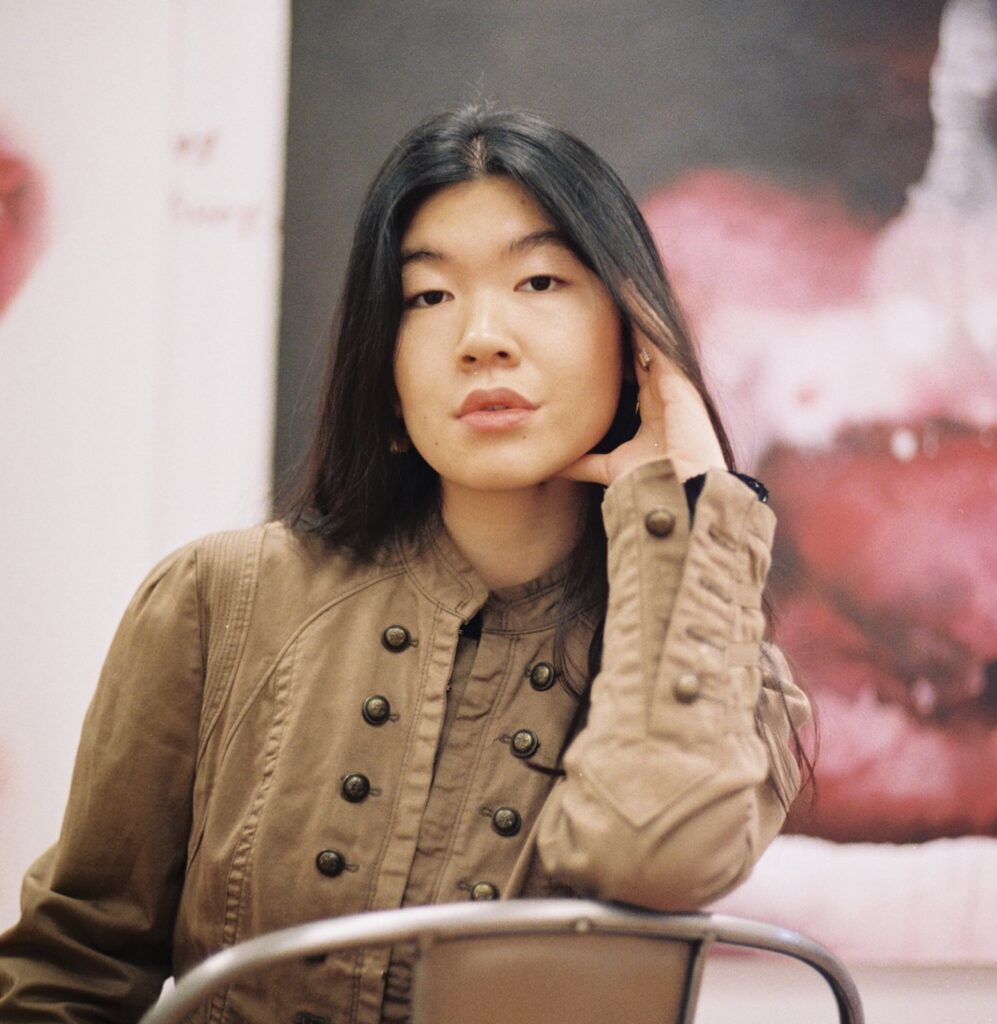
NB: What are some of your earliest memories of art and how does it relate to your work today?
KH: My earliest memory of art was drawing people in my grandmother’s living room and trying to make a perfect circle for the head with a jar cap and she was like ‘you know heads aren’t perfectly round’ and I remember having a sort of revelation. I think that sparked an interest in art as I started paying closer attention to details, and the ways we decide to represent what’s in front of us.
I grew up in Shanghai, and moved to London when I was about 11 years old and went to an all girls school there. Shifting from East to the West at such a young age and going into a totally female centric environment was definitely a shock. I was surrounded almost entirely by women, most of my teachers were women, my friends, and my ‘housemothers’ who were the women who looked after us and put us to bed…
All of that really ignited my interest in exploring the female psyche and female body, comparing and exploring the difference between the ideologies of femininity in the East and in the West. I create these satirical images of women, giving them kind of animalistic bodies. It’s all about diving into absurdism and capturing those raw and turbulent emotional states through the figure. The female body in my work is always a site that rebels against the ‘sophisticated’ portrayals of women across culture.
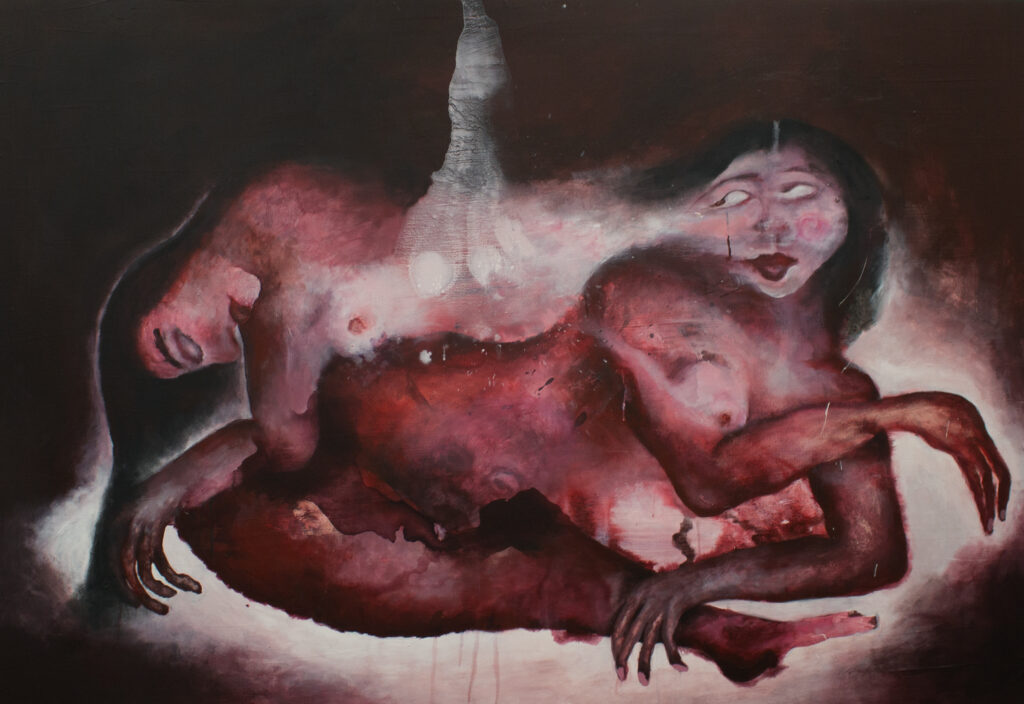
NB: Let’s talk about your process. Where do you begin? How do you approach a painting?
KH: I never really plan or sketch before I paint. I do a lot of drawings and small canvases, but I don’t consider those sketches, these are works on their own. I don’t have a premeditated narrative, simply because I always want to focus on the body first. I wet my surface and I spontaneously draw a very vague figure with acrylic paint. I let the paint really seep and bleed into the canvas, forming its own shape. And then through these abstracted organic shapes, I find a figure and a narrative. It’s similar to cloud gazing where a familiar form emerges when looking at clouds.This is how the bodies are found in my work, and I allow the material to do its own thing and really guiding the direction of the work.
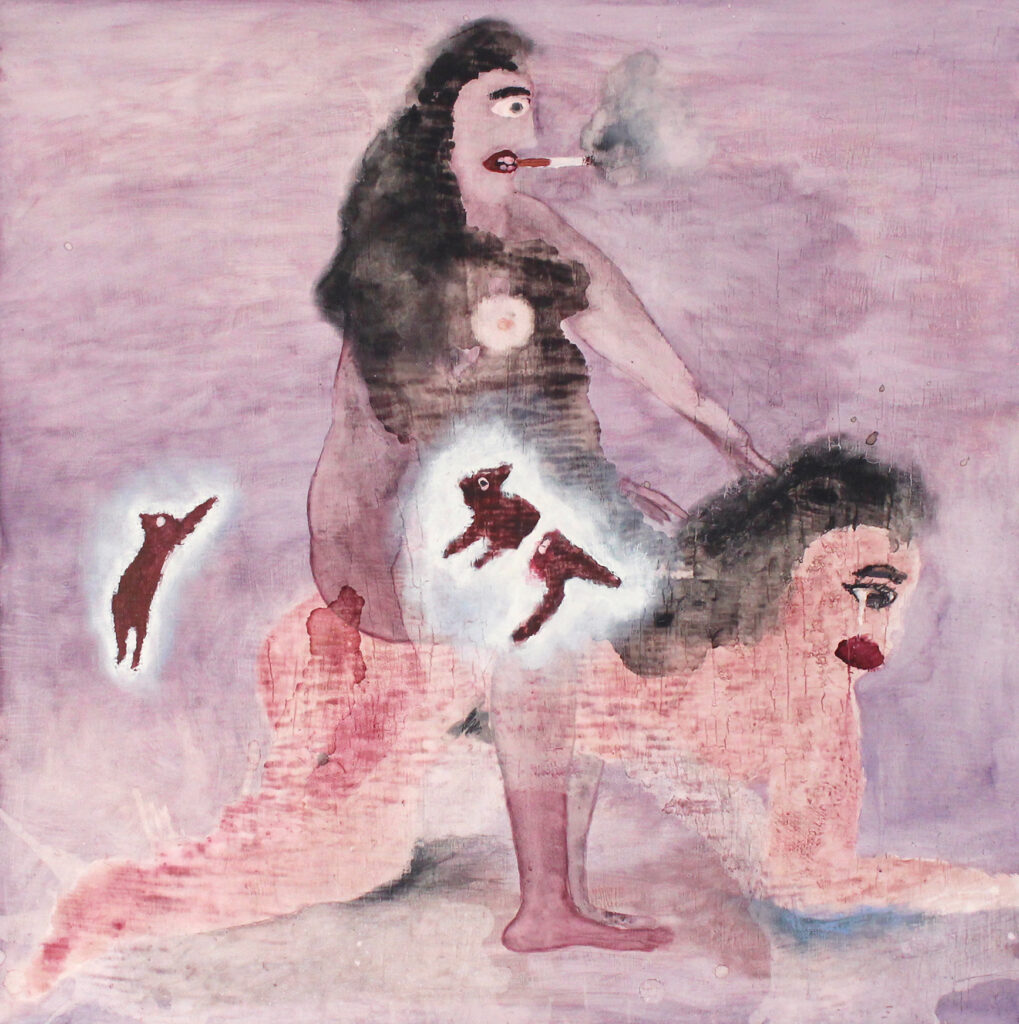
NB: Can you tell us about the theme of the female body and womanhood?
KH: I am really intrigued by the history of female hysteria and the accounts of witchcraft. Many women were labeled and punished for being ‘witches’ or considered ‘hysteric’ simply because the female anatomy and behavior were misunderstood. I am really fascinated in exploring how misconceptions of the female body led to the ongoing sensationalization of women. French neurologist Jean Charcot attempted to uncover the root of female hysteria using hypnotism to identify mental disorders. Charcot experimented on mainly marginalized women who displayed dramatic symptoms associated with hysteria such as thrusting, contorting, convulsing and shaking, in front of male spectators. Charcot’s sensationalized displays of ill women were popular amongst his male contemporaries in the auditorium at the Salpêtrière.
History aside, I want to address how society sensationalizes women today especially on social media and in films. Take Jennifer Coolidge’s character in The White Lotus, for example—she’s this mix of needy, sensitive, obsessive, simple-minded, neurotic, and sexual, which basically sets her up for some serious mockery. Or Britney Spears back in 2007, whose spiraling mental health was exploited by the media used as a source of entertainment. I’m looking into how today’s culture dishes out images of ‘unhinged’ women, and consequently the women I paint are painted in a similar way, never depicted in an ‘appealing’ way. It’s always slightly morbid, slightly grotesque, and you can say it’s confrontational.
NB: How does your use of material and color relate to those narratives and themes in your paintings?
Well, my color palette is red and flesh tone oriented. For me red is a symbolic color, it echos vulnerability, passion and conflict which are subjects that I explore in my work. But more than anything, I’m just really attracted to all tones of red. Not all of my paintings are red but I certainly always start with it. Red really resonates with me, sometimes I think my aura is red.
The cigarette and long black hair in my painting are both symbols that connect the characters to me. These are not necessarily self-portraits and I’m not a chain smoker, but I wanted to bring these fantastical, often beastly looking women in my paintings down to earth reinforcing the fact that they are human and they have a bad habit, and that’s ok. It’s a sort of play on how these figures can be so uncanny yet human at the same time.
There’s also a ‘dog looking’ creature that repeats across a few paintings. This came from the ancient diagnosis of the “wandering womb”. Doctors would diagnose women with the “wandering womb” when they were unable to explain the cause of the illness. The wandering womb is when the womb “ moves around your body” causing all sorts of ailments. This diagnosis was taken seriously because the female body and organs were a foreign site in the world of medicine run by men. So the ‘dog’ is sort of a symbol of the wandering womb. It’s not really a dog, but rather a little creature that meanders around the body mocking the absurd misconceptions of the female body and and echoing the enigma around the female psyche.
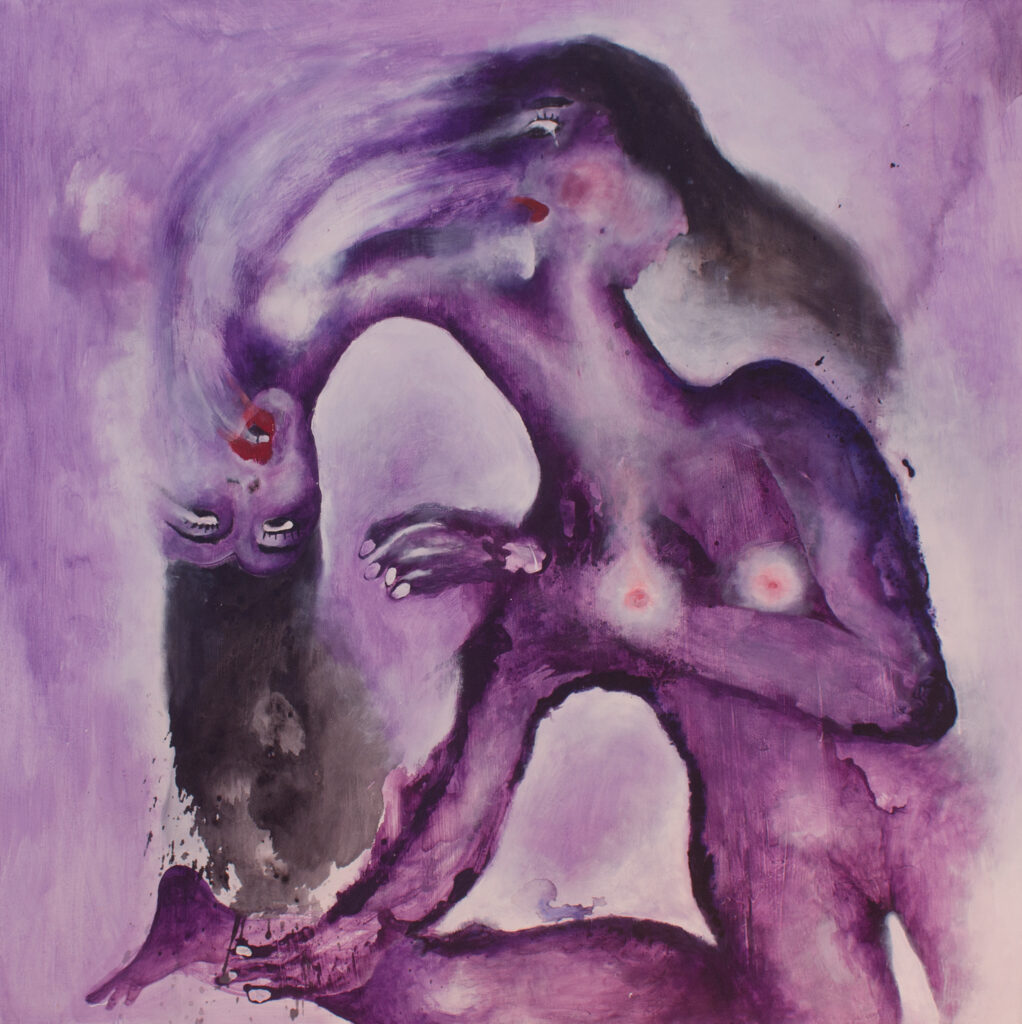
NB: So what are some current and upcoming exhibitions that you’re excited to talk about?
Currently in New York I have a show at the Latchkey Gallery. It’s a newly renovated viewing space within the gallery at 173 Henry St and it’s open until the 22nd of November. I also have a two person show with artist Claire Bendiner coming up at Galeria Leyendecker in Tenerife, Spain on view through December 16th.
October 26, 2023
Artist to Watch
CHRISTOPHER PAUL JORDAN
NB: Can you tell us about your experience with art before starting or completing your MFA and how you arrived at where you are now with your practice?
CPJ: I’ve always thought of myself as a public artist. I know perhaps that’s a bad word in the Gallery scene but there’s something about work that has a sense of collective ownership that has always resonated for me. Over the years I’ve created a lot of public murals, but throughout the displacement and forced migration of thousands of folks out from my hometown a lot of these murals ended up lost, painted over, and removed. I also grew up next to a salvage yard that has remnants of Black neighborhoods demolished over the past 60 years. Some of them were torn down when i-5 was built. That made me want to create. So as I struggled to maintain my sense of home despite the world around me being shredded to pieces, I started painting on fragments of buildings and houses and eventually window screens.
There’s something about the way that screens respond to the brush, pushing back and even fighting against me. Painting a window screen is to some extent a futile process, the paint falls right out, so it takes layers, and layers, and layers of activity to have a surface to begin with. Negotiating with futility, with the completely illogical compulsion to do something like paint at the world’s end…I didn’t realize it at first but painting the screens had physicalized my process of working through grief. A lot of the material in my paintings is me reckoning with the experience of loss and surrender. What excited me about grad school was equally what scared me the most: the reality of leaving home. School took away my defense mechanisms and challenged me to develop a deeper faith. Both my own creative power and that power of my community. A power that won’t be stopped.
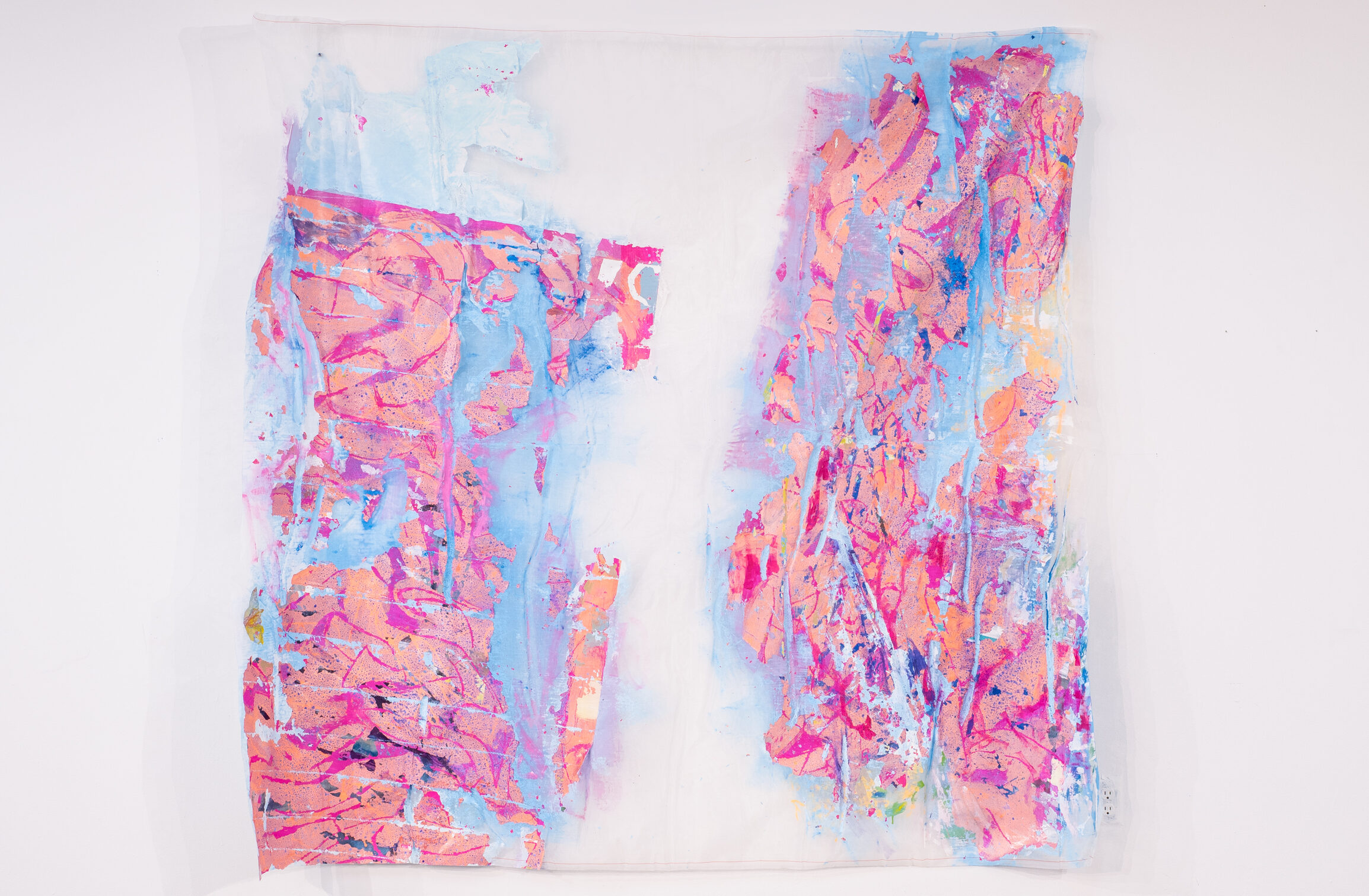
NB: Let’s talk about your process. Where do you begin? How do you approach each new painting or installation?
CPJ: Each painting begins with the trimmings, the scraps, bones, and remains of the previous painting. I have painting ‘grounds’ that I re-use, each one with its own history that has accumulated over time. So the painting starts with me responding to fragments that remain on the surface. Oftentimes I work layering color on a surface over the course of months, not really knowing what it’s going to become. After cutting, reorganizing, and collaging together different sections, I use a window screen material to peel those paintings off of their original surface and see what kind of information is left behind.
It’s funny because during school I went through a kind of horrible breakup, and that final loss pricked open my unaddressed grief. Grief of my own estrangement from my parents, the loss of family and friends, grief of the loss of my spiritual home. So I’ve ended up working essentially with separation, peeling and painting off, or ripping apart, seeing two things that are interconnected, and the ways that their histories are forever embedded in one another. The process of painting has really deepened my understanding of the way that experiences of relocation shape us (whether in terms of forced migration, family estrangement, or changes in relationships) and I’m learning about how all these losses contribute to who we become. When I look at some of the paintings, all I see is the pieces that are missing. Actually, in order to convince myself to let work go, I had to actively start painting memories that I needed to separate myself from. In some ways, I think that the loss these paintings undergo helps me appreciate just how vulnerable and how fleeting our memories are.
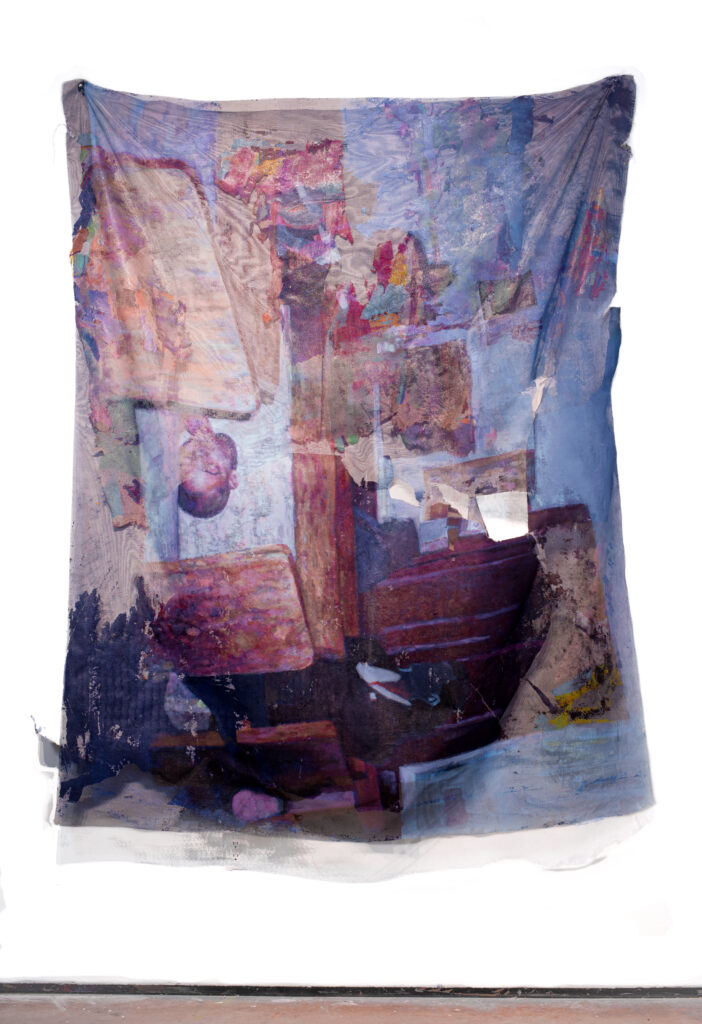
NB: Beautiful. How do you relate your painting process and photography, to the themes of memory and the internet?
CPJ: There’s this concept of ‘living systems’ that is fascinating to me. These are systems in constant change, like the human body or the weather and if you introduce a new element it is impossible to predict how the system will respond. There’s a degree of chaos, autonomy, and unpredictability, which expresses its existence beyond our control.
These systems relate to photography and the internet through latency, which is explained as the time delay between cause and effect. For example, we can talk about pandemics, whether we’re talking about HIV/AIDS or COVID, there’s a latent time between when an illness is introduced into our body and the period where we actually are able to recognize its symptoms and effects – which is a complex concept for us to deal with socially. In photography, the concept of latency is present when you are developing an image. The image isn’t there at first, but when dipped in this liquid and the image surfaces. So this concept of a latent image just fascinated me from the very beginning. I’d say my paintings are reckoning with the concept of latency in different ways: At a personal level, there are qualities of our parents and grandparents that perhaps we’re unaware of, and that suddenly get expressed through a new generation, meaning we can probably trace some of our most bizarre tendencies from family members generations back. In a way my paintings take shape in a somewhat similar way whether it is through the course of several paintings or maybe through just one painting: Let’s say you’re looking at the surface and you see one little speck of of magenta, but then you look back and there’s all this background of magenta, teeny dots of history peeking through little small quirks that are the sort of like latent histories, like ready to announce itself, ready to burst forward.
NB: So now, can you tell us about the subjects in your paintings? Who are they, how do you choose them, and how does this connect to your community?
CPJ: All of my images come from daily life, from about 4 to 6 years ago, and anyone in the frame is usually a friend, relative, or someone I’ve spent time with. It’s often the strange ones that speak to me, the photos I don’t understand. I paint them because I don’t understand them.
But my most painted person is Gwen Jones. She is the inheritor and manager of the salvage yard. She’s a photographer actually, and describes herself as my muse. She’s kind of an archivist of neighborhood history. My family lost the house where I grew up, and so the salvage yard, that space, is literally physically, the closest thing that I have to home. So I end up there with her often. In there the world disappears.
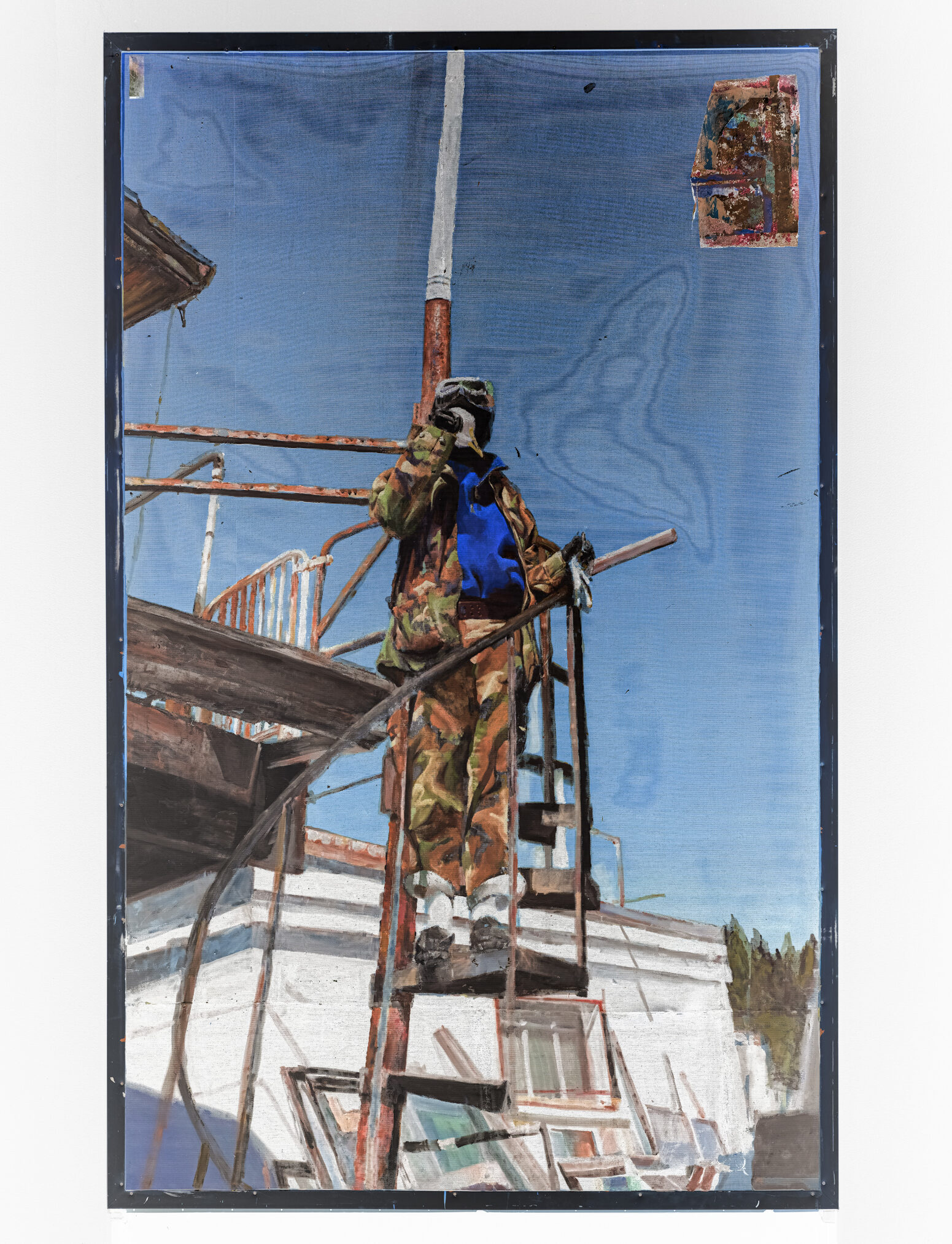
NB: What are some of your upcoming projects, residencies or exhibitions that you’re excited about?
CPJ: As far as public art projects I’m working on two large scale sculptures, they’re both around 35 feet. One is a freestanding structure and the other one is a suspended structure that’s almost like a metal tapestry piece. I’m working with a couple engineers on those pieces right now. My favorite thing about that work is that I can do it from anywhere, and so we get to collaborate online and play with different pieces of things, share models, etc. The sculptures will be sited along the new transit line between Seattle and Tacoma and Washington.
And at the moment I’m in Mexico City for a couple months working on a solo show at Naranjo 141. I’m reprocessing a lot of my own religious conditioning from early life, engaging with biblical rapture to work through aspects of fundamentalism, spiritual displacement, abduction, forced migration, and the all too common queer experience of estrangement from one’s family of origin. Honestly it helps being away from home to process some of these things. The exhibition here opens on December 9th!
September 27, 2023
Artist to Watch
CAMILA VARON JARAMILLO
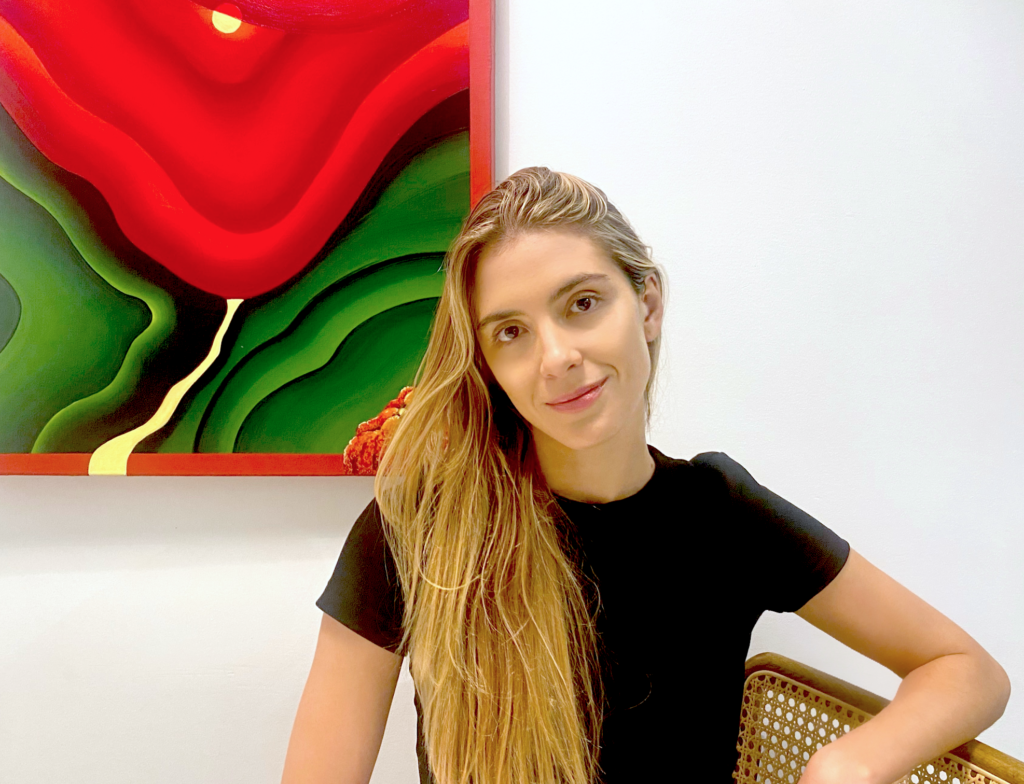
NB: What’s your earliest memory of interacting and/or experiencing art?
CV: When I was little I would come home from school and grab a block of printing paper, sit at the kitchen table, and draw through the entire block. I also remember feeling when I was younger that it wasn’t easy to meet other people or kids that were interested in the same things. Then, when I was thirteen, I visited New York with my mom and she took me to MoMA. I remember looking at some paintings and just being like “Wow! This person sees the sky same way I do!” or “this person sees flowers the same way that I see flowers!” And that sort of made me realize that “these people” were thinking in the same way that I was thinking.
My grandma always painted too. She had a room in her apartment filled with oil paints and paintings of (mostly European) landscapes. Looking back, her paintings were bright, and had a great sense of color.
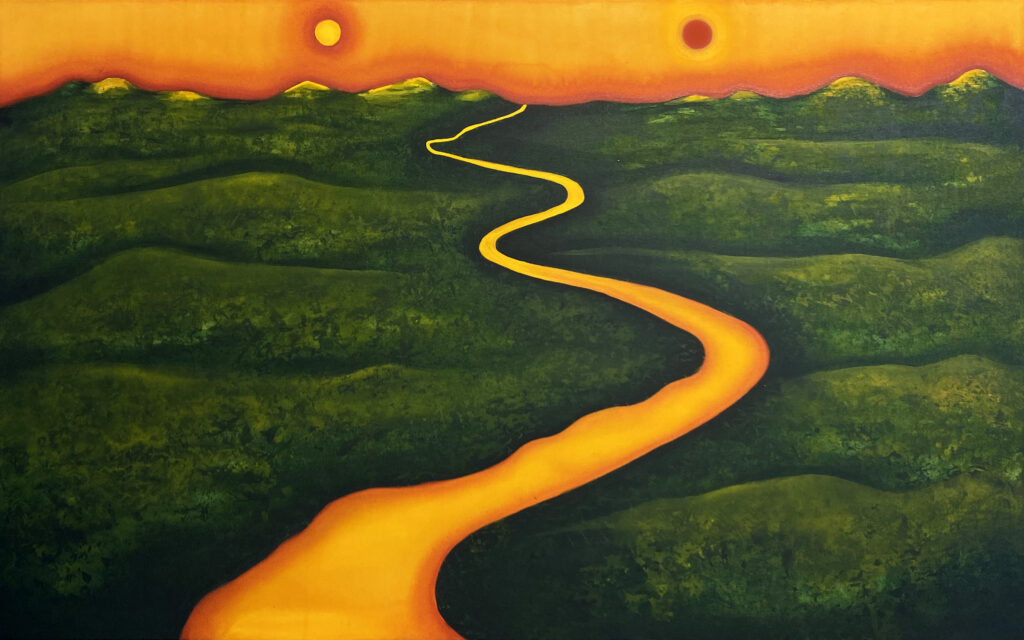
NB: Can you tell us about the themes of space and landscape in your work?
CV: As a young girl I always knew that I wanted to be an artist, but then I ended up studying architecture. Studying architecture felt like studying anthropology or psychology through space, and not so much physical spatial design. So what I learned was how architecture can affect or respond to people, communities, and places. Therefore over time every space acquires an emotional value, and what this means is that a space can affect you emotionally, it can alter your state of mind, and perhaps even shape who you are. So the surroundings that we chose, and more importantly the respect that we have for them, whether it is a constructed environment or a natural environment, has an immense psychological impact in every aspect of our lives and consequently the world around us.
In terms of landscape specifically, that in itself, is loaded with context because I grew up in Colombia, one of the most biodiverse countries in the world. I remember traveling and driving through the mountains, going up and down and around, seeing as the landscapes changed from one place to the other. Colombia has some of the wildest, most beautiful places in nature that I’ve seen, and all of them are extremely different from each other: there’s the Atlantic and the Pacific ocean, the Amazon, the Andes mountains (that splits into three), deserts, valleys and flat plains. At the same time, during the 90’s and 00’s Colombia was very unsafe because of the political situation with guerrillas and narcos, so many of these places were sort of mystical and magical because I grew up hearing about them, but not being able to physically go there, so there was a lot of imagination involved.
Colombia is much safer today, and my generation is sort of rediscovering these places that we grew up hearing of, and rediscovering our own country. I think this says a lot about the psychology of a generation that is interested in traveling within their own country and to nature rather than to other cities around the world. At a personal level, these paintings are perhaps a way to research and reconcile the fact that I am here, and not there.
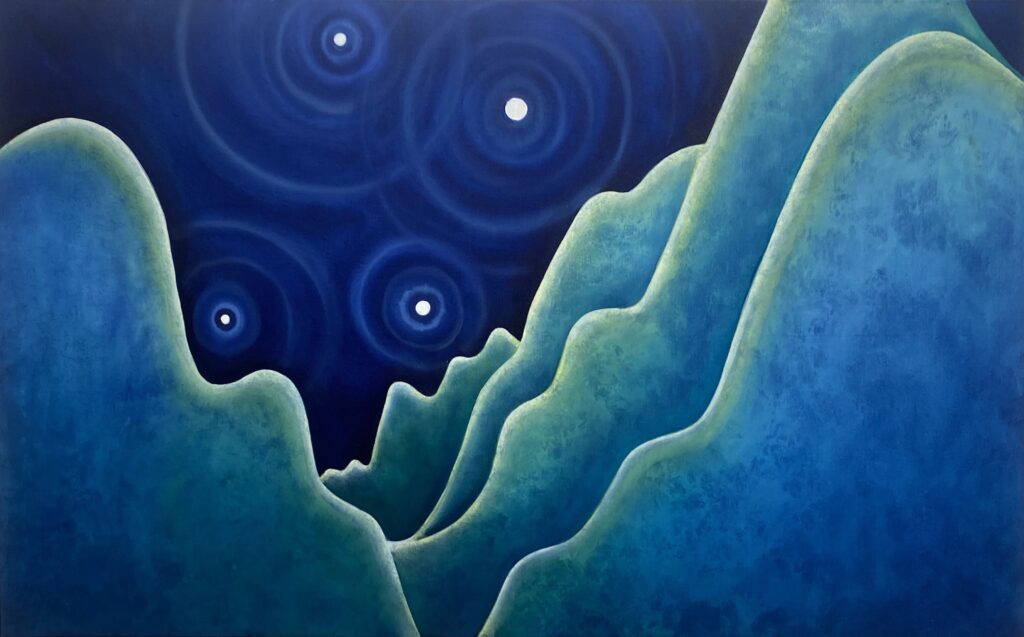
NB: How does your process, color, and material relate to these themes?
CV: When I first started to really focus on landscapes, I was trying to work in a way that would resemble how nature works in real life, so I could learn from it: Working with a lot of water, with movement, rhythm, light, and gravity. I think of these as the ‘common denominators’ and ruling elements of every living thing whether it is a landscape, a flower, or a human being.
While experimenting with textiles, I discovered a silk and cotton fabric that changed the way I used paint and that responded very well to these aspects of nature that I wanted to explore through my work. For example, the fabric allows a lot of light through, and instead of applying paint onto canvas, the fabric absorbs the paint and the color travels to where the surface is most ‘hydrated’. The process is also psychologically more freeing because there’s physically a lot of movement, like being on the floor and working with my hands, letting go of excessive control. These landscapes are created in such a way that they evoke the natural movement of the body, the fluidity of water, the lightness of the material, and the organic shapes that are created through a repetitive rhythm or vibration. All of this energy from the process comes to rest as a painting of a landscape, that then radiates this same energy through an image.
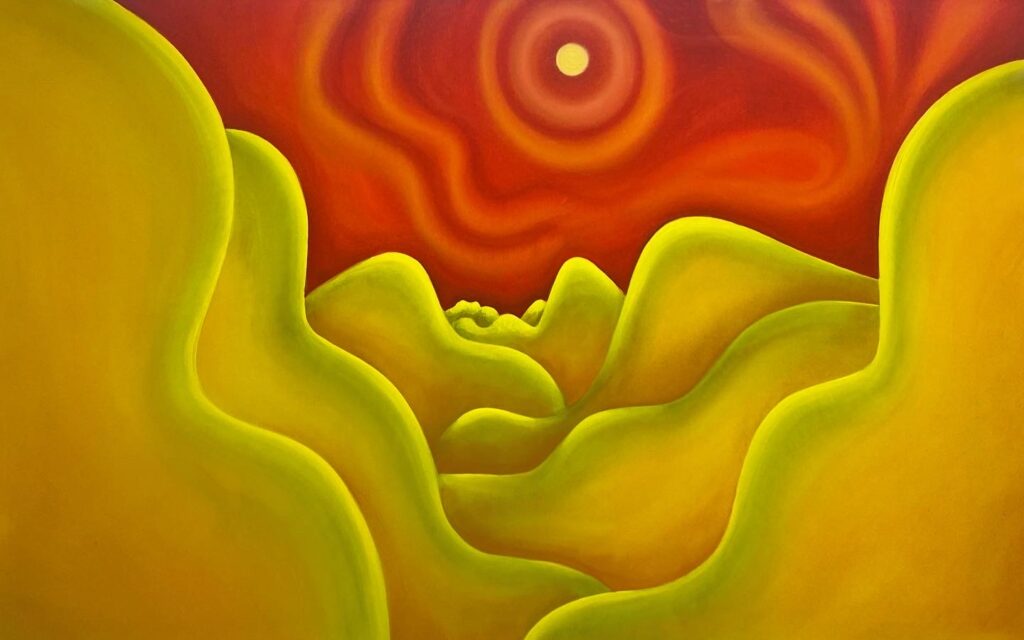
NB: So what are some books or images that you currently have in your studio?
CV: There’s all these little messages on the wall that I like to write around reminding me of what’s important. One of them is “do the dance before con amor” which is a reminder to stretch and dance and leave everything out, to put myself in the right state of mind before beginning to work. There’s Georgia O’Keefe, of course. There’s a book that I love that’s called The Architecture of Happiness by Alain de Botton, which speaks about all these themes that we were just talking about and how to build accordingly. There was this one professor of mine at architecture school that once said “a license to build is also a license not to build” and I think of it very often because of the state of the world today and the rate at which we build and destroy. There’s Fierce Poise, which is Helen Frankenthaler’s biography by Alexander Nemerov, and a little postcard of Alice in Wonderland that my studio neighbor during my MFA at School of Visual Arts gave me because she thought that I was like Alice in Wonderland when I was in the studio.
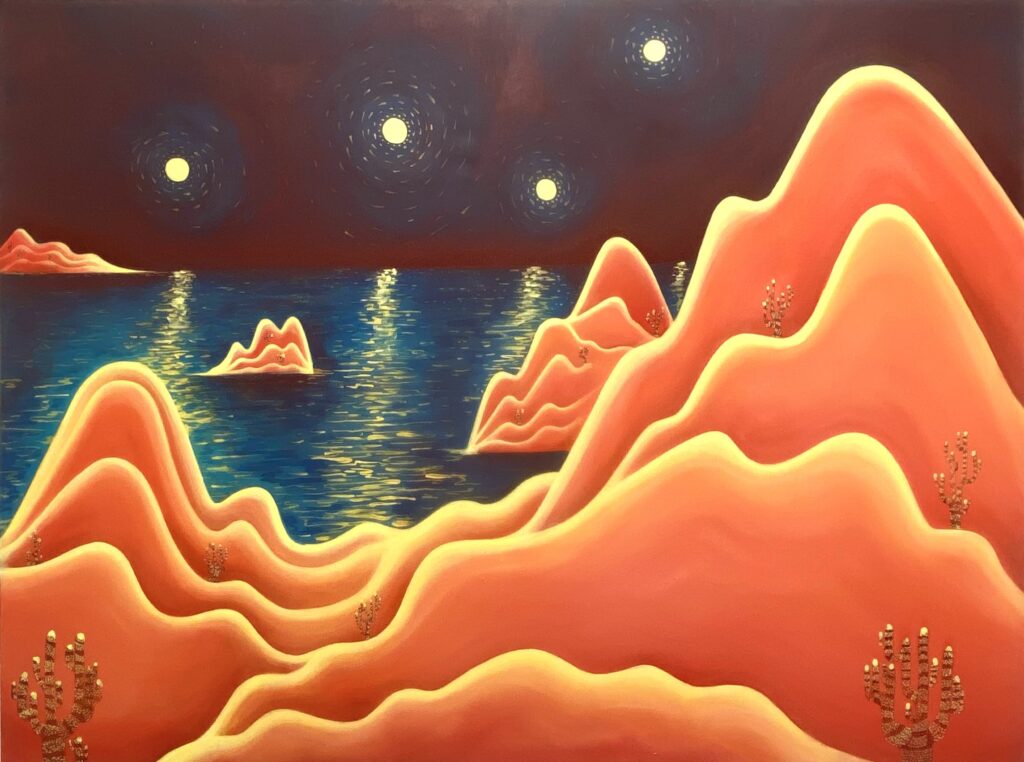
NB: So what are some projects that you’re most excited about in the future?
CV: Well, I’m very excited about my first solo show in New York at 89 Greene, the project space curated by Kathy Battista at Signs and Symbols which opens on October 19th. I also have two paintings at a gallery in Chelsea, Tuleste Factory, where I collaborated with a friend of mine who’s a very talented architect Ceren Arslan. It’s like a whole immersive room, there’s these two paintings and it’s so colorful and fun and otherworldly. There may be a few things coming up in December for Miami, and next summer in LA. I’m happy and curious about what’s to come this year after my MFA, and just spending as much time as possible in the studio (or the Met).
August 24, 2023
Artist to Watch
ALANNAH FARRELL
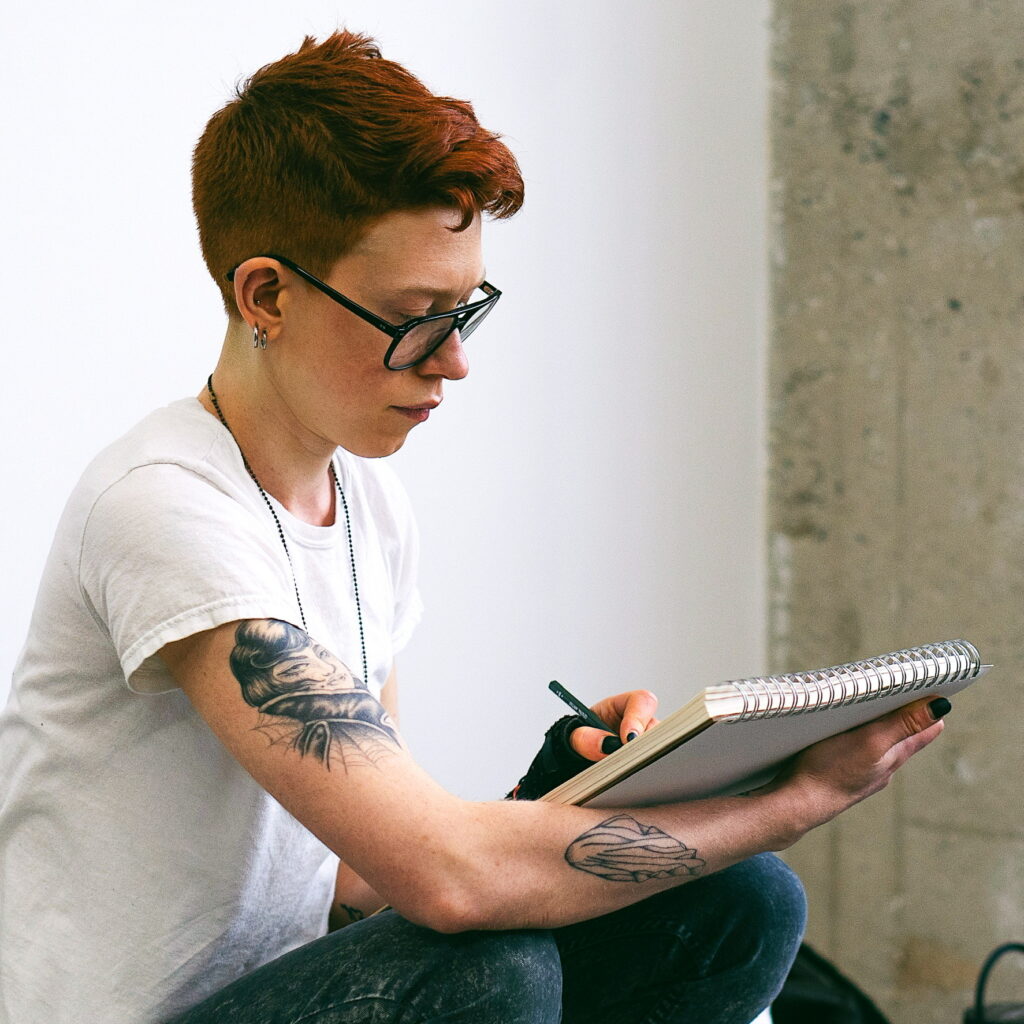
NB: What are some of your earliest memories of art and how do they relate to where you’re at with your practice today?
AF: My mom and matrilineal grandmother are painters, although both sides of the family are creative. My earliest memories were seeing their process, which relates to my paintings today on a technical level, like motor skills and eye-hand coordination. My mother and I have very similar hands. It’s almost witchy. It’s a little freaky. Beyond the technical, I saw their devotional relationship with painting as a place to land, solace in an often relentlessly challenging world, which I learned young and continue to this day.
Growing up around creatives, I also witnessed adversities around the artists’ lifestyle, including financial hardship. My parents didn’t necessarily encourage me to be an artist, they were very realistic and said this life is a struggle and this lifestyle is unpredictable. My mom said I would always run home after school, throw my school shit, probably rip off my clothes, and start making something immediately. Over time, once they saw that there was no stopping me, they became much more encouraging.
One fond memory is of my Nana, Ginger Fox (Yes, that is her real name, maiden surname), entering her home studio, which was a mess, walls covered in paint and strongly smelling of turpentine. I loved seeing her paintings which often included cats and women, goddess-like and voluptuous, some based on her daughters and grandchildren. It sounds like stereotypical grandma subject matter, but her paintings were weird, wild, and slightly erotic. She’s in a nursing home now, but recently, my mom curated a show of her paintings installed throughout the facility—it brought her and the residents a lot of joy, and they’ve left her work up. I think it’s important not to forget the humanness of art and art-making outside capitalism and the art world.
NB: Can you tell us about the subjects in your paintings? Who are they, and how do you think of painting as a way to share a story or narrative ?
AF: I met many people I painted when I started doing New York City nightlife in the 2000s, on the fringes of the queer club kid scene. Club kid culture largely died out at that time because people saw it as more of a 90s thing, but I was part of a lingering downtown scene. I recently watched the film “I Hate New York,” which documents (several) trans people in this scene from 2007 to 2017, which is around the same time when I went to those clubs. It wasn’t until that point that I’d met anyone in my life where I was like, “Ohh, these are my people.” So I started working with people I met from those parties, and some of the people I paint now are the younger generation of that scene, an evolution. They’re doing these incredible things in queer and trans nightlife—which seems more prominent and exciting than ever.
And I’ve always been interested in figurative work. Still, I’m cautious about sharing real people’s stories because of the possibility of exploitation, especially if it’s something that the public will consume. I think of the person, and then I think of the potential audience. I think about money exchanged because money is involved, and I’ve concluded that it’s fair to share bits of stories with consent and share the money with the person or people sitting for the painting.
There is also a fair amount of fantasy to each image, even when working with real people and places. Sometimes I envision a painting almost entirely, even before I meet the person/subject, so ultimately each work becomes ‘auto-fiction’ filtered through my perception. I often think about human emotion and life experiences, and I’m interested in how that changes over time and in learning from other people. We all have complex interiority, and it blows my mind the depth that every person contains that another person can never really know.
And, of course, many paintings reflect my frustrations, insecurities, sense of humor, or sadness at how pathetic, beautiful, or painful being a human in a body can be.
NB: Could you tell us about the relationship of identity and self expression with the spaces and objects in your paintings?
AF: These spaces are real-life places where the model(s) and I are in. I want to focus on the emotionality and psychology of these spaces, so I aim to balance familiarity and off-kilter anonymity. Even though I have a personal relationship with the cities and rooms I paint, I want them to feel accessible to people who haven’t been to those locations. It’s more about how place, space, and architecture can strongly influence the human psyche.
In terms of objects and fashion, these usually come from the subjects in the portraiture or self-portraiture. I am selecting certain people who most likely have a particular taste in how they present themselves. All clothing and objects contain coded language about their culture and who creates and consumes it, and those meanings change throughout history and contemporary cultures. My paintings’ objects and ancillary clues, like clothing, speak more to identity than the spaces. Except in those paintings without people, the settings play a more prominent role in expression and story and tend to be more deeply personal.
NB: How does color relate to these themes in your practice?
AF: Color and lighting are my painting’s primary elements, which sounds weird because I’m working with real humans and places as subject matter. Still, I almost think light and color communicate emotionality the most. I have nostalgic attachments to specific color palettes, which feel intuitive when painting. I don’t even know how to articulate it, but it’s something that I’ve always had a strong emotional reaction to. As a kid, I remember a salmon-pink kindergarten, a public school with very institutional fluorescent lighting in its classrooms. I remember being so disturbed by that lighting, everything bathed in a sallow green and those primitive bulbs buzzing a la horror film. Those sensory elements, especially the visuals, color, and light, made me very distracted and uncomfortable.
Like train lighting, nobody looks good on the subway. We all know on some level—conscious or not—these mass public spaces and lighting are designed for oppression. They become psychological spaces. And this is how I think of color and light in painting— means to create psychological space and narrative.
There are photography influences in my paintings too. When I started at Cooper Union, I took half a semester of painting and panicked about surviving financially after school. So I wanted to learn something more technique based, practical, and applicable to the world, outside of just the art world. And I was like, ‘Photography! That makes sense.’ Little did I know that it was on the verge of becoming somewhat obsolete with phones nowadays. But I learned lighting, analog, film, and digital photography, which was helpful because I started getting little gigs in school—I did nightlife photography and assisted photographers in setting up lighting for fashion or commercial shoots. I also had some experience with the modeling world in New York City at that time. I think about how all these different worlds are so complicated on their own, but they’re all now converging through painting.
NB: What are some projects that you’re excited about in the future?
AF: I’m tremendously excited about attending the Denniston Hill Artist Residency in October. I can’t get over my excitement for that. I’m also happy to reconnect with upstate New York in this new way—Denniston is a sanctuary that’s allowed space to grow for many creative visionaries I admire. It’s an honor to go! So that’s my focus right now. I’m in a hibernation chrysalis back-to-the-drawing-board phase, recovering from two exhausting shows in the past year.
I’m excited about what’s to come because I want to communicate something I can’t articulate in words or images. But it feels like whatever that is, it’s just under the surface, and I know something new will come out on the other side. Hopefully, it is something I’m proud of and work that communicates with others who see it.
Other than that, I’m in the Armory Show with Anat Ebgi, and a few shows soon open at Alexander Gray and Sean Horton. Both shows address topics I deeply care about and feature work by artists I respect and admire, art heroes like G.B. Jones, Justin Vivian Bond, Hugh Steers, David Byrd, and Peter Gallo.
Sept 1st—Oct 15th, 2023
Alexander Gray Associates
224 Main Street, Garden Level
Germantown, NY 12526, United States
Sept 7th—Oct 7th, 2023
Sean Horton
515 West 20th Street, 3rd Fl
New York, NY 10011, United States
July 19, 2023
Artist to Watch
KATARINA CASERMAN
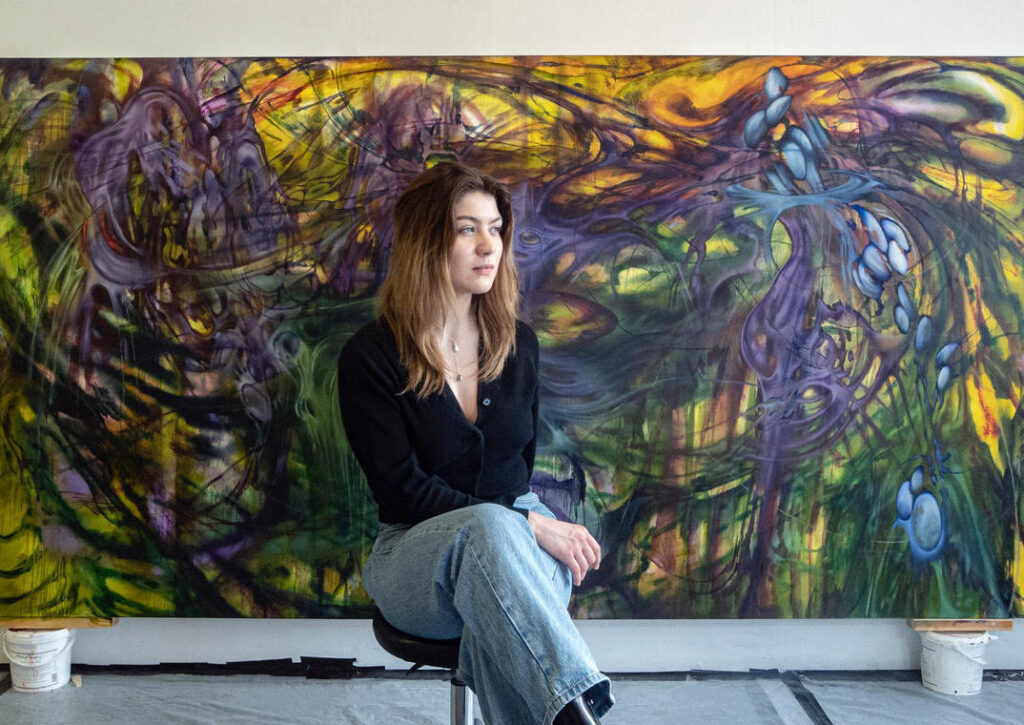
NB: What are some of your earliest memories of making art, and how does it relate to your work today?
KC: I often come back to this specific memory when we were children. We had these notebooks with blank pages that were called “memory books” and we gave them around to our friends and family so they would draw something in it and write something like ‘for the memory of Katarina’. I remember my mom one day she made this drawing of two deers, and back then it was one of the most beautiful drawings I’d seen. I remember I told myself ‘one day I’m gonna be as good as she is at drawing’. So my motivation was just to get as close as I could to my mother’s drawing.
With time I realized it’s just about practice and sometime around high school, I got pretty good at realistic drawings by observing things around me and copying them on paper. So these were my earliest memories of making art, trying to match my mental image with what I was drawing on paper. This always brought me comfort and happiness and something that has always made me feel something and luckily for me I was also good at it.
Now it’s of course very different. For me it’s not enough to just look, and mimic what I’m seeing. It’s more about ‘what else is there’? It’s not enough to just observe the world around me and then reflect upon it. I aim to turn inwards, reflect upon that and relate it to the external in order to create alternative structures of the visible reality.
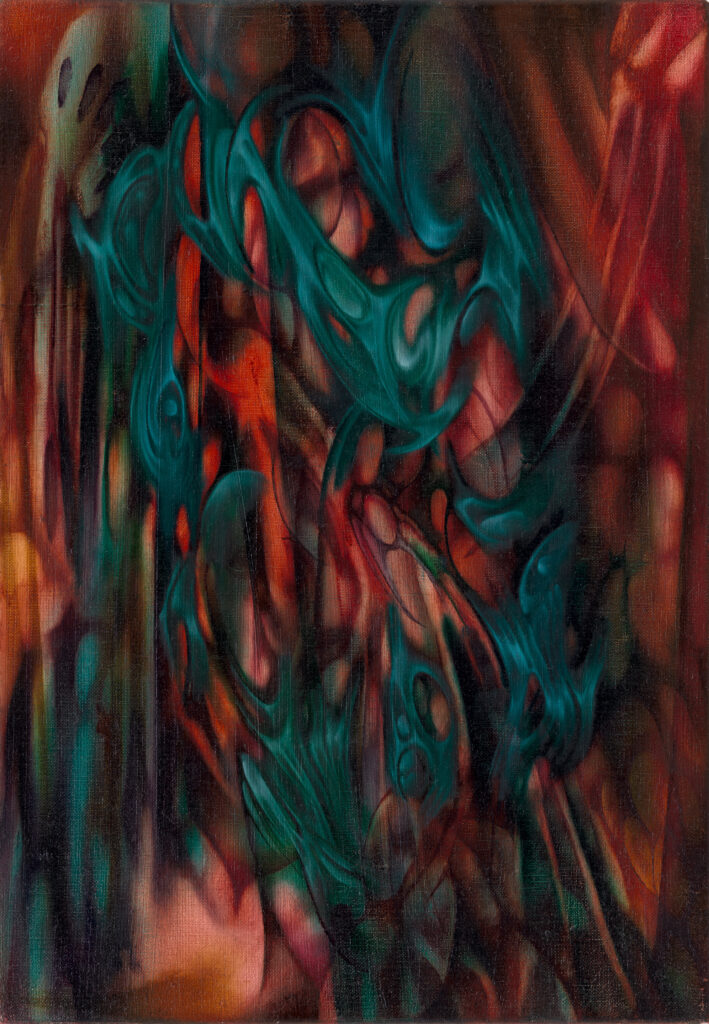
NB: Can you describe the process when you’re starting a new painting, where do you begin? How do you move through it?
KC: I’ve attempted to do sketches many times in the past but it’s just not working for me. My body reacts completely differently in front of a canvas than it does sitting down and making a tiny paper sketch. I lose the momentum and it feels forced to match the painting to the sketch.
I usually begin by making a very thin layer of oil paint and then I take it off with a cotton cloth, creating an image by bringing back the whiteness of the canvas. The very first stages feel more like building or constructing than solely painting. I let the layers interact with each other, see the direction of different drips and just let the paint and gravity do its thing and let it sit for a bit. There’s a lot of sitting time involved because I need to be patient to recognize which trajectory the painting wants to go. I also need to take into consideration that the painting will change over a span of a couple days because of all the drying and dripping and other micro chemical processes. So this is how it usually goes, there’s a lot of waiting and observing and reacting upon it over and over again.
NB: So it requires a lot of patience, right?
KC: Oh yes absolutely, a lot of patience. Especially because there are many things that I do in the painting that are rather complex and I often forget how difficult they are. It’s quite simple though, complex forms require a high level of complexity and it’s impossible that you would achieve complex forms with simple solutions.
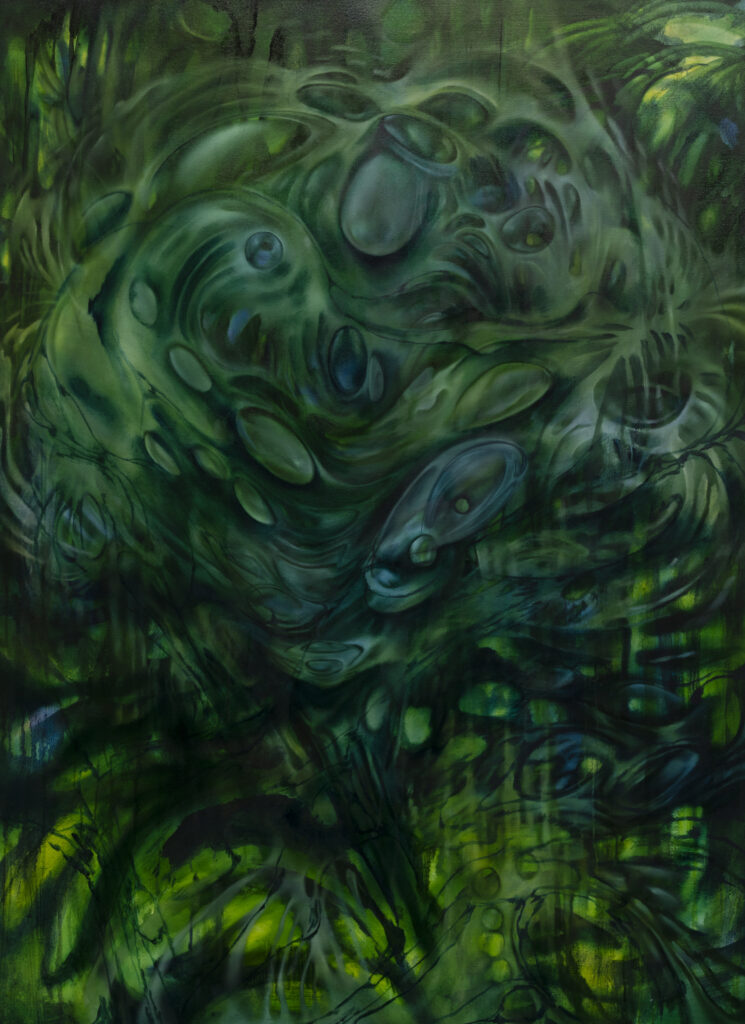
NB: Your work exists between opposing themes: it is organized yet chaotic, strange yet familiar, and dynamic yet still. Can you tell us more about these themes and opposites/binaries in your work?
KC: I used to say that my work has this notion of the opposite. I’ve been investigating this for over a year, ever since I came across Mary Shelley’s novel Frankenstein in which the use of words is so specific in how to describe certain conditions. For example when she says that the creature is reanimated, it goes from being ‘dead’ to being ‘undead’. So the creature was neither alive nor dead, it was in the zone of being ‘undead’. It was a walking contradiction. That just provoked me into thinking about how we can use language in order to expand the possibilities of the opposite.
For instance, if I ask ‘what’s the opposite of black?’ the answer would probably be white, which would mean it’s white and nothing else but white. If you say ‘non black’, then it would mean it’s everything but black, giving you more possibilities of what the opposite can be. When I talk about my work I use the proposition of ‘non’, meaning I don’t say there’s order and chaos but rather ‘non-chaos, artificial/non-artificial, movement/non-movement and so on. This sets the paintings in almost a ‘third zone’. I’m playing with the idea of opposites that exist in the same reality, so it has this notion of impossibility, like with these spaces where you constantly have some sort of a glimpse of light and at the same time a glimpse of darkness.
So it’s not about depicting something in particular, or descriptive, but they are setting a mood. When you stand in front of the painting you are getting primed/ready for the zone that you are about to enter, and this zone is the painting itself, but there is a specific mood that surrounds the painting.
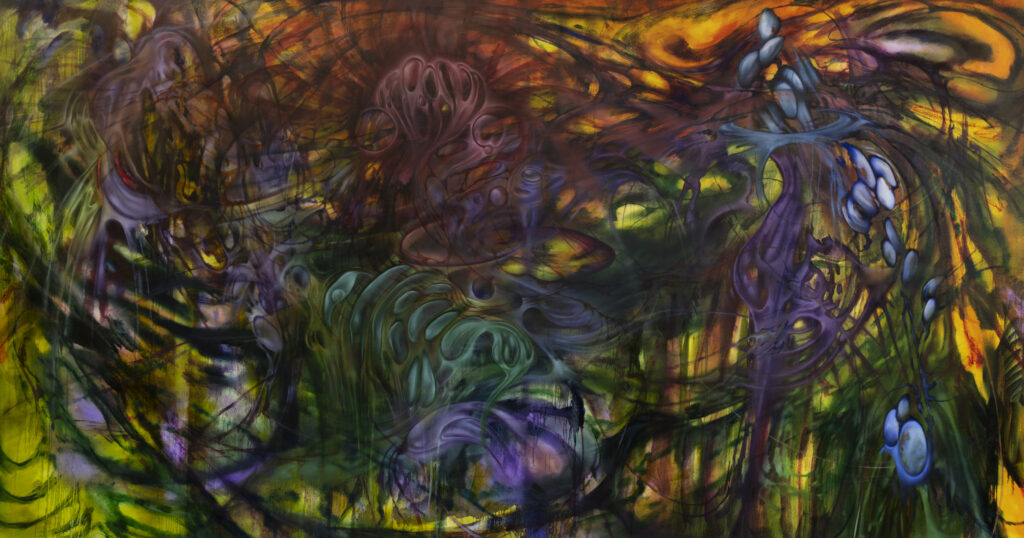
NB: How does color relate to these themes in your process?
KC: It’s very, very, intuitive when it comes to color. At the beginning I don’t overthink it, I use any color that resonates with me in that moment because I know that the specific color will not determine the outcome. I usually just like to play with layering and getting different shades that don’t necessarily exist if they were only on one layer. These are colors you get once you layer one color over the other, in order to get a third one. It’s the optical mixing of the colors instead of just a physical one. I enjoy playing around with this because it gives me a unique experience when I’m moving around the painting. It seems as if the painting is changing all the time due to its multiple layered structure.
NB: Where are you currently drawing inspiration from? What artists, movies, music are you looking at?
KC: I’m not being the best artist right now because I don’t think I’m seeing enough art shows and I’m not intentionally looking at any visual art. On the other hand I am looking at all sorts of things every day because Instagram exists. I’m also the last person in the world to watch ‘Twin Peaks’ by David Lynch so this is something I’m currently obsessed with. It feels as if the whole series puts your brain into a dreamlike state so everything suddenly has a thin layer of ‘Twin Peaks’ over it.
I used to listen to a lot of music while I painted, and I still do, but now I mainly listen to podcasts or audio books. I recently realized that music has too strong of an impact on me. It will either make me paint faster, or slower, or evoke memories, which is very distracting. I switched to podcasts and audiobooks because as you follow the story, you’re in an ‘in between zone’ of being present in the painting, yet not fully there. I think of it being similar to how a pianist is when having a performance. When they are playing they are in this ‘flow’ estate where their body is acting instead of their brain.
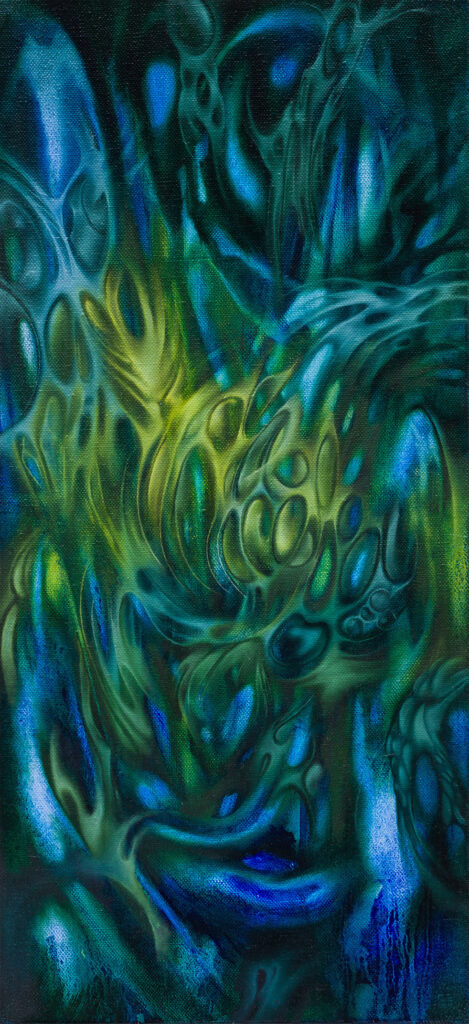
NB: Can you tell us about any upcoming projects or exhibitions that you’re excited about?
KC: Yes! I’m represented by Tabula Rasa Gallery, and we have so many exciting projects coming up this year. I do have a group show in Beijing, in November and before that I’m also having a group show at a London-based gallery, which will be announced very soon and that I’m very excited for. Then there’s also art fairs and a couple of other things as well so it’s gonna be a very, very, busy year. To which I always add: being busy is a good problem to have.
June 19, 2023
Artist to Watch
KATE BARBEE
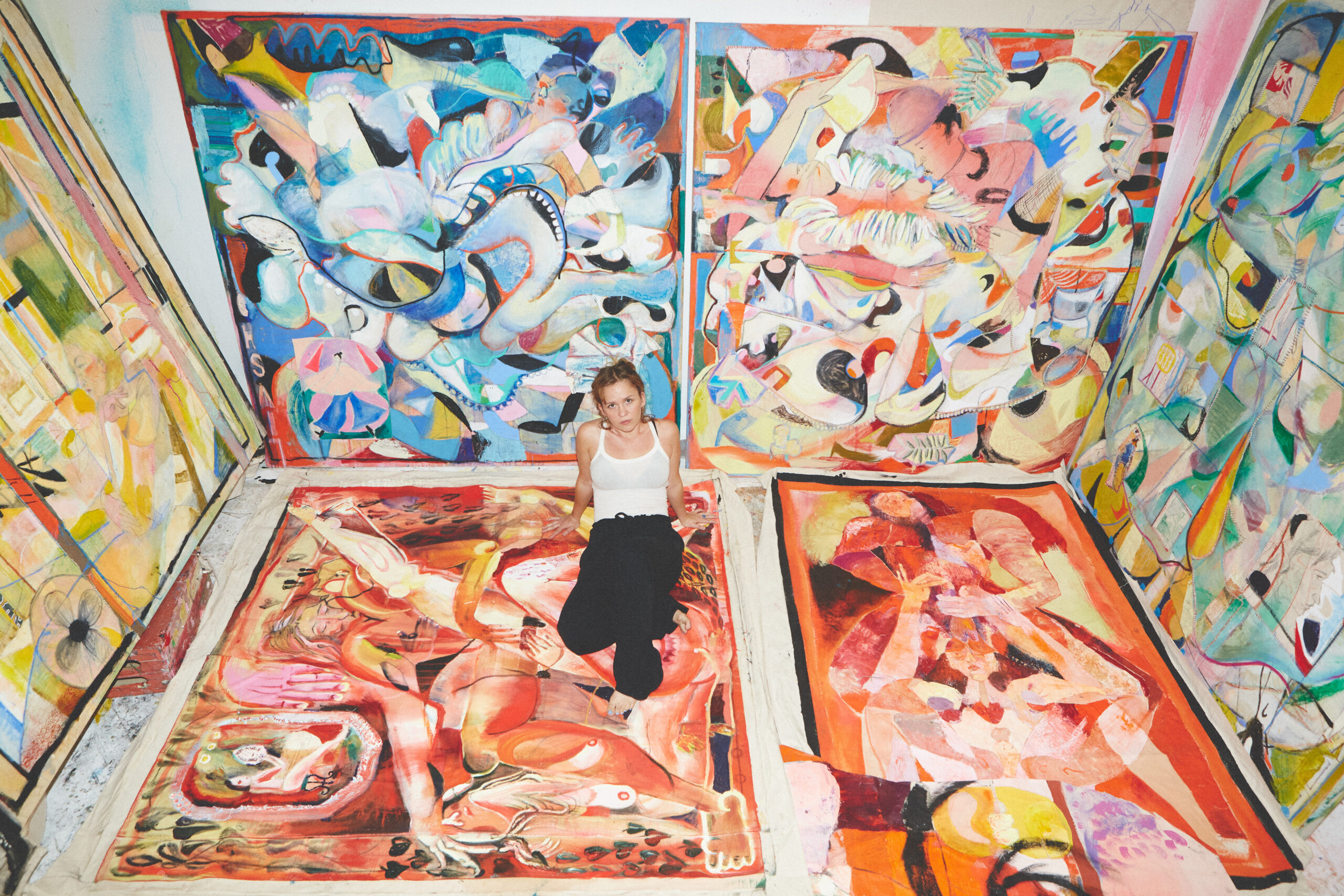
NB: What are some of your earliest memories of making art and how does it relate to what you’re making now?
KB: Well, my grandma always made these stained glass fixtures for the windows in her home, and I believe it left an impression on how I lay down shapes and colors in my paintings today. Even my use of wax and linseed oil I feel are reflective to the transparency of the stained glass. I feel like the lines I add into my work today are like the grout we would use to fill in the gaps of the glass shards.
I began painting at a young age and I was very interested in abstract shapes. I felt proud and excited about discovering something that was outside of the world we lived in, and I enjoyed the cathartic trance I would go into whenever creating an imaginary world of broken up colors and shapes. Shortly after I became a little more interested in fashion illustration and would draw dresses and outfits on figures as a way to almost live vicariously through my designs. I couldn’t wear these clothes because I didn’t have access to them and as a child I felt as if by creating it on paper I could own something beautiful. I think everybody makes art to escape from their own world, and for me the fashion design and abstraction really helped me delve deeper into my imagination as a child.
NB: So we can definitely see the stained glass windows, the stitching together, and the fashion design. Can you tell us about your process using mixed media? How did you incorporate the use of beads and stitching on your canvas?
KB: It all started when I was in high school, in this little punk scene in Dallas. I always sewed my jean jackets with band patches and pressed little silver studs into all my clothing because I felt this was my way to stay relevant. The stitches on my paintings now reflect the rawness of the stitching on my clothing in the past. Back then I was in Austin after graduating from college, and I was raising money selling jean jackets to move to Los Angeles. I bought a whole bunch of jackets from thrift stores and used the wood cut prints I made in school and trashed paintings to sew onto the back of them.
Once in LA I started adding patches on the paintings. I liked the idea of a living painting with loose fabric hanging from the painting and blowing around whenever someone would walk by, or when a breeze from an open window would bring it to life. Then I realized it was not sustainable and the pieces were going to fall off or fold/crinkle at a certain point, so I started fully sewing them down and I was very much touched with how familiar this process was with my history of sewing onto clothing.
At times when I’m working on the bigger paintings, I feel like I’ve created a social quilting circle because my friends have had to help me sew the pieces on. When someone is helping me sew onto the works it becomes a passing of energy where we’re passing the sewing needle back and forth, telling stories. Since I can’t go around the canvas and do this by myself it becomes a special process and I think about my family members in the past sharing this same experience when creating quilts with and for their loved ones.
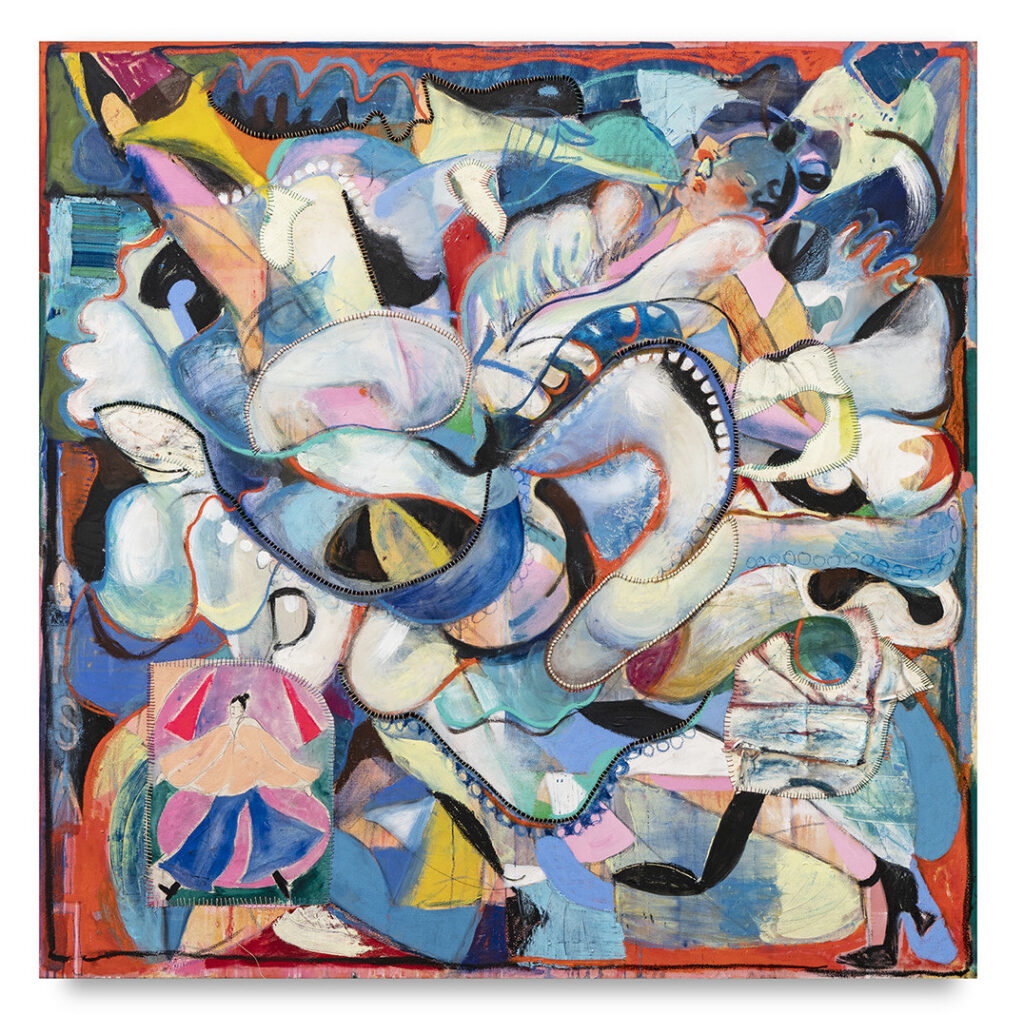
NB: So what is the process like to build your fractured and intertwined compositions and these nonlinear narratives? Where do you start?
KB: I start with a few lines and I’m very impulsive. I see a blank canvas and I immediately attack it. Sometimes that leads me into a dark complicated place with the painting, because there’s no thought put into it. Yet in my practice I work with oil paint, and I think oil is not that forgiving. So I’ve learned to also approach a painting and sort of forgive myself when I make these mistakes. I will usually paint something impulsively and then I will impulsively cover it back up with a different shade of paint and at times it drives me crazy. As time goes on, I turn the painting around, I rotate it and see shapes coming out of it. At some point I would stretch my canvases on the floor and with whatever dirt was picked up, I would find a figure connecting the dots and tracing it out. I’m interested in seeing if I will ever have a calm moment in my painting process, but so far I have been enjoying this way of creating.
NB: I love it. So can you expand on your use of interior and exterior or inside and outside spaces? How does this relate to other themes you explore through your work?
KB: So I tend to ponder on this daily and I’ve figured that I sort of work with three types of locations: One is the place within myself that is fleeting and is an emotional place, the place that I create from my imagination to escape to. Then there is a physical space that is also fleeting because it is temporary and won’t be there forever. For example, I made a painting of my friend in her garden, which is planned to be sold to developers who will most likely destroy it and build something new. The garden is set on top of a hill, lush green and with a wooden bungalow with large windows in the middle. The space is like a Monet painting and although there’s sadness to painting a space and a moment that will eventually be gone, l also I feel there’s a justice with capturing this moment in time.
The third space I work with is also a physical location, and generally it’s a location that I have photographed when I’m walking or in a car. I usually take photos of storefronts and signs that I find interesting, then I screen print them onto fabric and sew them as patches onto the paintings. So far I have only done this with photos I’ve taken in Paris and Los Angeles, but the world is always changing and I am always growing. I believe that it is important for me to capture these stamps in time. Of moments, feelings, energies, and locations.
NB: Incredible. Do you have any upcoming projects or exhibitions you would like to share?
KB: Yes, I’m going to be in a group show at Albertz Benda, showing work next to the late Ken Kiff’s work and many other great artists. I’m also working on my presentation for Sotheby’s Institute and a show at Kohn Gallery in Los Angeles in 2025. I am very much looking forward to continuing my career now in New York, and excited to see how I will grow out here. Thank you so much for coming by my studio!
May 12, 2023
Artist to Watch
DYLAN ROSE RHEINGOLD
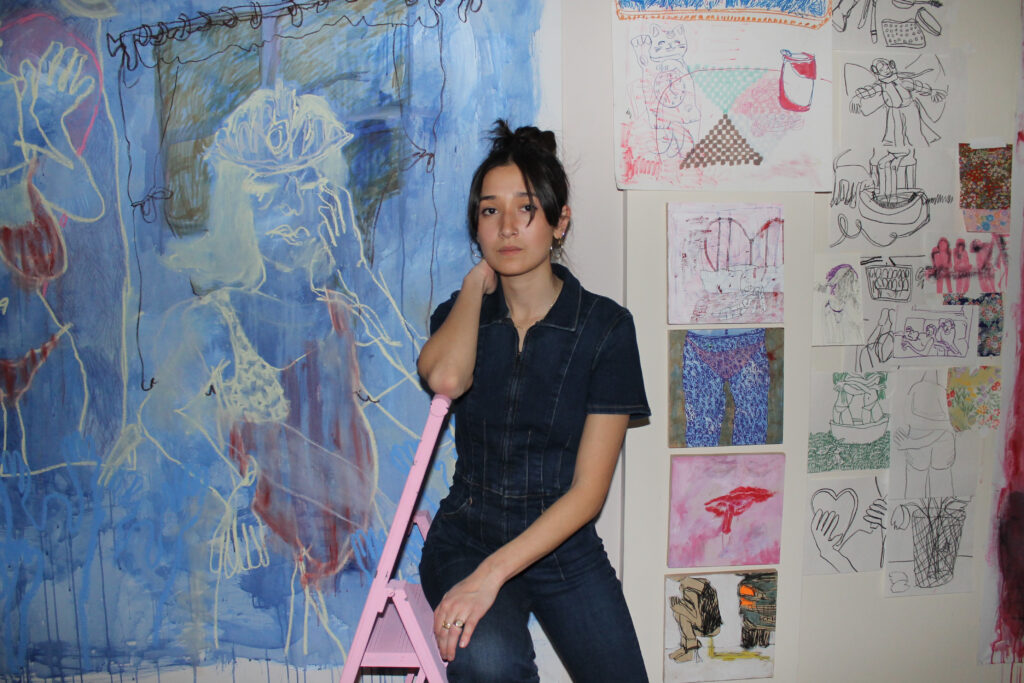
Nicole: So when did you first begin to paint and what drew you to be an artist?
Dylan: I don’t remember if there was a specific instance when I realized I wanted to be an artist. I’ve always been painting and drawing, and both of my grandmothers were artists or creatives in some ways so from a very early age I was always encouraged to use my hands. When I was younger I had some anxiety struggles and I think a big outlet for myself, that was encouraged by my family, was drawing. Drawing was always just very natural, it simply stuck with me and I can’t imagine my day-to-day without it. A lot of artists that I talk to, they say I didn’t have a choice, and this is who I am, although it sounds almost corny saying it out loud, but it’s very much true.
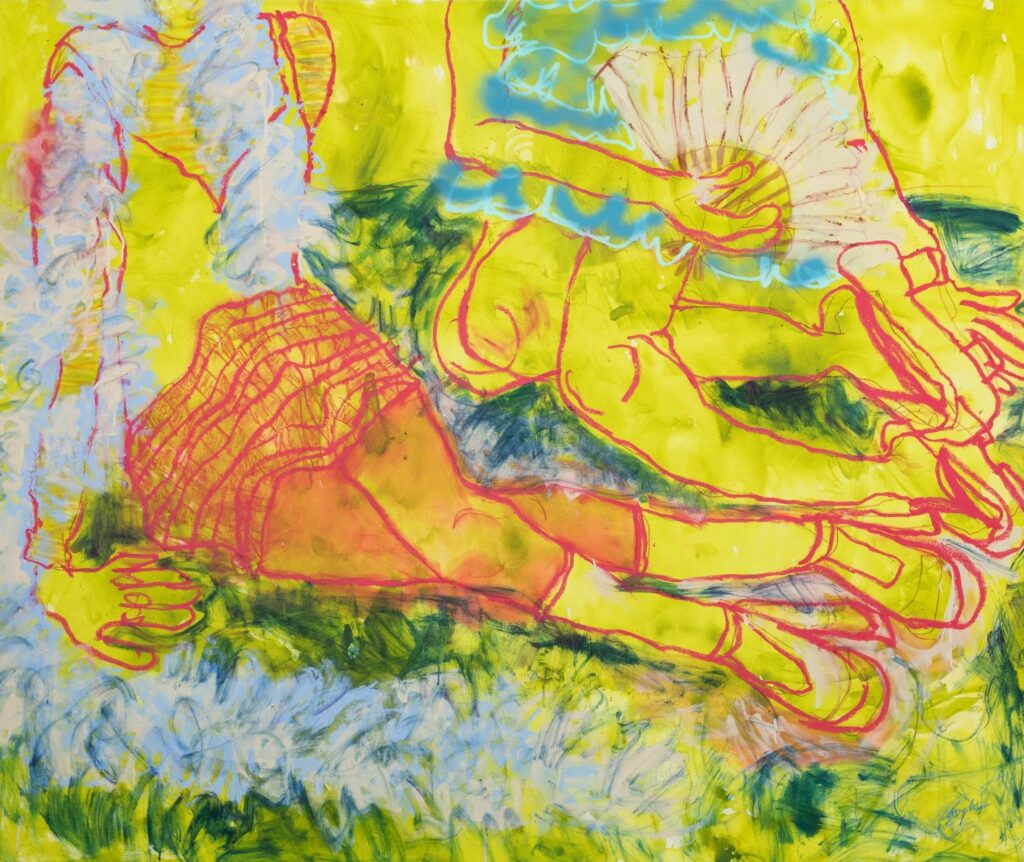
Nicole: So could you tell us about the storytelling narrative aspect in your work?
Dylan: In terms of the storytelling aspect I’m working with a narrative that’s non linear. When people are looking at my work, and also when I’m making the work, I like to think of all of the paintings in dialogue with each other. It’s hard for me to pick apart or speak to only one painting in series. The reason I like working in series and working on multiple pieces in unison is because I like to see how they interact and talk to each other. What’s also interesting to me in terms of the narrative is this aspect of self discovery, thinking about my identity and taking a look at girlhood. I’m interested in the transitional space between girlhood to womanhood, or even in a broader sense, childhood to adulthood.
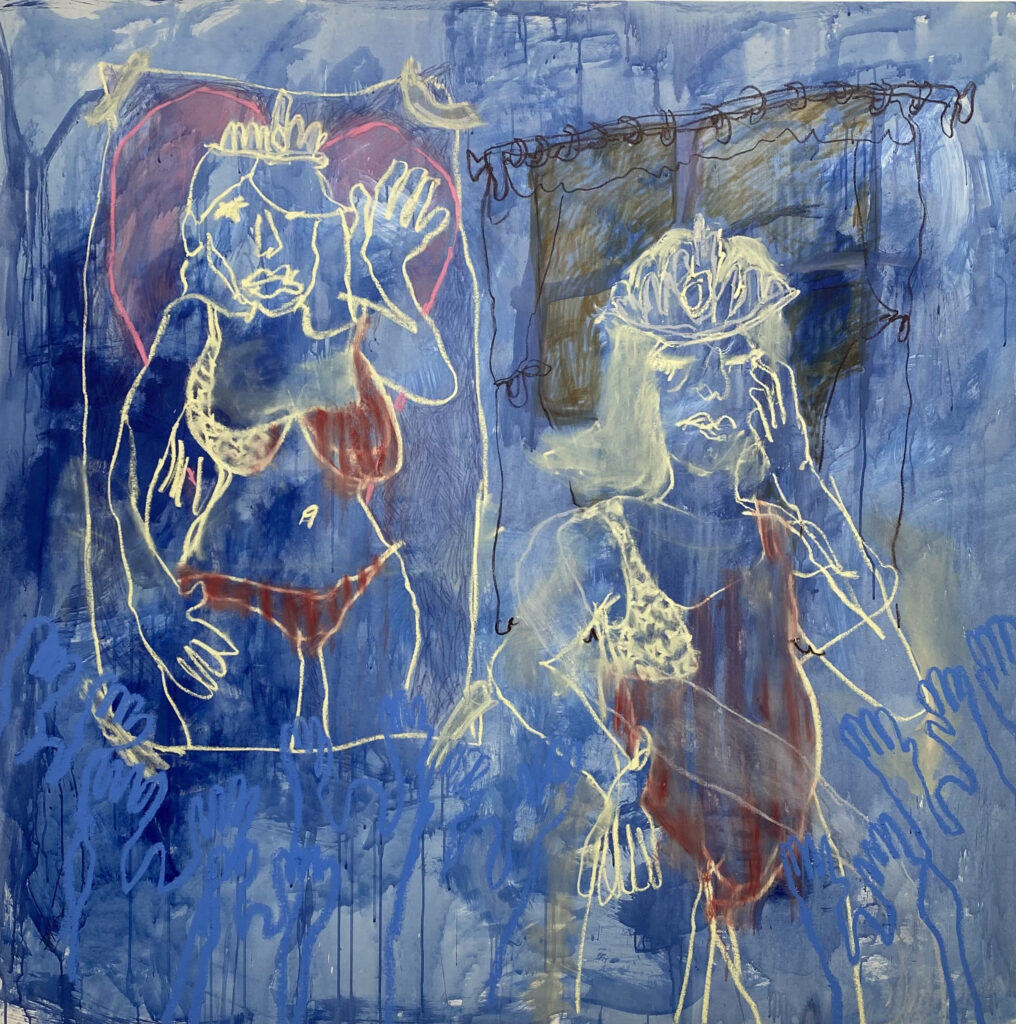
Nicole: How is the process of painting and the use of mixed media related to this narrative?
Dylan: The first time I did a mixed media painting was when I was studying painting and screenprinting a couple years ago in Florence. Before that I studied illustration, so I was learning and going through an education that was focused on mastering the traditional skills before you could move on and come up with your own style. I had a really hard time with this more traditional education and got into a lot of altercations with my professors in my undergrad because I really didn’t like that way of learning. I’m grateful for having those skills mastered now, but it was really frustrating at the time.
Before that, I was never using mixed media because it wasn’t the traditional thing to do, and it wasn’t until Grad school, after that semester in Italy, when I started thinking about all of the layers I was trying to address through painting and how that fell hand in hand within my own narrative. Speaking as someone who comes from a mixed background in terms of race and religion, I think it also naturally evolved into pulling all these different materials together and layering, and layering, and building these pieces without realizing at the time the connection it had with who I am and my background. I also love mixing materials that are a bit more traditional or high end with things that you wouldn’t expect, and that speaks to the parallels of adolescents and the coming of age. I have on my desk these packs of sparkles or glitter that I’m mixing with these expensive oil sticks and navigating how they can work together and what emotions that can evoke: It’s the girlhood and the womanhood in one.
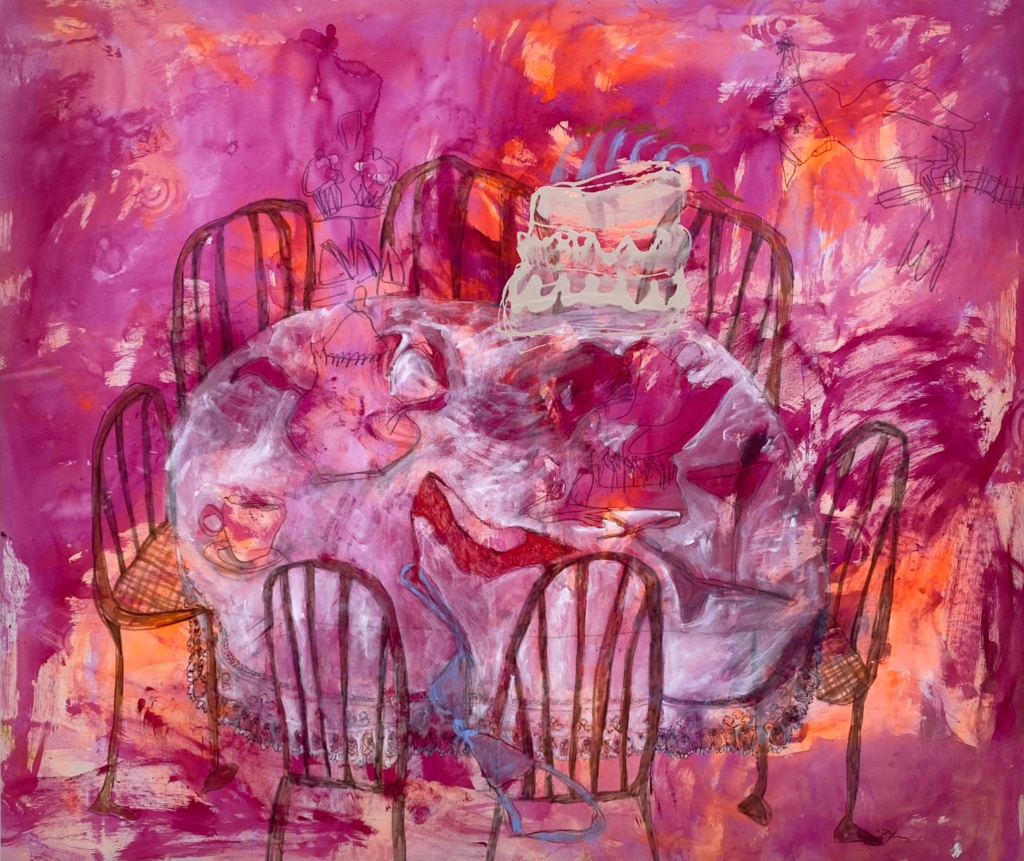
Nicole: What do you have pinned to your walls and what books do you have open right now?
Dylan: I have a lot of drawings currently pinned or taped to my walls, and all of these start off in the automatic drawing or automatic writing, surrealist automatism manner. So I’m not trying to think about it and I’m just trying to let the subconscious sink in. What I believe is successful is that they give off a dreamscape and surreal feel to them while also speaking of the narratives I’m interested in.
The books that I have open at the moment are Katherine Bradford, Rita Ackermann, Cy Twombly, David Humphrey, and a Tracey Emin book.
Nicole: The expressive line across all of them, you can see how that transgresses into your work.
Dylan: Thank you, that’s a big compliment! Also there’s Philip Guston, I feel like a lot of people have been looking at him recently, but he’s like my everything.
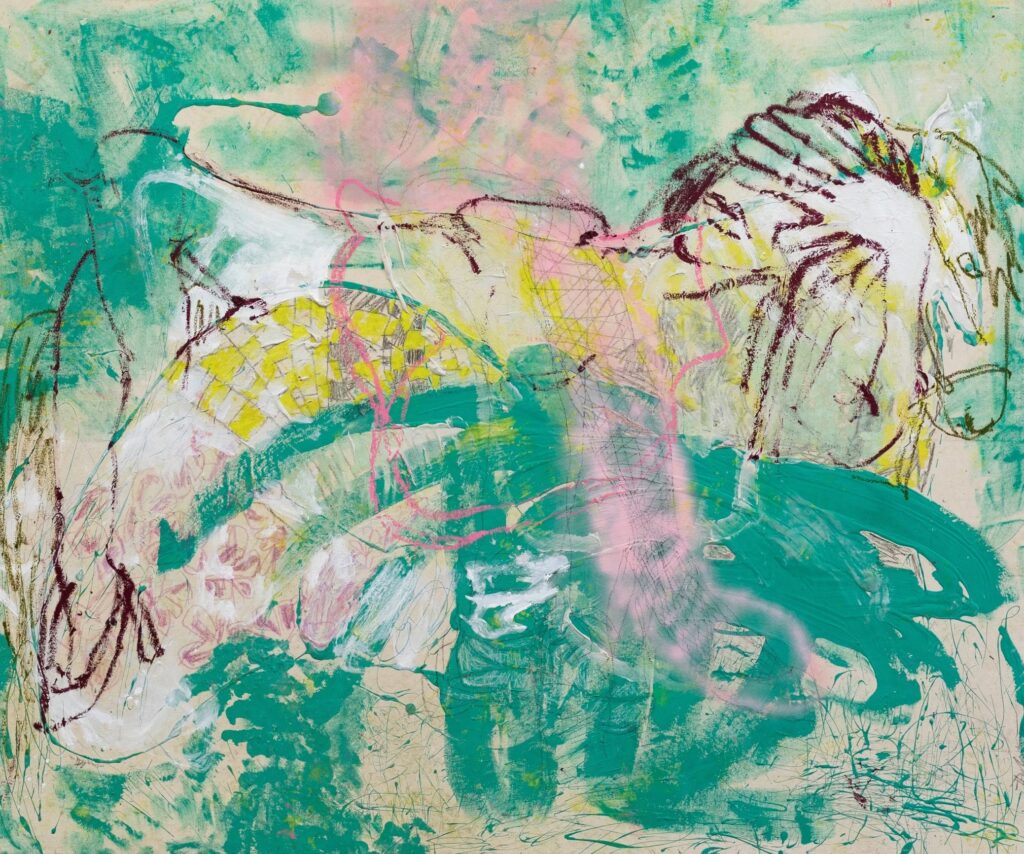
Nicole: So tell us what are some of your upcoming projects or exhibitions that you’re excited about.
Dylan: I’m very excited about my solo show at T293 Gallery in Rome opening May 11th through June 1st. The show will be taking form with eight large scale mixed media paintings and six wood panel studies that are also mixed media. These studies aren’t really traditional studies because they don’t look like an underpainting or an outline for any of the large scale works. There’s a layover between the objects and the symbolisms throughout those drawings and I think if you take your time and really look at the group together, you’ll find that there’s a lot of crossover with the larger works. After this show in Rome, I’m preparing for a solo show in the winter at M + B Gallery in Los Angeles.
March 15, 2023
Artist to Watch
LINDA CUMMINGS
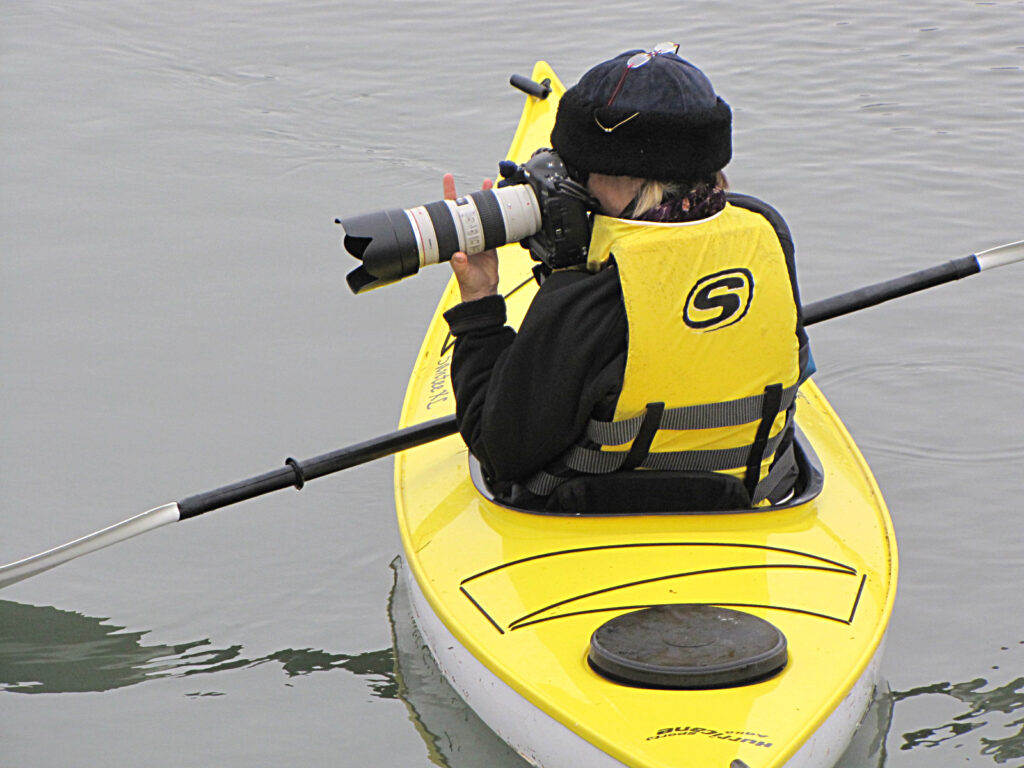
NB: Linda, when did you first pick up a camera and what drew you to become an artist?
LC: Growing up, my father’s Zeiss Ikon rangefinder was always nearby. He carefully composed the photos of my childhood, and that of my 6 younger brothers and sisters, in ways that gave the appearance of happiness and harmony that were far different from my experience. When I set off for college he loaned me his camera and I took it with the determination to discover the world through my eyes. It’s ironic that the same camera my father used to cover up the messiness, the cruelty and contradictions in our family is the same one that allowed me to disarm and reveal. With a bus ticket from my grandparents and a scholarship I won to the Cleveland Institute of Art I began my new life in search of a community of people like me, with questions like mine. I went to study painting but was met with a very antiquated view from many (mostly male) professors that would often dismiss female students. I noticed an inverse relationship between the number of female students entering school and those graduating, so I went to the Director and suggested they add more female faculty. Instead, they rescinded my scholarship the following semester, so with the encouragement of my friend, April Gornick, who left CIA the year before to go to Nova Scotia College of Art and Design, I finished art school in Halifax, Nova Scotia. There I found a thriving avant-garde community of conceptual artists – Laurie Anderson, Martha Wilson, Katherine Knight, June Leaf and Robert Frank. I flourished there in its progressive, vibrant intellectual community, beside the open sea. It opened my eyes to performance art, art on the move.
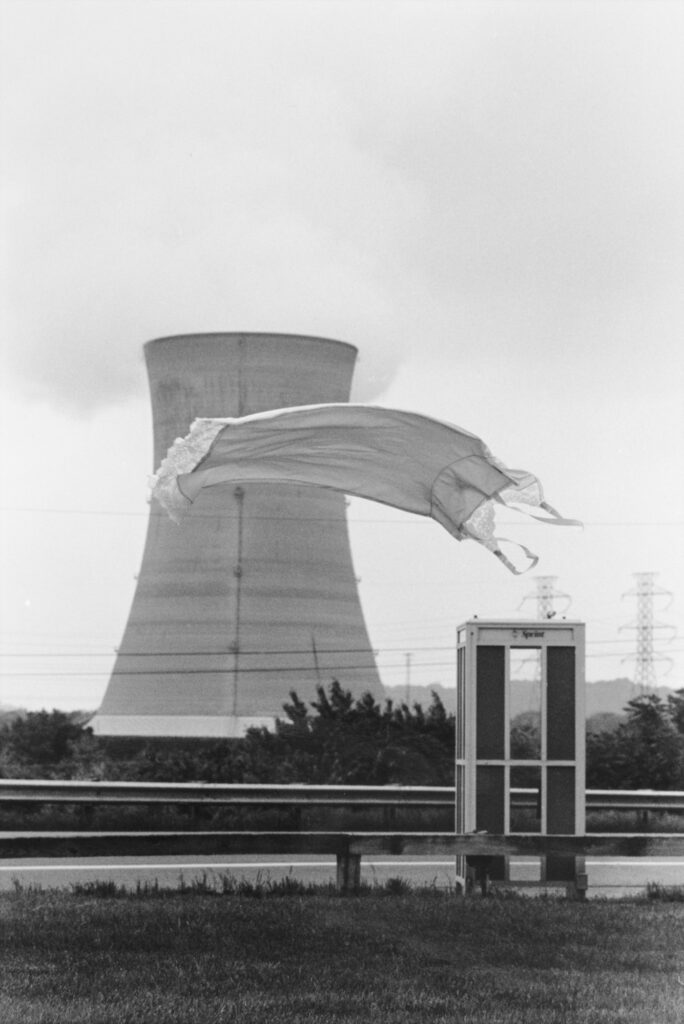
NB: So at this time you’re studying painting, how did you come to integrate the performance aspect into your practice?
LC: In Halifax I began making cameras of my own: I made “pin-hole pigeon cameras” inspired from World War II spy cameras, when pigeons would fly over enemy lines with tiny cameras attached to them. I made a flock of seven pinhole pigeon cameras, each one with a string attached to open its shutter. I’d sit on the bench at a public park, waiting for live pigeons to interact with my decoy pigeons and then make a “pigeon pinhole” picture of the interplay. Performing my artwork in public gave me a place for my work to be seen and so art-making in the open became my conduit. My first artwork purchased by a museum was a silver gelatin pigeon photograph acquired by the Lehigh University Art Gallery in 1979.
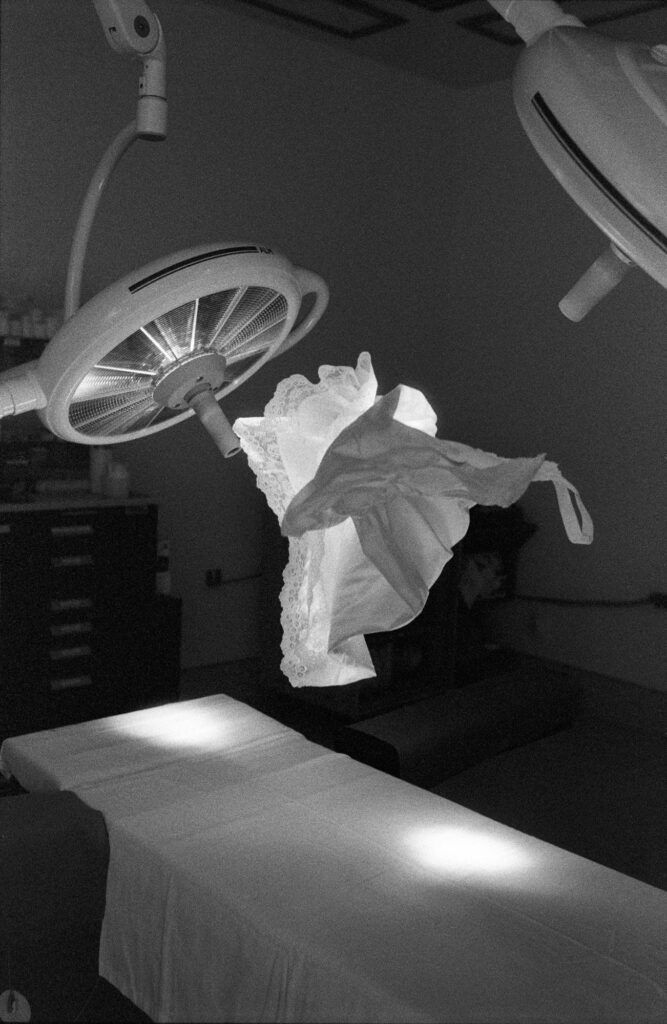
Project: Slippages (1992-2022)
NB: Your work is characterized by working in series. What is the process to help you determine each of these new series? How do you know the beginning and the end?
LC: When I start a project, I have mulled it over for quite a while. Once I find the materials that speak to, or reveal the idea, the process accelerates and becomes more organic and intuitive, but I always return to a conceptual basis. An artist gathers lots of impressions, whether in photographs, drawings, writings or sound scores, but knowing which one to save and follow, and which one to let go is the hardest part. Looking back now I see a recurring fascination in my artwork about the interplay of visible and invisible forces shape our lives. I think this goes back to my initial pigeon premise, the idea of the co-creation of the image by both subject and object, like the Heisenberg Principle that the act of observation changes the thing being observed. The end of a series is kind of an illusion. There really is no end, just a transformation in material or technique or subject matter. I mostly wait for something in the work to announce its own completion.
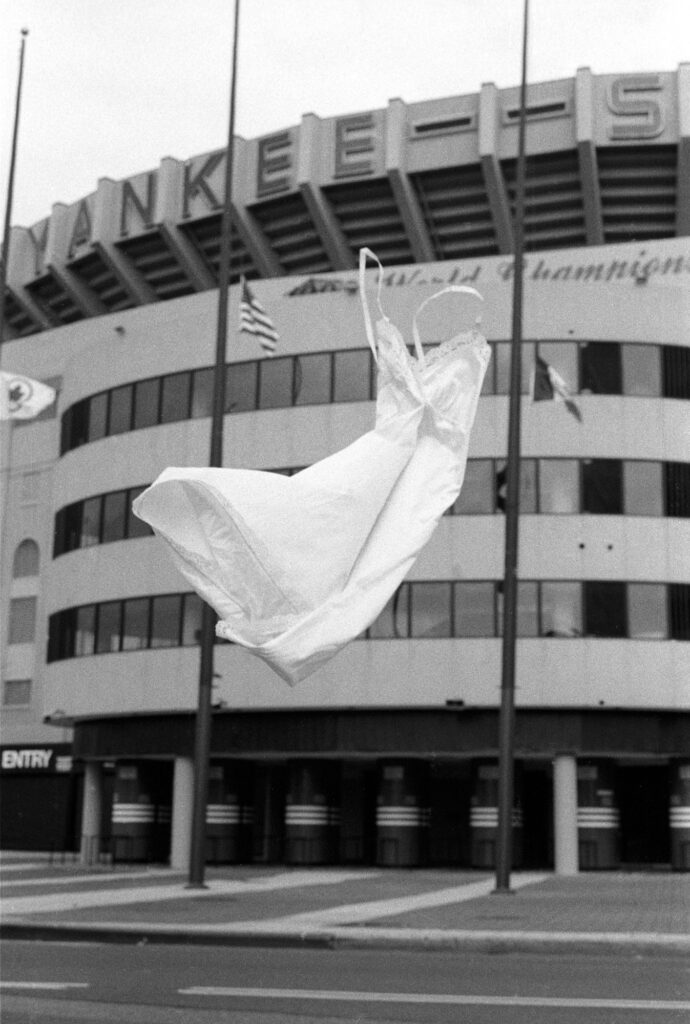
NB: Your current exhibition Slippages at 89 Greene was initially developed over a span of 10 years (1992 – 2002). Can you tell us a bit more about revisiting this body of work 20 years later and how has the work evolved over time?
LC: Slippages is a project that comes out of a desire to literally transcend the gravity of the past and reclaim what may have been left out, or invisible. Over time, though, I realized that what began as an attempt to picture hidden power dynamics of gender, was evolving into picturing the changing dynamics of power itself. A radical new invisible technology was simultaneously reshaping our landscape and lives. At the end of the millenia, once secure infrastructure and systems of knowledge based in the physical world began morphing and disappearing into a digital reality. I witnessed previously defined hallmarks of society, architecture and tradition begin to crumble and couldn’t help seeing the shifts in the social, cultural, economic and personal domain as inter-related to our increasing digital dependence.
For Slippages I found objects and sites that held cultural significance, and had power and history embedded in them. The garments I chose, seven slips, held powerful memories and associations. The slip was not only a uniform of gender, but also a potent word – both noun and verb – that resonated with the actual power slippages I saw happening in the world. Although the slip was a constant feature in the photographs, my initial subject of identity and resistance had transformed into a meditation on change itself – another invisible force, like the wind – that can be seen by virtue of its impact on the visible world and physical beings.
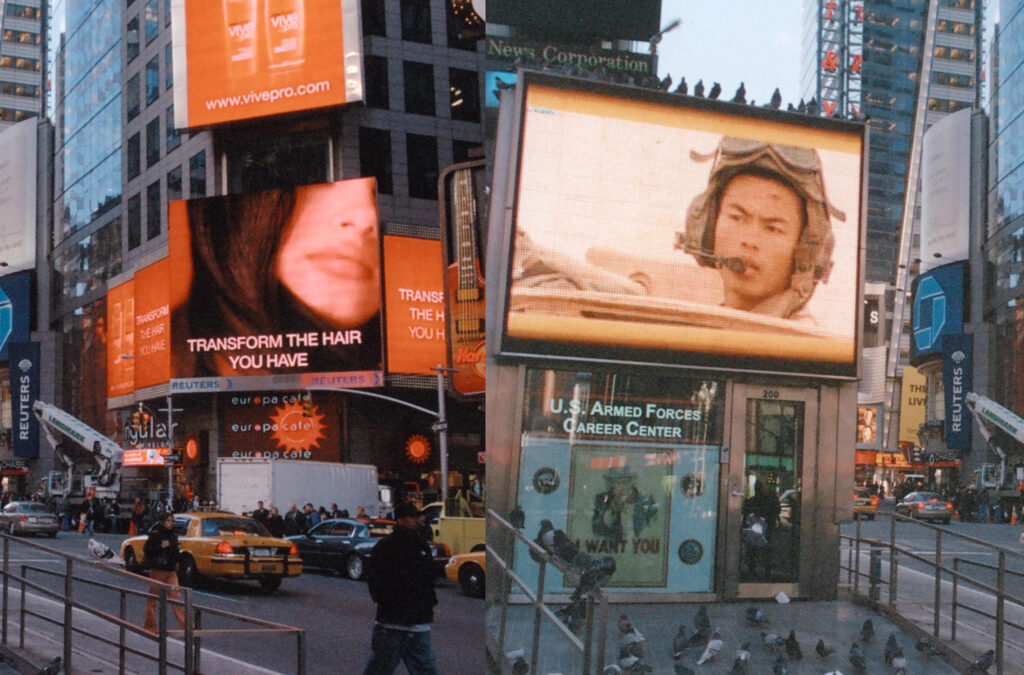
NB: So there’s this aspect of atemporality in your work and a sense of movement, do you want to just expand on that a little bit?
LC: I like to make artworks that tap into a sense of on-going being, an organic flow of time and process. Susan Sontag says “…There is no final photograph…” because the desire to look and to see and to learn is endless. Art and tradition transcend time, I think, because they spring from a human need to connect, to make meaning and to feel safe. Unconscious processes and unresolved conflicts, like wars, transcend time. They keep on going. Isn’t this why, 50 years after Roe v. Wade, we are coming back to the same question of who’s in control of the female body, even though we all thought it was settled law? Whose interpretation counts? We have differing interpretations and perspectives on events because we all see them through the filters of our own time and place. I search for a moment of recognition where reality and my imagination meet. It is at this moment, this intersection of inside and outside, the convergence of now and then, that I click the shutter and the photograph begins.
There was a project I did for four years, from 2004 to 2008, where I stood as a silent sentinel during the Iraq war in the same spot in front of the U.S. Army recruiting station at Times Square. There I made pictures of young men and women going through the doors to enlist. In the frame was also the war of words and images – glaring screens and billboards of military and commerce competing for attention from passers by. I took 24 frames within 24 minutes to underline the phenomenon of the persistence of vision and to reference the way cinema and news media construct their narratives. Afterwards I pieced frames together in photographic scrolls so the viewer could slow down and digest these different impulses and images screaming at each other.
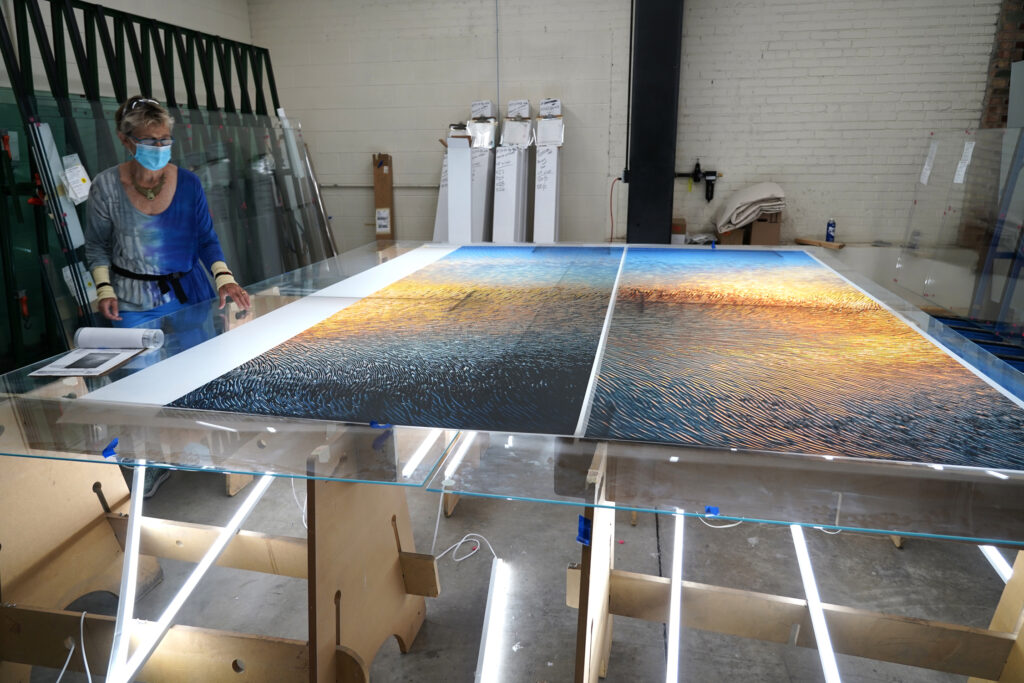
NB: Amazing. Do you have any other upcoming projects or exhibitions that you would like to share with us?
LC: Yes, on view through March 25th is Slippages at 89 Greene, the project space for Signs and Symbols Gallery in the Lower East Side. And I am excited to be working on a large project titled Genesis 1.2 – a large 10-foot x 7-foot photographic glass artwork to be installed in June 2023 as a permanent installation in Temple Beth Tikvah in Madison, Connecticut. This project engages two passions of mine: understanding properties of light and advocating for the health of water bodies, rivers and estuaries that feed into Long Island Sound. It’s an artwork that was created in a collaborative spirit with members of the community. The guiding premise for the Ark given to me by the Rabbi was Genesis 1:1-5 and the birth of light from darkness, with the spirit of God hovering on the face of the waters. On the first morning of Hanukkah I captured a spectacular sunrise through a glass device I constructed to distort and expand the light rays, separating them into a shimmering spiral of color and transparency. The effect is iridescent, like an impressionist painting. I am constructing a physical space in a sanctuary, creating a stage within which to present an artwork intended to uplift the viewer, metaphorically, into a state of reverie, awe, and inspiration.
February 2, 2023
Artist to Watch
KEVIN CLAIBORNE
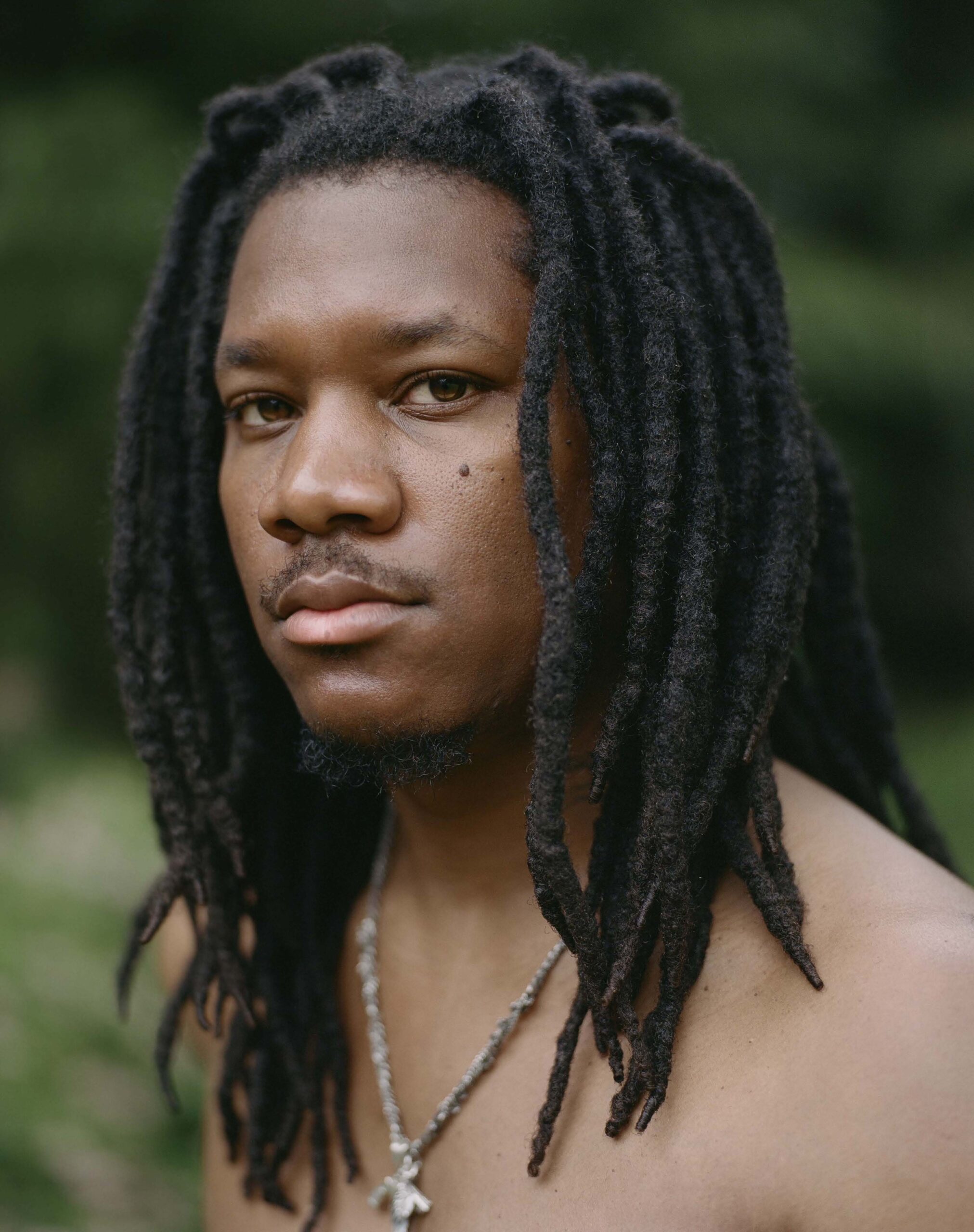
NB: Can you tell us what are some of your earliest memories of art and how do they relate to where you’re at with your practice today?
KC: I believe my earliest memories of art were that my family had an Ernie Barnes print in our living room at home and I think it was the Sugar Shack painting. Also, I was always a doodler when I was a kid, and I remember I would get in trouble a lot for drawing in class. I think I’ve always been creative and drawn to art although I didn’t really go to art galleries or anything like that when I was younger, but I’ve always been interested in art making in some capacity. Actually my father, he was a photographer on the side, but as a kid I didn’t view that as an art form, just for documentation. It wasn’t until I started learning and I taught myself how to do film photography that I realized it had such power to be used for art. Once I started practicing, I got more into it and eventually developed my own conceptual practice.
NB: Your work and writings are characterized by themes of mental health, identity and trauma. Can you tell us more about how you approach these topics?
KC: Through my writing I always try to maintain a certain level of honesty, transparency and introspection. After going through a lot of mental health issues myself, a few years ago I realized that writing was one of the best ways to deal with and understand those issues and concerns. Also making work about something that I’ve personally experienced helps me understand more about myself. After speaking to my mother recently about mental health struggles that she also dealt with, I started to learn more about how these things can be cyclical and repetitive within my own family and within my friends’ families. I try to use that in my work and writing as a tool to understand why these patterns continue to reoccur as I search for solutions to break those patterns. I also have a background in math and one thing you learn in math is that almost everything can be broken down into some sort of pattern. I’ve always been a logical thinker looking for patterns, but art is a creative way to isolate patterns and change your understanding around certain issues. Art making also helps develop your understanding of yourself in relation to those issues, whether on a social micro level or a macro, wider level.
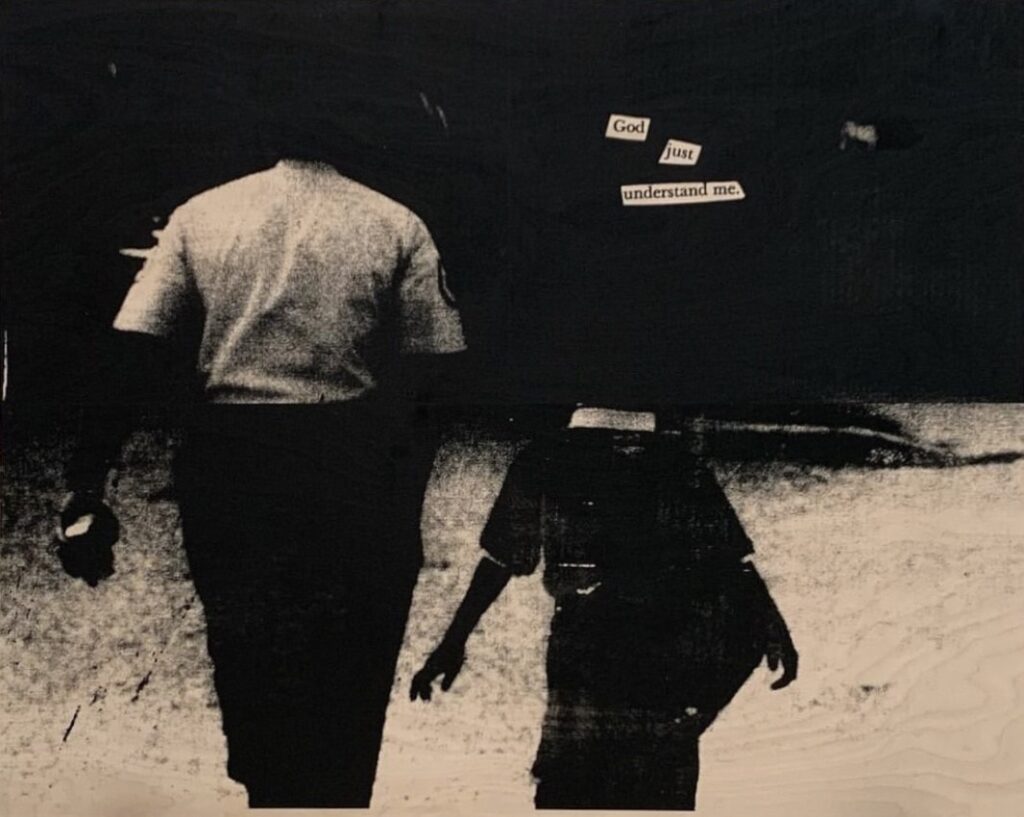
NB: Given the wide range of disciplines within your practice, video, collage, sculpture, writing, photography, silkscreen painting, how do you determine which medium to work with next? Do you think different mediums apply to different concepts?
KC: Absolutely. I love working in multiple mediums because I feel like it allows me a level of freedom that I believe all artists should give to themselves. I don’t think any artist should be boxed into one medium or mode of making. I think you should definitely take the time to master at least one, yet I think it’s more beneficial and advantageous to your practice if you try to do things that you’re not an expert in because you end up learning new techniques or approaches to your main mode of making. I also don’t like limiting my approach to the one that I’m strong in, because you don’t always know the one you’re the strongest in (you might think you know, but you don’t always know).
That’s why I try to work with the idea first, the medium second. If I work that way, then it gives the idea more space to evolve beyond me constricting the idea into a box of “this idea has to be a photo, or a painting, or this idea has to be a sculpture” If I just say this is the idea and then allow that idea to tell me how to present it or not present it then I think the idea gets to live longer in a better way.
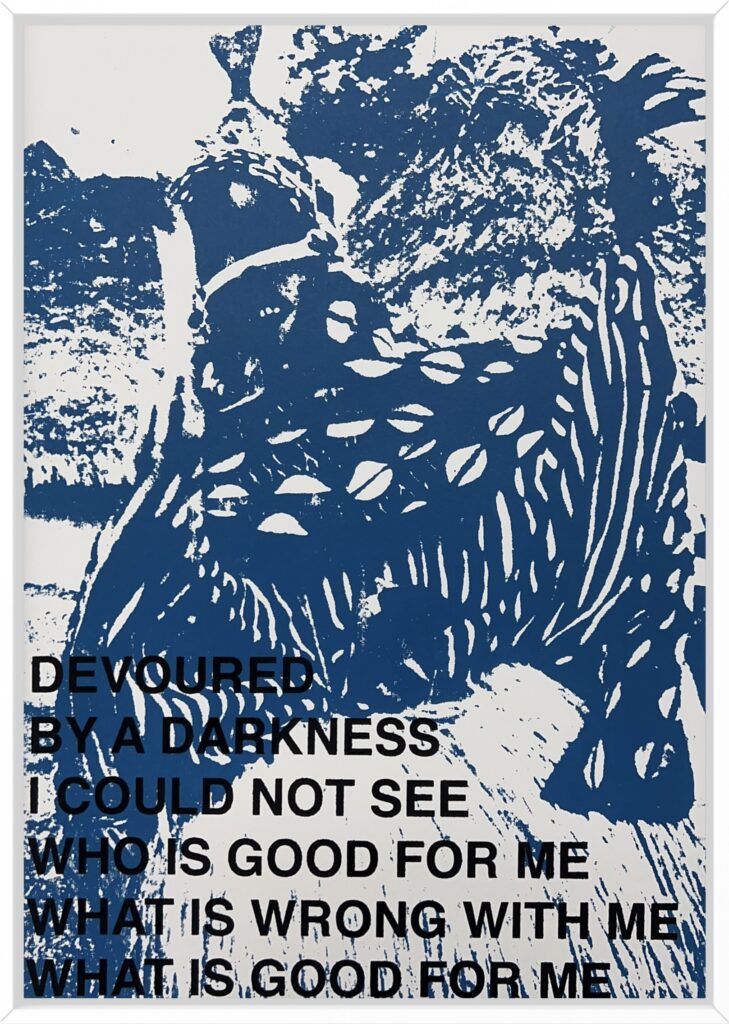
NB: So what are some artists or people that you admire or that you’re looking at right now?
KC: I’ve also been listening to a lot of Gil Scott Heron, his spoken word and older albums and looking at the artwork of Tomashi Jackson and Torkwase Dyson. Those are probably the only two as of this week, because it’s ever changing and there’s way too many talented people to keep track of. I try not to get too caught up in what other artists are doing because it may be distracting, although I think it’s a good thing that nowadays we can see what people are doing through social media – what they’re doing within their own practices and if they’re taking risks.
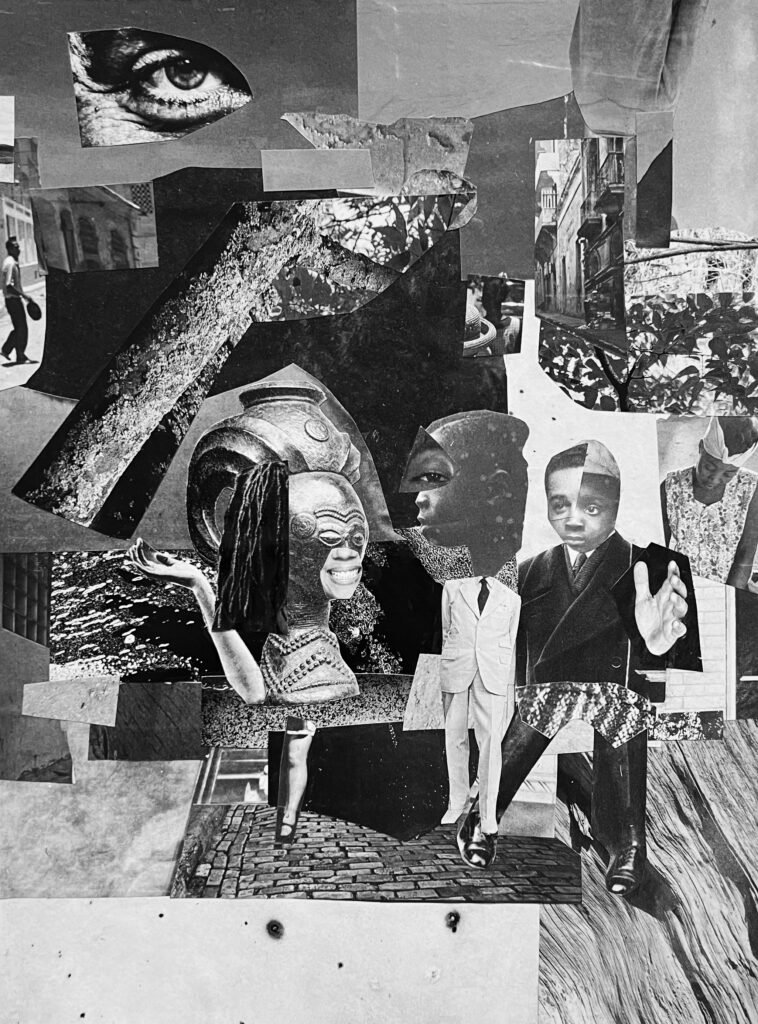
NB: So can you tell us about your most recent exhibition, Understand Me at Osmos Gallery and the group show Dark Matter at Kates-Ferri Projects?
KC: The solo show at OSMOS consists of photo collage and paintings. The series of paintings are titled The Unconformity Series, and they’re inspired by the Great Unconformity which is a missing chunk of sediment in the Earth’s crust about 100 million years to 1 billion years long. The image and text works in the show consist of found imagery from my family archive and from books that I own referencing West African sculpture and art. It’s a show about fragmentation of identity, it’s about lost history, and it’s about reclaiming or recreating one’s personal and historical and familial narrative. The Dark Matter show at Kates-Ferri Projects is about how dark matter exists in space, but it’s not something that can be observed and the group show takes a bunch of different approaches to documenting or creating that which cannot be observed or captured. The works that I have in the show are one of the Unconformity paintings and one collage, a piece of abstraction with a piece of fragmentation. I love how the show came together, there’s a lot of variety within the works and mediums, and how people are using those mediums in unconventional ways.
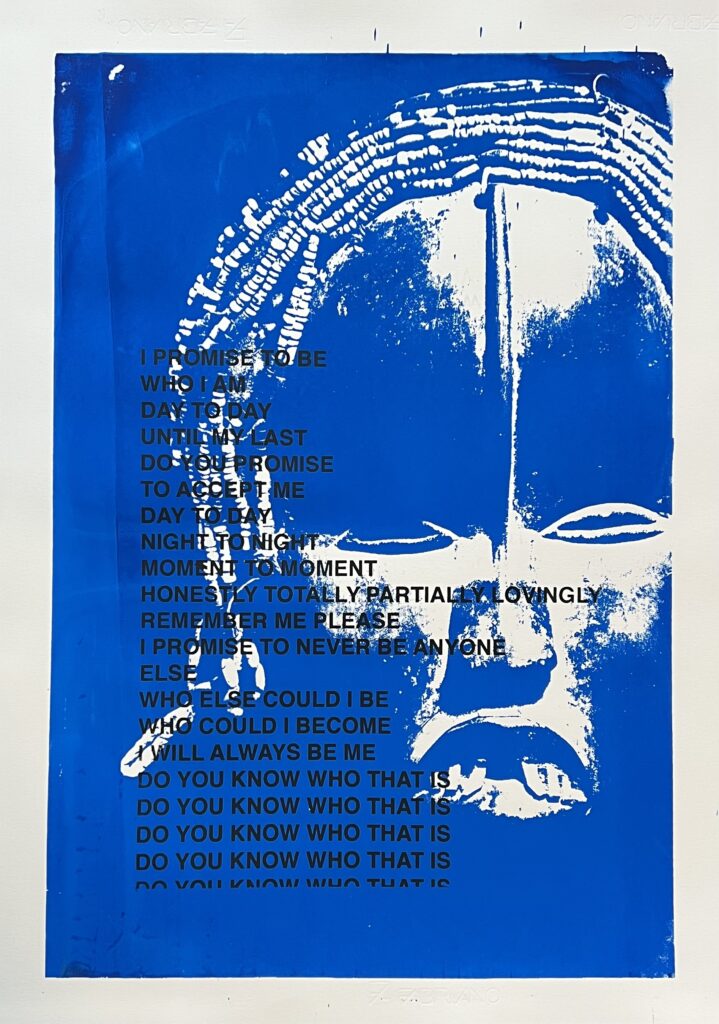
NB: So lastly, what are some projects that you’re excited about in the future?
KC: I’m working on a solo show that will be in Sweden this year at Public Service gallery in Stockholm and working on a group show in New York for June. Personally, I am trying to use more of my writing within my work. I’m really interested in trying to figure out different ways that my writing, my language, and words can exist within my work, and trying to step outside of my comfort zone when it comes to the way in which I use my text and poetry and the word itself.
January 10, 2023
Artist to Watch
GABRIEL MILLS
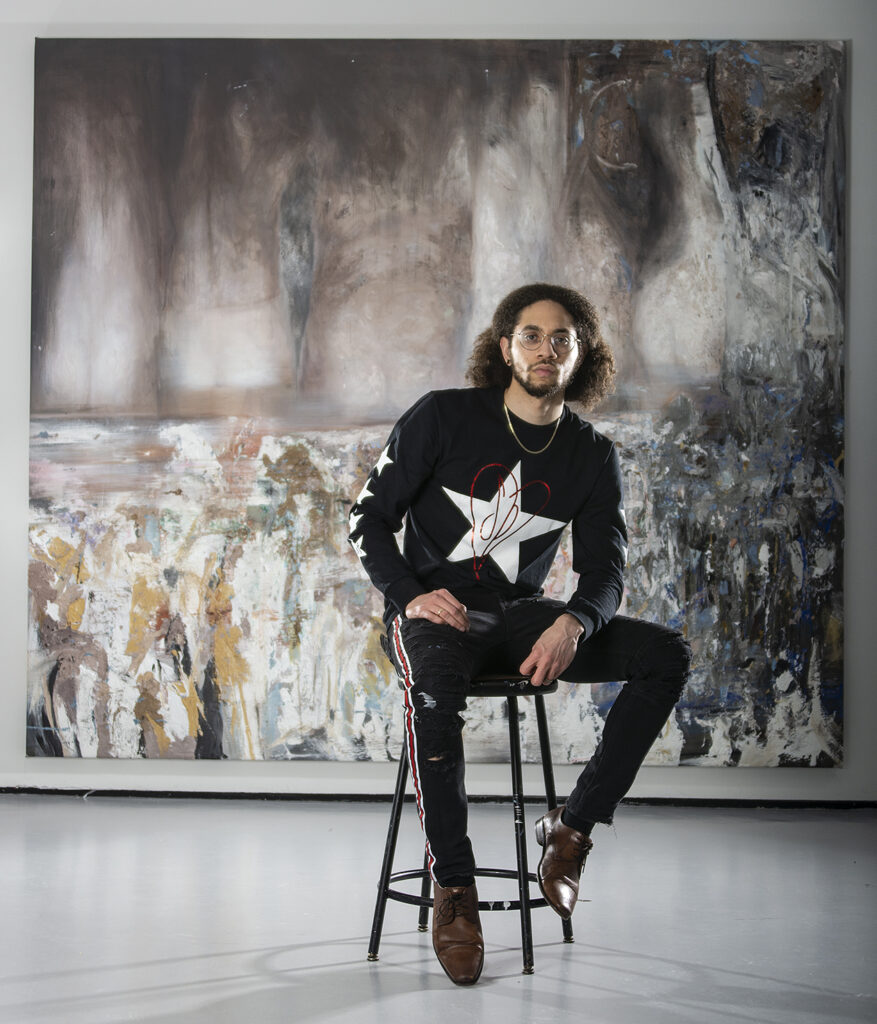
NB: Can you tell us about your experience with art before Yale and how you have arrived at where you are now with your practice?
GM: My training was classically inclined. I maintained non-academic experiments outside of my studies. At Yale, I synthesized my interests. Currently, I follow my hunches, and unforeseen space opens up. Simultaneously, I revisit familiar territory with an adjusted level of rigor and perspective.
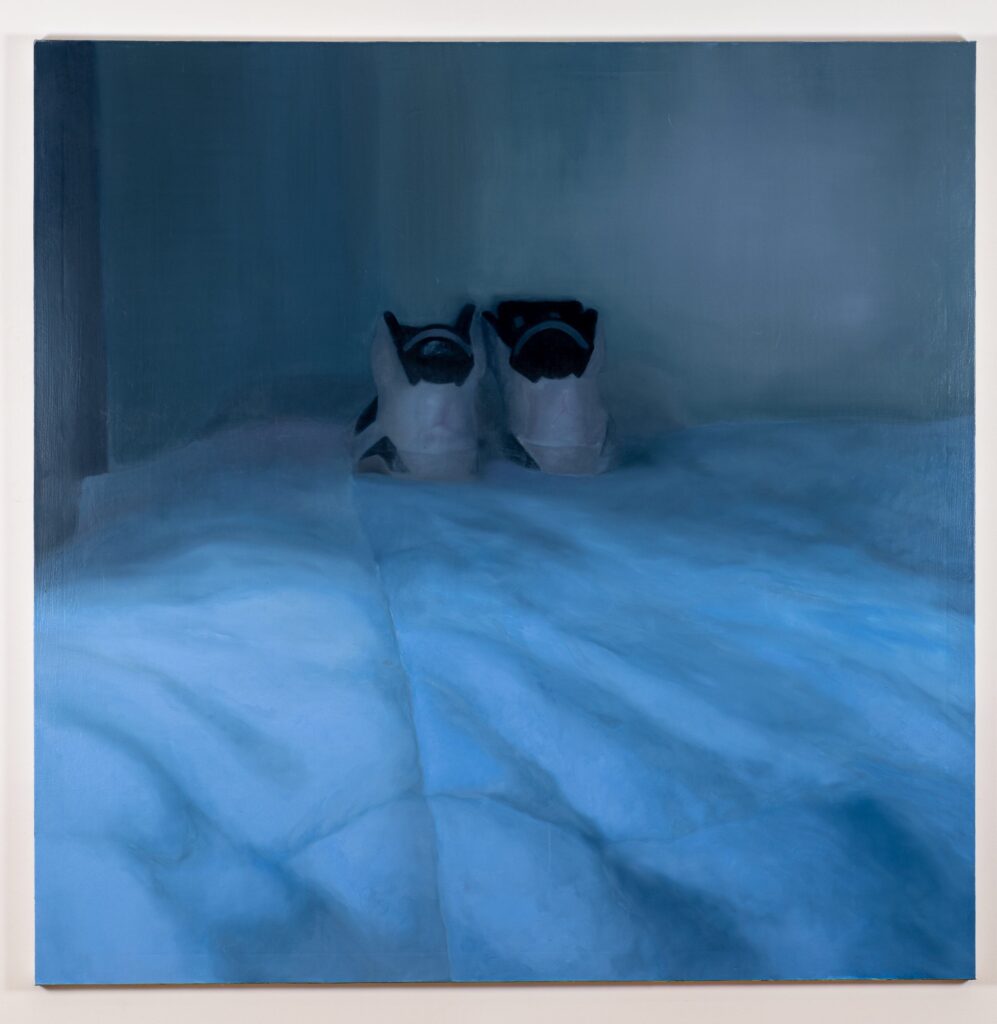
NB: Can you speak on how the physicality of paint is used to address the subject matter of your work?
GM: Love, time, and weight are central subjects to my practice. The range from heavy topographical to smooth atmospheric surfaces is a byproduct of a considerate process for those subjects.
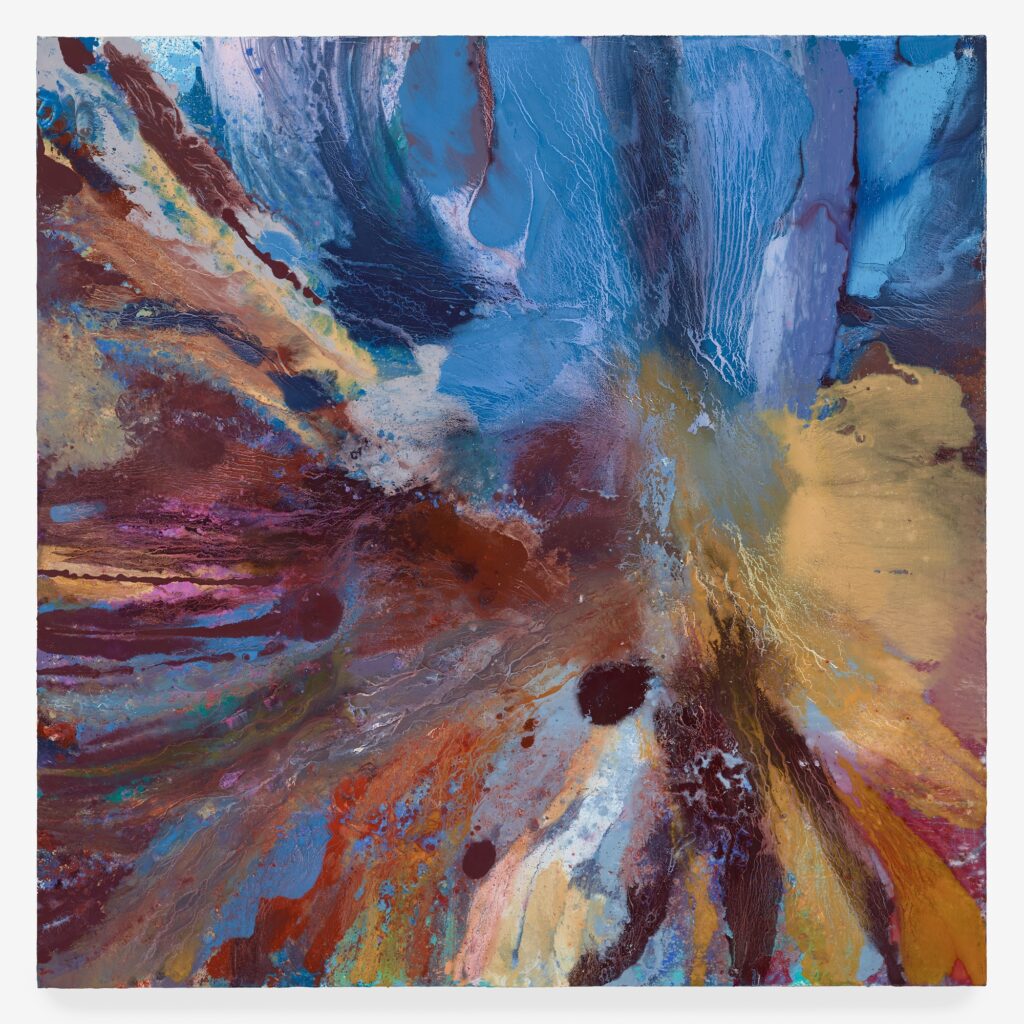
NB: Could you share more about your painting process and in what ways the process differs between your abstract and representational work ?
GM: On the surface, the abstract paintings aggressively deal with the physical nature of oil paint; The representational work moves towards non-narrative while weaving in and out of legibility.
I’m bringing my full self to each work, to then go on an arduous journey. The destination isn’t ever a physical location; it’s an internal realization. The outcomes of said process aren’t predetermined to be on a binary of aesthetics. I understand the distinctions between modes of painting, but I don’t think in those terms while I’m creating.
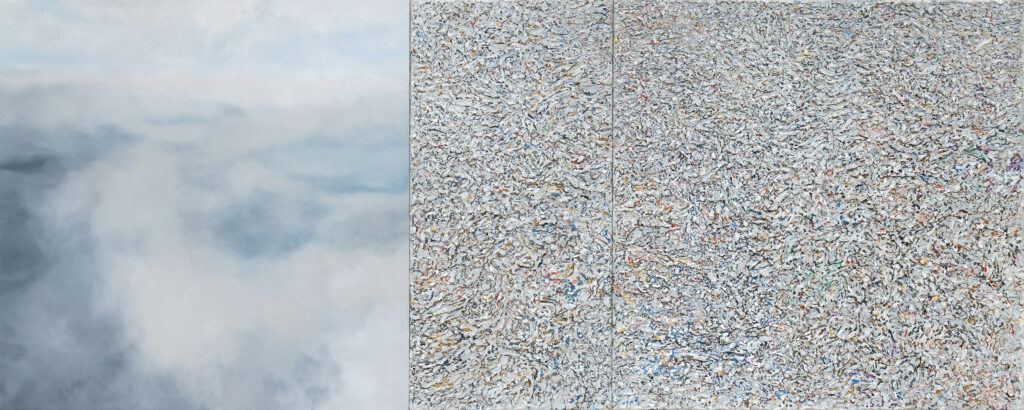
NB: What is the intent behind the compositions of your diptychs and triptychs? Is there a particular story or narrative to these works?
GM: There is no specific grand narrative. Instead, there are themes for contemplation; occasionally, a piece will be narrative. Each painting is a new opportunity, and none of them are promises. My motivations are to examine relationships by forcing familiar situations to exist alongside an unlikely companion..
NB: In your recent show “Butterfly March” at Alexander Berggruen there’s a series of abstract ‘color field’ paintings. Could you walk us through the process behind these works, and tell us a little bit more about this exhibition?
GM: The “Butterfly March” exhibition contained a wide range of approaches to painting revolving around existential themes; Living multiple metaphorical lives, dying through the flesh to be reborn in spirit.
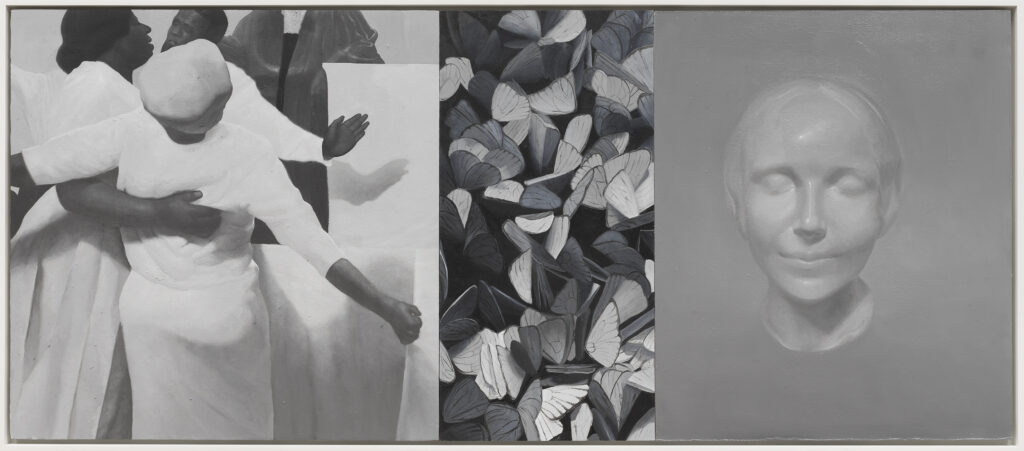
NB: What are some projects in the future that you’re excited about?
GM: Painting is most exciting; seeing what comes of it all is exciting. That’ll always be my case. An exhibition catalog of “Butterfly March” will be coming out soon, via Alexander Berggruen. Regarding exhibitions, my next solo show is in March 2023, with Micki Meng gallery in San Francisco.
December 6, 2022
Artist to Watch
RACHAEL ANDERSON
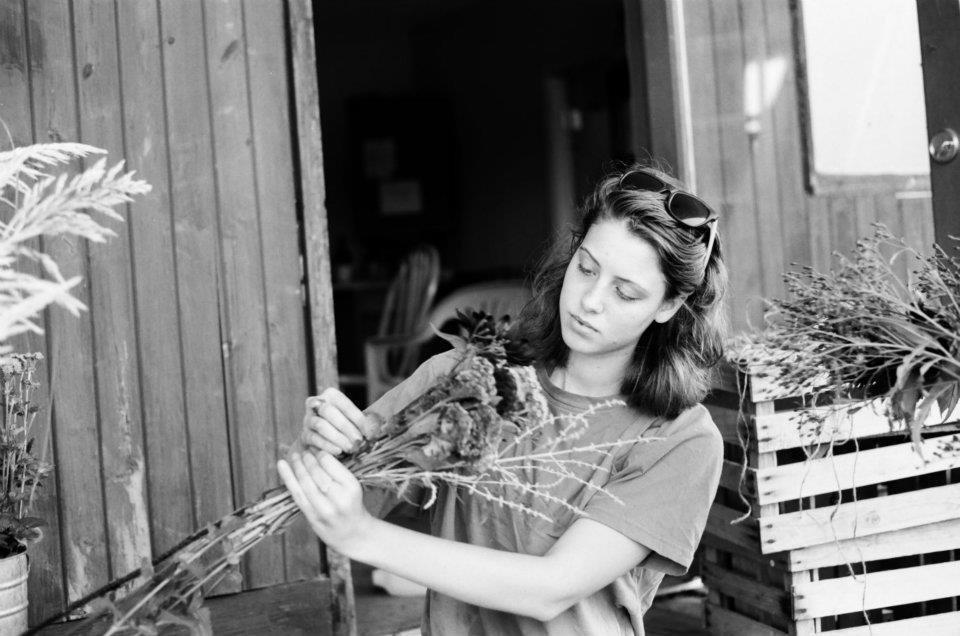
NB: What are your earliest memories of art?
RA: My upbringing on an apple orchard and flower farm is a huge influence on my art. My earliest memories are of making things out of found materials outside while my parents worked in the orchard.
NB: Can you walk us through the process of your work, from the moment you chose an image for reference until completion of a painting? Would you consider your work to be premeditated or intuitive?
RA: I usually find objects and spaces that have a certain affect, mood or shape and put them in relation with other things and spaces. Some of my favorite things to paint are bones, leaves, flowers, wheels, feathers, pumpkins, compost, and thickets. I try to paint from observation initially and as the painting develops, I abstract certain parts of it. I don’t start with a full picture of the image I am making. I begin imagining a bouquet of objects that can communicate ideas related to cycles of growth or decay, non-human agency, human relationships to the biosphere, and biological fascination. Then I find things in the world and set them up in my studio or go out and paint them from observation where I find them. I sometimes paint from photographs in order to record specific lighting situations and it’s always a balance between referencing photos and looking at things directly.
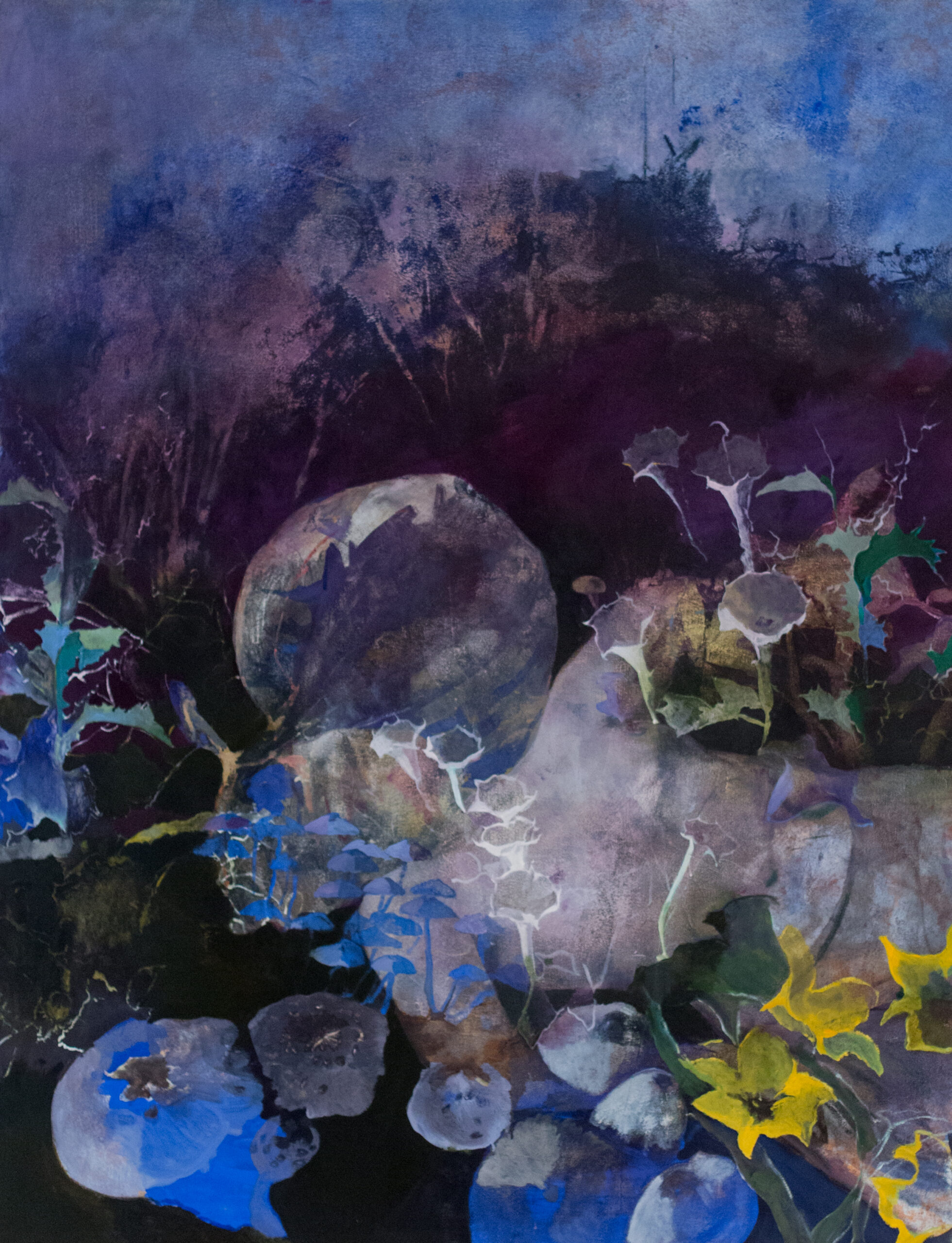
NB: Photography seems to play a very important role in your practice, can you tell us more about how it has influenced your choices as a painter?
RA: I use photography as a research tool for finding things I want to reference for paintings. Polaroids distort things giving them an effect almost like an aura that I find ethereal and haunting. I try to replicate this aura with painting. The way polaroids develop in the atmosphere and space where they’re taken reminds me of painting, too. I love to photograph objects in natural lighting during certain times of the day and night such as very early in the morning or right before the sun goes down. This adds drama to whatever I’m looking at. I notice how light is always changing things–nothing is ever still.
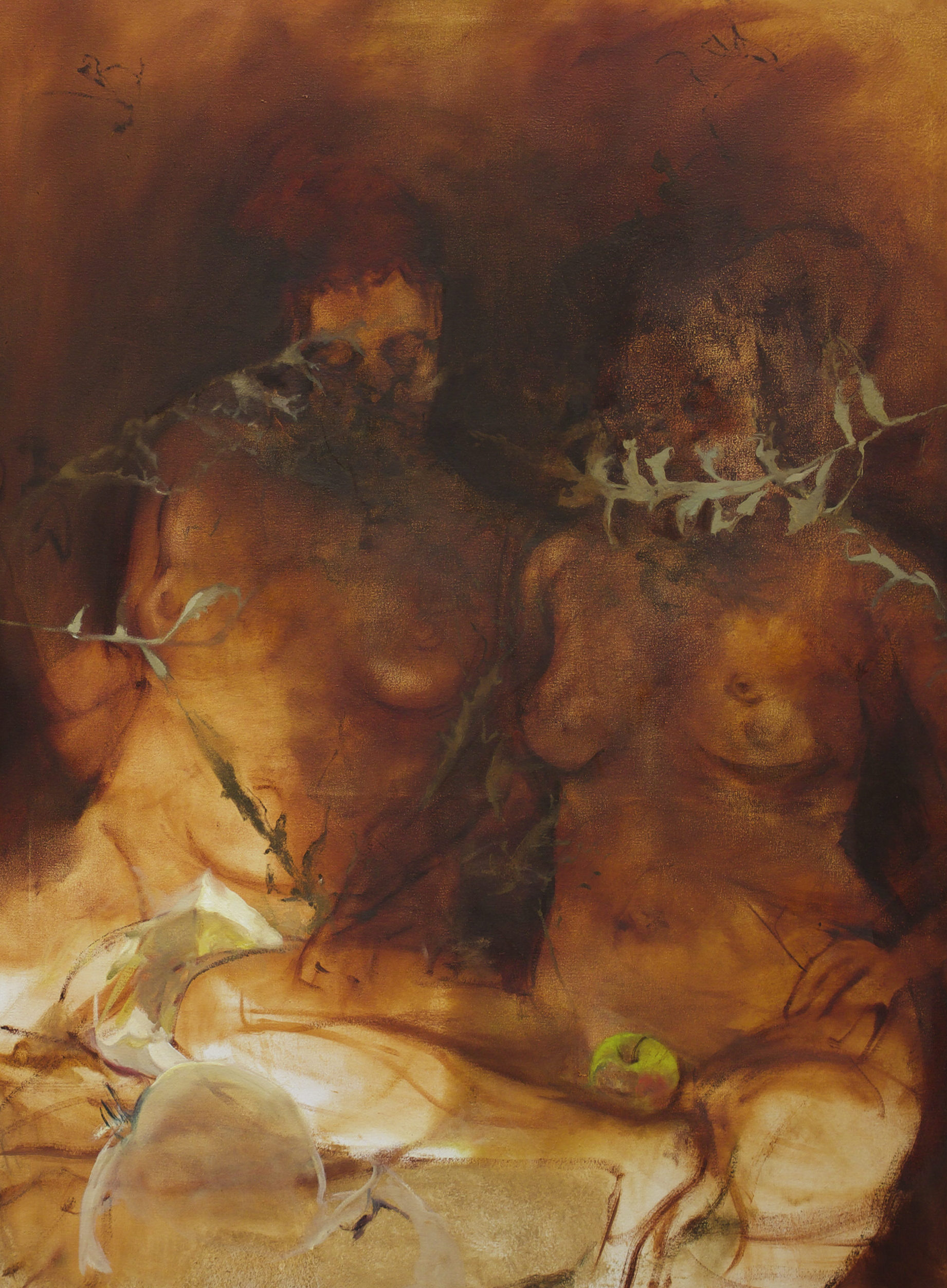
NB: What are some of your references in art history that impact your practice today? What are some artists you are looking at right now?
RA: Women surrealists and spiritualist painters like Leonora Carrington, Agnes Pelton, Georgia O’keeffe, Max Ernst, Victor Man, Fra Angelico, Bjork, Francesca Woodman, Albrecht Dürer. More specifically, I love O’keefe’s masterful painting. Her closeup crisp florals reinforce for me the wonderfully bizarre forms of plants and bones, they have character and personality and somehow it feels as if they don’t care about us. I love Fra Angelico’s colors and his use of light and Max Ernst’s nature at dawn paintings. I am attracted to classical paintings for their spiritualism and emphasis on light. I like the challenge of framing things with light that speaks to both the 21st century and the past, working in this way feels as if traveling in time.
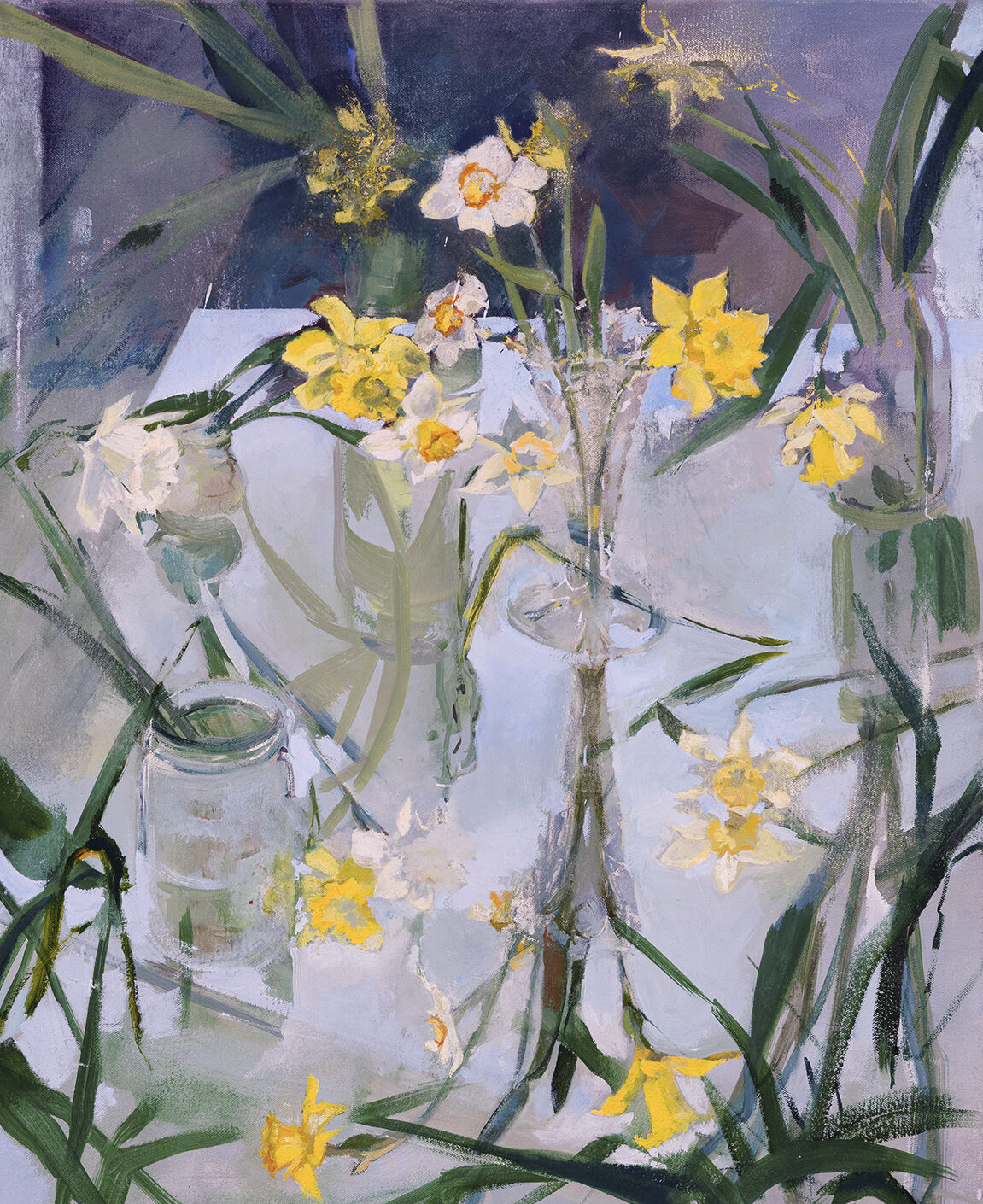
NB: Can you tell us what is the intent behind your use of light and color and how this is related to the titles in your work?
RA: I reference light and color in my titles to describe whatever phenomena I’m pointing to in the work. Some titles reference the golden hour, twilight, the coolness of a mirror, the spectral quality of green leaves, the blue radiance of the light cast by the moon, the fluorescence of a light bulb, the toxicity of cobalt. The distinct seasonal lighting within which the painting is made is often very influential to its title, and central to the work itself.
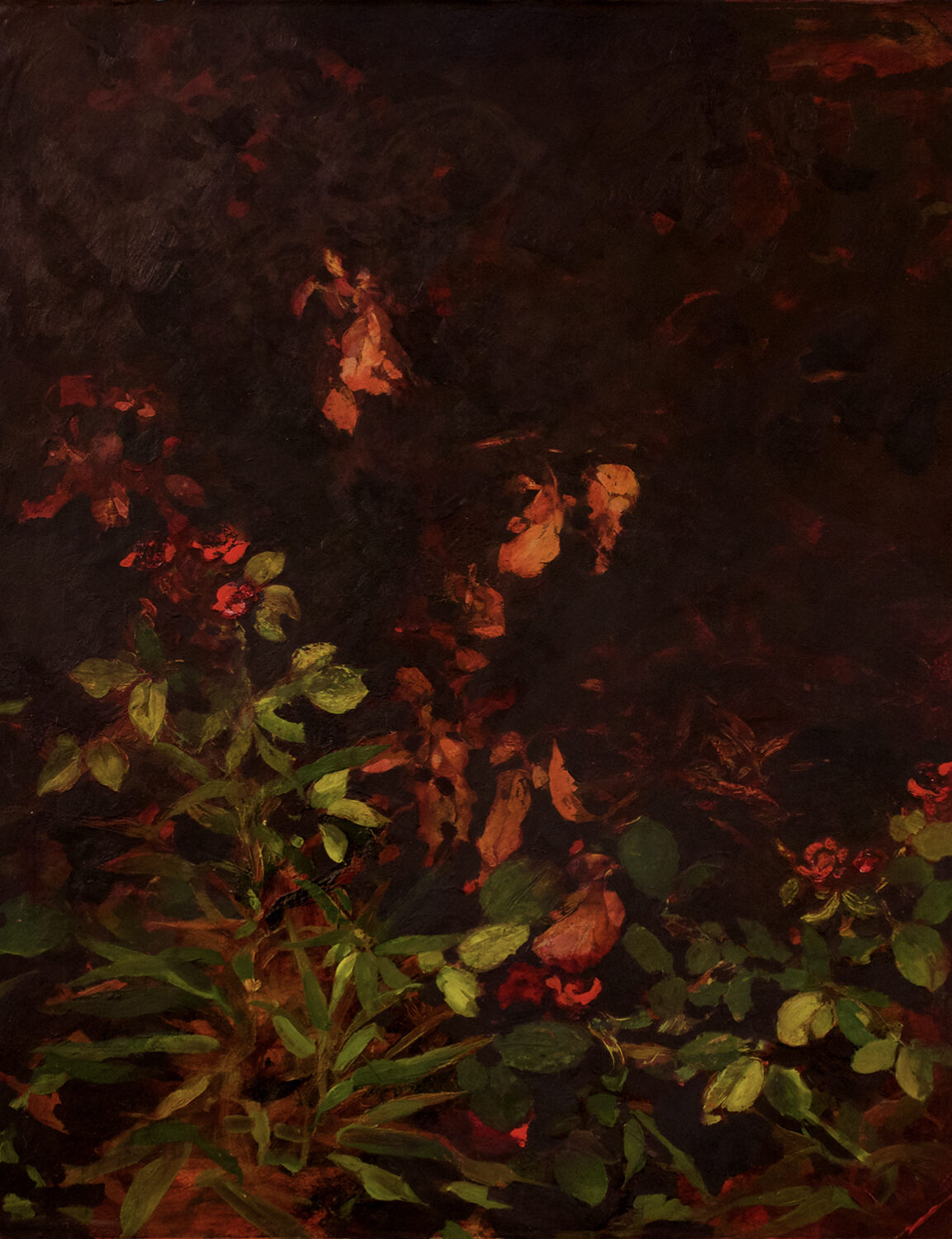
NB:What are some projects that you are working on or are excited about in the future?
RA: I’m excited to explore my hand in painting more and more and to continue to surprise myself, for now I am focused on just painting in my studio. I am also very happy to be included in a group show titled the Floral Impulse curated by Xaviera Simmons at David Castillo in December.
November 2, 2022
Artist To Watch
RACHEL LIBESKIND
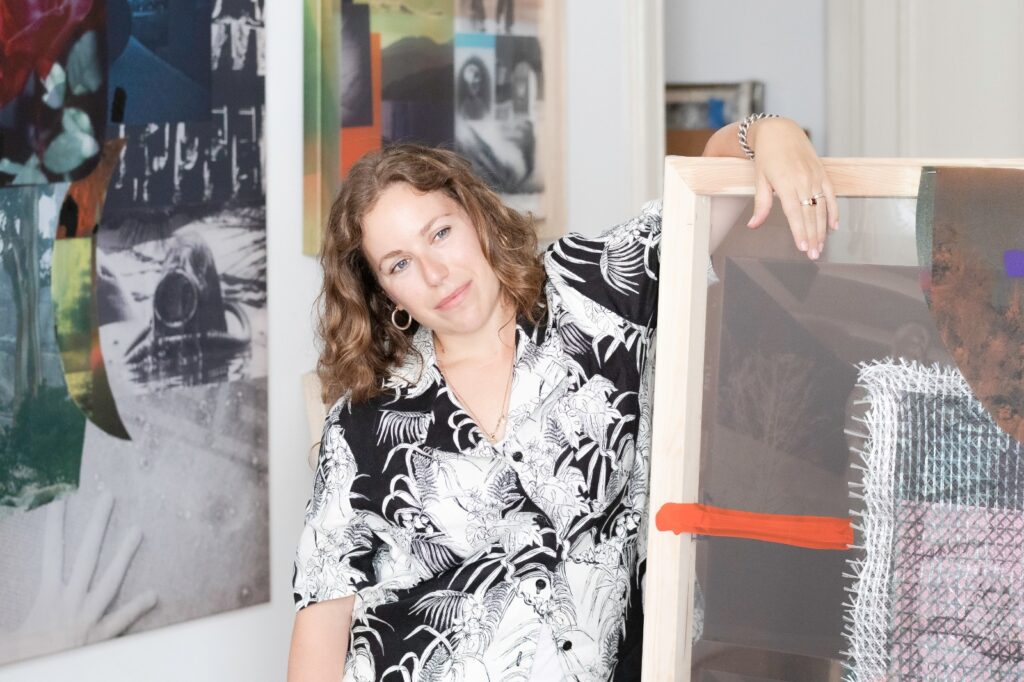
NB: Can you share your experience with art as a younger woman and how you arrived at what your practice is today?
RL: I am very lucky to have been raised in a very artistic family. As a child I was always encouraged to follow my dreams and was told that art was the best thing you could do with your life. I spent a lot of time making art, although as a child and young adult I was much more involved in acting and singing, and I did a lot of that professionally as a kid. At university I got a degree in French Literature; since I finished early and had two more years left, I figured I would get another degree in visual studies. I had a great professor who suggested I should be an artist, so this is where I ended up. (I also graduated into a profound recession and watched the government and economics majors struggle to find work – being an artist made sense in that context).
I now realize that I’ve had great luck in terms of showing my work, selling my work, and being able to actually have a valuation of my work.
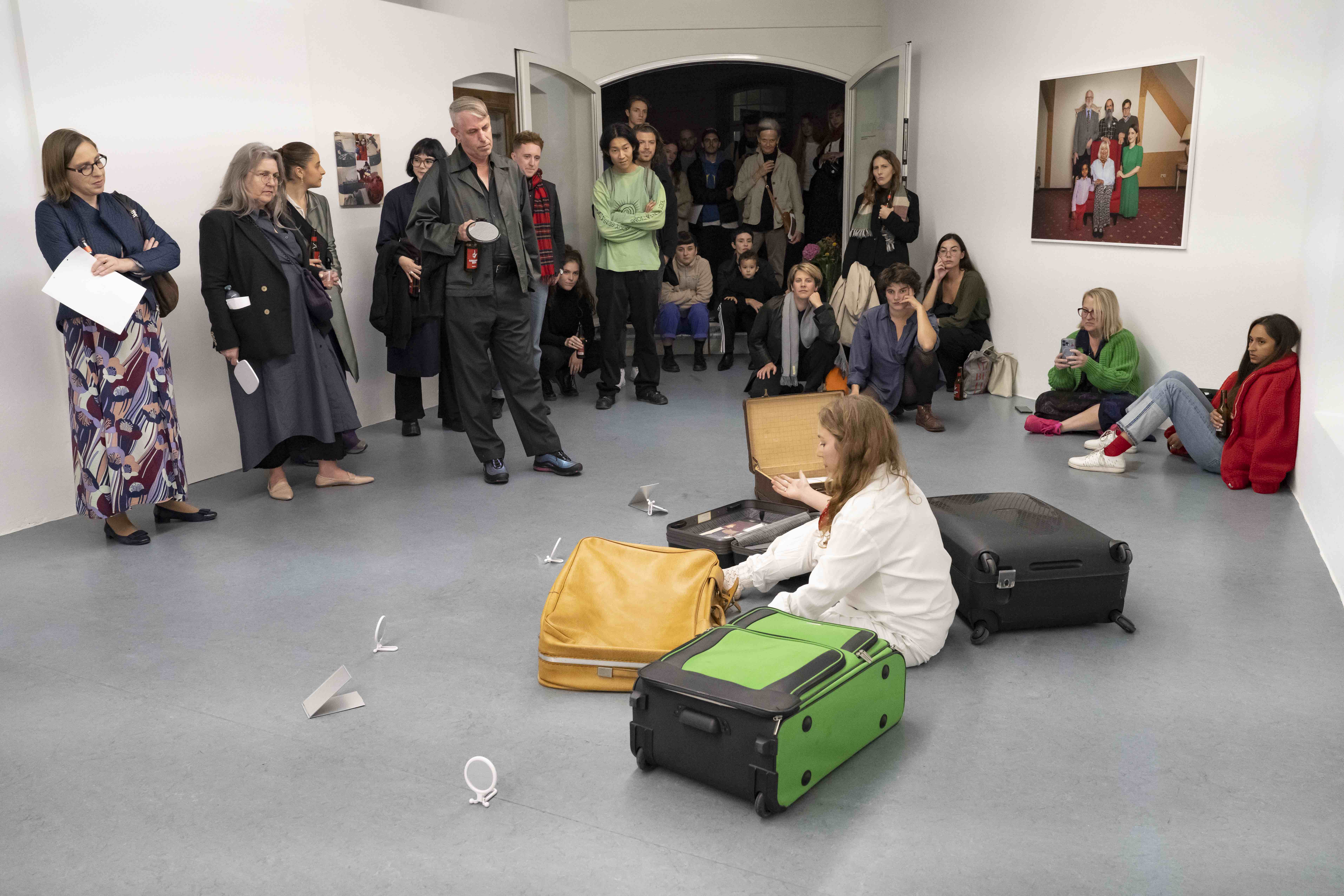
NB: So can you speak on how the process of collage, installation, video and performance inform each other and how does your approach vary between them? How is a live performance different from other works?
RL: The way I think about it is that all of my work has a collage logic. That is to say, I allow myself to freely take and mix any element I want in whatever form I’m using it –that’s the beauty of collage, that it’s the most liberating form. A lot of artists are very specific, and I have been told many times in my life that I should narrow my practice, but I just can’t. I am someone who’s very multifarious, and I really believe that every idea I have that I want to transmute to work deserves its own form and deserves to be critically examined in whatever form it needs.
The performances are a little bit their own world, they serve to me as this connective tissue between my research and my studio practice. For me, performances are an opportunity to imprint people in a different type of way because it’s the most ephemeral form of art. I think a lot about my performance practice as an experience that someone has of me that they’ll never have again. In this way performance is an incredibly unique and wonderful thing that I believe all artists, even people who have nothing to do with performance, should pursue.
NB: How do you describe the parallel between the personal experience and community engagement in your work? Are there certain projects that you feel are more personal than others?
RL: Yes. The performance work is always hyper personal because I’m there as the work, and I’m always telling a story. My studio practice and the work that gets shown in galleries and institutionally is personal because it’s me making it, but there’s a negotiation that happens with how much vulnerability is allowed to permeate into the presentation of work. Vulnerability and authenticity are, in my opinion, the key to what makes art “good”, although this also can make things too heavy-handed at times.
Another important aspect is history, the central framework of my practice. History is collective, but the way in which we encounter it is personal. I’m interested in the different ways in which we all think about history, the ways in which we were all taught history, and the ways through which we all connect to our own histories. It is within those fault lines, where the personal comes up for me and for my audience.
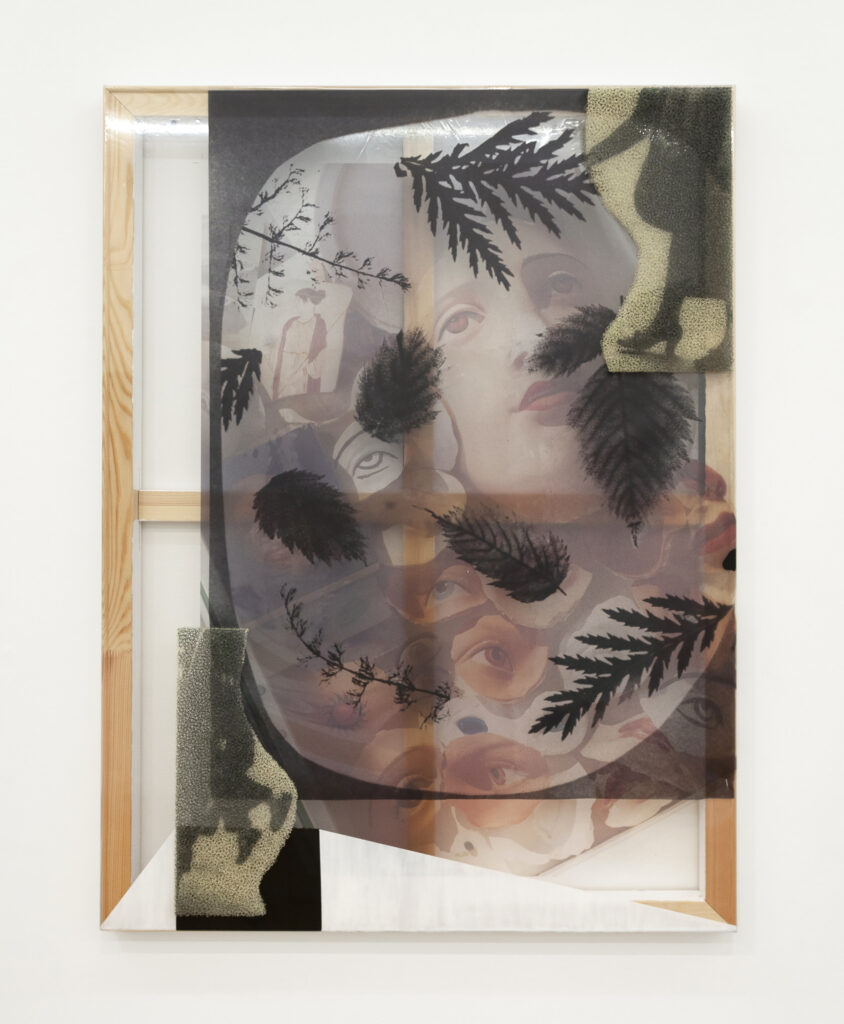
NB: Your work often consists of image archives that reference history. Can you talk about this process and how the work evolves from the initial research towards a finalized work?
RL: The initial research is often a very long and slow process. It begins when I encounter an image and I think “what is this crazy photograph? I’ve never seen this” or “who took this? Where does it come from? Who are the subjects and why were they chosen?” And then for years I will slowly build research around it, meaning there’s often multiple concurrent research projects happening in the studio. Luckily I have brilliant people to help me with it.
What ends up happening during this process is that my specific interests or questions begin to coalesce and I decide how narrow or wide the archive for a specific project is: then I make a choice about the form the work is going to take. Once I know whether it’s going to be a video, an installation, a performance and/or some sort of collage, I begin to build the archive that belongs with, and informs, the work. In the end every work of mine has its own archive and that archive comprises a selection from multiple archives that exist digitally or in real life. When the work is done, the archive is closed and I usually make a book, a password encrypted website, or something that encases the archive.
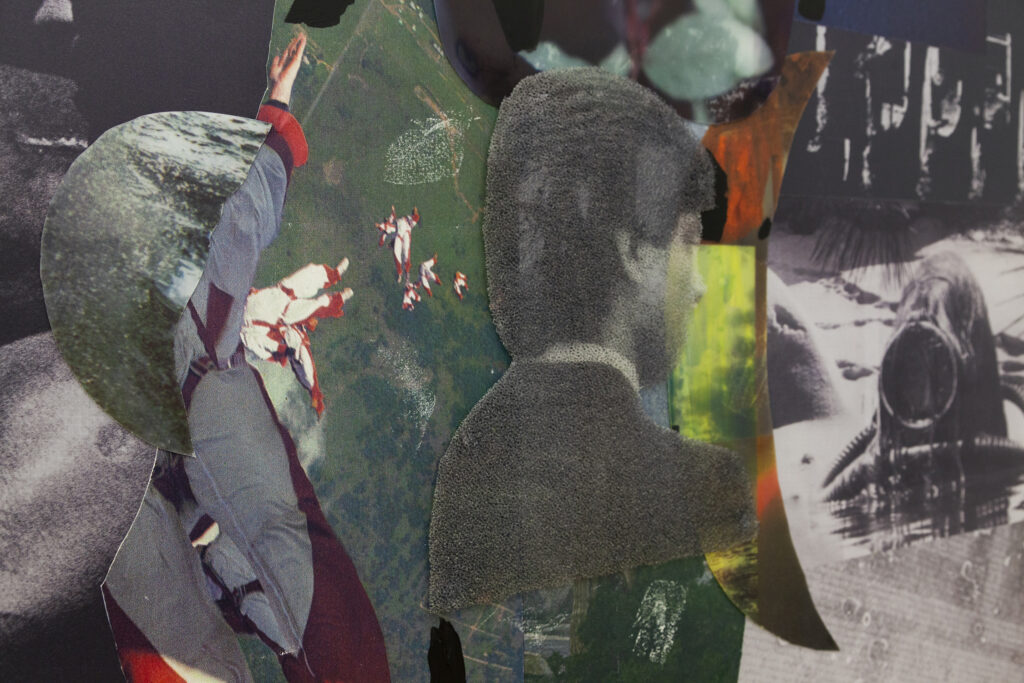
NB: Can you tell us about your most recent show, Transparent Things at Signs and Symbols and your new body of work Windows?
RL: My show at Signs and Symbols is a collection of 10 paintings (or as the director of the gallery calls them assemblages) that are made out of PVC, latex, silicone, paint, staples, linen, and paper. I basically wanted to work on a stretcher bar, to work on canvases, just because I really love Painting. I collect a lot of paintings myself but part of why I don’t usually paint, and part of why I’m sort of a mad woman in terms of how many forms I like to use, is because I’m always grappling with this masculinity of painting. Perhaps it’s because I studied with Benjamin Buchloh that I had this idea of post-war 20th century painting: I love Richter, Kiefer, Newman, Rothko, and Pollock, and these are all incredible painters, but I’ve always felt under a kind of suffocating claustrophobia of that work as a woman.
Additionally, painting is so incredible because for thousands of years, before altars and frescos, screens and photographs, we’ve been making life-like marks on walls such as cave paintings. There is something deeply innate in that process and that encounter. In the Renaissance for example, the painting that lived in the home of a usually wealthy person was like a window, this other world or portal that you could transport yourself to, in the way that a screen is today. These works at Signs and Symbols are a meditation on that, both on my grappling with “what is painting?” and what can I get away with calling a painting and enshrining myself in the legacy of great male painters.
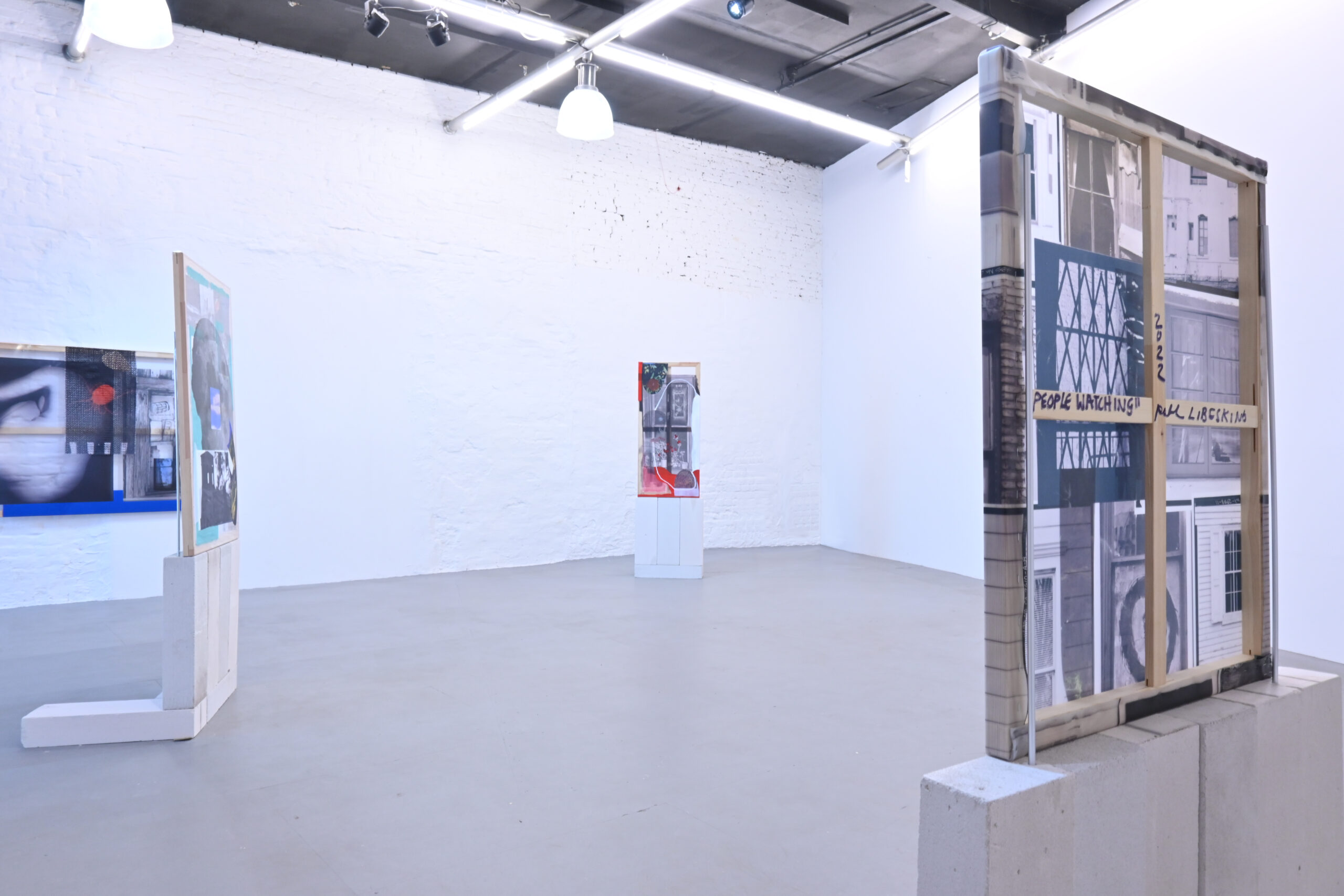
NB: Would you be able to share with us any upcoming exhibitions or projects that you’re excited about in the future?
RL: Of course. I’ll be doing a very exciting Christmas Nativity scene for Half Gallery Annex that will be up for a few weeks over the holidays, at the corner of East 4th and Avenue B. I’m not actually Christian, but I really love nativity scenes because there’s no irony in them, and it’s such a wonderfully direct opposition.
I’m also working on a project in Sicily about migration and diaspora. Sicily has such unbelievable, untouched, incredible churches and iconography that’s around, and so many people who are taking over abandoned churches and making shows in them. This whole art scene I’m starting to discover there is amazing.Lastly, I am very excited for my first solo museum show in 18 months, at the Jule Collins Smith Museum of Fine Art at Auburn University. I’ll be going to Alabama in a few months to do more research in their archive and I’m really looking forward to it.
October 5, 2022
Artist to Watch
NANA WOLKE
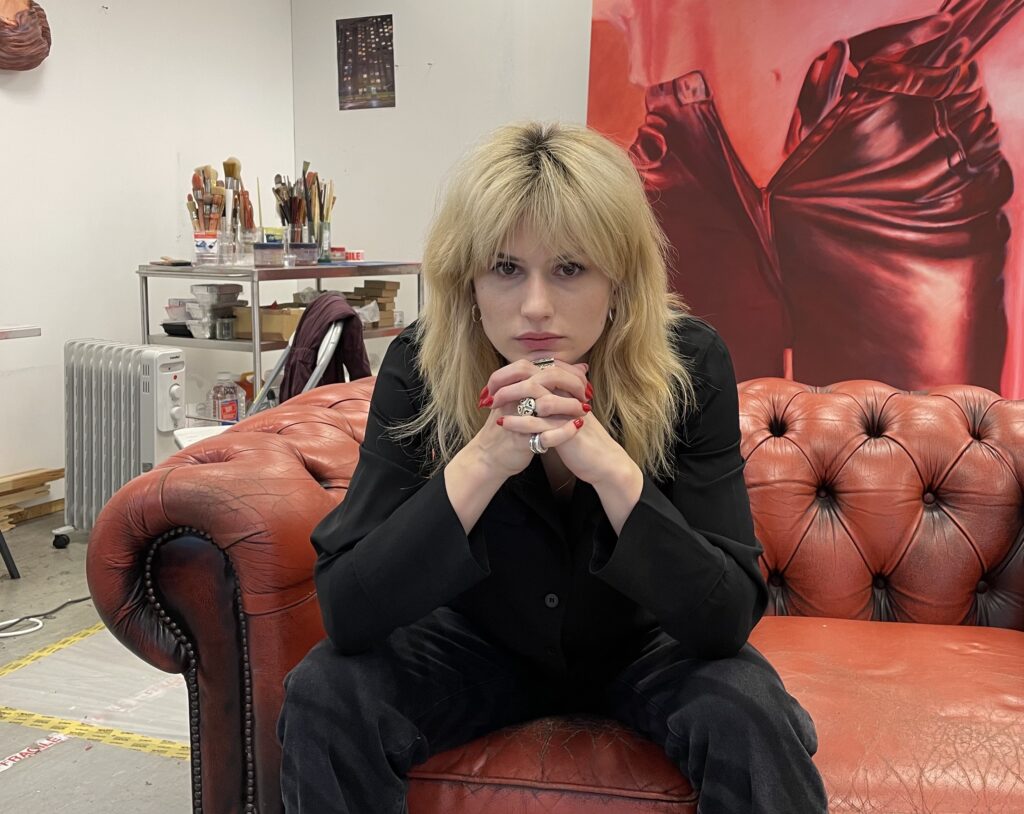
NB: What are your earliest memories of interacting with or experiencing art?
NW: As a kid and only child surrounded by adults I spent a lot of time on my own, often drawing, as that was the sort of medium that came quite naturally to me. My primary school teacher picked up on my enthusiasm for art and enrolled me in several different competitions, so I had a few experiences showing my work early on.
The other big influence came from being glued to the TV set during the post-socialist Slovenia of the early 2000s. Back then, the shift to the capitalist embrace of US culture was something that I was absorbing rapidly, always imagining this near fantastical world behind the screen. This thin line between reality and fiction is something I continue to examine in my work today.
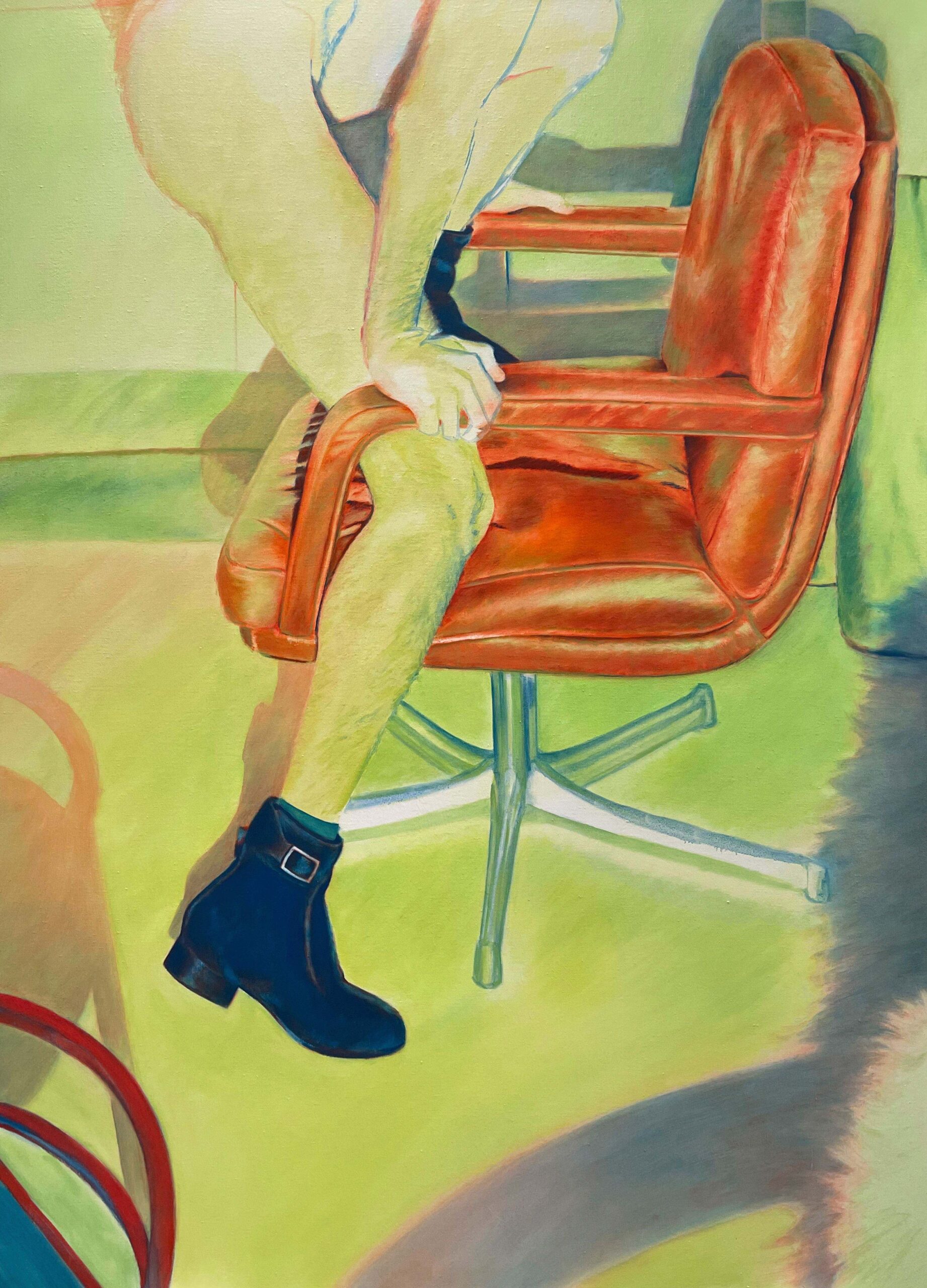
NB: What is enticing about painting as a creative material for you?
NW: My undergraduate education in Slovenia was very traditional, an academy style of program, where we had nude models and figure drawing classes, very rigid and structured. My professors thought of painting as something that had already been done. Video and installation were much more common and although painting was still treated as dead, it was also regarded as a craft of the highest order that needed to be studied in excruciating detail. I was distracted from painting for a year or so, but I naturally gravitated back towards it. I don’t believe you really get to choose the tools with which you explore and work through things.
Today I’m most excited about the element of time in painting, which is perceived as much more permanent than, for example, a freeze frame from a film or a photograph. Bringing in the logic of a slippage of a moment (the wrong frame, rather than the climactic moment itself), as well as incorporating other elements like sound, shifts the viewer’s perception of time and space within the work and away from more traditional conventions of the medium.
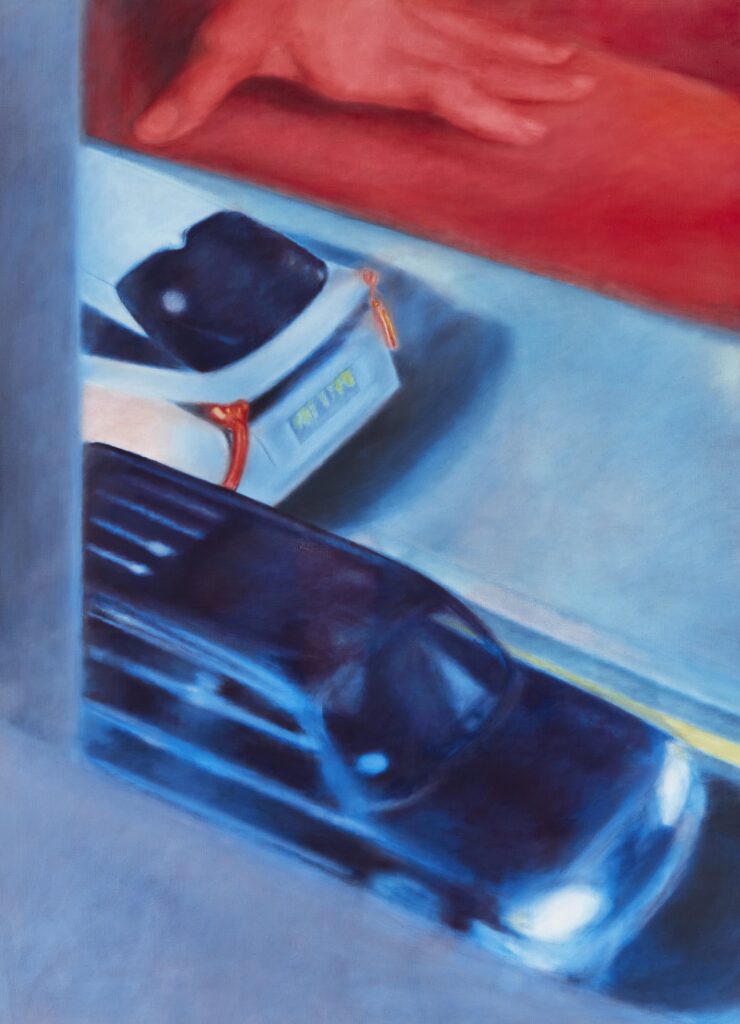
NB: Your work borrows from the visual language of cinema, what kind of influence does moving image have in your practice? How do you arrive at the visual references used in your work?
NW: I’ve always been excited about moving image, especially cinema, but it took me quite a long time to understand the full potential of how it could play a role in my practice. Around the time when I was graduating Goldsmiths, I started working with specific locations and setting private performances. I would photograph both real and scripted situations, recording atmospheric sound and other material evidence of the setting to use as reference for my work, and as inspiration for sound pieces and prop-like sculptures. Really, my works are first and foremost artifacts of these private events.
The spaces that I gravitate towards are often transitional spaces, historically pushed to the fringes of cities or fully operational when most of us are asleep; from short stay hotel rooms and public garages to inhabited apartments, and above all, the people who frequent them.
One of the spaces I recently worked with was a two star hotel in Kings Cross where I rented out a room several times over a period of a month to familiarize myself with how people used the space. Then I developed my own fictional narrative, a meeting of two potential lovers scheduled between 4:28 and 5:28 AM. I brought in actors – which at the time were really just my friends and we responded to this context together during what seemed to be a nutty experiment. The nature of the work is pretty fast too since we never have permits. I take the photos with my phone and use hunting lights instead of proper film lights which give a familiar cinematic effect but are easier to carry around.
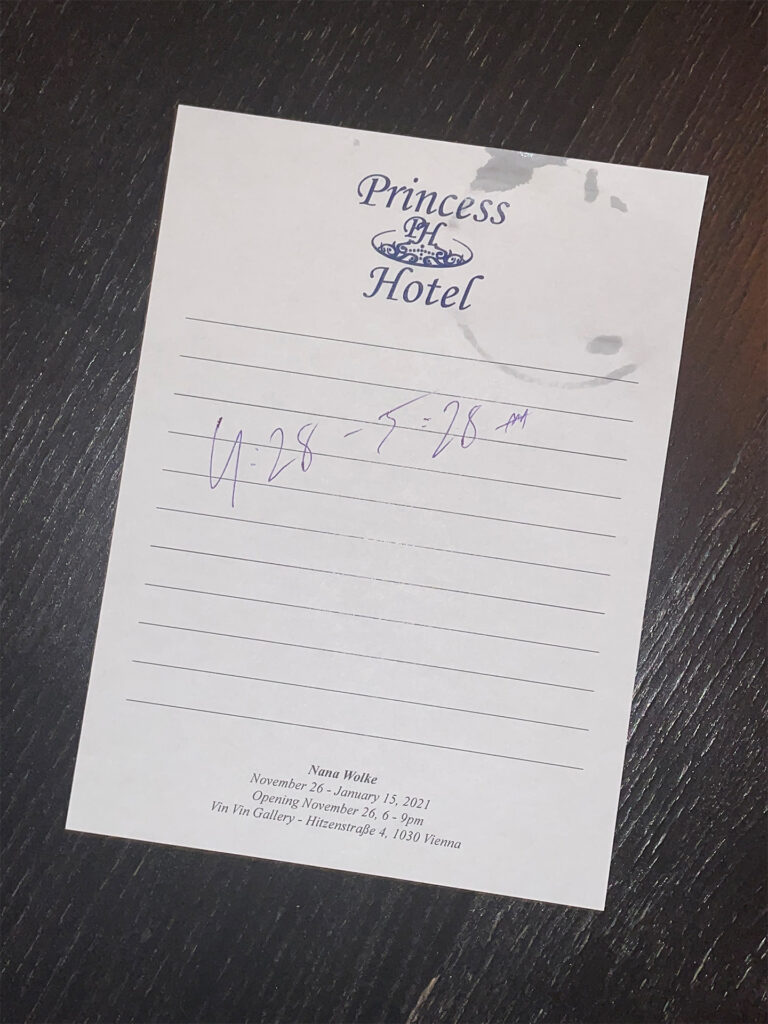
NB: Your paintings have a characteristic monochromatic palette. What informs and affects the choice of color? In what ways do you think of color to convey different emotions and scenarios?
NW: The color range actually comes from me using hunting lights to stage with. These small handheld torches have an intense beam and come with four different color lenses – red, blue, green and yellow. I consider the kind of implications that colors have in terms of how the space is going to be portrayed, what kind of atmosphere it will create, and consequently how the viewer might approach it.
I was initially drawn to the color red, which both in art history and cinematic language, but also daily life, has a lot of different connotations that are linked to danger and power as well as desire. Red light is known to blur imperfections and beautify, that’s how it came to its initial use in red-light districts. I’m quite interested in that intersection between desire and shame, the desire to look and the shame of the act itself. Now I’m focusing on two different spaces for my new work; one space is captured as an intense blue environment, which has little to do with the color’s more traditional calming connotation, yet it preserves the mysteriousness of the tone. The second space is captured in this almost toxic yellow light, which is a lot more alarming, a warning sign of sorts.
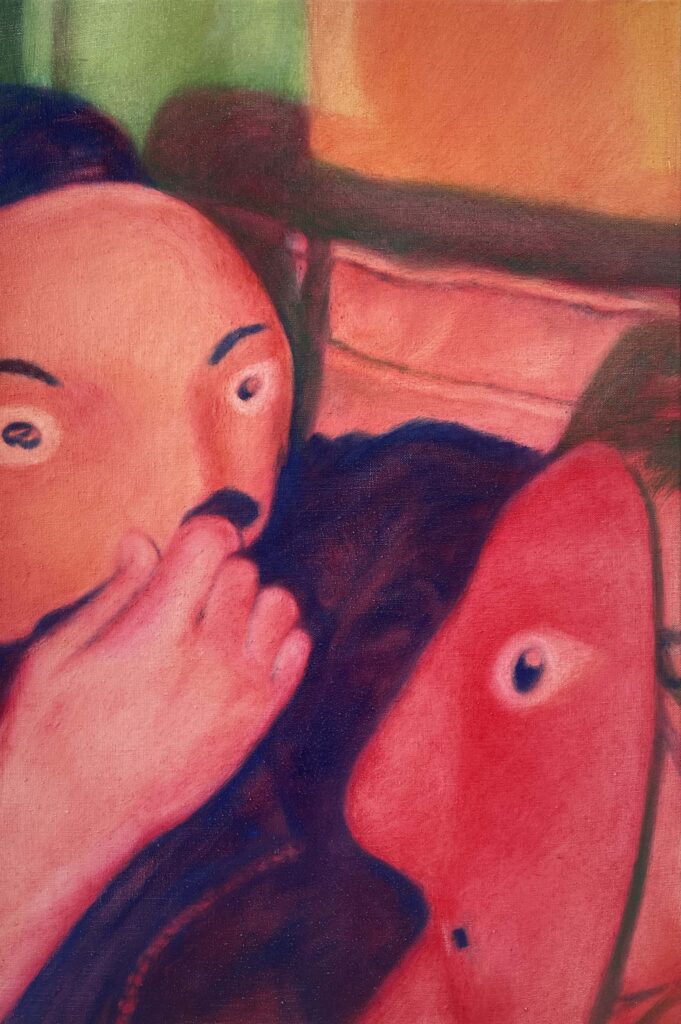
NB: So what is the role of shame in your work?
NW: Shame is a compass and a productive force that leads me into unexpected territories with vulnerability and courage. Behind that which we’re ashamed of, lies something complex on how we wish to see ourselves, the sticky stuff. I spent a lot of time hiding that I grew up in socialist blocks in Yugoslavia during my early childhood. These were self-sufficient towns inspired by the Swedish model called The Million Programme, capsules where you didn’t really have to leave an area, secluding people and pushing them towards the edge of the towns near the highways. The social housing situation in London was handled very differently, but I still find the location of Westway flyover and its surrounding neighborhoods (that I’m working with for my upcoming solo exhibition), strangely familiar.
NB: Is your work always created in series? How do you determine the beginning and the end of a series?
NW: I feel like every space I work with becomes one completed work. For example all of these new paintings that I’m working on, capturing a car park and a football pitch near Westway, are almost acting as a scenography of the place into which the viewer will walk in. So the space is mapped out and it becomes a ‘closed chapter’ in a sense. One series opens up a door into something new that naturally leaks into the next. It’s quite open-ended and flowing, and that’s one thing with painting that’s quite been quite amazing for me, like no other medium, it’s really leading me and I’m not in charge.
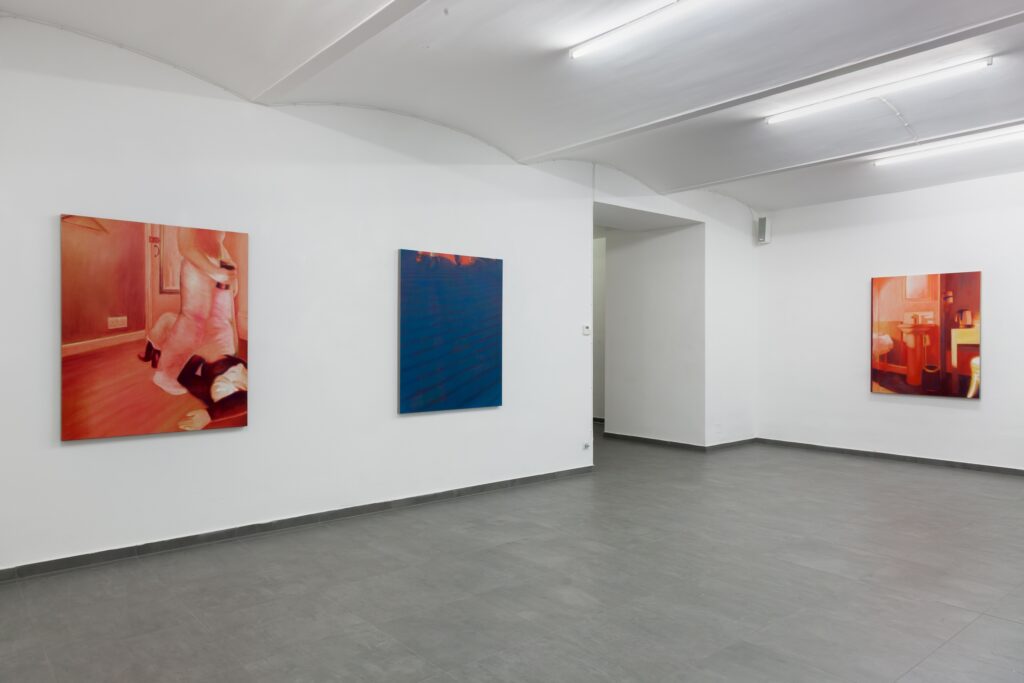
NB: Can you tell us more about what you’re working on, or any other exciting projects in the future?
NW: For my new show opening in November at Nicoletti Contemporary here in London, I took inspiration from the surroundings of London’s Westway overpass, a massive retrofuturist-looking construction, about which J. G. Ballard (author of Crash) wrote from a dystopian angle. I’m interested in how two completely different spaces intersect: a car park and a massive football pitch. I consider it as one interconnected unit because of how one is stacked on top of the other, but also because of how it’s socially used. Initially I got drawn to the incredible scene of a car park full of black cabs getting a car wash all at once. I later found out about the weekly ritual of five taxi drivers bringing in their cabs for a wash while they went upstairs to play soccer. This started my exploration of the space and then I added my own elements like the world of this fictional character, Wanda, and her admirers that are using the car park as a religious venue (which is actually inspired by activity taking place in one of the car parks where my parents live.) I will be also screening my first short film as part of the exhibition, which feels like a step closer to what’s been in the works for a long time.
I am also absolutely stoked about several shows scheduled in the new year and conversations open in New York which I can’t wait to pick up once I move back in a couple of months, after nearly four years in London.
September 1, 2022
Artist to Watch
MARIKA THUNDER
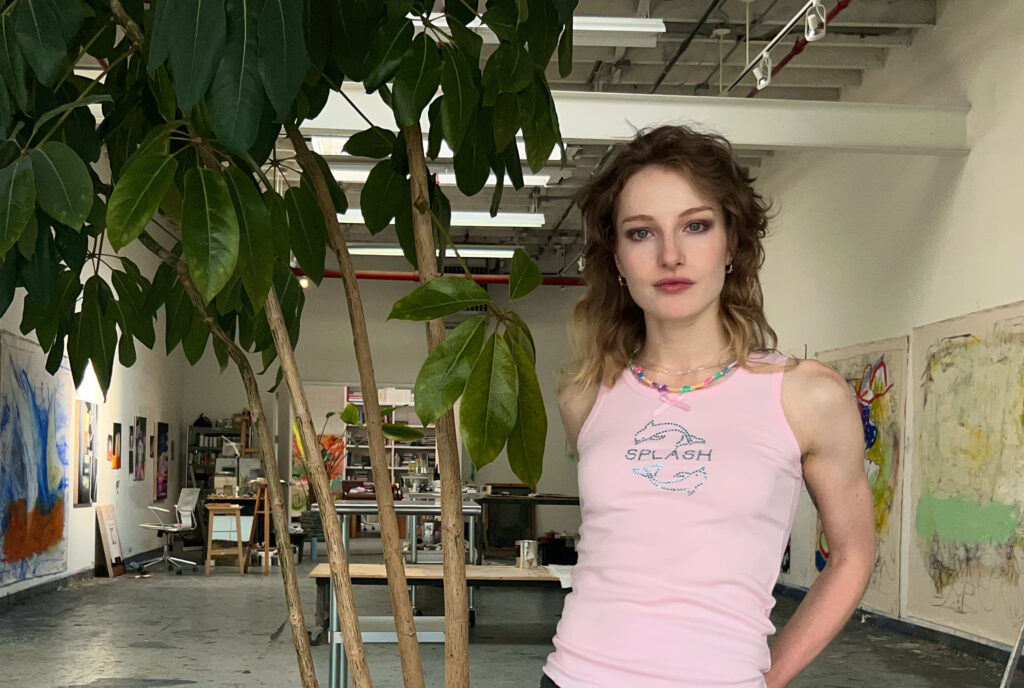
NB: What is your earliest memory of art?
MT: I was very lucky as a child because I’ve been surrounded by art for as long as I can remember. Art was never identified as a separate entity since it was so integrated in my daily life. I went to a Waldorf school where various arts were embedded in the curriculum such as painting, singing, theater, woodworking, etc. However, because I was always engaged in some sort of creative activity or project, discovering my own passion and voice was a heuristic process.
NB: What is your greatest creative inspiration?
MT: I would say my lived experiences and the internalization of them. Every now and then you come across an artwork that enlightens you by offering a new perspective, or peek into a new reality created by the artist. Such artworks show the magnificence of human creative capabilities and their impact, which inspires me to achieve that in my work someday. Since I can only draw from within my own perspective to create, whenever I hear from someone that my work resonated with them it is incredibly rewarding to me as an artist.
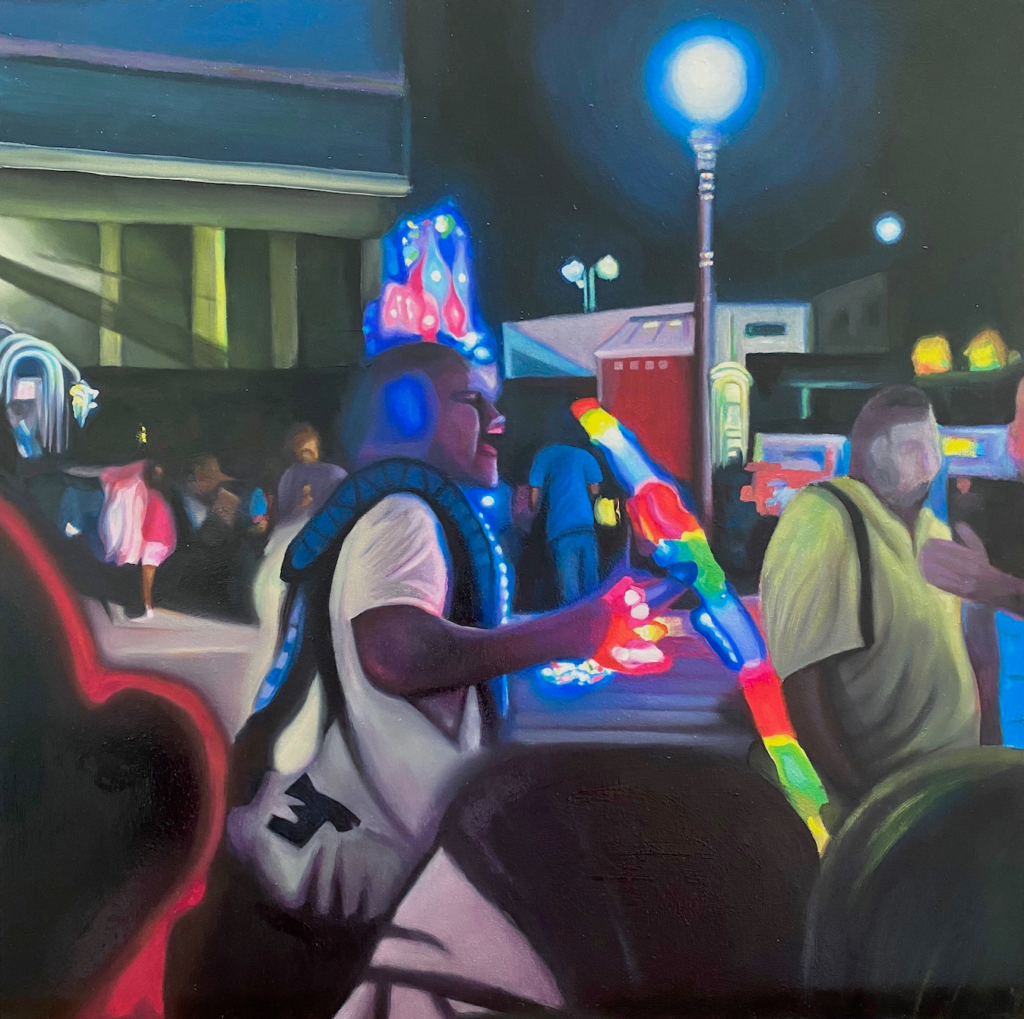
NB: How do you incorporate your own personal lived experience into your practice?
MT: I am very interested in the human psyche and the subjects of community and faith/spirituality. When observing people in strikingly different environments and social groups, I try to track the consistent underpinnings of how a person develops within their community. No matter how different the circumstances, our innate drive leads us to seek purpose and passion within a community. It is also through faith and spirituality in these communities that a person may find their own feeling of fulfillment.
The particular images that I choose as reference for my works are extracted from my experiences living in very different communities. They’re not really determined by a conscious decision but rather by ontological circumstances that lead me to an intuitive choice.
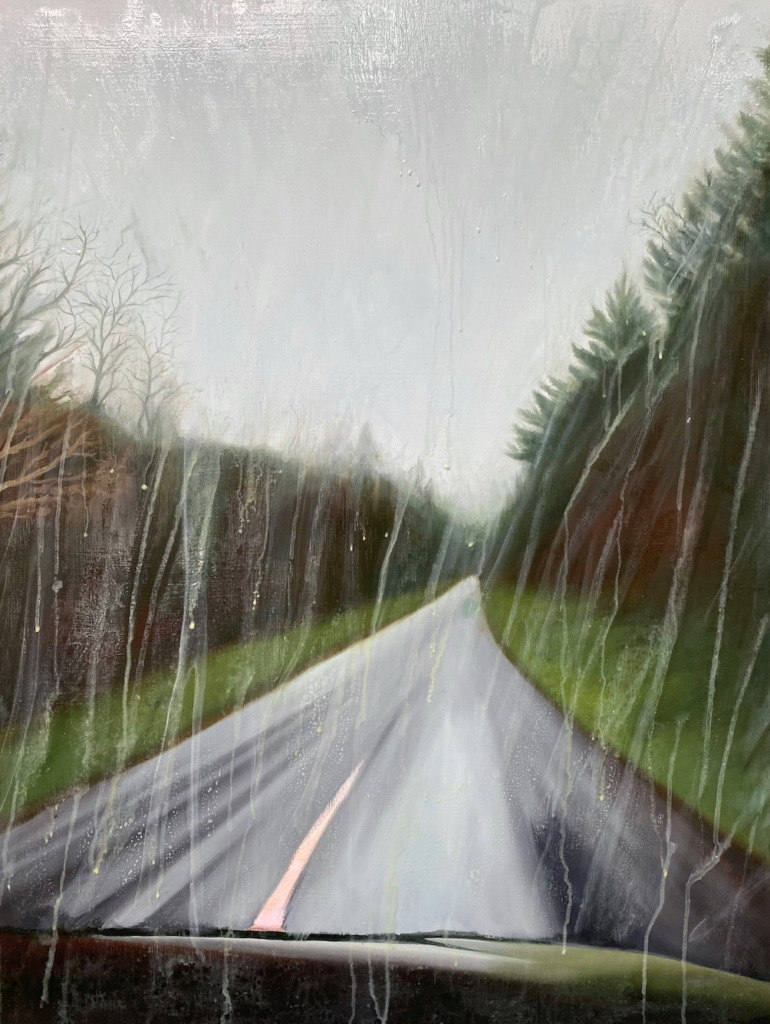
NB: What are your thoughts on art and pop culture, and how the two areas both intersect and diverge?
MT: The two forever seem to be enmeshed through a self-perpetuating cycle of one reinforcing the other’s production- regardless of conscious intent. Even if there’s no obvious reference to or extraction from pop culture in an artist’s work, pop culture influences the environment an artist exists within and inevitably provides context for the audience’s interpretation of the work. Over time it’s also been interesting for me to observe how semiocapitalism and object fetishization has shown up in art.
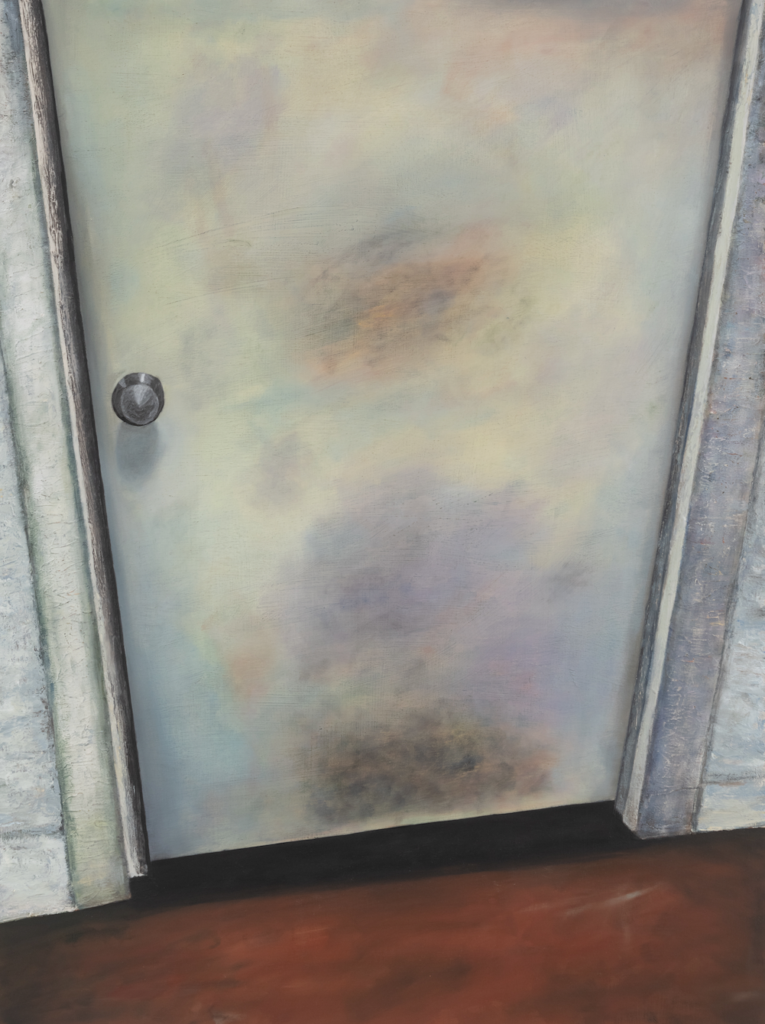
NB: Can you tell us about any upcoming works or projects?
MT: I’m working on a couple. I am painting a series of doors and interiors inspired by the ones I saw at an all-boys Yeshiva boarding school I visited in Yonkers, New York. There was a sacred energy present within the walls that’s generated by the boy’s dedicated practice to prayer and studying The Torah. You could feel a divine presence, which made me hyper-aware of ethereal lights and the smudges and markings on the walls indicating the presence of physical bodies passing through them. I wanted to see if I could make art that could evoke a similar experience.
I’m also working on some paintings that are inspired by photographs I took of crowds at a big street parade in Corpus Christi, Texas when I lived there for a couple of years as a teen. I’m spending a lot of time in the studio making work for my upcoming solo exhibition in January 2023 at Nina Johnson Gallery in Miami Florida.
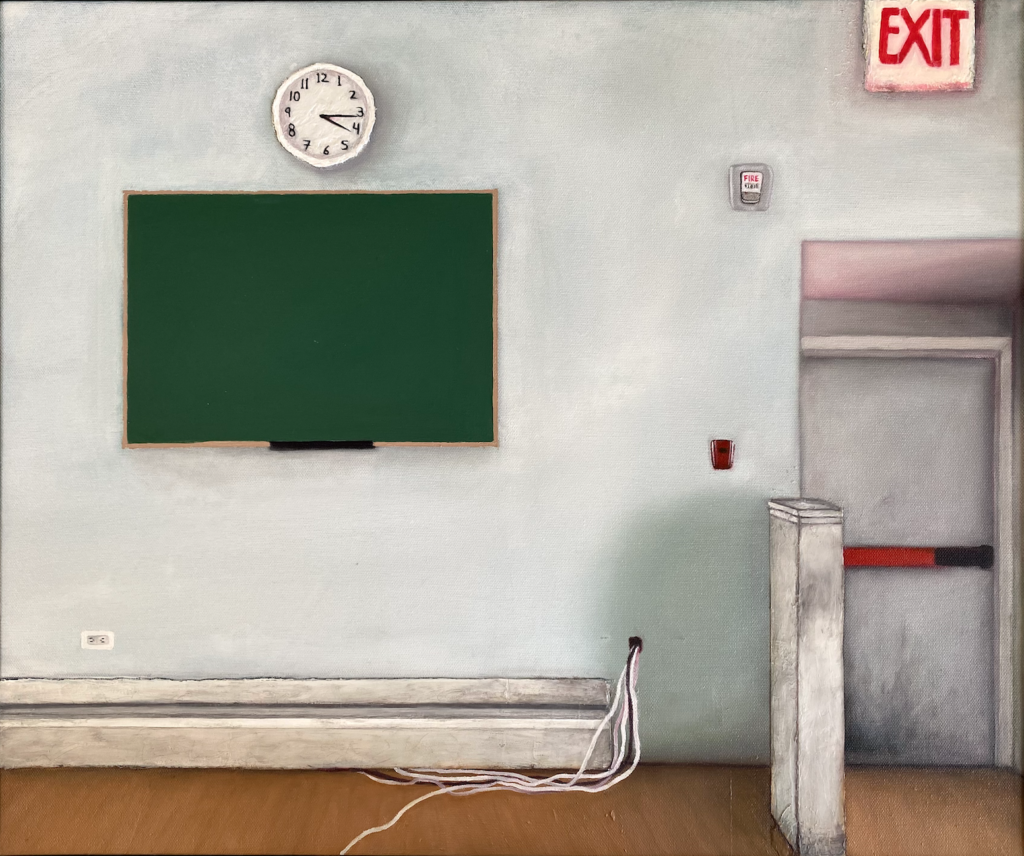
June 2, 2022
Artist to Watch
LITA ALBUQUERQUE
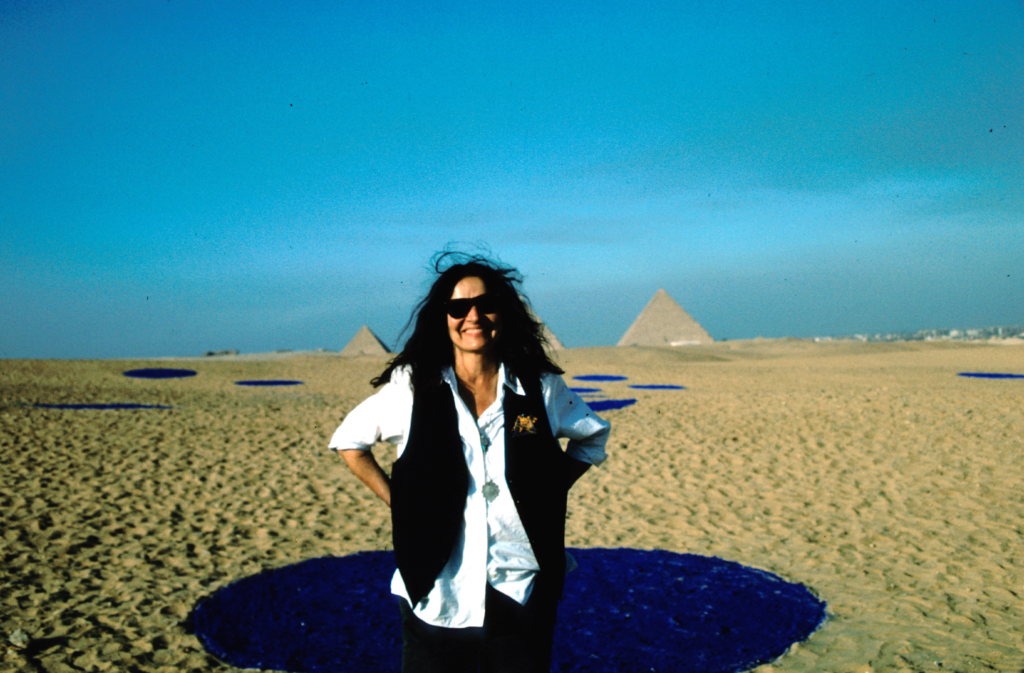
NB: What are some of your earliest memories of art?
LA: The very first one is a very odd one! We lived in a stone house in a fishing village in North Africa called Le Goulette. It was the house that my grandmother (who I never met) owned and had then passed on to my mother. In the kitchen closet was a sculpture that was literally thrown in there. I couldn’t believe that was a place where art went! We had a lot of literary things; we had a lot of music, but the visual arts came to me later on. That was my very first art piece. However, in the convent [where I studied] later, there were a lot of Renaissance paintings referencing biblical scenes. There was also a lot of Islamic art, pieces like mosaics. Tunisia has a lot of artifacts – not fine art per se, but beautiful blues and golds and reds. A lot of my work comes out of that. In terms of art I saw later on, I’m a romantic, so William Turner was my first love.
NB: How do you believe art informs spirituality, and vice versa?
LA: I think one of the things about art – really good art – is that there are no words for it. When you’re in front of a wonderful work of art, it’s an embodiment. How the work has gotten there is the product of the intricacies, life, and very lifeblood of the artist. It’s also their thoughts [as an artist] and the greater force of art history. It’s like good wine, it takes so long to be this work of art for which there are no words. There are no words because everything is already in there. How does that relate to spirituality? Some people don’t see this [all in a] work of art; to be able to see it, you have to be open. The very word ‘spirit’ means breath. For me, the spiritual is about being open, it’s about being in the moment. It relates to the cosmic address and having a perspective that takes one out of just being ‘here’ and puts one in the context of the reality of the whole. The spiritual is really the process of opening up to oneself, and to the cosmos. And that’s very different from religion.
NB: Is there a specific place, location or environment that has been particularly inspiring to you as a creator?
LA: I run on the beach and jump in the ocean everyday. I have to have that. Also – sunsets and sunrises, that kind of connection of beginnings. That concept of time, and the rotation of the earth around the sun, is totally inspiring. The desert – whether it’s dry lake beds or Antarctica which is also a desert as well – it’s such a minimal space that you instantly have to listen. There are certain spaces that bring our poetry in you, and you have no idea how or why. Tunisia is like that. People who come from Tunisia, if they’ve left, always talk about that. There was also the artist’s colony [in Malibu] where I grew up as an artist, that place had the same sense and feeling. It wasn’t anywhere else. It’s very interesting, in that way. It all comes down to nature.
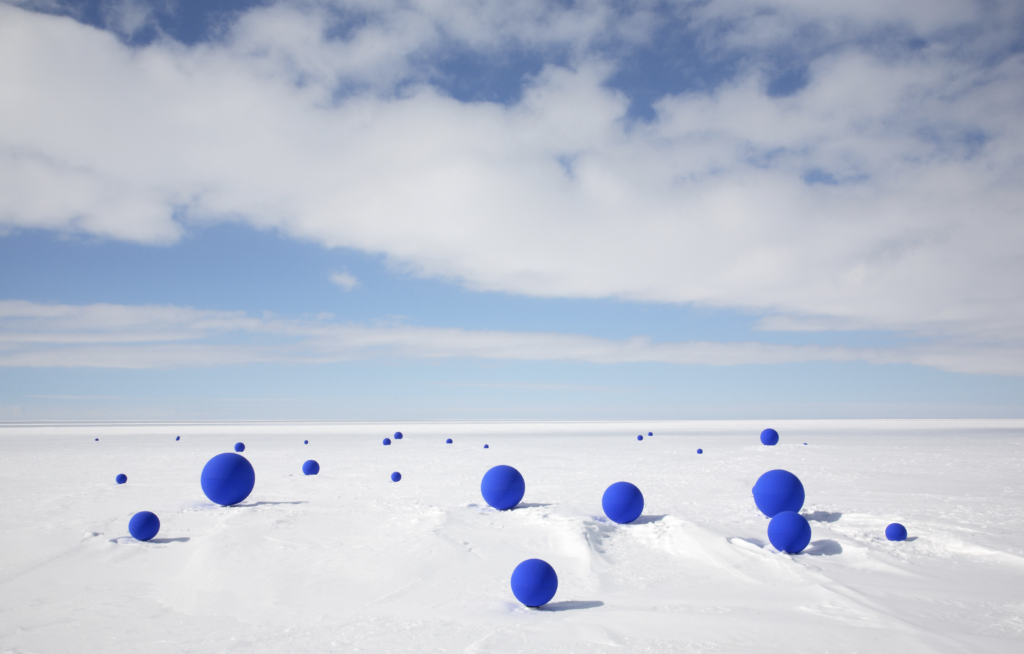
NB: You’ve created many incredible site-specific installations in very dramatic climates. Could you speak further to your projects at the Great Pyramids for the Cairo Biennale, and the work Stellar Axis in Antarctica?
LA: For a long time I have been thinking about connecting the planet to the stellar system it is surrounded by. What I mean by that is that my interest is to show that planet Earth is not an isolated planetary body, that it is in a vast system of moving stars, within a moving galaxy etc. By placing circles of blue pigment on the desert floor in alignment to the stars above or sculptural blue spheres on the ice in Antarctica, is a way of presencing that moment in time which makes us think of our connection, that everything is interconnected. Both projects stem from the same idea of connection, but the first one in Cairo, was going off of the Stellar Correlation theory devised by Robert Beauval, that the pyramids at Giza had been placed in alignment to the Orion Constellation. I went off of that premise. In Antarctica, it was slightly different, by then I had had the vision of seeing Planet Earth from space, dotted with gold tipped pyramids, all aligned to the stars. This created an even greater urgency in me. To re-create that map (for it is almost certain that it had been made in ancient times), and that I would start at the north and south poles. Antarctica has many restrictions and I could not bring in any particles that might pollute the atmosphere (pigment) so I came up with creating blue spheres of different diameters to correspond to the different brightness of the stars above, and positioned them in alignment to the 99 brightest stars in the southern hemisphere. The difference in the two projects is that I also did a performance showing the motion of the stars at the poles in which they move in concentric spiraling circles around the pole, and not from East to West as in the northern Hemisphere. The Stellar Axis project spoke to a much larger vision because I created that performance at both the north and south poles; it was taking on the whole globe.
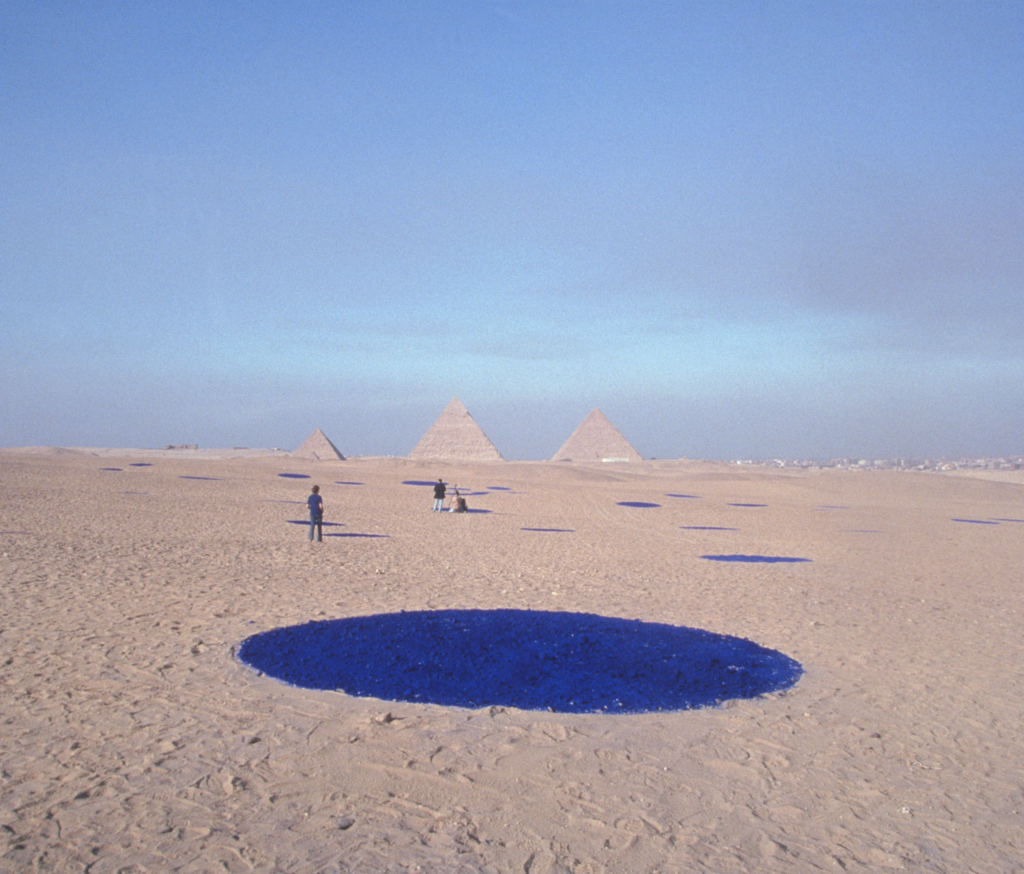
NB: Can you tell us about the projects that you have coming up?
LA: The big project that I have coming up is at the Venice Biennale, Collateral. It’s a film installation with a film that I shot in Bolivia called Liquid Light, which is the second part of a trilogy featuring the character that I’ve been creating – a 25th century female astronaut who comes to the planet to teach us about all of these ideas of light and relationships to the stars. We’re presenting the film as a three-part projection and there will be salt and honey spheres in the installation, along with gold spheres. There’s also sound.
NB: Is there anything else coming up?
LA: I’m having a solo show at the Kohn Gallery coming up soon. I’m also working on some performances, films and a book.
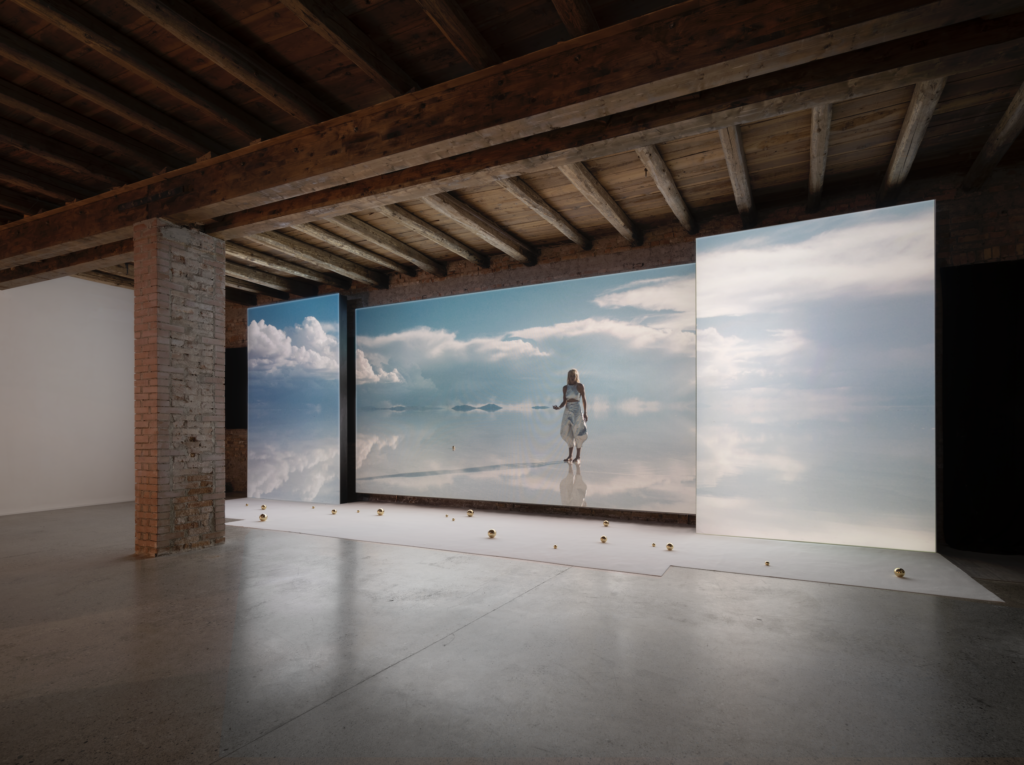
April 7, 2022
Artist to Watch
Reuven Israel
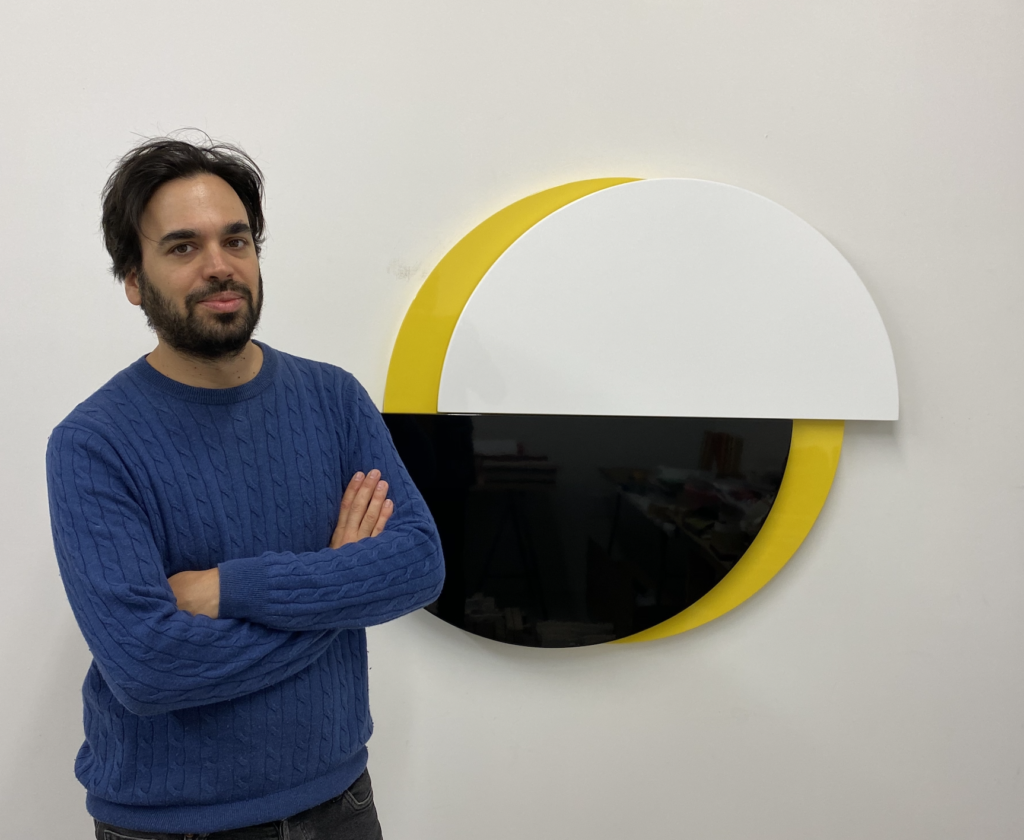
NB: What are your earliest memories of art?
RI: I grew up in a religious household, Jewish Orthodox, not Ultra-Orthodox, but modern Orthodox. My mother was on the religious side of the family, and my father was more secular. In this religious background, there wasn’t much visual stimulation. Art in our local Synagogue was limited to attributes to the twelve tribes of Israel and the lions of Judah ornaments on the coverings of the Torah scrolls. On the other hand, I used to accompany my father–who was a Journalist and writer–on his research trips for a guide he was writing on the monasteries in Israel. I would sit in chapels and churches, waiting for him to finish interviewing a monk in the back room. These spaces were in contrast to my Jewish upbringing, full of forbidden artifacts, statues, depictions of Mary, Jesus and saints. Everything was radiating a forbidden sense wrapped in the smell of incense and damp corners, hundreds of years old.
In regard to Western Art, I think the first painting that I was aware of was Hieronymus Bosch’s Garden of Earthly Delights. We had a reproduction of it hanging in our dining room, and as kids, we spent hours finding all these little sexual perversions – all these little anecdotes. When having friends from school over, I was embarrassed by this hanging in our house, but enjoyed seeing their shock.
Growing up, around the age of 17 I started teaching myself oil painting. I was inspired by looking at art books and some museum guides my father had brought back from Europe and America. It was before the internet became what it is now, so to look up paintings, I had to go to bookshops. I used to buy all these handbooks, these Taschen volumes about artists. I was obsessed! I would stare at them endlessly and read everything. Many of my thoughts emerged from art history and looking at these books and artworks reproductions. Then, one day, I realized there was a museum not too far from me, the Israel Museum in Jerusalem. It dawned on me that I could go and see some of these paintings in their original form. My memories from childhood of the museum were of the archaeological parts – like seeing the Dead Sea Scrolls. I hadn’t realized that they had a European painting collection – and they have quite an impressive one! It was amazing, and I went many, many times. Those were my first memories. Later on, in my early twenties, I traveled to Europe to see Caravaggio in Rome and Vermeer in Amsterdam.
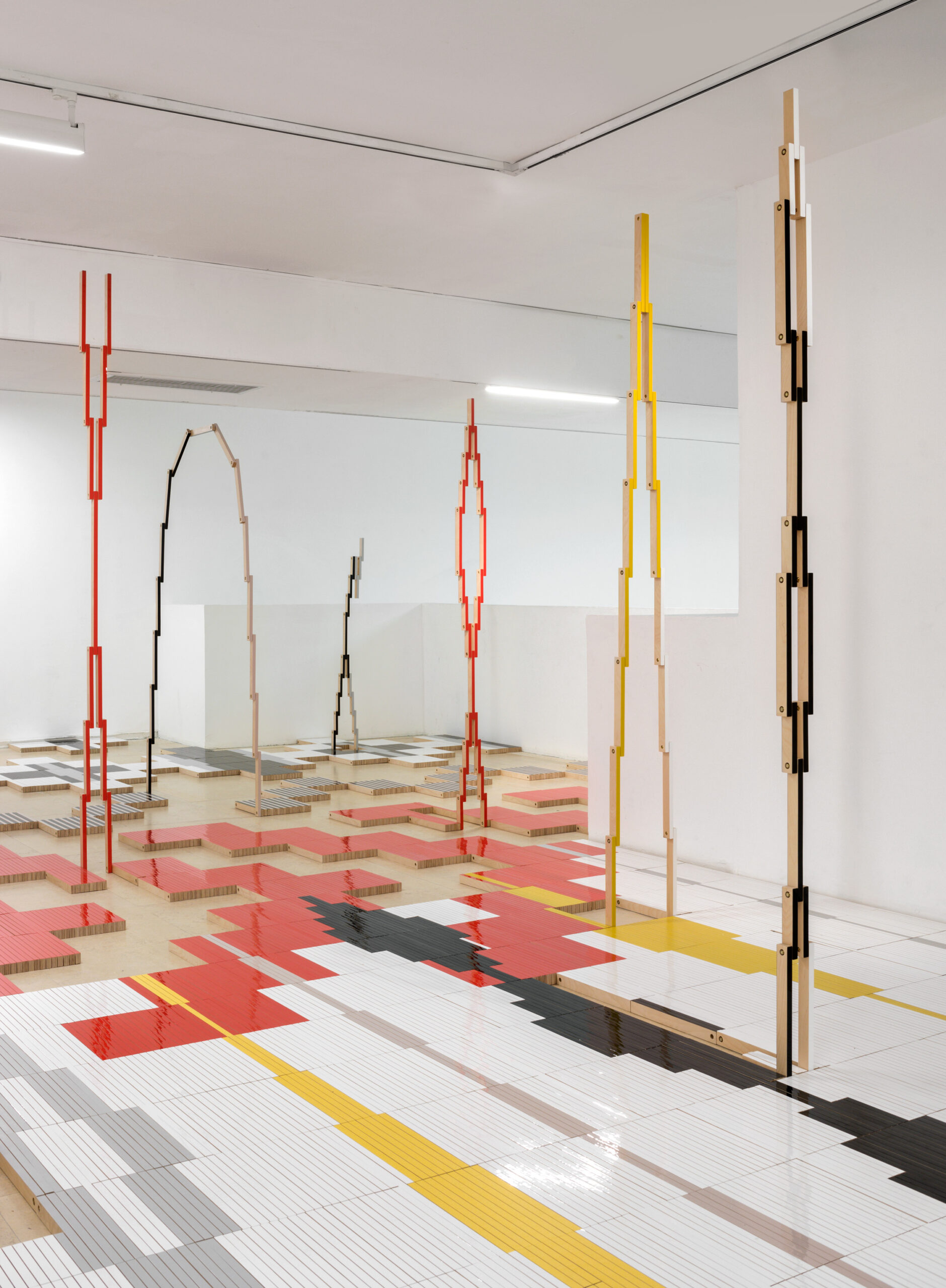
NB: Could you speak to your source of inspiration for your practice? I’ve read that concepts such as religious monuments and science fiction have had an impact on your work.
RI: I can draw a thread from my practice now, back to when I started my interest in sculpture more than 15 years ago. There is this very gradual evolution in my work, both of the forms and the conceptual framework. Like scaffoldings, each new body of work is built upon the previous one. Religion has been an ongoing inspiration, rooted in the fetish quality of the works. I used to work a lot with MDF and manipulate it to look like different materials, such as plastic and metal. This fetish treatment of endlessly sanding and caressing the forms avoked this feeling of sanctity in the final objects. It took me back to my personal story, sitting in churches and staring at religious architecture and artifacts. I incorporated into my work particular geometries relating to specific places in Jerusalem. I was trying to decode the feeling of sanctity that certain objects and places have and use it as a means inside the pieces I create. Planting this religious “DNA,” provoking an aura of sanctity in pieces that look like they relate to mass production and furniture, that seems to almost have a functional purpose, but then again, you’re not quite sure what.
In addition to looking more and more into religion, science fiction started to evolve as another source of inspiration. My sculptures often felt like they had landed on the gallery floor from outer space, which led me to do watercolor studies of the shapes I was working on, drawn on large blackened sheets of paper. I draw sculptural elements as if hovering without gravity on the black surface of the paper, peculiar alien forms floating in space. Some of these studies became actual sculptures, and most didn’t. I then started looking further into sci-fi to make the pieces reflect this alien feeling even more. I went on a ‘sci-fi diet’ for a few years, where I mostly read sci-fi books and watched sci-fi movies and TV series – I was trying to break down that language. I wanted to see how this visual diet would come out in my work. Looking into sci-fi somehow took me back again to religion and archaeology. The original elements that drew me to sci-fi (or made my objects look a bit sci-fi) were such because I was looking at the same things for inspiration as people interested in sci-fi were. There is this paradox in sci-fi wherein trying to imagine the future and far away alien civilizations. Instead of looking forward, one looks back to history, to periods like the Middle Ages or ancient Egypt.
In the folding objects series that I’m working on now, a very specific geometry is created when the pieces open and close. This geometric language reminded me of weaving, specifically native American indigenous weavings. I started looking into Navajo rugs and then into designs on Hopi ceramics, trying to understand why this language that I’m working on suddenly has this association with these cultures. No doubt that this exploration influenced the shapes I created. From this exploration, I understood the connection between the mythological framework behind the indigenous patterns to my personal experiences, participating in shamanic ceremonies, relating to what I believe to be linked to this visual language.
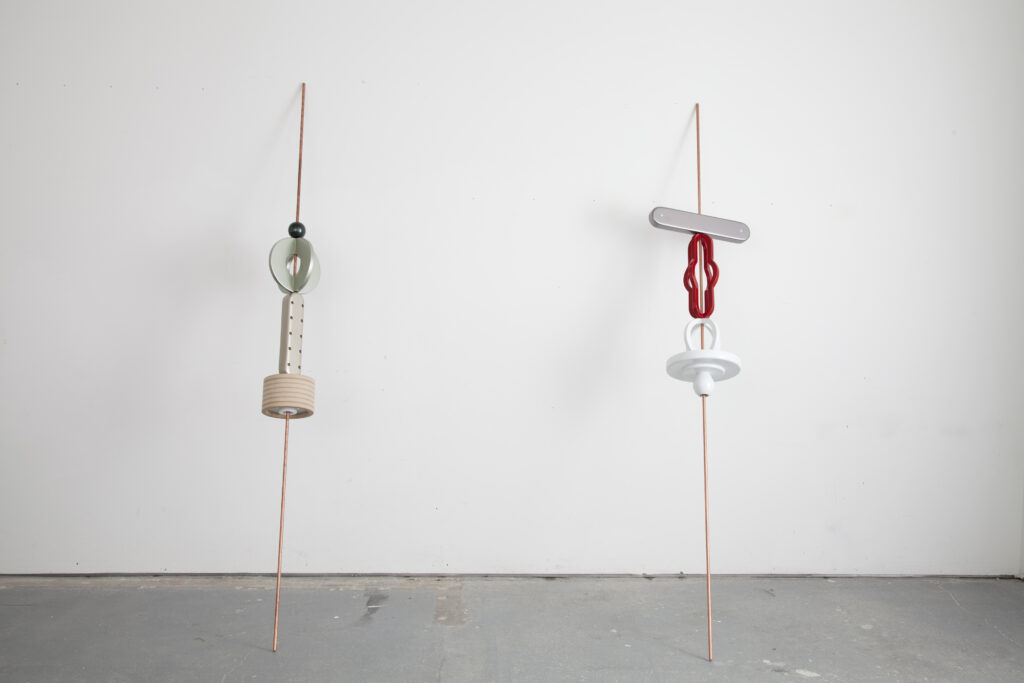
NB: I know you use a wide range of materials in your pieces. How do you think about these different substances in the creation of your work? What do the interactions between the materials mean to you in your practice?
RI: When I started experimenting with sculpture, I wanted to imitate plastic. I didn’t want to work with plastic, and I didn’t want to cast plastic. I wanted to work with a material pretending it is plastic. This led me to MDF. By sanding it in a certain way, rounding the edges, and coating it with paint, it could take on the appearance of different materials. I like the basic idea in art that a thing is not what it represents, taking something and making it look like something else. I was interested in representation, but without representing a figurative depiction. I didn’t see a reason for sculptures to represent something else because they are already objects in the world. Why should one object represent another object?! Why couldn’t it just be itself ?! At the same time, I didn’t want my work to lose a relationship to concrete things in the world entirely. One of the core relationships I maintain is representing material almost as an image. Plastic and all of these sleek surfaces that surround us come with their luggage; they have a subtext. Plastic is taking over the world! This artificial material has a seed of destruction.
When you look at a lot of my pieces, the material itself is a piece of the puzzle, and it’s not what you think it is. There is a distance between what the sculpture is talking about and how it looks. It’s deceiving your senses and your thoughts. I still work with MDF but less and less. I also started using materials that spoke the same language. I found these metal rods used for grounding electricity. They are made of steel coated with a thin layer of copper, relating to my logic of painting things to hide them. I bought a bunch of these rods, and I started skewering sculptural elements on them. Individual wooden elements come together as a sculpture, a visual poem.
When I started the folding pieces, I initially continued with similar logic and painted their edges in color spectrums, reaching from green to red through small gradual color changes. A couple of years ago, I started work on a site-specific installation for the CCA in Tel Aviv that required 5,000 segments of wood. To paint 5,000 segments of wood is ridiculous! I also wanted people to walk on the piece without scratching or damaging it. I found an edge banding technique to apply a very thin layer of colored PVC on the wood. Nowadays, I use this technic to create large-scale immersive installations.
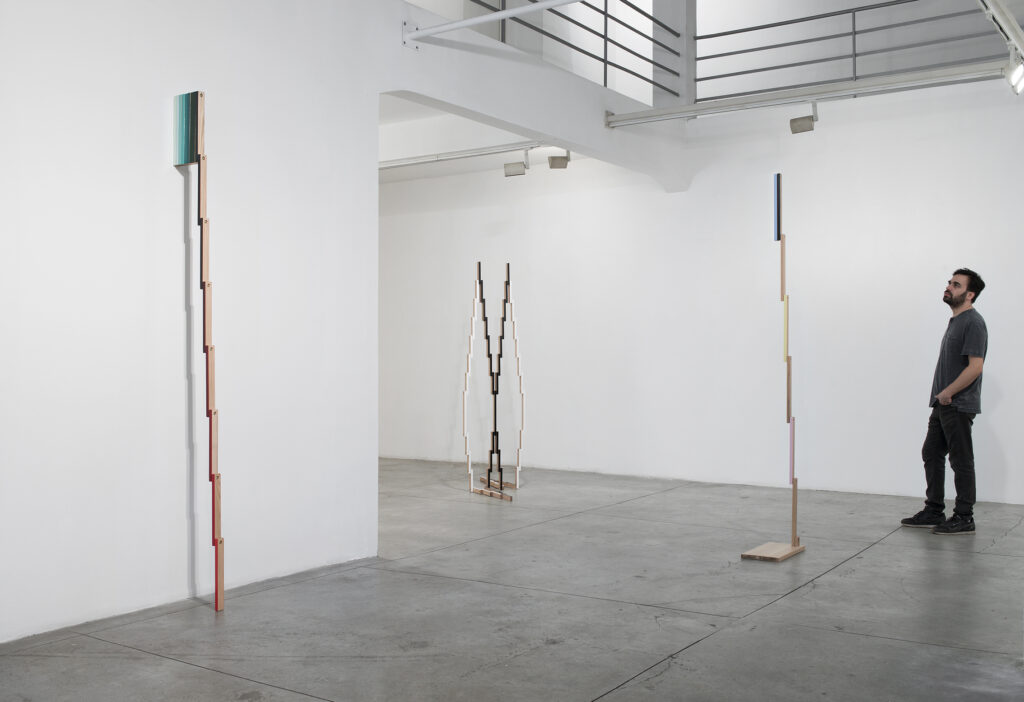
NB: Do you have any upcoming exhibitions or projects that you’d like to share?
RI: I just had two solo shows recently. One was at Shulamit Nazarian Gallery in Los Angeles, and the other was at the Center of Contemporary Art in Tel Aviv, which I just mentioned.
When I was invited to propose a piece for the Center of Contemporary Art, I had just finished working on folding sculptures that could unfold into different shapes and forms and shift in scale from flat rectangular shapes into large geometric patterns in the space. I decided to tile an entire gallery with thousands of wood segments connected to each other. From the interconnected tiled floor, I pulled groups of segments that opened up into three-dimensional structures, leaving empty swathes of the bare floor beneath them: an intricate game between two and three-dimensional patterns, resembling a digital space coming to life. To enter, one had to walk on the art. This took me back to religious ideas – like, taking off your shoes before entering a mosque or temple.
At the same time, I had another show in Los Angeles, with wall pieces that could also shift. Sleek geometric surfaces moved on tracks, opening from closed shapes into larger geometric landscapes. There were other folding pieces too, hung like rugs on the wall, unfolding down and spilling to the floor, with parts of them rising back up into sculpture in space. I liked the idea of having a floor show on one continent and a wall show on another.
I have two upcoming projects in Istanbul. A solo show in May at Sevil Dolmaci Gallery. The other will be in September, at a non-profit space. It’s a project I’ve been working on for a while, with Panos Tsagaris-A New York-based Greek artist, and Christian Oxenius, an Istanbul-based, German-Italian curator. The project is growing, and a Turkish curator and another Turkish artist are joining. It will be a satellite event during the Istanbul Biennale.
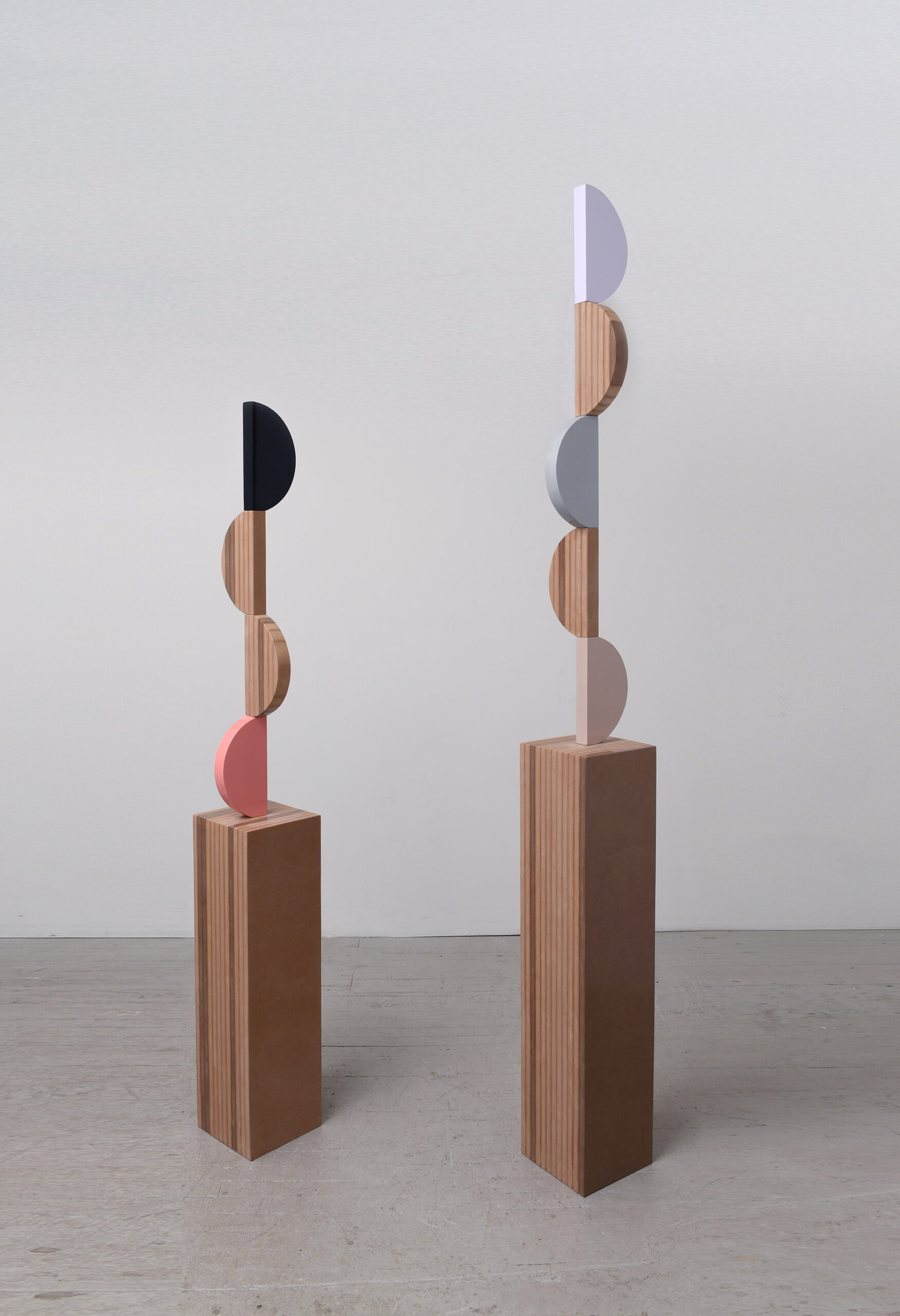
March 9, 2022
Artist to Watch
DAZE
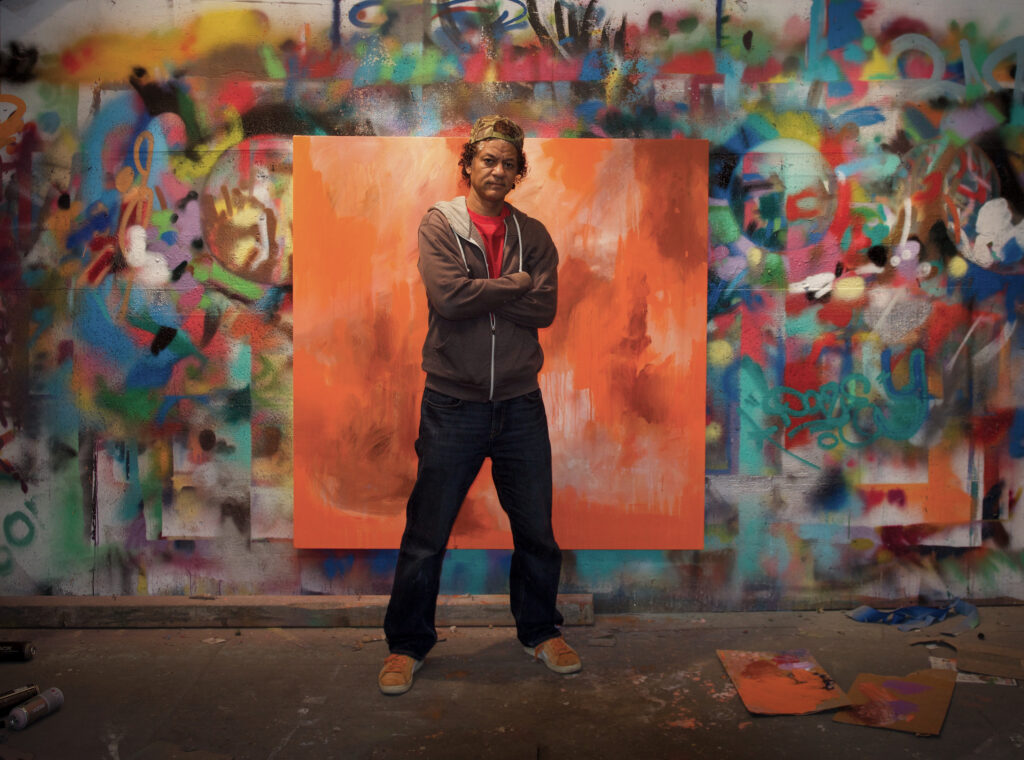
NB: Can you share the origin of your name, Daze?
Daze: The origin story is funny and typical. It’s very important to choose a name that will define you as you continue on; a name that no one else has at the same time. The originality is a big factor. I went through a lot of different possibilities. I started thinking more along the lines of which letters I could draw best, and which letters had a certain flow. That’s pretty much how I came up with it. It’s not just choosing a name, but that name and the letters in that name have to have a certain compatibility. That’s how it came about.
NB: Around what year was that?
Daze: This was in 1976.
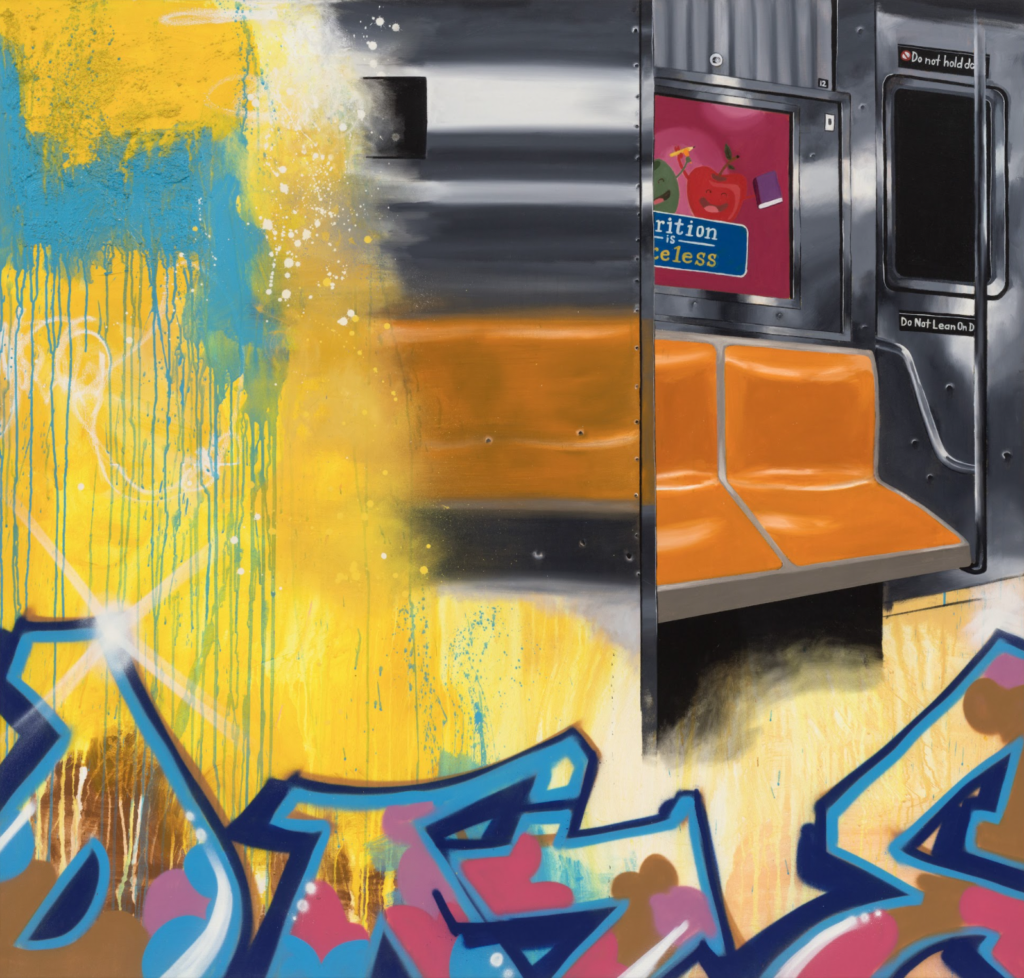
NB: When I saw your recent show Give It All You Got at PPOW, it felt like such a love letter to New York and the streets. It was beautiful. Which part of New York City are you from, and which part of the city – either physical or philosophical – inspires you most?
Daze: I’m originally from Crown Heights, Brooklyn, although I have maintained a studio practice in the South Bronx for more than 30 years. I’m definitely immersed in the culture and what’s going on in the Bronx. In terms of my favorite part of the city, I have a love/hate relationship – like a lot of people – with New York. I draw inspiration from all five boroughs. I try to focus on things that are really distinct about each borough. For example, I did a series of paintings and photographs of Times Square. It was from a touristic point of view and not from the point of view of the old school Times Square – the one that I knew while coming up in the city; it’s a bit more contemporary. In the Bronx, I’ve done paintings of everyday life and everyday street scenes that I encounter in my commute to and from the studio. In Brooklyn, I’ve done a huge series about Coney Island, which is very distinct. Also, I did a whole series of paintings about Staten Island, and it’s ferry, because that’s something that I enjoyed doing as a child – taking the ferry ride on a hot summer day. As a child going to Staten Island seemed somehow exotic. Watching the ferry pull away from the terminal in lower Manhattan I felt that anything was possible here. I draw from all of those experiences, and try to focus on things that can only be found in New York.
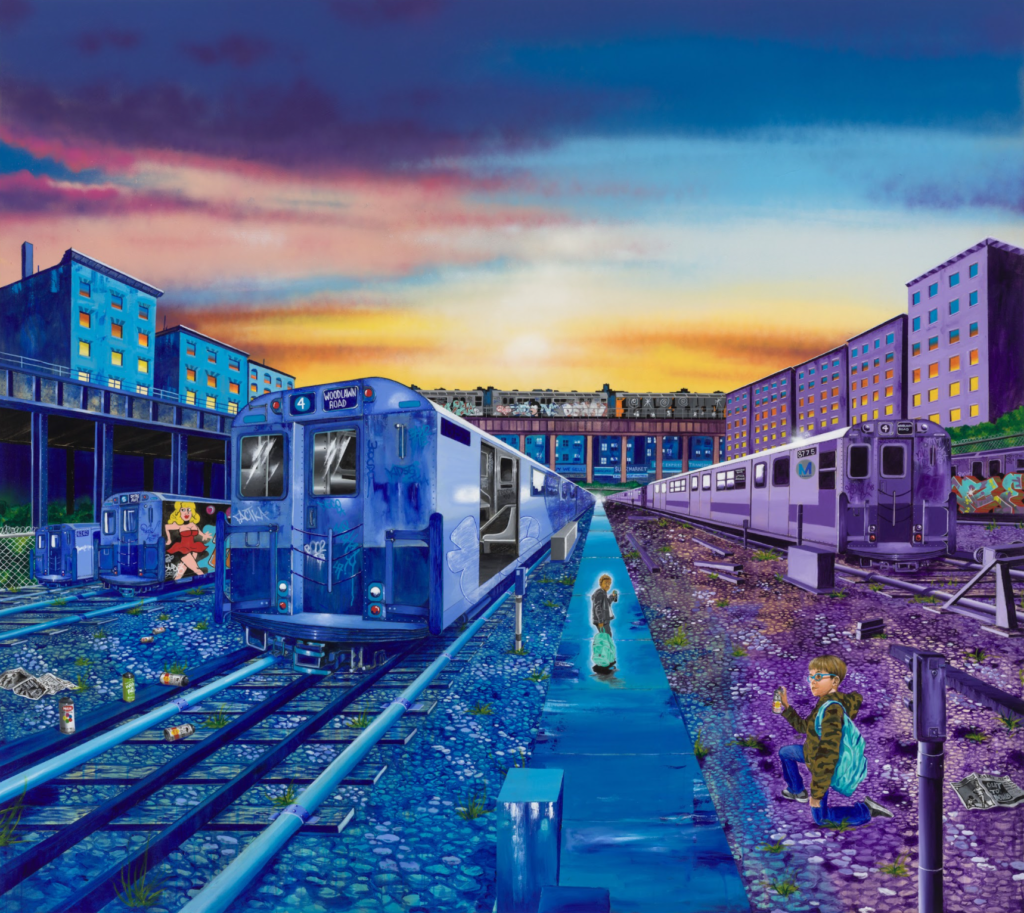
NB: Tell us about the transition process from creating your work as graffiti interventions in the city environment, to presenting your pieces in the fine art gallery space — from the streets to the studio? How did you navigate that, and how did it feel as a creator to make that change?
Daze: For me, the transition from doing my work in the subways or streets to the studio was very natural. I was always drawing and creating on paper as a kid, whether it was just illustrations or comics. The return to that practice was, for me, a very natural part of my evolution as an artist. There are two different mindsets when you’re painting in the street, and when you’re painting in the studio. When you’re in the street, you’re working in this very physical environment, and you’re interacting with everyday people. There is also a sense of immediacy, the sense of ‘I’m not going to paint something and come back to it tomorrow.’ I generally like to create my mural works in a couple of days at the most, if not one day. In the studio, you have the luxury of being able to spend more time on a specific work. However, it’s much more of a considered process. I’m thinking about what I’m doing and I’m creating work gradually. Some works could take a couple of days, and some works could take six months, depending on the painting. That’s really the luxury that having a studio provides you. You’re able to stand back and live with your own work for a while.
NB: The wonderful exhibition of your work, Give It All You Got, recently closed at PPOW. Can you share with us the background of the show?
Daze: A large part of the work was created during the quarantine that New York endured in the early stages of the pandemic. A lot of the work examines my reaction to it. However, I see the show as a bridge between many different things. It’s a bridge between old New York and contemporary New York; it’s a bridge between my two sons and myself, because they appear in several of the works; it’s a bridge between a culture that is very much underground and the more mainstream populous, and presenting [the underground culture] to the [mainstream populous]. It’s about creating these bridges that people can cross to see what’s happening. A lot of work went into it, hence the title. When I came up with the title (it came from a song) I thought ‘wow, this really sums up how I feel right now.’ I didn’t want to hold back, I wanted to put everything into the show. Especially at a time like now, in New York and in the way that people are feeling. People are longing for some sort of return to the way things were (before two years ago), but also perhaps for something new – at the same time.
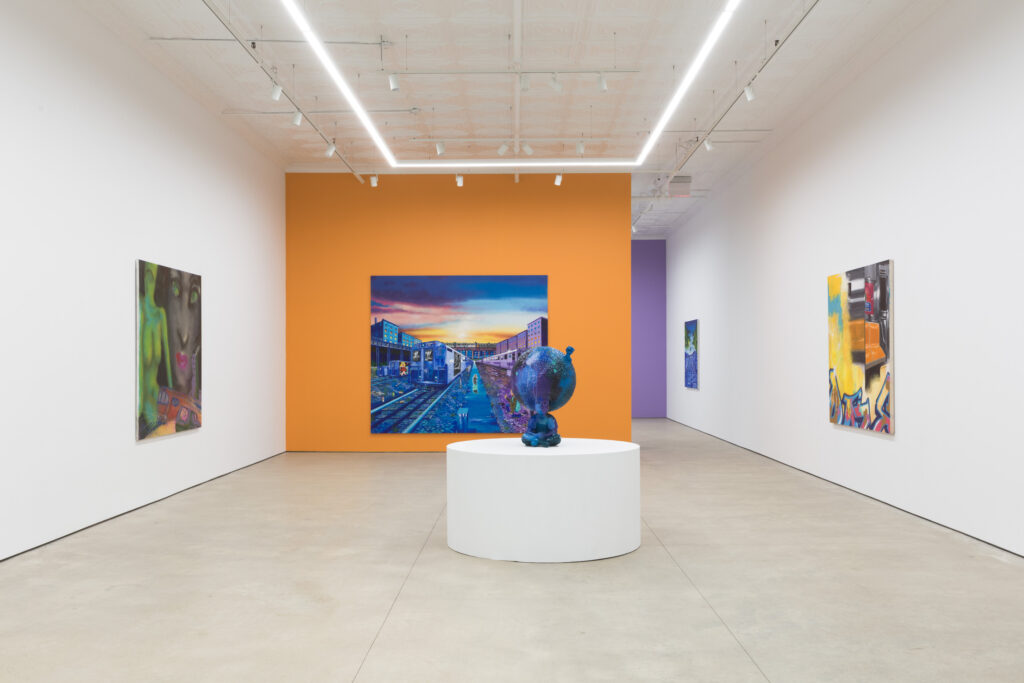
NB: Are there any upcoming projects or exhibitions you can share?
Daze: I am going to continue to work in the studio. I also do a lot of work with students that had been on hold for the last two years, because of not being able to work together in person. I am going to make a return to those mural projects with students, as I think we’re in a climate now where that can happen. In terms of exhibitions, I have a lot of exhibitions coming up in Asia. The first one is at the K11 Art Space in Hong Kong, called City as Studio, it’s a large exhibition that will be curated by Jeffrey Deitch. After that, Beyond The Streets, curated by Roger Gasman, is traveling to Shanghai. Finally, there is an exhibition called Somewhere Downtown which will take place in Beijing at the UCCA, curated by Carl McCormick.
NB: One last thing – my own personal question – do you have any good stories from the Mudd Club?
Daze: The Mudd Club was really interesting; I was so young. Here’s a story: the fourth floor of that space was run by Keith Haring. The owner of the Mudd Club had sort of just said ‘I have this space, you can do what you want.’ He would let Futura or Fab Five Freddy come and curate. There was a real seminal exhibition called Beyond Words. A lot of now-famous people were in it, who weren’t really famous at the time. I remember Keith had this piece of wood that he wanted to put in the show, and on the wood he had these crawling babies sort of following dogs. Keith said, ‘this is my stuff; this is what I do’ and I remember saying to him ‘oh, cool!’ – but thinking to myself, ‘wow, he doesn’t really have a future, if this is what he does.’ But very quickly, I was proven wrong, because of course he created a whole vocabulary from those two simple figures.
NB: We read in the history books about the Mudd Club – not that many people are still around who got to go there!
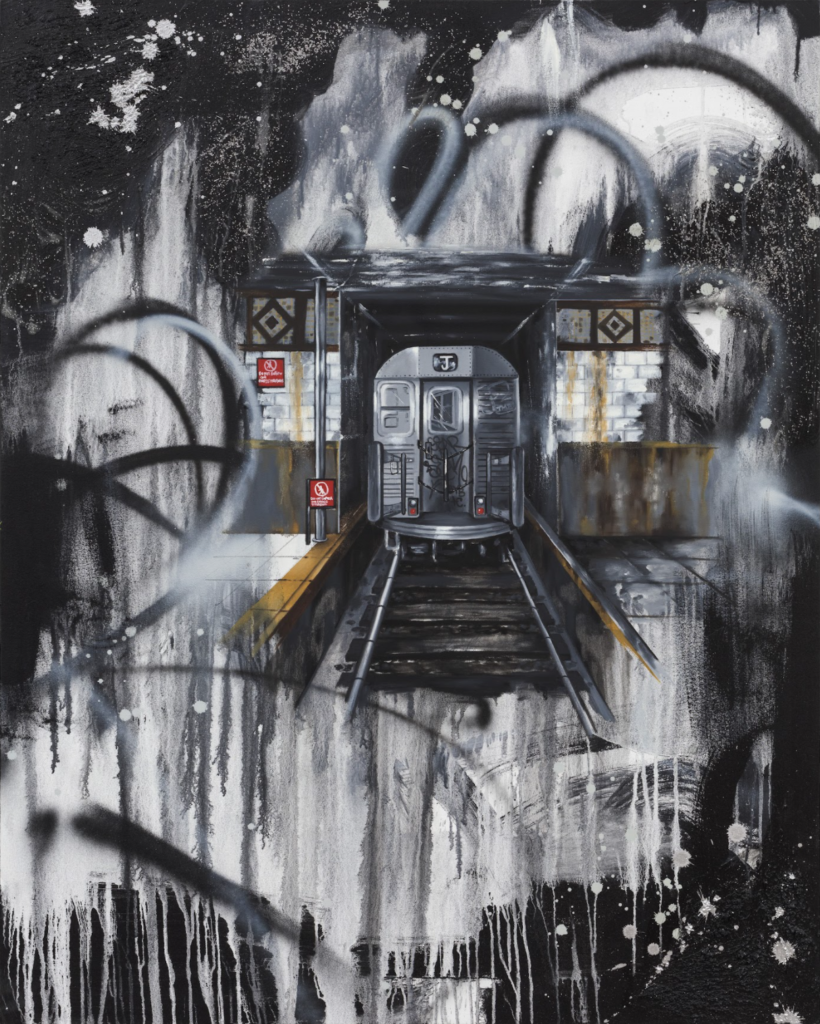
January 25, 2022
Artist to Watch
ANNE VIEUX
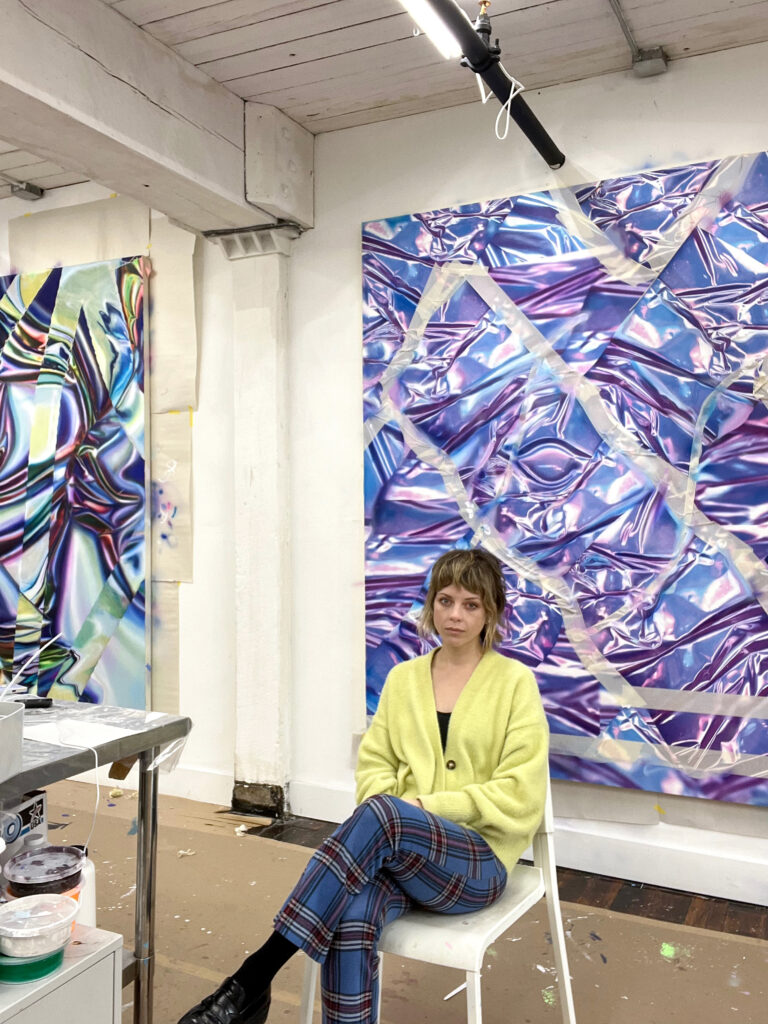
NB: What was the genesis of your practice incorporating both digital and analog concepts? Could you speak to how you view the boundaries and tensions between these two areas?
AV: The boundaries between these spaces are constantly being negotiated and redefined. Every material including pixels and paint have physical and visual limitations. I enjoy combining them in my work and find a sense of play in that process.
The distortion of data and capturing light have been important to me since I started working as an artist. My parents started a weather modeling company out of our home when I was a kid, so I grew up around meteorology images and computers. I have always found the effect of mediation by technology on reality fascinating.
When I moved to New York the limited amount of space I had to work in provoked me to start experimenting with my scanner more and digitally manipulating the images I created. I always thought of these distorted images as painterly, so it felt natural as they started coming into my paintings. Working back and forth from software to physical paint, there is a dissonance in that process (as well as experience in daily life) that comes into some kind of order when I work through my pieces.
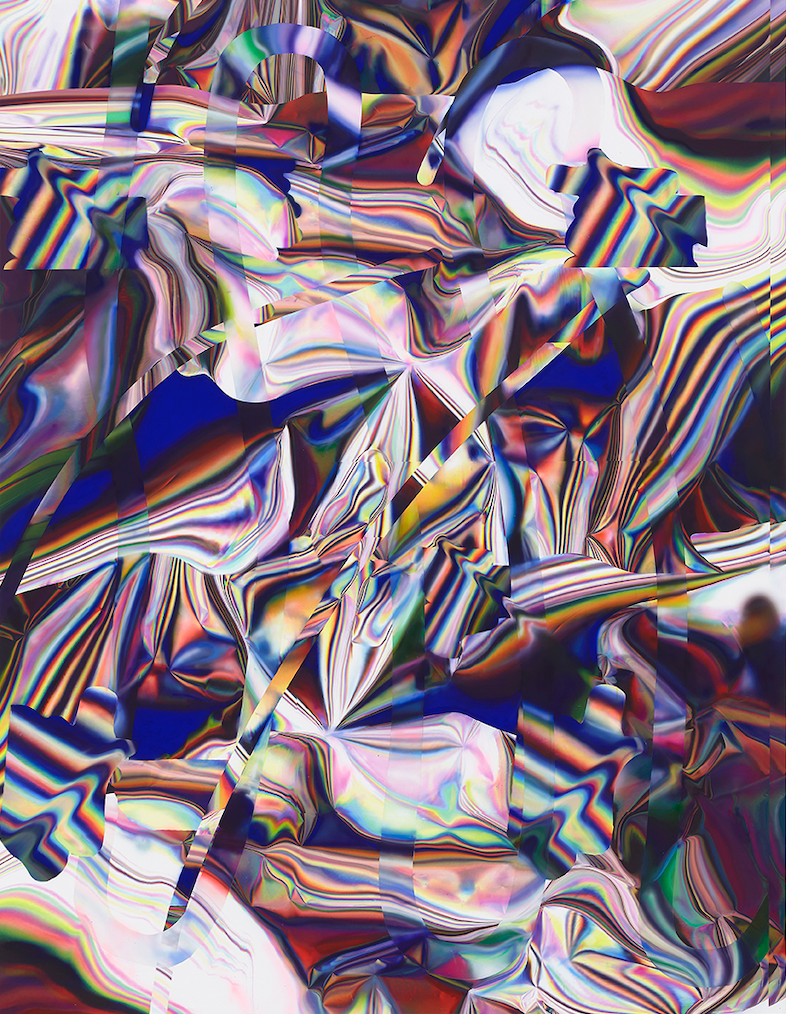
NB: How do you look to past ideas and concepts from art history in creating your pieces? Are there other artists you look to in your practice?
AV: I feel connected to so many artists and periods of history for different reasons. The history of painting is rich with subjects around the sublime and importance of light. I think of part of my practice as in search for a technological sublime. There is also a history of artists experimenting with technologies and using unlikely tools to discover their own kind of idiosyncratic language.
I look at Color Field painting and think of the gestural application and surface concerns when thinking about abstraction. I think of light, color and pixels as fluid mediums. I use color and form that can be associated with cosmetic or narcotic, that are contained by strong abstract compositions and gestures. The idea of combining “high and low” cultural influences that seem to me as very American art history influence.
I look to the: experiential approach to painting of Katharina Grosse or Helen Frankenthaler. The material exploration and abstraction of Judy Chicago or Larry Bell, and Albert Oehlen and Sigmar Polke, to the sense of play and freedom in the compositions.
NB: Can you tell us more about your experiments with materials, and how the materials used translate into your different media (i.e. painting and NFTs)?
AV: Pushing the limits of the image data, my source material is created by scanning holographic paper. I make images that are processed into a highly personal language of painting from this source material that expands into other media. Scanning holographic paper—transforming light into image—results in a chaotic prismatic dispersion that is the starting point of my analogue/digital hybrid painting process. I am fascinated by taking this kind of chintzy material from my childhood, transforming it and giving this kind of randomized data a materiality. In my paintings, installations, and videos layered gestures and distortions shift upon colorfields in infinite loops at an experiential scale.
Minting my videos as NFTs was an exciting way to access a new audience and archival method living on the blockchain rather than quietly existing and potentially disappearing on my own harddrive.
For a few years now I have brought images of my paintings into animation software and further explored them as a kind of drawing process for me. I then moved towards bringing digital gestures from my iPad layered on my source material to animate and explore the limitations of that world. The color palettes are cool and evokes a kind of artificial natural idea, and ultimately embrace the physics and dimension of virtual space.

NB: We would love to hear more about your recent installation at Brookfield Place entitled { float } as well as the pieces you created for the fall 2021 group show BIOTECH at The Hole.
AV: { float } was a site specific commission for a commercial space, Brookfield Place in lower Manhattan. Brookfield property, engaging with tropes of painting as a window, mirror, or frame, are compressed into a screen space, playing on historical models of abstraction, approaching the sublime through a technological mediation. It uses imagery from a painting floating above a scanned topography and an experiential scale. I enjoyed working on this project in this space one would expect advertising or something they would passively walk by. It kind of draws you in and reflects movements but also feels very meditative. My titles evoke typing into a browser search field, defining a personalized quest with particular parameters. These titles evoke the immediacy of online space and add a layer of meaning to abstraction.
BIOTECH was a group show that had works by three artists, Audrey Large, and Vickie Vainionpaa. I showed paintings and 1/1 video NFTs. The other artists exhibited sculpture and painting that were “both futuristic and organic, and the show was about the dematerialization of the digital and the embodiment of a gorgeous and seductive virtual world.” I was thrilled to show my videos as NFTs alongside my paintings as I have wanted to make that conversation in my work more clear for a few years now
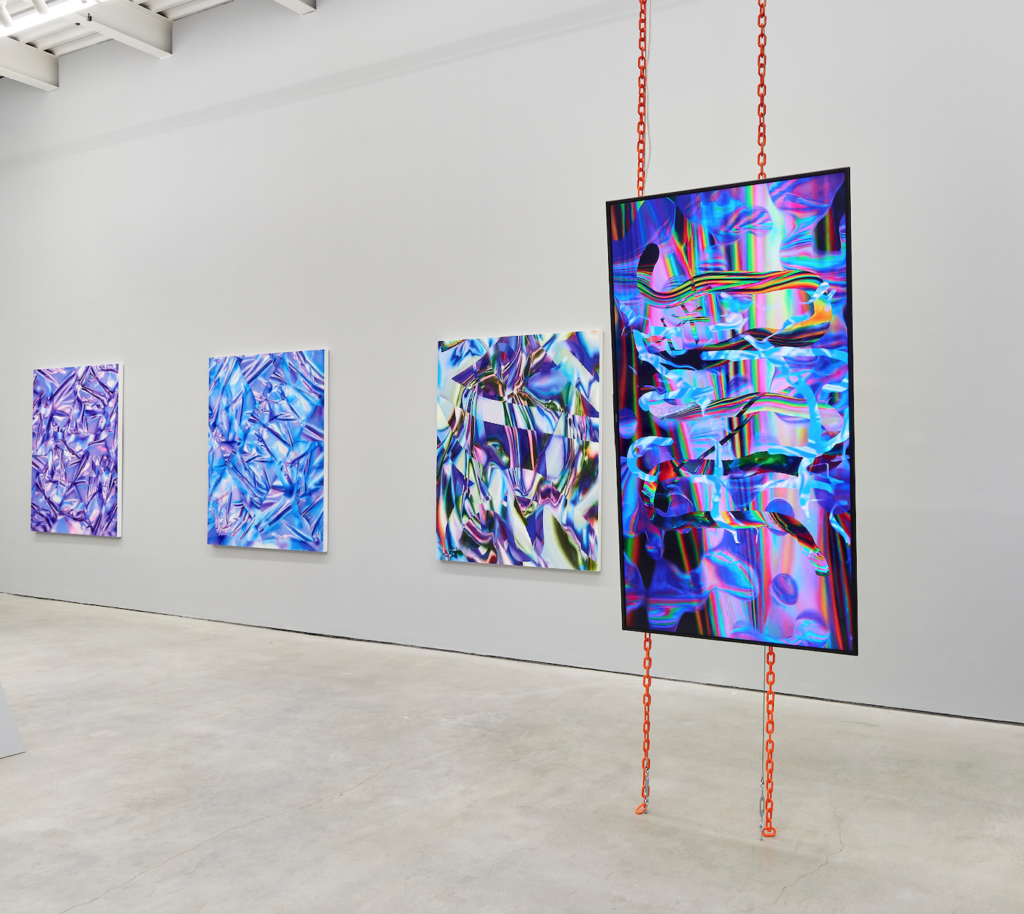
NB: Do you have any upcoming projects, works, or installations you can share with us?
AV: I’m working on a screen print edition with Louis Buhl that will be released in the upcoming months. I am unsure where they are going yet – but I am continuing to develop my paintings and videos in my studio
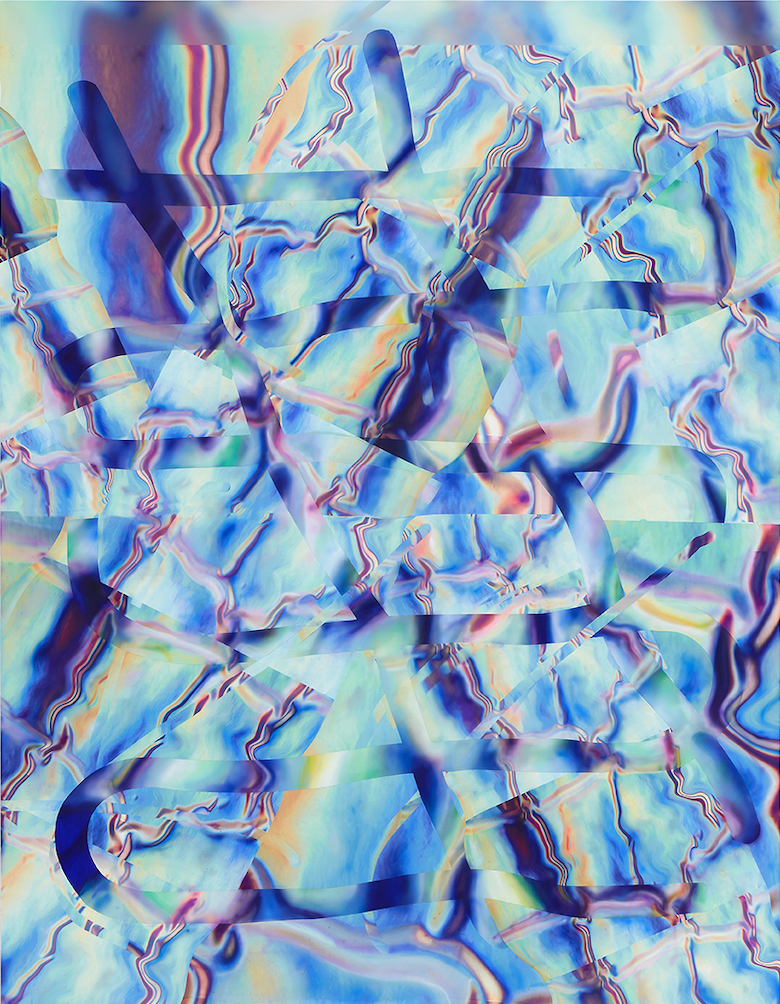
November 23, 2021
Artist to Watch
SARAH MEYOHAS
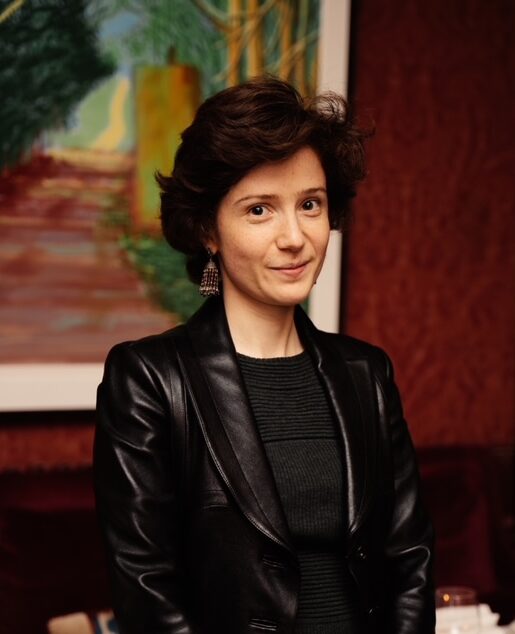
NB: When we first met and spoke in November 2016, you had already created the BitchCoin project and the Stock Performance takeover of 303 Gallery, where you traded stocks and artistically shared the immediate impact, or lack thereof. The stock changes were reflected in oil stick on canvas. How we conceive and understand value, and how it’s represented, is a central theme in your work. Can you remind us how you came to examine this intersection of the finance world and the art world?
SM: My background is finance so that was the first lens through which I was looking at the world. Then I went to art school. Art obviously has a relationship to value, whether it be economic, spiritual or cultural. It has a very complex relationship to value. Given my background, and given what I wanted to explore, value became this conceptual knot that I was looking to understand and untangle. Value doesn’t exist in a vacuum; it isn’t a standalone thing. It is a relationship, and it appears in exchange. In a void, there is no such thing as value. An exchange is a play of substitutions: one thing is in the place of the other, and that is ultimately a representation. The reason that art has to do with value, and therefore has to do with currency, is that currency is the representation [of value] that circulates.
I was reading theory — “The Currency of Images” — and thinking about value, very abstractly, from that side of it. I was also thinking about value very practically, in terms of things like our economy and how values emerge from that in a global system. I was developing BitchCoin in 2014, after I had heard about blockchain and thought it was an amazing construction of value, that didn’t rely on the force of government. Blockchain was a completely new concept. The metaphor of gold was also very interesting, because that relates to both the blockchain and art. Bitcoin, as a coin that’s mined, goes through an exertion process to get the output; that’s how the currency expands. Art, obviously, has a very strong relationship with gold. Gold is at its base an artistic material that was only used for cultural purposes; it didn’t have any other purpose, and that’s why it became currency.
So, in doing the operation of linking the two, I wanted to make my own currency as an artwork, and I wanted to make it hyperfeminine as a statement. I decided to back it with my own artwork — to give it some sort of value — and that’s where I came up with the Speculations series. The visual motif of the Speculations is the metaphor for the blockchain; they’re blocks that go on infinitely. It’s the same play on words — specular relation — it’s about an image of an image of an image of an image. It’s a constant exchange, with the image as the operation of the three dimensional thing appraising itself in two dimensions. It’s an operation of making a value of something. It all turns into a kind of soup of concepts — values and reflections. The fundamental thing that I’m doing is connecting — whether it’s blockchain, the public markets, big data or the cutting edge of augmented reality tech — to identity, and to a body (the most subjective things in life) because they’re actually just related.
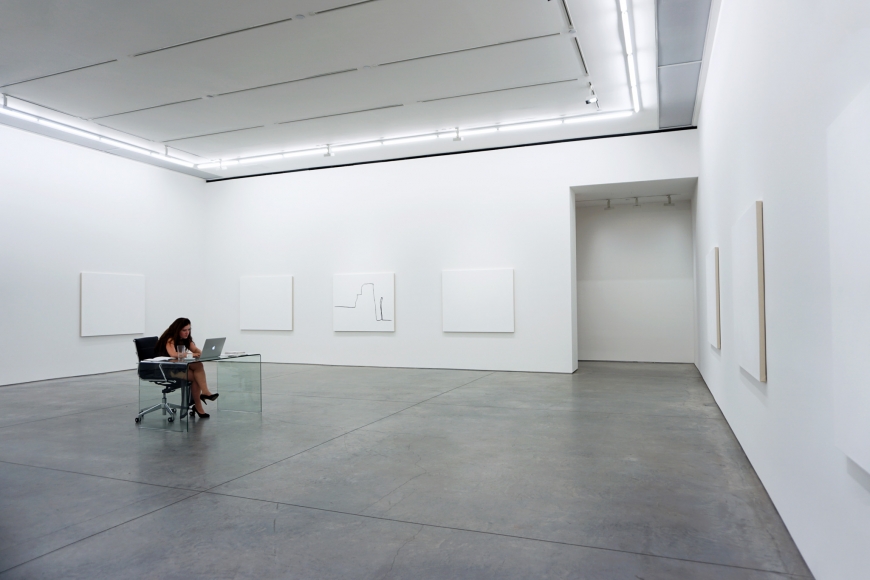
NB: In your September 2021 artnet op-ed, you address the differences between BitchCoin (which predated Ethereum), and Damien Hirst’s project The Currency. What are your thoughts on gender, and gendering, in the crypto space? What has been your impression of the recent surge in NFTs, and the crypto space in general?
SM: In terms of gender, being in the NFT space — it’s tricky. The crypto space is about anonymity; people are anonymous on crypto. To a certain extent, your genetic makeup is unimportant. That’s not what it’s about. It’s not about who you are in the real world, it’s about what you’re like in the metaverse. To some extent, that is really refreshing, because it does feel like — in the real world — my genetics have way too much bearing on how people judge my identity.
In crypto, you’re anonymous, and that’s a breath of fresh air compared to identity in the real world. The downside is that most of the audience is men. It’s just the reality. The people who are buying NFTs — they’re traders and they’re crypto investors. Even if they don’t know who you are — and they don’t care if you’re a woman, a Black person or a trans person — the type of work that appeals to them [men, as the audience] is work that is very masculine. Think of the Bored Apes — this work is obviously very ‘bro culture’ masculine. Even generative art, as a concept and how it works, is fundamentally masculine. Maybe people will find this controversial, but it’s true.
There is a deluge of material out there, that in order to give value to an NFT you need to develop a community with a Discord, on which everyone is chatting and contributing, and it feels like you’re building some sort of movement. You need to constantly engage your audience, which is not necessarily what makes a great work of art. Great art is not consistently engaging you in a chat room. That’s why some of these projects aren’t really art; they’re cultural, collectable moments with aesthetic and artistic parts.
Then you have the generative art. As a cultural movement, people like to have editions where you can pick one (and one is better than another) but they’re all sort of random, and there is the element of rarity. This set-up kind of exists in the traditional art world. A painter makes somewhat similar works, and some are better than others, and you can make a sort of contest of which one is the better one, even if they look similar. Generative art is a crypto version of that. They have limited the tools of production to be a limited number of lines of code, and it’s all on chain. By limiting the tools of production, you’re allowing someone to display some sort of mastery with a tiny JPEG — that’s the movement of generative art. And it’s fine; it’s not a bad thing. It’s just, sometimes the results can be underwhelming. But I don’t want to speak ill of generative art — I think that out of all the things in NFTs, it’s one of the better things.

NB: In the relatively short period of time since NFTs have entered the mainstream, what’s your impression of the market, and this recent surge? In the crypto space you are one of the few women in this area, so I’m curious to hear your experience.
SM: I feel as though I’m in this odd Venn Diagram where I’m the only person who is in the traditional art world, in the crypto space, and is a woman. I’m alone in that convergence of the diagram.
NB: You’re the poster child for women in the crypto crossover space!
SM: I am and I’m not. The original work was a conceptual work where I proposed a system as an artwork, embodied it, and later invested in it. I didn’t come from the digital art space. The Venn Diagram then, by adding in ‘Conceptual Artist,’ becomes smaller and there really is no one else. But, I’m not a poster child, I’m just a weird outlier. The poster child is someone like Beeple. He’s a poster child for the NFTs.
NB: What has it been like?
SM: It has been fascinating. The thing that’s amazing about NFTs is that you’re selling something for which someone doesn’t necessarily need wall space. It’s the revenge against painters — all the time, everywhere — making more money than anyone else. It’s revenge! Finally, the weirdos can thrive! That’s the amazing thing. Normally, if you just collect for the love of it — with no thought or concern about where you’re going to put it and deal with it — you are in a very small, very amazingly privileged group. With NFTs, if you’re someone without a large apartment, you can still have a collection. What I hope for NFTs is that they end up bridging to the physical world, and allow for a separation of the stewardship of the physical asset from its ability to have some sort of financial value.
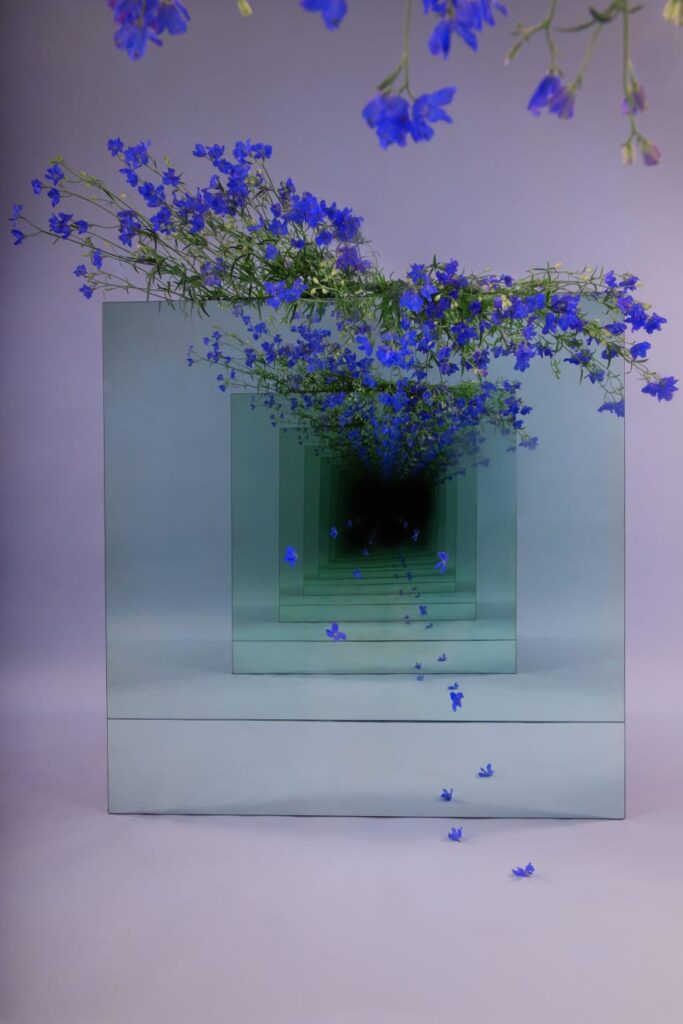
NB: Have you explored that in your work? BitchCoin has the physical piece that goes with it, but in terms of a display process for the NFTs, is that something you’ve looked at?
SM: Displaying the coin? No. Some people do choose to display the coin — I’ve seen it displayed in a residence. The longtime benefit of painting has been that it’s portable, archival, and easily comparable. For all of the art that is not like that, it’s very difficult. I think people should start making NFTs and start linking them in legal ways to physical artworks — but not linking just to another painting. It should be with things that can’t otherwise move, for example.
The NFT market is on fire. Communities are being built around it. It’s a new type of collecting, and the collectors value different things.
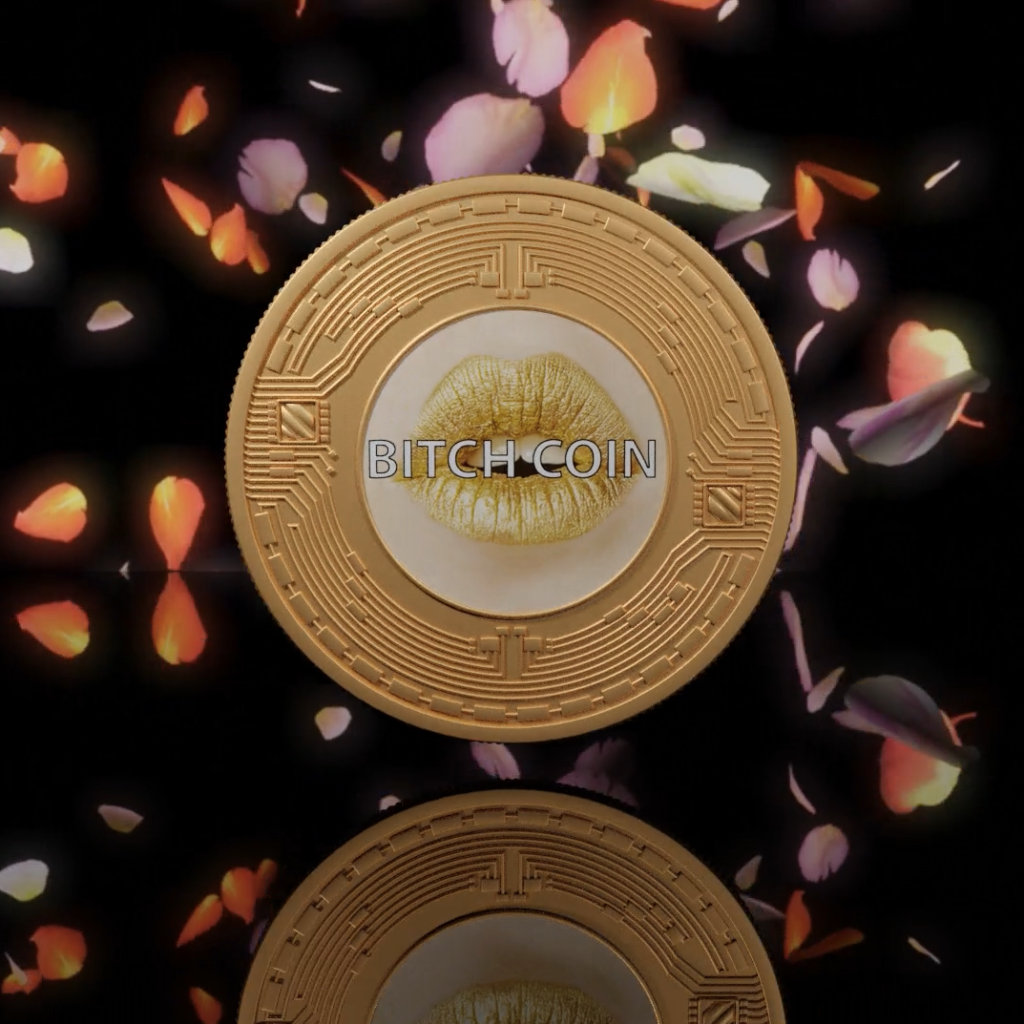
NB: It’s a different type of collector, too. The people who are buying NFTs don’t necessarily know the names Judy Chicago or Gerhard Richter. And those names might just not be relevant to them. I do liken NFT culture to sneaker collectors. It’s very much driven by community, the culture of likes, social media followings, and the persona that is ultimately built around the identity of the artist. This is why you see so many of these collaborations happening with Steve Aoki or Paris Hilton. It’s about how many social media followers you have, which can ultimately drive up the price. Could you tell us a little bit about your Cloud of Petals series, and the incorporation of artificial intelligence into this project? Could you also speak to the role of gender in this series?
SM: It’s sometimes hard to articulate the Cloud of Petals because of its physical and conceptual breadth. It feels so all-encompassing that it’s hard to summarize one part of it. The mechanics of it are somewhat straightforward: 16 men, temporary workers, all male. Male hands, picking apart [flowers], in a way an act of judgment and somewhat an act of violence. But they’re doing it kindly, and they’ve been told to do it — it’s their job to do it. They’re picking apart and photographing 100,000 rose petals in the former Bell Labs. Fun fact: some of the beginnings of blockchain, one famous paper that Satoshi mentions in the bitcoin white paper, that famous paper was developed at Bell Labs. So, Bell Labs is kind of the source of it all.
NB: It has come full circle!
SM: Yes, really full circle! This is a giant proof of work. These men are photographing 100,000 rose petals, and then they pick one petal per rose that they consider the most beautiful. At the time I did that, I wanted part of it to be a physical relic. A lot of this is about trying to locate the truth at its most fundamental level. At a high level, it’s about automation and AI as trends: where do we locate beauty and subjectivity? But, at a deeper level, it’s really just about truth and ‘the record.’ There are the photographs; the films on 16mm, which has a completely different way of recording; there are the pressed petals, which are the relics; there are the digital petals that turn into the AI experience of the petals, which is it’s own truth, too. In terms of a Platonic ideal of ‘what is a petal?’ and ‘what are petals?’ that then gets substantiated a gazillion times. The project has to do with the sublime, and the specific sublime of hyperobjects and big data. The nature of photography as it shifts and turns into data; that whole element is part of the project, too. The project also partially mimics the world, especially given the narrative — which is now changing — of how companies should function. At the time of the project, these companies harvested our data to feed our desire back to us. I was essentially doing that same process, but with rose petals. A lot of my projects take things to an extreme. Now, the promise of Web3 is that you’ll be in control of your own data — there won’t be a centralized hosting platform. This project [Cloud of Petals] was very much Web2 inspired.
In a sense, it’s a perfect tie to BitchCoin, because that was backed by the Speculation photographs. There was a funnel process: making 100,000 new photographs, and then the resulting BitchCoins that come out of it are the relics; the pressed petals. The elements that have gone through the entire proof of work process to make it completely deflationary. Nobody wants a BitchCoin currency that goes on forever. Cloud of Petals is essentially the method to get BitchCoin (a fork of bitcoin) to Ethereum in an artistic way.
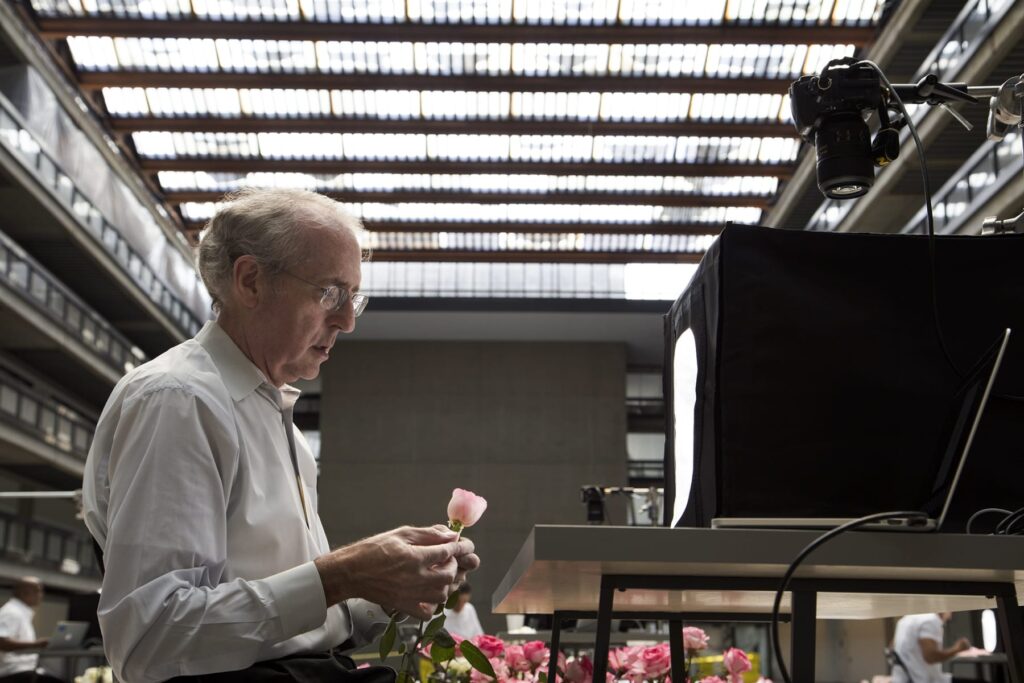
NB: What’s coming up for you? What other projects do you have going on, what’s next?
SM: I have a few projects. I’ll have a solo booth at Untitled at Art Basel Miami, with new AI petals and photographs. I’m making holograms, too.
NB: Is it with a gallery?
SM: Yes, it’s with COUNTY gallery, they’re based in Palm Beach, so this is their home turf!
In mid-February, I’m going to have a show with Nahmad Projects in London. That show is about my work around structural color, meaning, how birds and butterflies create color, and different instatiations of that.
One will be a piece in HoloLens (Microsoft’s Augmented Reality software), with a physical player piano. In augmented reality, there will be birds and watercolor effects that land on the piano and trigger it to play. There will also be sound spatialization that tracks the bird’s flight. You’re composing the birds and the music together.
Another piece that I’m working on uses diffraction grating, which is the glass used in Hololens. Diffraction grating is glass that has been etched 3000x per millimeter, so it refracts light and creates structural color that shifts when you move. Any grating can really be any color, it just depends on the angle of light, and the angle at which you’re viewing it. This is used in all sorts of optical devices — in airplane displays and in military technology — but I’m using it to create artworks. I will also put photographs into diffraction gratings.
The third work is that I’m also making holograms. It’s funny; it’s not as political or economic as some of my other works, it’s just more about pushing the structures of technology and what we can see. For the holograms, I made some super macro shots of plants that start to look quite hairy and weird.
NB: Just out of curiosity, do you have a studio where you produce your works? Or do you do this all on your laptop?
SM: I don’t have a studio, and I don’t think I will ever have a studio. If anything, I would have a place where I keep things. The truth is, even for my photographs, I used to use a studio and make my photographs on my own. This summer, instead, I went to Paris and worked with a few people. We rented one of the professional fashion shoot studios, with all the gear. Normally, the fashion shoots would be for one day. I went in and rented the place for a week, and did a full intensive! I got a much better work product than I would otherwise, being on my own in a studio. One day, maybe I’ll have a space. At this point, I don’t think that’s my plan.
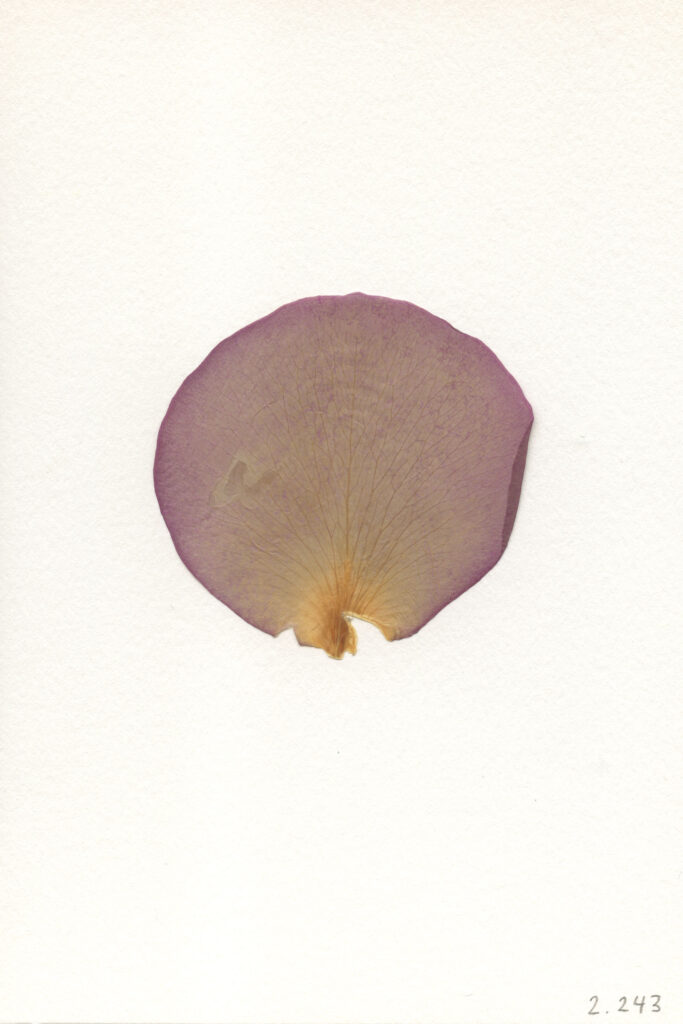
October 4, 2021
Artist to Watch
TRUDY BENSON
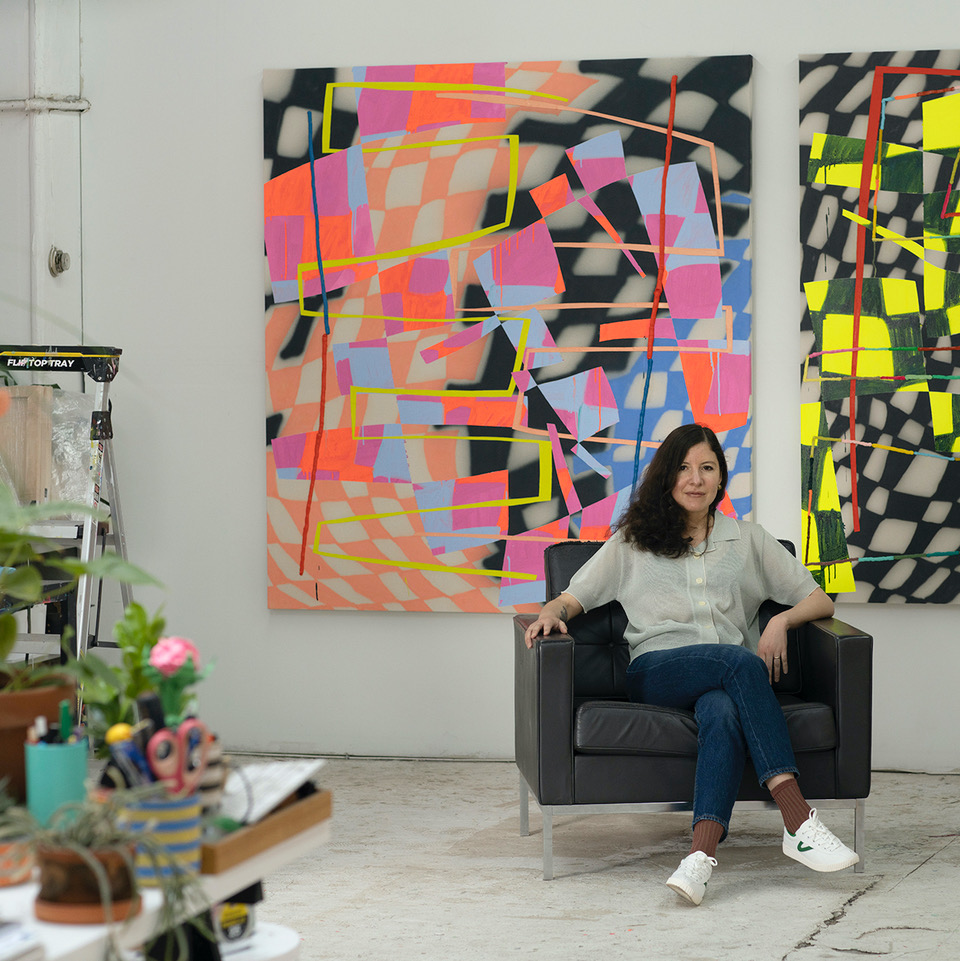
NB: Congratulations on your most recent shows, and your upcoming solo show at Miles McEnery and concurrent solo show at SUNNY NY. You’ve clearly been very busy over the past years, so how have you stayed creatively inspired during these surreal pandemic times?
TB: Thank you. Yes, this month I will open two concurrent solo shows here in New York, both entitled WAVES. My solo exhibition at Miles McEnery Gallery will open on October 21 and run through November 27. The show will be at their 511 West 22nd Street location and will consist of all large scale paintings, including six 77 x 66 inch paintings. At SUNNY NY, the show will run from October 28 to December 11. SUNNY NY is a very young artist-run gallery in the East Village, so WAVES at SUNNY NY will have a bit of a different feel to the big Chelsea show. There will be seven paintings at SUNNY NY, as well as a site-specific wall painting/installation and five or six works on paper.
Regarding staying creatively inspired during pandemic times: there was definitely a window of time when I simply could not paint. When that passed, the studio was there waiting for me as an escape. I think that as artists, we have a slight advantage over some others, in that we are used to spending long hours holed up in the studio alone. When the world stopped and time seemed to stretch out eternally, I began to slow things down in the studio. As a result, the time in the work changed, and I felt that I could really take my time editing the work. The bug under the microscope feeling was gone. I am lucky enough to have a supportive partner who is also an artist, so we both found comfort in painting.
I’ve always been inspired by my surroundings, no matter what they are. It almost doesn’t matter where I am or how much I can consume. For example, the recent paintings included in WAVES, were initially partially inspired by my daily crossword puzzle habit. I sometimes take a photo with my phone of the finish screen that shows up on my iPad when I achieve a new time record. A weird screen interference started to show up, kind of a moiré pattern overlaid the very orthogonal check graphic. And so, the warped check airbrush layer was born. I am like a Shibu Inu in that I am happiest when I have something to solve. I think about the paintings in this way, also. I don’t plan them out from the beginning. Instead, each move is a response to the current state of the painting.
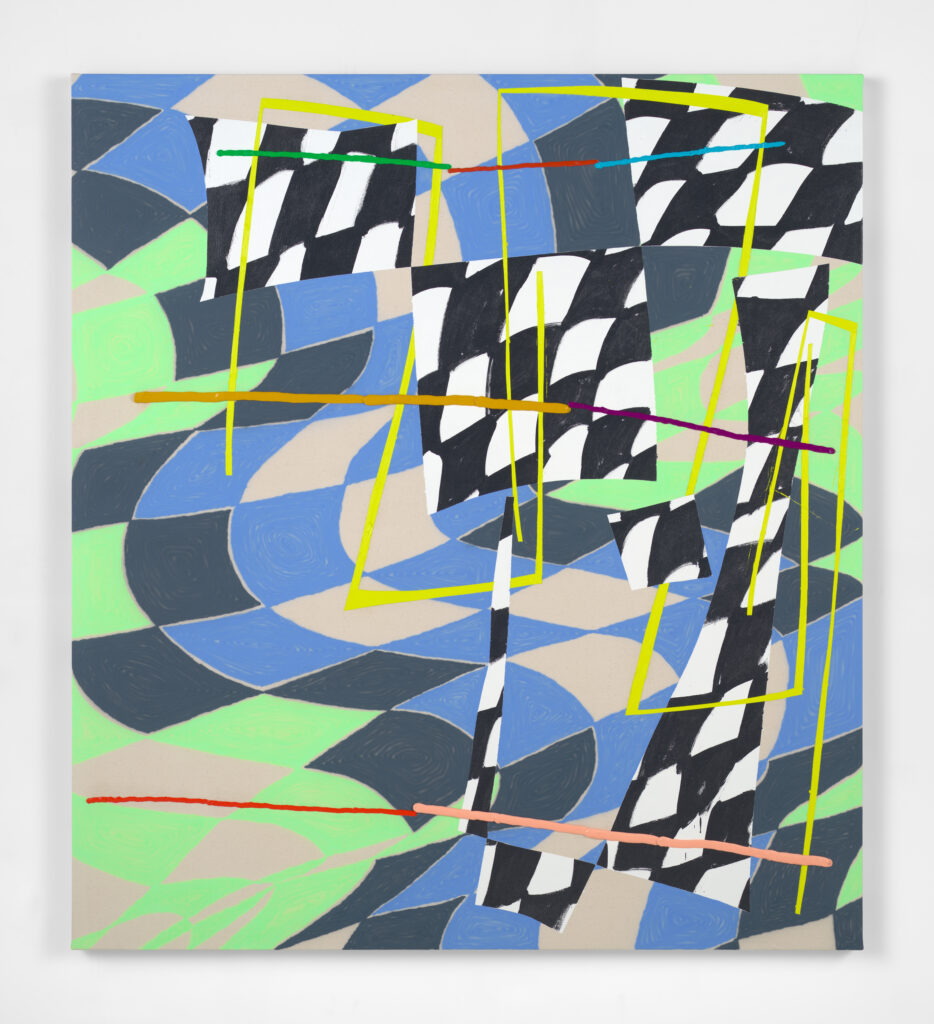
NB: Can you speak to how you view the processes of collage and paint interacting within the scope of your work? How is the color palette determined for each work?
TB: I visualize the work as almost an illustration of a collage. I want the layers to feel tangible, to feel almost as though you could get into the painting and move things around with your hands. (Please don’t actually attempt this!) The different methods of paint application help to reinforce the virtual space in the work. The sprayed acrylic absorbs into the raw canvas, and the blurred edges help to push it into the background. Certain areas are built up more, whether in acrylic or oil paint, to push those layers forward in space.
Regarding color palette, I usually have a very vague idea of palette when I begin a painting, and then react to that as the painting progresses. Nothing is planned out beforehand. Most of the decision making happens on the canvas. I use color to create tension at the surface as well as optical effects.
NB: How have the digital age and computer software influenced and inspired your practice?
TB: I still think about the work in terms of layers. The shallow space the paintings inhabit definitely has its origin in digital imaging. My first attempt at an abstract composition was on my dad’s desktop computer at a Bring Your Daughter to Work Day. We also had an old Macintosh SE lying around at home with the MacPaint program installed on it. I remember the tool bar with fondness: suddenly I could conceive of using a spray can alongside a gradient and a paintbrush.
Earlier paintings were almost quoting this nostalgia. I think my recent paintings have reinforced their own materiality, while maintaining this entry into abstract composition. To see the works in person, there is so much more than the digital reference. The paintings are human-sized or larger for the most part, and completely hand-painted. I don’t use projectors or digital printing in my work. At this point, I think the digital age is more of a reference point for the work. At heart I am a painter, a grungy studio rat.
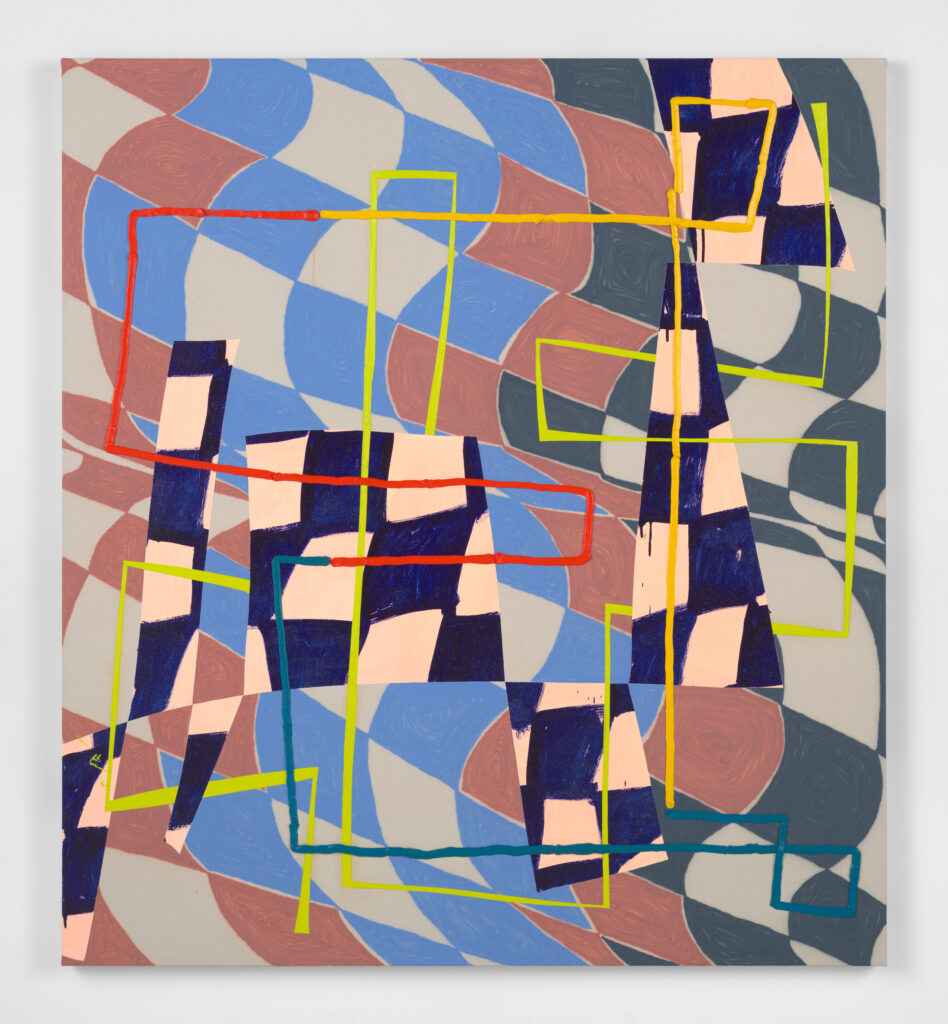
NB: I read that you participated in the 2021 group exhibition Her Dark Materials, curated by Philly Adams at the Wolverton Works Virtual Art Museum, Buckinghamshire, UK. Can you tell us a bit about the process of participating in a virtual exhibition, compared and contrasted to your experiences with in-person shows?
TB: Having exhibitions during a global pandemic has changed my relationship to the paintings a bit. I always felt that seeing the work in the gallery space really helped me to see the paintings in a new way. I’ve since had two solo exhibitions overseas that I never got to see.
Her Dark Materials was special in that the space was beautifully rendered virtually by an architect (I believe). There was a haunting video created to move the viewer through the exhibition. It is kind of magical!
It is a beautiful thing to still be able to “exhibit” paintings during a time when shipping could be shut down at any moment and we cannot physically gather or it is unsafe or unwise to travel. However, I fully believe that art ought to be experienced in person. Without going to the place the work is to be exhibited, the paintings almost don’t seem to be finished. There is a big difference to how a painting is perceived by the artist in the studio versus in a gallery space where installation and the venue is taken into consideration.
NB: Would you be able to share any information with us about upcoming exhibitions or projects you’re excited for in the next year or two?
TB: I will have six small paintings as part of a presentation with PLATFORM, David Zwirner’s online initiative, sometime in October. I also have a series of works on paper to be exhibited in my dear friend’s vitrine space in Brussels to open late October: Massif Central is run by the lovely Tessa Perutz.
I will have a couple of two-person exhibitions with my partner and fellow painter Russell Tyler: Mother Gallery in Hudson, NY early summer 2022; and Gaa Gallery in Cologne scheduled for late fall 2022.
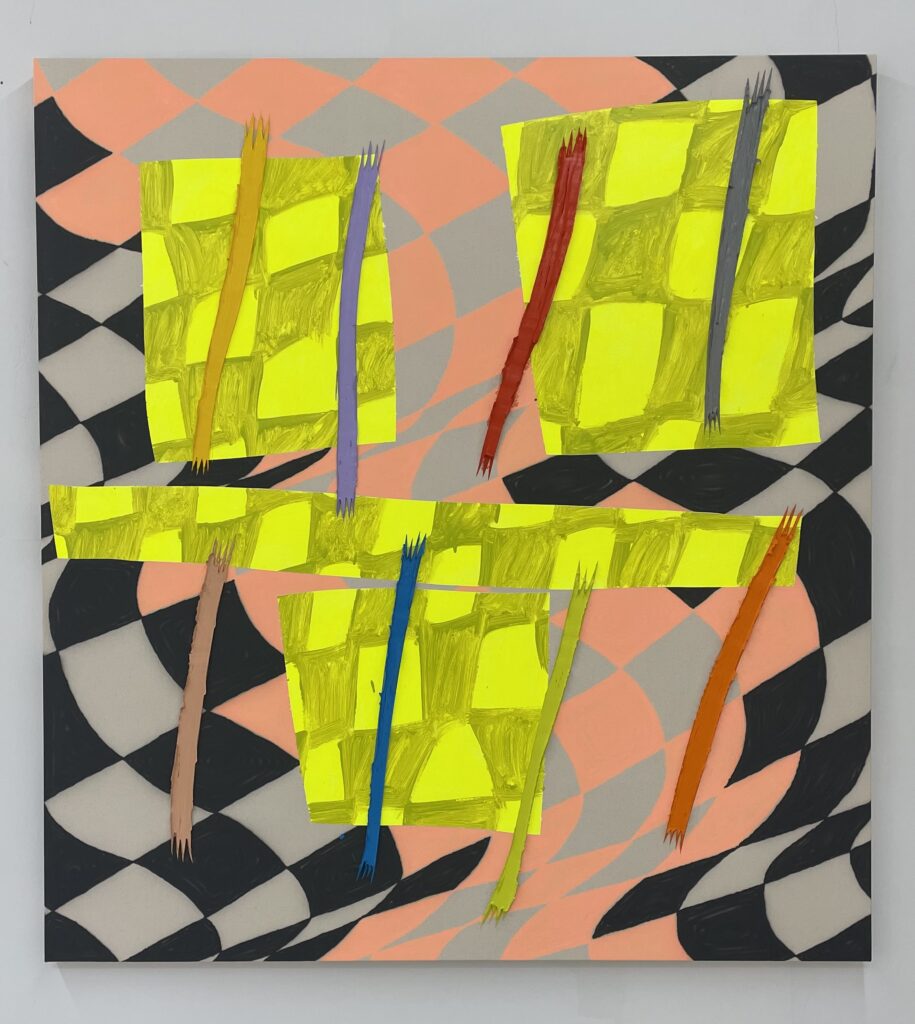
August 24, 2021
Artist to Watch
THEODORE BOYER
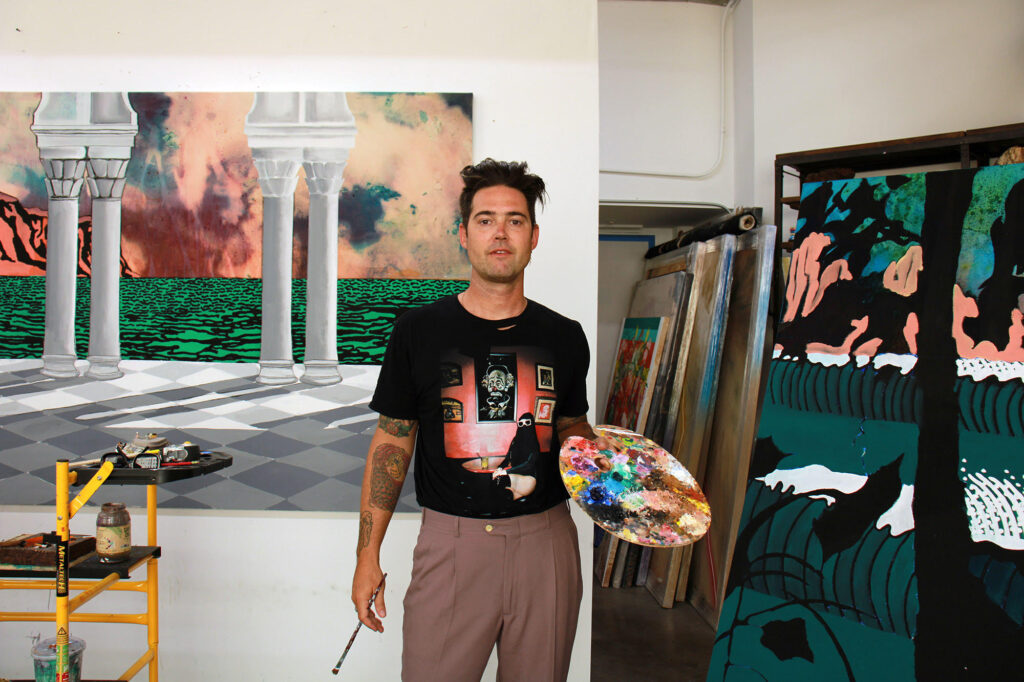
NB: What are your earliest memories of interacting with or experiencing art?
TB: I think it was when I was really little, probably my youngest son’s age — four years old. I grew up in Orange County, just south of Los Angeles, in a suburb. My cousin and Grandmother lived in Morro Bay. When we would come up to visit them, we would drive through Los Angeles up the 101. I would see the murals [created for the 1984 Summer Olympic Games] by the Disney Building. It’s the same murals there now as in the 1980s. It’s amazing. In Glenna Boltuch Avila’s L.A. Freeway Kids, there are these little kids and there is one playing basketball. On the other side, there is the mural of Lita Albuquerque, from Kent Twitchell’s 1983 7th Street Altarpiece, across from a work by Jim Morphesis. It’s amazing, and it really stuck with me. As a little kid, I was wondering — what is that?! I ‘got’ the murals and the things that were more obvious — like graffiti — but that piece really stuck me.
NB: Let’s talk a little bit about your work. What are the different themes you explore, regarding identity, belonging, sense of place? Can you talk about how these influence your work?
TB: I was adopted, and that plays a role in my identity issues. I hadn’t really known who my [birth] parents were for a really long time; I never really knew where I came from. It never really struck me, until I started creating art (and talking to my therapist) that these were serious, deep-rooted things that I needed to explore and deal with. Throughout the last 10 years, since I’ve been seriously making art, I have been going back to this theme of death and rebirth. It is an ancient, ‘as above, so below,’ masculine feminine alchemical thing that really, to me, starts at birth and ends at death. The way that I have worked is by starting with abstract paintings that represent various primordial things — focusing on the background in the abstractions — then moving into more common themes like evolution, for example, or astrology or astronomy.
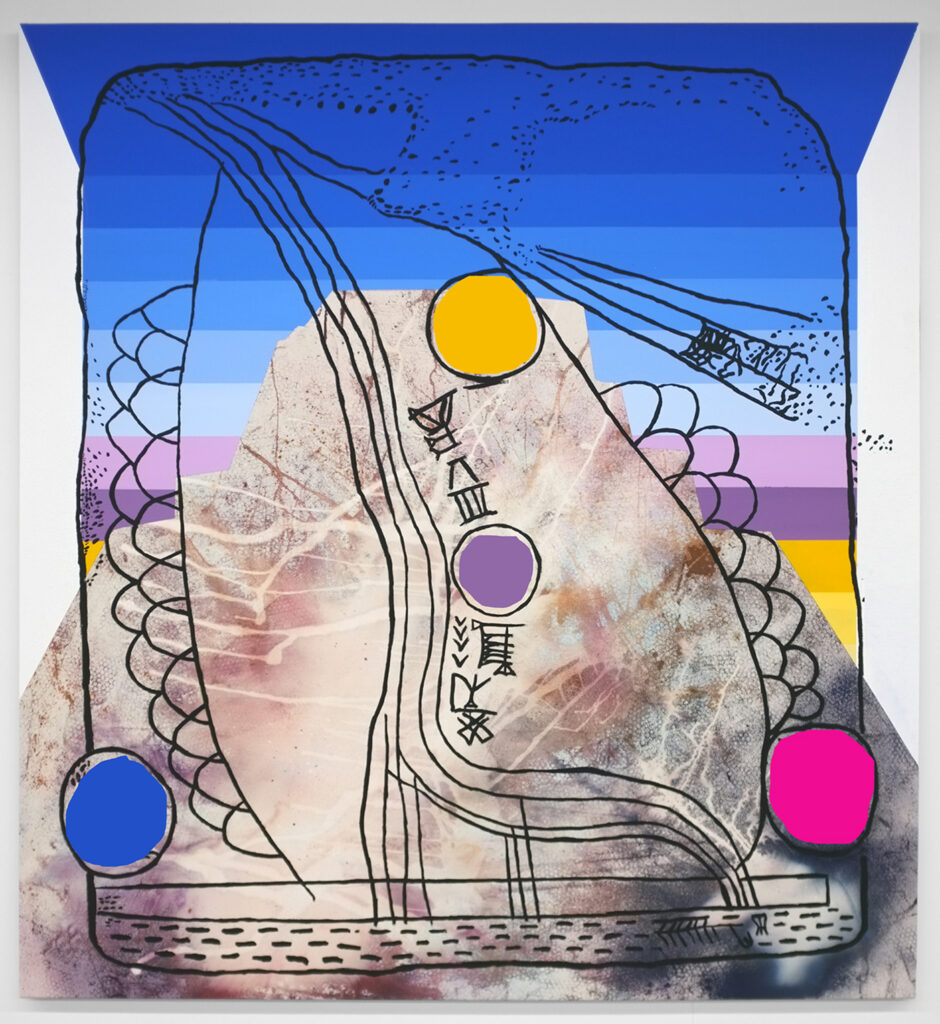
NB: How did you become inspired to incorporate science and nature so centrally in your creative practice? Could you also speak to the different series that you’ve been working through?
TB: Science and nature have always been a part of my practice. I’ve always gone back to the ideas of spirituality, reflecting on the cosmos and the primordial being, the origins of humanity, and evolution. I worked in the abstract for a while, dealing with cosmology, astronomy; looking at stars and thinking about navigation. As it evolved, over the last couple of years especially, I have been moving into more figurative work. This transition has stemmed from my personal experience; my personal journey through life.
NB: I can tell from your work that you’re very interested in the history of painting. Who have you been looking at, in art history, that has influenced the different series of your work?
TB: I am always looking at art and artists. Many, many different artists (and things!) influence me: Sigmar Polke, German Expressionism and Alice Neel, [David] Hockney, Marlene Dumas among others. The artists that I am influenced by have such a wide range — just thinking about the contrasting practices of Alice Neel and that of Robert Smithson. There is so much art that goes into my subconscious and gets cycled around, and then translates into my little formulas that I have when I paint.
NB: Can you speak to those formulas a little bit?
TB: I start out with the abstraction. That comes from different imagery of space explosions, chaos and cataclysms. I have several books in my studio where I collect inspiring images to have them constantly visible and circulating, so I keep them in my subconscious. I’m constantly looking at various things. I have a vast library too. I am always looking at images that reference what I’m painting — even the abstractions. I use that as a background then I move into different techniques. Right now, I’m working on mostly figurative pieces. Essentially, I’m collaging the ideas together.
NB: Could you speak to your series Rainbow Cataclysm? Do you have other projects coming up, or new series that you’re working on?
TB: The Rainbow Cataclysm is, again, a sort of collage of my acquired tropes from over the years. The real core concepts are: human origins, death, and rebirth, which are the overarching topics that I deal with in most everything that I create. Like ‘the chicken or the egg,’ everything starts at some point, right?
Things culminate in one moment, then die, then come back — possibly as another thing? That is the on-going theme. I’m looking at flowers, I’m looking at still lifes; I’m looking at things that decay and devolve. I am also looking at the human experience, as well. These flashes of time that happen over the course of eternity. What I’m exploring in Rainbow Cataclysm is a subconscious flashback, in many ways. The idea of a cataclysm, in and of itself, is that every civilization comes to an end at some point, and then it’s reborn and turned into something else. Those concepts exist on a macro level and also on a micro level. I’m working on the microcosm of this experience now. I’m looking at organic matter that decays over time; the human condition; relationships; things that start, blossom, and come to an end — in one way or another.
I have a couple of upcoming projects. One is a show in Hong Kong called Techno Lust that is curated by Ben Lee Richie Handler and staged at W.O.A.W. Gallery which I’m putting together right now. It’s a group show, and I’m doing an installation. Some of my Star Map paintings will be presented as wallpaper, covering a whole room — in a psychedelic way — then paintings will be hung over it. I will also show a couple of paintings, alongside many cool artists. That show will be at the end of August. Then, I am going to Istanbul for a residency at Sevil Dolmaci Gallery in mid-September where I will also be exhibiting paintings for a show curated by Dr. Kathy Battista. I’m very excited about that! In the first week of October, I’ll be in Crete for another residency at Elounda Island Villas. The residency is run by a Greek artist named Leda Alexopoulou. I was introduced to her through Viennese curator Anne Avramut – who has a background in archaeology. She contacted me about my new still life paintings. Being that the flowers are painted in these different Greek, Etruscan and Minoan pots, Anne thought it would be cool to connect me with Leda and experience Greek culture and history first hand. With Covid, everything has been locked down for the last few years. This will be the first or second time I’ve been on a plane. It feels like things are getting back to normal a little bit. Hopefully, new art will flow again! Prior to the Star Maps series I had been working on figurative paintings — it was mostly dealing with narratives surrounding history, ancient cultures and archaeology. I was super lucky to have studied in New York and Zurich, where I had access to some of the most amazing museums and collections in the world. During those years I was able to catalogue artifacts and relics that would appear in my work much later. Although in the past five years I’ve been exhibiting mostly abstract paintings, I was also painting small figurative studies for my own enjoyment. It wasn’t until a couple of years ago that I would publicly show them.
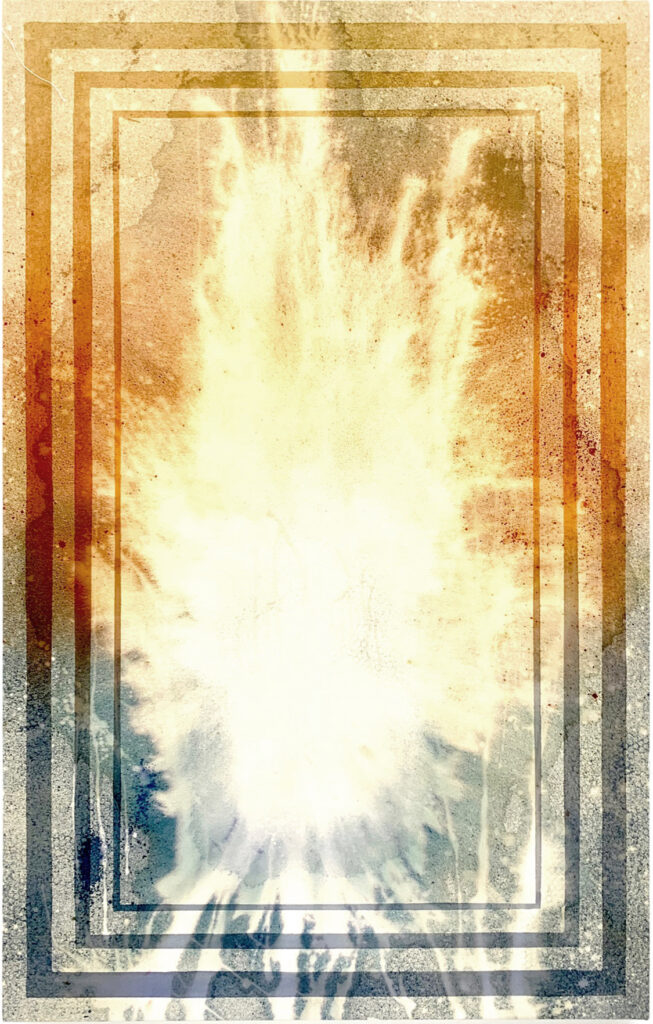
NB: Did you find that the time during the pandemic greatly influenced your work, and the type of work that you produced? Did it change the type of work that you produced? Or were you just trying to just survive, with two kids at home?
TB: Yes, I mean, honestly, going back to the studio was like my sanctuary. I felt really fortunate to have had the studio space, and to have been able to keep it. At that time, I had been working with several galleries and I then went completely independent. Around the same time I was having somewhat of a personal crisis, which I also feel very fortunate to have come out of. After that, I started making work that was more related to what I was dealing with, right then and there, such as the loss of personal relationships and friendships. I also looked at my family; my wife and kids — using them as my muses — and portraying them in my work, which I had not done before and that was a big reckoning for me.
It was a confirmation of the things that really do influence me, and my life, all the time; they need to be in my work at this point! I also started painting portraits of friends of mine — people that I hadn’t seen in 6 or 8 months. Until then, we had just been following each other on Instagram, and making do. Usually, I would have people come over to my studio, and invite people who I would want to paint, and do a portrait from life. Since the pandemic began, I wasn’t able to do that. Most people were worried about Covid, and it was just too much for a lot of people. Instagram was really the only outlet to look at art; all the museums were closed. All the galleries were closed for that period too, so I looked to the internet, collecting images; putting together these image archives. I was also painting portraits of people who posted their pictures on Instagram.
NB: Definitely, it’s the way to connect in the absence of human connection. Back to figuration!
TB: Exactly, back to figuration! Now, I am still working on the Star Maps and abstractions, but I am also bringing people into the studio now and doing portraits from life which always keeps things exciting.
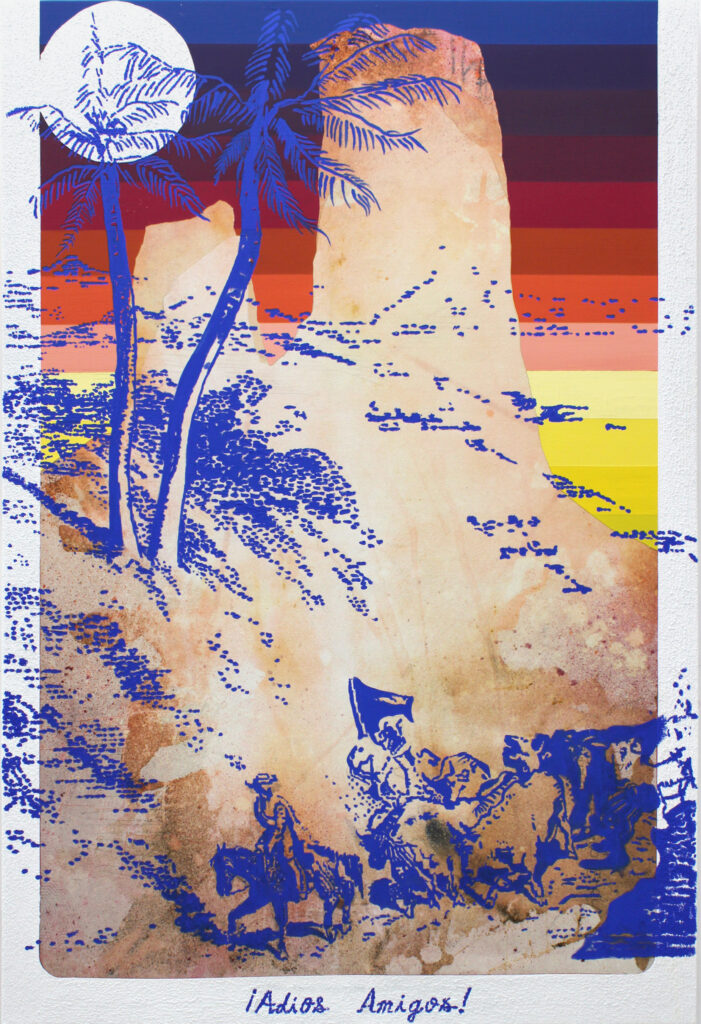
June 29, 2021
Artist to Watch
ANDY MISTER
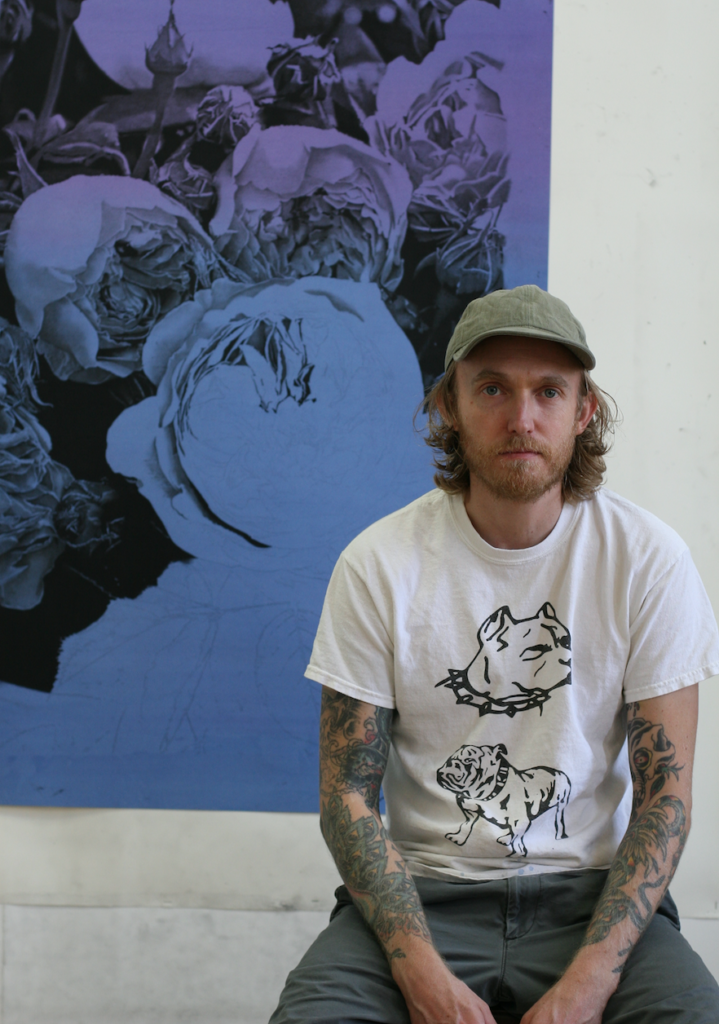
NB: You received your MFA in Creative Writing from the University of Montana, in addition to studying English Literature (and Philosophy) during your undergrad years at Loyola University in New Orleans. Can you speak to how your studies in this area influenced your art and your creative practice today?
AM: I was really into the visual arts, and into making art as a kid. As a teenager, I went to an arts high school. I wasn’t a huge reader until the end of high school. I didn’t really know what to study in college, so I just signed up as an English major. Taking English classes in college taught me how to think critically, I don’t think I had ever really thought critically before that time. It really opened my mind up different ways of thinking about language and information that I just had never really considered before. I think it might have been in my first English major class — our professor asked each person in the class to explain the difference between a window and a door. And it’s really hard to do! You can do it in a utilitarian way, or you can describe it physically, but it’s really hard! A lot of times, the way you describe a window and a door it sounds like they’re the same thing. As an 18 year old, that slipperiness of language really struck me. That really opened up a lot of ways of thinking, for me, that I hadn’t encountered before. For my MFA in Creative Writing, my specification was poetry. There is this famous story where Edgar Degas was talking to the poet Paul Valéry, and he said to him “I am going to write all of these poems. I have all of these great ideas. I have so many ideas that my poems are going to be great!” Paul Valéry famously replied: “well, poems aren’t made out of ideas, they’re made of words.” In the visual arts, similarly, a painting or a drawing isn’t made of images so much, or even ideas; it’s made of material. For me, my drawings are made of marks. In my work I try to focus on mark making in the same way that words are the fundamental element of writing.
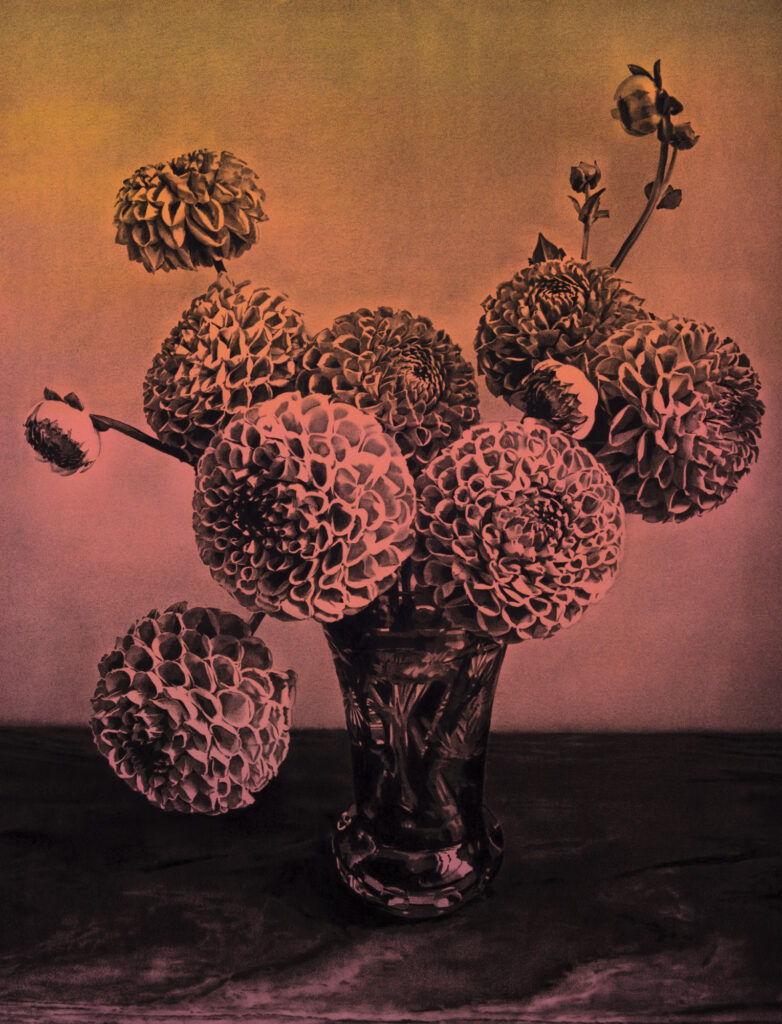
NB: I never really thought about the artist’s process of mark making as being intertwined with the words of poets, and I see there is a very interesting parallel there. Poetry has been so integral to the visual arts — thinking of artists like Kiefer — it is always there.
A lot of your work examines the process of appropriation. Can you talk a little bit about that, and how the works question the way meaning is either created or lost throughout this process of appropriation? Can you tell us a little bit more about what drew you to investigate this topic?
AM: For my generation a lot of the music I listened to as a teenager involved sampling, taking pre-recorded pieces of music and stitching them together to create something new. Also, a lot of elements of the design world (also around music) involved appropriating film stills, and things like that, in graphic design. Before I knew that appropriation was a thing in the arts — the Pictures Generation comes to mind — through osmosis, I had already accepted these ideas of appropriation that perhaps my parents’ generation would have found questionable, or they wouldn’t have considered a real, original piece of art. For me, it was natural. Later on, when I did find out about the Pictures Generation — Sheri Levine and Richard Prince — it didn’t have to be explained to me, it was just obvious. In my own work, I consider all this visual material, whether it’s photographs that I take, something created from life, or something that I find — it’s all grist for the mill of your artistic process; there isn’t a hierarchy. In my writing and my art practice, I’ve always felt that there should be a democratization of source material. I feel that same way in my own work regarding the images that I choose. They’re all of equal importance, there isn’t one image that is more important than another. It’s just a question of how you use the images, and how — when you present it to an audience — people bring their own experience to the work and interact with it.
NB: In terms of the images used in your work, drawn from outside sources, what attracts you to certain images, and not others? I know you just touched on this a little bit.
AM: A lot of the work that I was making at a certain point in my career was socio-political, or historical. I was interested in different historical moments, and I would then research and look for specific images that represented those moments. For example: using a photojournalistic image from the Vietnam War, cropping out a weird detail from it, and blowing it up. Similar to the Michelangelo Antonioni movie Blow-Up. Expanding the image into something new that isn’t recognizable from the original. Back then, the subject matter was important to me, even if it was somewhat obscured in the final piece, or in the process. Over time, I became a little less interested in the historical placement of an image, and more interested in the immediate aesthetic enjoyment of images. I started thinking about taking Pictures Generation moves, or relationships to images, and connecting it back to more classical art historical references. Using content like traditional landscape, or traditional still life, but instead of replicating them from life, or en plein air, finding old photographs and again manipulating and translating them into drawings and paintings. That is how I interact with the images now. I try to find a feeling that I get from a sourced image. I then scan it and try to heighten it and crop the photo to make it into my own thing; I then further make it my own through translating it by hand.
NB: Is it drawing, is it painting, or is it a mixture of both?
AM: I’ve gone through a few different material processes. The majority of the work that I do now uses watercolor paper that I paint washes on, I will then use carbon and charcoal pencils on top of that — and sometimes pastel — to draw an image. As the final step, the paper is mounted to a wooden panel, so it’s not framed and will instead sit on the wall like a painting. It is in this liminal space between painting and drawing, which I feel lets me have the best of both worlds. I really do enjoy drawing, and I enjoy doing things by hand, but I also like a lot of the material elements of painting, such as texture and form, that you don’t totally get with drawing. There is almost a three dimensionality that you lose with drawing. Originally, when I went from making paintings to drawings, I was making graphite pencil drawings on paper. It was exciting to pare the materials down like that at first, but then I became interested in figuring out a hybrid of painting techniques and drawing techniques.
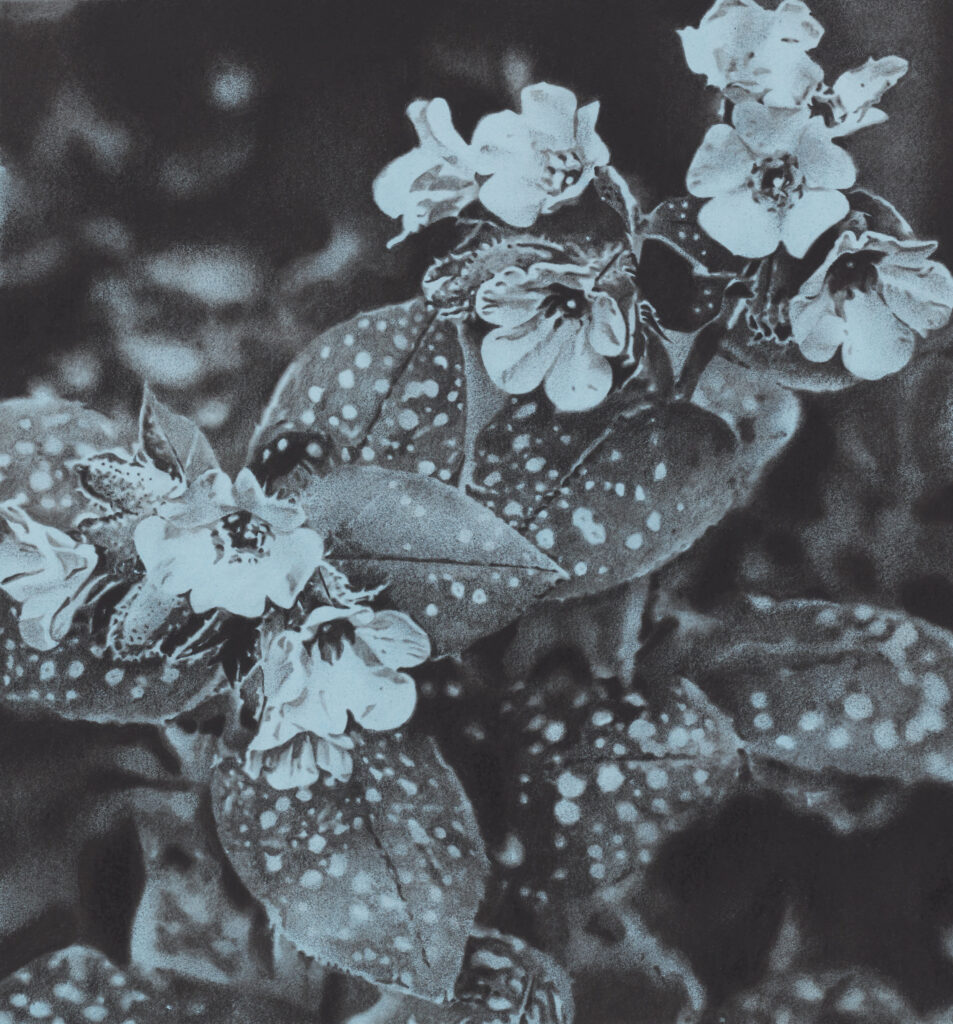
NB: Can you speak to your two most recent residencies, the Lower Manhattan Cultural Council in New York, New York and the Bemis Center of Contemporary Arts in Omaha, NE? How were these experiences? How did they foster growth, creativity and opportunity for you as an artist?
AM: They were really great. I didn’t go to graduate school for the visual arts; a lot of people that I know, especially in New York, came with a built-in group of people with whom they attended graduate school. I do feel like that is one thing I did miss out on. Doing residencies was my first glimpse into what that sense of community in making your work is like; meeting other people who were making very different work, with very different ideas about art making, and bouncing my ideas off of them in a structured setting. It was really great. At the Lower Manhattan Cultural Council (LMCC), I did this project where I drew a drawing of a different political figure every day of the presidency. It was eventually made into a book called Heroes and Villains. I had some ideas like that, to create conceptual pieces, but I had never really had the means to actually make it happen. And LMCC gave me the space to do that. The Bemis Center was also really great; it’s in Omaha, Nebraska. It’s a really beautiful building with really amazing studios, they give you a stipend, and you go there for three months. At that point, I had been working a lot of day jobs and creating work at night and on the weekends. My time at the Bemis Center was the first three month stretch of uninterrupted art making that I had experienced in years. Right after that, I did a solo show at Geoffrey Young Gallery in Great Barrington, Massachusetts and I had created the work for that show at the Bemis Center. That whole period was a really great time for me.
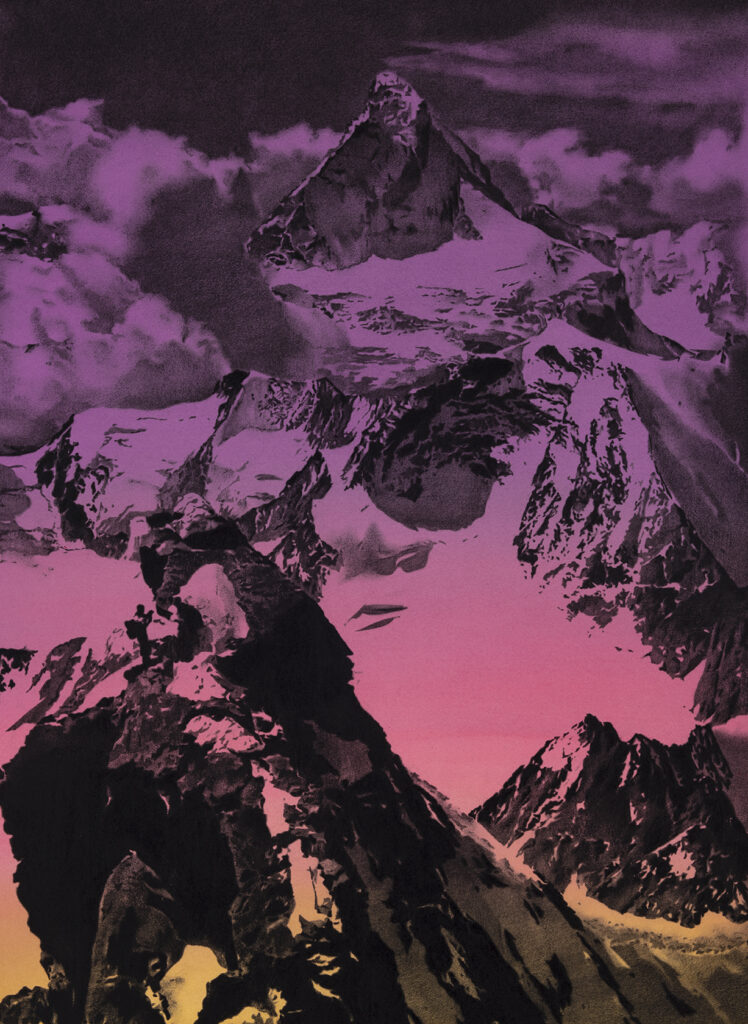
NB: Can you tell us a little bit about what you have upcoming in terms of shows, residencies or projects?
AM: I just had a solo show close at Rebecca Camacho Projects in San Francisco. And now I am making work for my next solo show, at Lowell Ryan Projects in Los Angeles. It opens in February 2022. They have a really beautiful new space that has these amazing high ceilings. I am making some of the biggest mounted panel pieces that I’ve ever made for this show — they’re around 60” x 80” so they’re pretty big! It takes a lot of time to make pieces that big, so most of my energy is going into that right now.
June 2, 2021
Artist to Watch
DOMINIC CHAMBERS
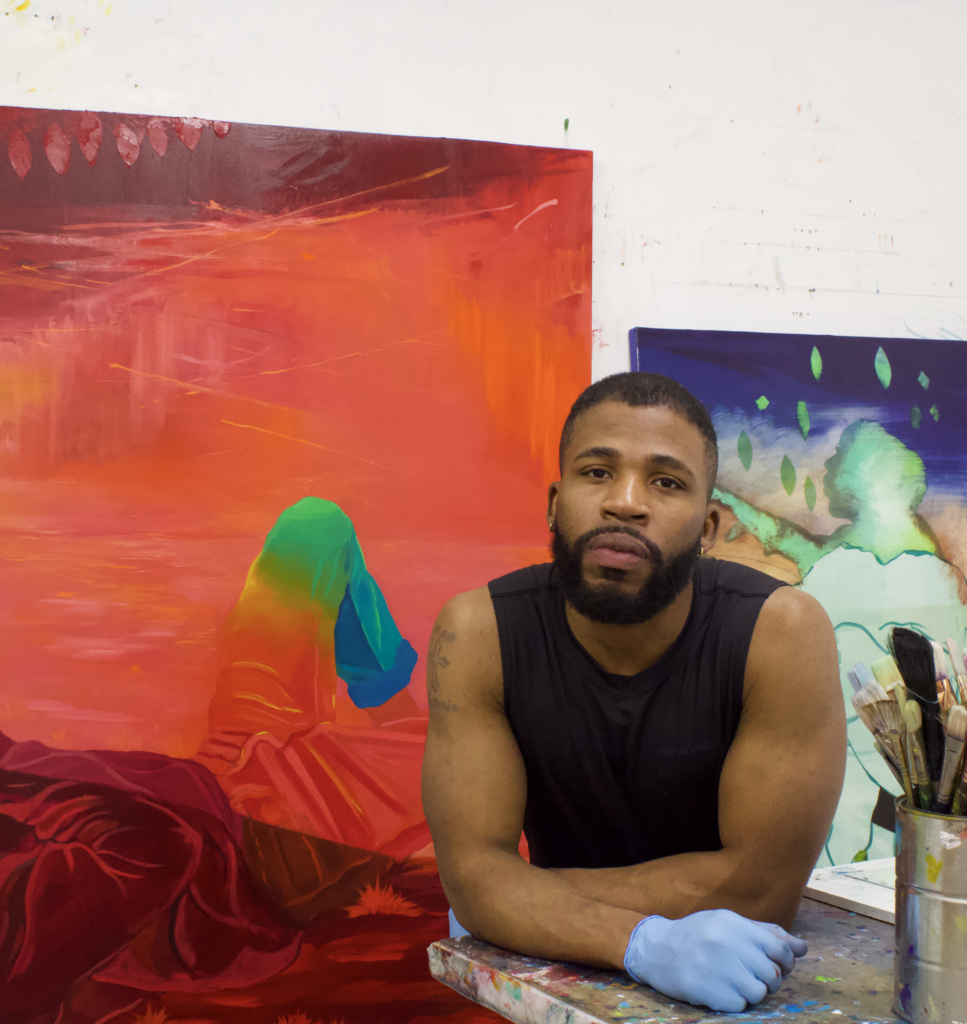
NB: Can you share with us a bit about your experience with art as a younger man, leading up to your time at the Yale MFA program?
DC: Growing up, I always had a fondness for drawing. Mostly recreating characters that I saw in cartoons or in anime. I was a huge anime and comic book fan. I tried to find every opportunity to draw something. My love for drawing coupled with an incessant need to create something was heightened as I took frequent trips to the St. Louis Art Museum during school field trips. Like most black youth in impoverished neighborhoods, I couldn’t imagine a sustainable life in the arts. So, I decided that I was going to keep my artistic sensibilities to myself, maybe write short stories or write plays and keep them to myself. But I was dating a girl who told me that if I didn’t go to college she was going to break up with me, so I enrolled at a community college where I was exposed to the critical discourse present both in art history and the contemporary art world. I felt like I finally had a space to participate. From there on out, I learned about the Yale MFA graduate program and the Yale Norfolk School of Art residency. I set my sights on those goals because, in my mind, coming from a lower income family in the northern part of St. Louis, there was no middle ground for me to be okay; it was either, you stay where you are, or you go on to achieve the best. Having a naturally competitive and ambitious spirit, I decided that I wanted to be included in dynamic conversations and have my work respected by the artists and institutions that I came to appreciate.
NB: That is impressive, really impressive. Can you share with us a bit about the subjects in your figurative work? If you could also speak a little to your process, it would be great to get that context.
DC: A lot of the subjects in my paintings are all friends of mine. They are mostly friends that I met in graduate school. The idea, in a way, is that the paintings are a timeline of my life; the subjects grow up. There are collectors who have paintings of me with my long hair, then there will be other [collectors] who have [works] of myself with short hair now. So, in a sense, I am a living subject in these paintings. The process is really one of community. I will reach out to my friends and ask them to model for me, they are often enthusiastic to do so. I think that collectively, we have a shared appreciation of seeing ourselves in moments of leisure and rest. In that way my friends are very supportive of my project. I draw a lot; I’ll sketch some things out in my sketchbook. I’ll text a couple friends “hey, do you have maybe five or 10 minutes? I’ll come to you” and I’ll share with them my compositions and ideas. My friends are great, they’re flexible and willing to work with me. An old professor once said something that I never forgot: “the good thing about being an artist is that people assume you’d be weird anyway,” so you can just be yourself. It’s been working out.
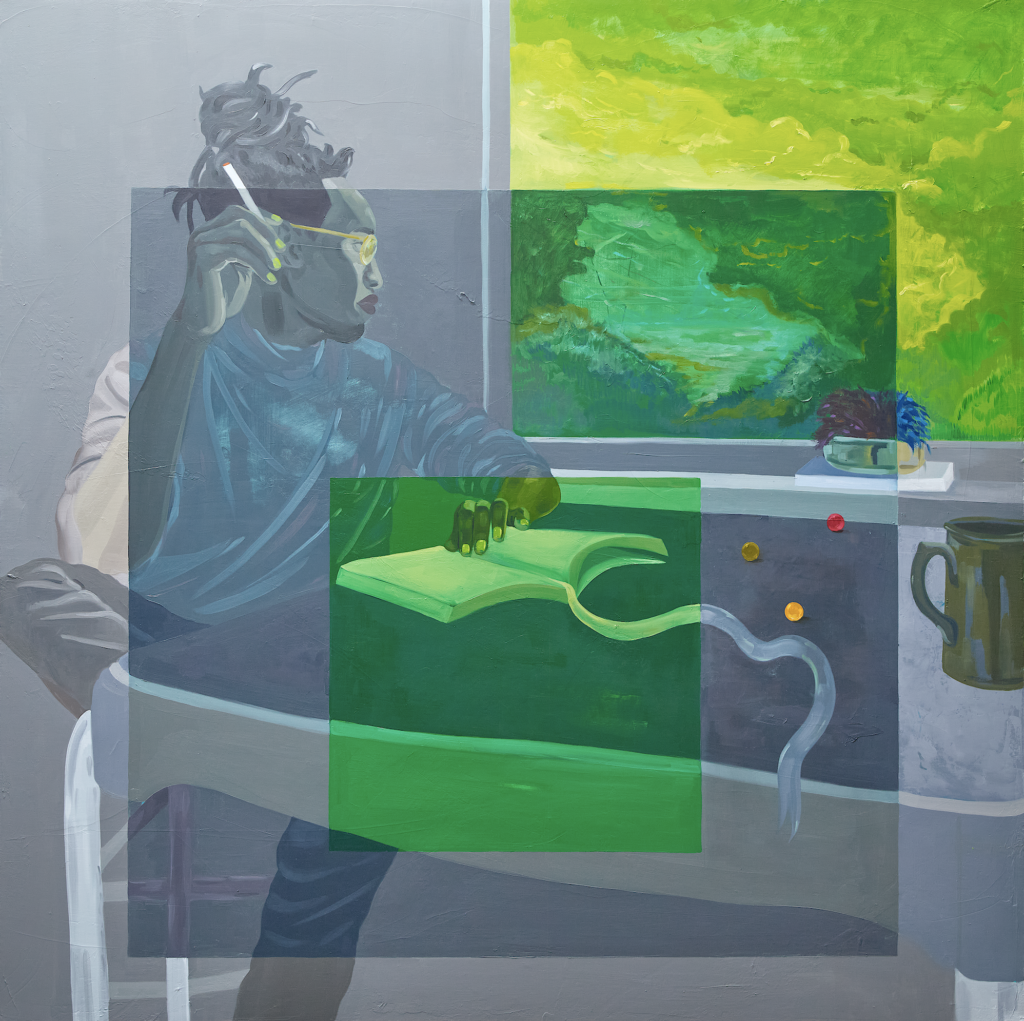
NB: What are your thoughts on figuration and abstraction? We’ve seen the two approaches intersect really beautifully in your work, particularly in the After Albers series. It would be great to discuss this from an art historical perspective.
DC: When I first started painting, I took foundational courses which focused on painting from observation. While at the Milwaukee Institute of Art and Design, I made a lot of minimalist, abstract paintings. My paintings were just one color; they were all about my relationship to color. There was no image, the work was all about surface, color and very objective approaches to making a painting. As my process evolved, it made sense that the abstract elements followed me into my figurative work, even if you consider my relationship to the color in my current paintings. It’s certainly a byproduct of my past investigations and love for color and color theory. I understand I can capture a color without too much fuss – I’ve been exploring color for such a long time. With regards to the After Albers series – they take inspiration from Josef Albers, the modernist painter, and his homage to the square paintings, in addition to his theories concerning color. I think that in society, we kind of treat bodies like abstractions anyway, so, for me, there was this beautiful symmetry between our bodies and what we perceive to be our identities — as our identities are contextual. Josef Albers’ investigation with color, and color being a product of relationally; Our understanding of a given color is relational. The idea is, that if you were to orient two colors next to each other, they could influence one another and consequently affect the eyes’ ability to interpret what it is that we’re looking at. The two colors can change; they could even create a third color entirely. In a way, we are like those colors and I found that my body and my identity function very similarly. My Blackness has a particular cultural and social specificity attached to it in the context of America. But if I were to go to Africa, my body would be read in a very different way; because the racial logics and paradigms are different. Art historically, that’s where I was pulling from, but merging the concerns and examinations of Josef Albers’ objective exploration of color relationships with the contemporary concerns surrounding identity politics that we’re all currently negotiating.
NB: I have never heard anyone speak to Albers and identity politics in such an artistic way.
DC: When it comes to the figurative works, too, I am utilizing palettes from Josef Albers paintings. I’ll have a stack of color swatches, I have hundreds of them. I try to get the colors as correct as I can, as close to the Albers paintings as I can. They’re not in front of me, of course, so I have to rely on my own color sensibilities. I’ve studied the history of color, in Marcia Hall’s book Color and Meaning, and brought in different painting strategies that I thought, within the high and low Renaissance, would compliment the modernist aesthetic of Josef Albers, or, as it relates to my paintings. Josef Albers paintings are singular swatches of color, mine are figurative, which means that the use of color would be expansive. I thought to myself “How can I create harmony with color that creates a dynamic image but doesn’t lose the monochromatic flatness of Albers painting.” So I started thinking about different modes of painting such as unione, which is used, historically, to create harmony while not losing the chromatic integrity of a color. It has been good for me to think of the color spectrum that Josef Albers was working with — for example, Albers paintings are three colors. Of course, when I engage with a body, there are different shadows and shapes that compose the body. Utilizing unione makes the most sense for my approach in solving that problem, because you’re creating harmony. You would work from the middle of a color, and you expand out. They are drawing a contrast in those paintings. If the outer rim of a Josef Albers painting is a teal blue, or an ultramarine blue, utilizing unione, I can work from that blue and create a sense of harmony so that the product the viewer sees in my paintings, still looks as though it is a solid, framed color.
Basically I minimize the color spectrum, to a degree so that there aren’t any jarring contrasts. It’s great for getting a huge range of values for something as flat as [one specific shade of blue]. That is one way I’ve been approaching it, along with maintaining a more critical eye for how I am building out the figures as they relate to, or are an homage to, the square composition. Sometimes the figures are sitting down, because I am thinking about their arms, and thinking about how their body can create a shape within the square format, as well. There is also this play between the body itself becoming a form of abstraction. If you consider a painting like After Albers (Seeing Through the Dark), you’ll notice Kevin’s body becomes a triangle, in a sense, because we’re looking over his shoulder.
NB: Is that Kevin Brisco?
DC: Yes, it is! In the most recent After Albers painting I did, Seeing Through the Dark, you’ll notice that Kevin’s body becomes a triangle. There is a play between both the figure and ground reversal, as well, but utilizing the body also to add an extra element of abstraction to the painting.

NB: Could you speak a little bit about how that color theory process also extends to your Wash paintings?
DC: The Wash paintings were born out of my interest in this idea of the ‘veil’ that W.E.B. Du Bois talked about in his book The Souls of Black Folk. In addition to depicting images of black leisure, I am also concerned with critical history, art history and literary narratives. A lot of my work considers surrealism, and its literary counterpart magical realism. Because I often see the Black experience as being a surreal one. When Du Bois talks about the ‘veil,’ it’s essentially this metaphorical illegibility that’s cast over your character. This ‘veil’ is the curtain that separates the black subject from others and disrupts the opportunity to engage with said subject on equal and fair terms. For Black individuals, it is our skin that alerts others that we are different. A similar proposition, I think, can be applied to women: it’s also their body; it’s their gender. Often when men encounter them, their gaze is filtered through a patriarchal lens and consequently prohibits them from engaging with who that woman, as a person, could possibly be. Still, you don’t see the veil; you experience it. But through the lens of magical realism you could see it. That is what the Wash paintings attempt to address. You engage with these paintings that are these depicted scenes, but the splatter and the abstraction that ruptures the overall image is what we are engaging with, so, in a way, we are engaging with that ‘veil’: that illegibility, that curtain, that thin layer. When I make the Wash paintings, I’m using my body. I’ll often fill buckets of paint up and I’ll pour the paint on top of the painting, or I’ll slap them off; they’re much more physical. They have a different relationship with my body than the Primary Magic paintings or After Albers painting, which have a stronger relationship to my mind, because I’m thinking more (in terms of color theory).
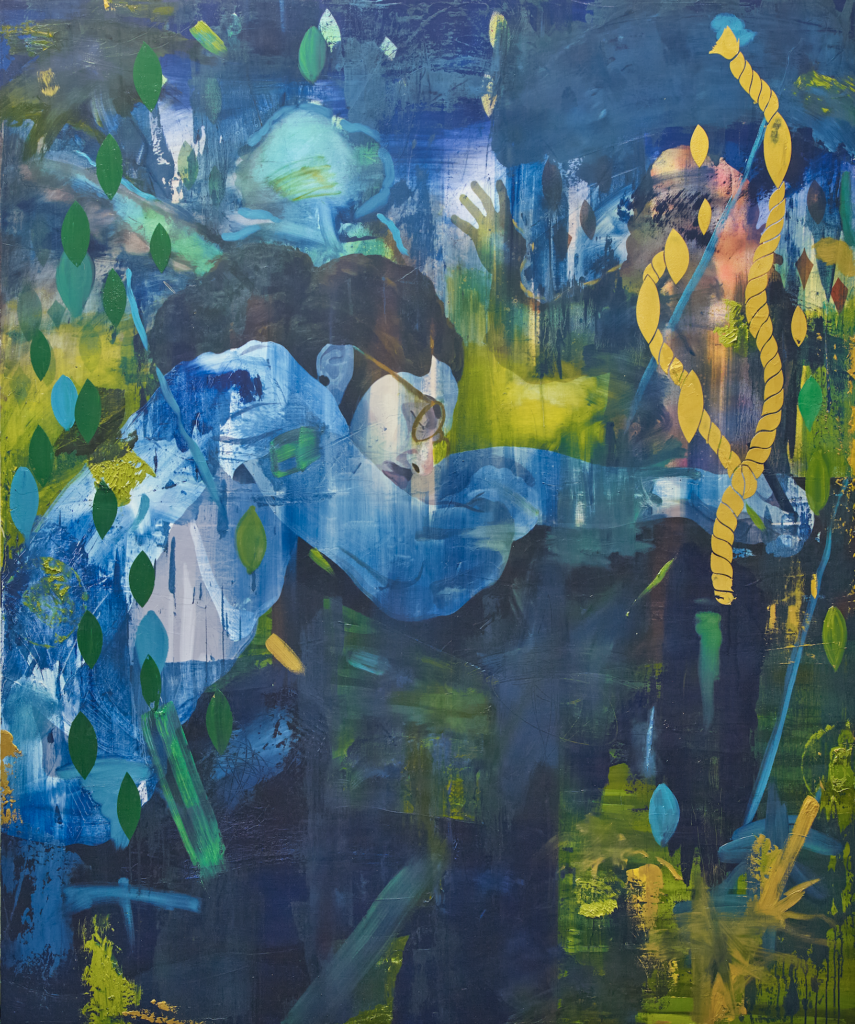
NB: Are there any upcoming projects you’re excited about? Also, I understand that you’re a collector. I am curious to learn about your thoughts for the remainder of 2021 in both areas.
DC: I have a solo show at the Luce Gallery in Torino, Italy. The title of the exhibition is “Life and Its Ghosts” and it is about my shift in reality. Over the course of 2020 to 2021 I have been struggling with this dramatic shift that has happened within my reality, both in response to Covid and my growing profile in the art world. I found myself navigating new spaces and engaging with very different people. My external reality has also changed; I never imagined I would have a studio such as the one I have now. But I am still haunted by the ghosts of my past; life and its ghosts. I can’t escape it; I have a lot of anxiety. I use that word ‘ghosts’ specifically, and it’s because a ghost is something that has the potential to be encountered again, there is some kind of veracity to it, there is a body or presence to it; and that’s what my past has been for me. It still somehow lingers within my everyday life, despite my leaving St. Louis; despite being in the later half of my 20s. The show will negotiate those things, amongst other familiar concepts I’ve been working with.
Collecting, for me, is really important. I really think everyone should be a collector; artists are cultural producers. When you are collecting, or when you’re going to a museum, you’re collecting someone’s intellect; you’re collecting that mind. When you go to a museum, you go there to learn, right? You’re engaging with the intellect of all of these great artists across the spectrum. For me, I am a lot less concerned (and I know the market is huge) […] Black figuration, Black portraiture, and more recently Black abstractionists who are starting to get a lot more attention, too. As a collector, I am less concerned with those kinds of trends. For me, I want to know what your research is, I want to know how an artist reads their subjectivity. I want to know how an artist considers their own relationship to the world. When I reach out to a gallery to inquire about a work, the first thing I ask is: can I read the artist’s bio, can I see their CV? Is there any writing around their practice? Because, if I want to champion you, or if I’m going to invest in you, I want to see what you’re capable of doing. I want to invest in your project, that’s my role as a collector. I want to invest in your ideas. For me, that is the thing that fuels my own collecting. I have a very uncompromising eye, so I don’t collect everything. Because I know everything is not great. I also understand that the market is very fast-paced and with the pace the market moves at, that oftentimes forces some artists to produce things they might not necessarily be the most proud of, but they’re trying to feed the market because, you know, we all have lives and bills to pay. A small sacrifice to keep things going? But, as for myself, I really do believe in collecting what you love, but also maintaining a very critical eye to what you’re going to be living with. For me, as a collector, I think about that quite a bit.
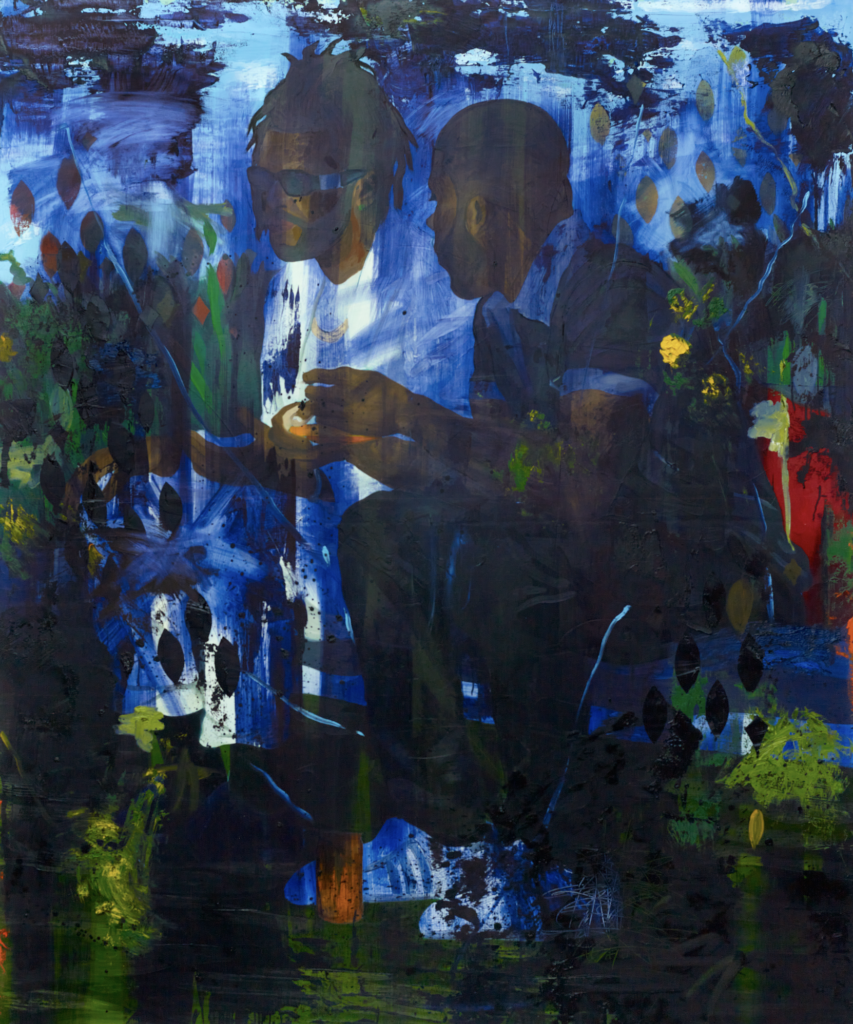
NB: Could you share what you’re reading at the moment? What’s on your nightstand now?
DC: At the moment I’m reading a couple of things: On Earth We’re Briefly Gorgeous by Ocean Vuong, The Daily Stoic by Ryan Holiday and Stephen Hanselman, and Quiet: The Power of Introverts in a World That Can’t Stop Talking by Susan Cain. Quiet was recommended to me by a friend and I’ve been enjoying the writing quite a bit. On Earth We’re Briefly Gorgeous is an incredible read! The writing is so rich. I read the Daily Stoic everyday, or at least I try to. There was a time when I was beginning to feel quite comfortable with my grief and sought out something to read, mostly as a temporary distraction and I came across a book on stoicism called the Meditations by Marcus Aurelius and I fell in love with its philosophical teachings. From there I ordered the Daily Stoic and haven’t looked back.
April 20, 2021
Artist to watch
ELISABETH KLEY
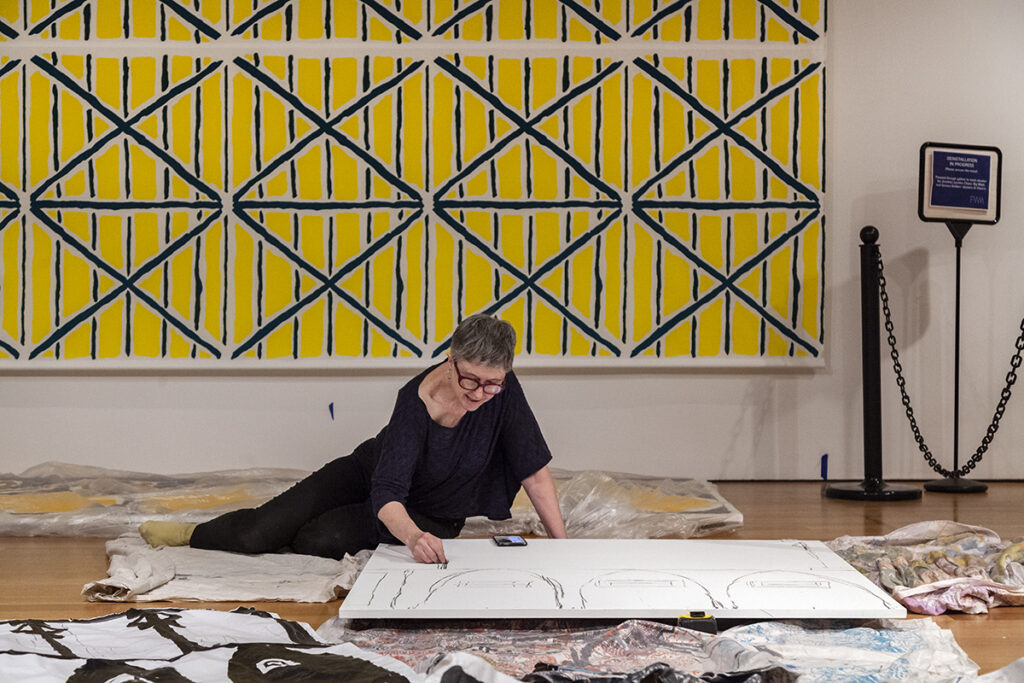
NB: Could you share with us your story of how you got started working in ceramics? Who and what inspired you?
EK: My start in ceramics was serendipitous. My husband wanted to start making terracotta sculptures. We needed to learn how to use a kiln, and decided to take a class at our neighborhood pottery school. The class didn’t fit my husband’s schedule, so I took it on my own. I had recently been inspired by the beautiful historical ceramics in the Musée de Sèvres, just outside Paris. Light poured into the galleries and the pieces all seemed to glow. I really liked the way the artists painted on the ceramics — the touch was so effortless and fresh. I thought perhaps I would make dishes to use, but I never did. Instead, I made small sculptures and vessels and my work went on from there.
I think a lot about world culture and art history. I am inspired by ceramics and textiles from Central Asia, Turkey, Syria and Japan. I also find inspiration in textiles from Samoa, Roman frescoes and mosaics; Ancient Greek and Egyptian art; Coptic, Indian, and Wiener Werkstätte fabric design; and Ballets Russes sets and costumes. Artists I look at are Matisse, [Aubrey] Beardsley, Annie Albers, Leon Bakst, Natalia Goncharova, Kees von Dongen and Beatrice Wood. Also, for more contemporary art, I admire Nick Mauss, Paul P., Marina Adams, Marc-Camille Chaimowicz, Chris Ofili, Etal Adnan, Kai Althoff and Betty Woodman.
NB: Can you tell us a bit about your studio process, and provide us with some insight as to how you develop the patterns and marks in your ceramics?
EK: I like to travel and go to museums. I have my iPhone with me, and I take hundreds of pictures. When I get back to the studio, I go through the images and make drawings in pencil and ink of whatever catches my eye — mostly abstract shapes and small details I find in pottery and textiles. I also use drawing to figure out shapes for the ceramics.
I make most of the ceramics out of slabs. I put the clay through a slab roller, cut the slabs to size and assemble them into three dimensional shapes.
Most of the surfaces are flat, so once they have been fired (to make them strong), I cut paper shapes the same size of each flat surface of the piece, paint different designs on the paper and tape it on the sculptures, as though I am dressing paper dolls. I keep changing the drawings until I come up with what I want.
After that, I paint the piece with white underglaze and I draw the design once, followed by a second coat of white underglaze, another better drawing, and a third coat of underglaze. Next, I paint wax over the places that will stay white and when the wax dries I put cobalt blue stain and black underglaze on the unwaxed areas. The pieces go back into the kiln; the wax fires off, and the design is set. Then I glaze them and fire on the glaze.
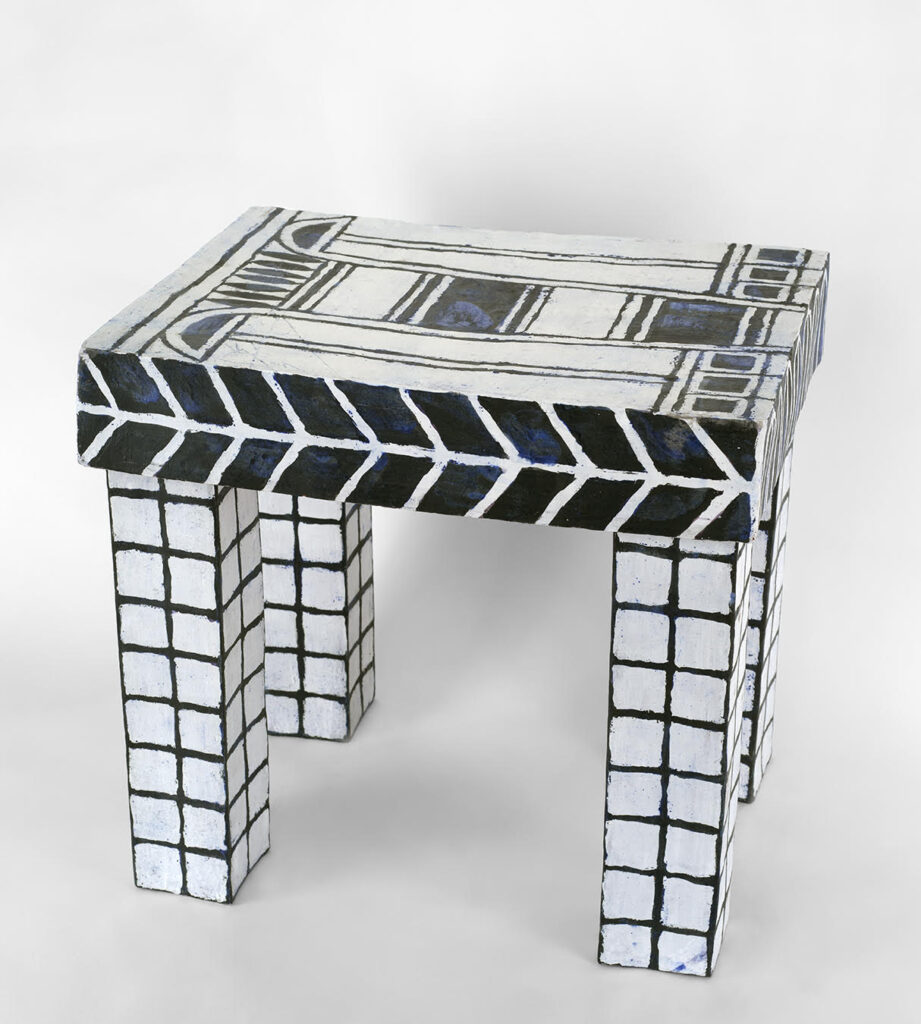
NB: How long does your process typically take?
EK: It took around eight months to make and decorate the eight sculptures included in the show at The Fabric Workshop and Museum. It takes a day or two to roll the slabs for each piece, another day or two to assemble the slabs, and then the sculptures have to dry for a few weeks before the first firing. Finding the right painting for each piece takes as long as it has to. The fabric took several months too, as I did a lot of different watercolor drawings before choosing the three final designs.
NB: Wow, that is fantastic! I’d love to hear more about Fountain with Arches and Nautilus Border (2019). How long did it take you to make that work? Can you tell us a little bit about how the work came to be? And — congratulations, it was acquired for the Whitney, which is very exciting! I remember seeing it in a gallery, and being blown away. I am thrilled it landed at such an important institution.
EK: I have known the artist Tabboo! for a long time and liked his paintings. I went on a trip to Rome and Naples with my friend Jacob Robichaux (who founded the gallery Gordon Robichaux with Sam Gordon, and represents Tabboo!). We went to the Naples Archaeological Museum, which is filled with the Roman frescoes removed from Pompeii. I have done several site-specific wall paintings for exhibitions, and Jacob and I started wondering what Tabboo! would do if he painted a mural. We dreamt up a show that would have a room with Tabboo!’s colorful wall painting on one side and a room with my black and white wall painting on the other side. I made the two fountains for the longer, rectangular space between the rooms, in front of a wall that was covered with Tabboo!’s blue/green drawings of plants with words. It was our version of a Roman garden. Jacob helped me construct styrofoam models to get the proportions right for the fountains. Then I made them, which took a few months.
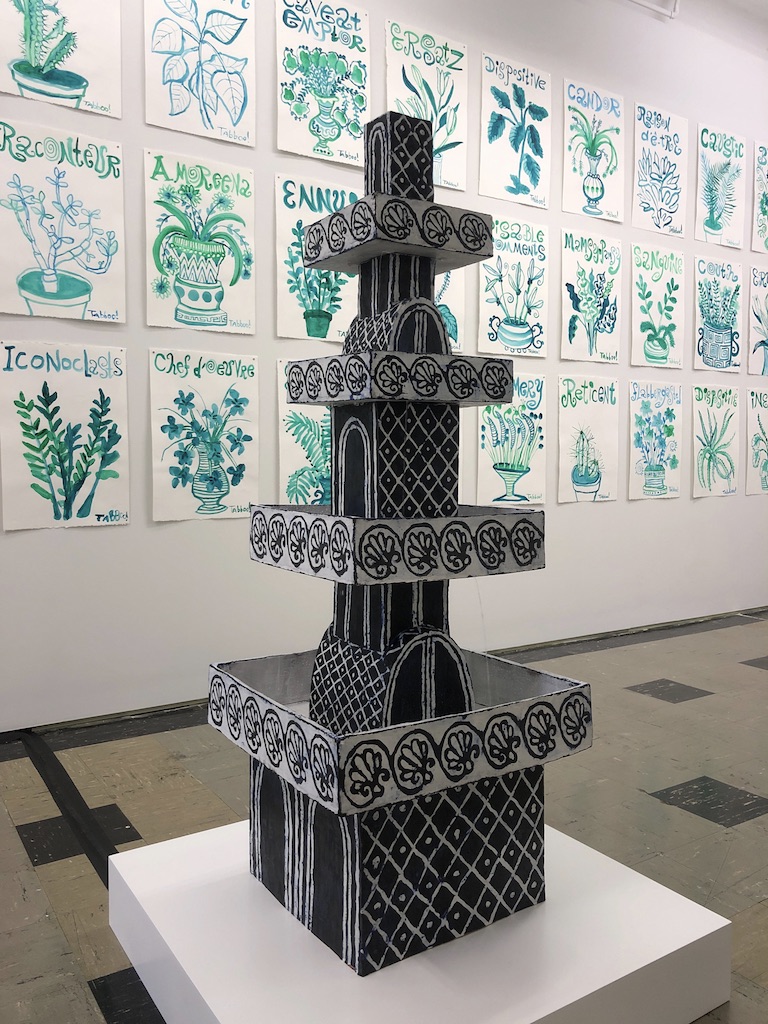
NB: Who did the plumbing work?
EK: Jacob! I sent away for the pumps, and the plumbing is quite simple. But since ceramic shapes can change during firing, it was a challenge to get everything level so the water could flow equally on each side. Jacob was patient enough to figure it out, using wax and coins to adjust.
NB: Was there ever a time when you were making your fountains that, due to inconsistency in ceramic, you had to start again?
EK: Yes. The big basins at the bottom were the hardest. I tried glazing the underside of one, but when I took it out of the kiln (it had been fired raised on stilts at the corners) it had sagged and bent; it wouldn’t sit level. I had to re-do that piece and leave the bottom unglazed.
NB: Why don’t you tell us a little about your exhibition at The Fabric Workshop and Museum in Philadelphia, Minutes of Sand? And what the title means.
EK: I have the catalog from a really wonderful Alfred Jarry show at the Morgan Library last year (which I actually missed because of the pandemic). I love Alfred Jarry’s woodcuts. The title is taken from his first published book, Les Minutes de Sable Memorial (Memorial Minutes of Black Sand). I had been thinking that I would maybe use some of his designs for my ceramics, but I wound up sticking with Egypt as my source because there was so much more to work with.
The show came about because the curator, Karen Patterson, had seen my work at the Independent Art Fair in 2018. I had done a solo booth with my gallery Canada, including ceramics, paintings on cloth, drawings and wall painting. When she started working at Fabric Workshop, she invited me to come and make colored silkscreened fabric and exhibit it with my ceramics.
I came up with a lot of ideas for the installation. I wanted the color to move through the exhibition. The fabric was silkscreened with three different designs, so there are three wall hangings, and three lengths of fabric placed on low wooden platforms, like rugs. There are also pedestals that I designed, in special shapes. When I arrived in Philadelphia for the installation, I did black paintings on the blank areas of the floor platforms and also on the pedestals. There is also a screen, with fabric on one side and black painting on the reverse.
NB: A lot of your work is in black and white, where did that come from?
EK: I always used color, but I also made black and white ink studies for my ceramic designs. In 2014, I decided to try making the ceramics black and white, and got so interested that I’ve been doing it ever since. There is endless variety as I change the proportions of black to white. I’m also fascinated by reversing positive and negative space. For a while, I made flasks that had the same design on both sides, one black and white and the other white on black.
NB: It’s a really big hit and has become your signature style!
EK: Yes!
NB: Is there anything coming up that you’re able to talk about, in terms of shows or new bodies of work? Could you share with us a glimpse of what’s to come?
EK: I haven’t had a show at Canada since 2016, so I am working towards a show there in the not too distant future. I’m hoping to come up with new shapes for the ceramic sculptures, and another complex installation.
NB: Congratulations on your show opening in Philadelphia! I absolutely adore your work and I am so excited to be able to share your story and share your works.
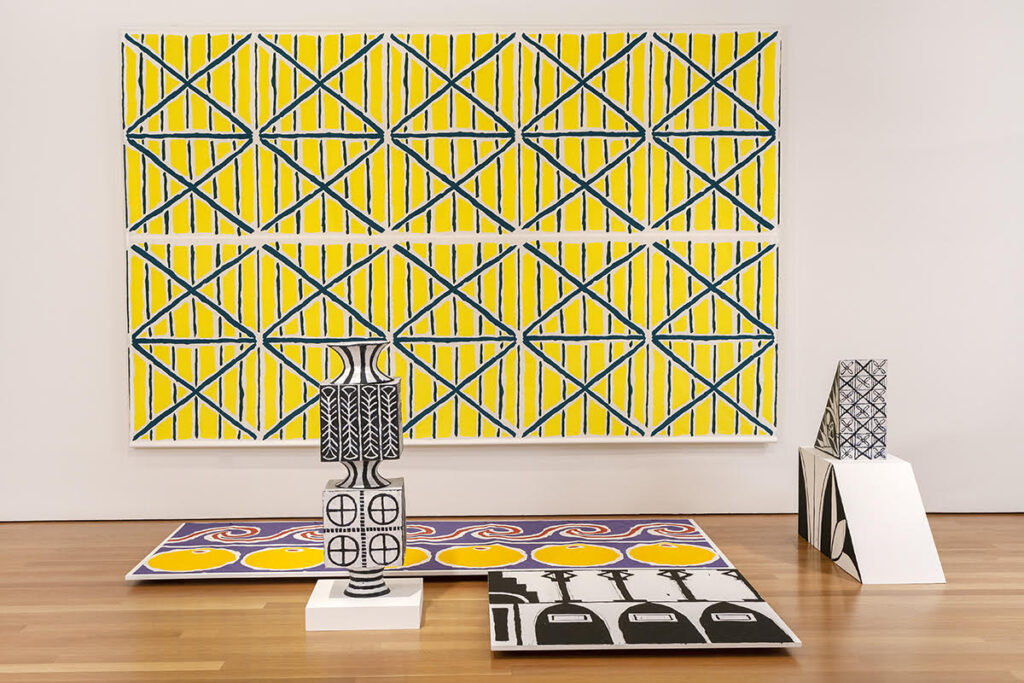
March 24, 2021
Artist to Watch
Ilana Savdie

NB: You have been working at the prestigious NXTHVN Residency in New Haven, Connecticut for the past year. What has been your greatest learning throughout this process? Can you tell us a little about the ambition and purpose of the residency?
IS: The residency is in year two, so it’s still growing and evolving. The main ethos that seems to permeate is about creating a space where very early career artists can receive the kind of mentorship that is otherwise hard to access. It was founded by Titus Kaphar, he makes a great effort to unlock a lot of the ‘secrets of the trade.’ There are many things that are withheld or passed down only to an elite few in this world and Titus really wants to create an environment where that process is democratised in a different way. I’ve learned a tremendous amount about what it means to engage with the people that give me the platforms to share my work, such as galleries and collectors while retaining my sense of self in my studio so I can continue to think about how I make my work, about painting, and about my place in the history of art, if I get the privilege of having one.
We learn how to engage with people that actually have power in this industry in a way that someone, early in their career, has not experienced yet. It has also been a discovery process for myself and realizing that actually I do have power, and it turns out, a lot more power than I originally thought — that shift was a big one for me. Artists have a lot of power if we just talk to each other, if we communicate our experiences, I believe this is what helps takes the keys away from toxic people. And in a more personal way, I have learned very much about what it means to trust my own instincts, both in my work and with people.
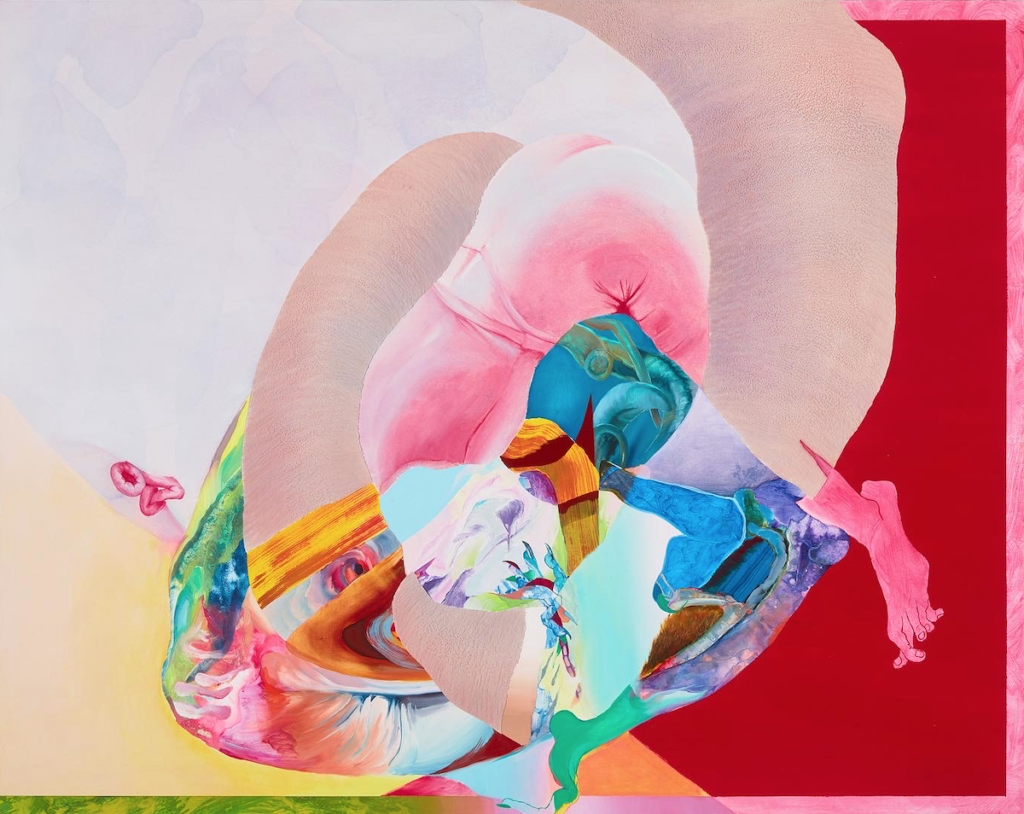
NB: So NXTHVN really provides that supportive environment that can really prepare artists as they transition from the institution of the university to the art world, and it provides that business experience, expertise, and insight to how the art market and its players interact and how you can best work with them?
IS: Absolutely, there’s definitely an understanding that this is your job, and there is no shame in acknowledging that you want to live off of it. For some reason, people like to shame artists out of financially supporting themselves through their own work, and I don’t subscribe to that. To each their own, but I think at the end of the day we all need to pay for health insurance in this country, at the very least, not to mention that making art is expensive. Everybody has a different way of approaching their work. But money is exchanging hands, going into someone’s pocket, I believe in the artist getting to have a pocket. In order to get there though, you have to know what it is that you’re working with — whether you want to make changes to the industry from within, subscribe to it and perpetuate it, or burn it all to the ground. Whatever it is, this is the [art] market and this is how it works, and NXTHVN is definitely a place that doesn’t shy away from the uncomfortable conversations about what you’re walking into.
NB: Last time I was at your studio, I got a glimpse into your powerful new body of work and we talked about how you tapped into your childhood memories. Do you want to tell us a little about that, and specifically about the character that features throughout?
IS: I grew up in Colombia, as did my mother and most of my family, yet nationality has always been a complicated subject for me. My family is all Jewish and from all over the world, so they ended up in Colombia as a result of many different diasporas. My father is Egyptian and my mother is Venezuelan, but her family is Romanian and Polish, and all were expelled or escaped from their respective countries, so I actually have a very complicated relationship with the idea of heritage. I have a very personal relationship, and a very acute relationship, with what it means to grow up in a place, to leave that place, and to have it exist as memory, the uncanny feelings of having home be both familiar and unfamiliar.
The experience of placelessness is a big aspect of my work, and informs how I approach any sort of ‘truth’ in the paintings. My work doesn’t deal with any particular nationality because I don’t really have one— landscapes and geographies do not really apply to me. With that in mind, I was deeply impacted by the experience of growing up Colombian, and specifically growing up surrounded by the Carnaval de Barranquilla, which happens in my hometown every year. Barranquilla is the city that hosts the second largest carnival in the world so while it’s only three days a year, it leaks into the culture of the entire coast. The ethos of the carnival has had such a strong impact on who I am, who I grew up around, and how I approach things. The idea of resisting and flipping social norms, of using the exaggeration of the body as a way to mock, to resist, and to protest oppressive boundaries; the grotesque body and idea of ‘the uncanny’ as an access point. All these things that are true to the carnival feel true to how I approach my work. These are themes and acts that I’ve located myself, my identity and my experience though, and they’ve permeated my work, through color, in a major way. Lately I’ve been working with the features of marimonda, a prominent figure of the Colombian carnival, which always fascinated me as a child. I use the features of the marimonda, which are big eyes, a floppy nose, big lips, which are said to be the combination of a number of different animals but it has this really phallic appearance; it looks like human genitalia, it is really strange. I bring in these features in part to locate figures in the work. The origin of the costume is said to have been a way to mock the oppressive elite of the time. Of course, as with any kind of folkloric history, it is passed down through word of mouth, so a lot of things aren’t historically concrete, but that’s the way it’s said to have been. In recent years it was brought into the carnival, so I am also really interested in its history, and it’s evolution.
NB: Tell us a little about your exhibition at Deli Gallery where you just had a sell out show, congratulations! Can you speak to that body of work, and how everything that you’ve just talked about translated into the show?
IS: My work deals with the body in all its different states, that includes all the things that live on the body. It poses the question of: who gets to have a body? What constitutes a body, and where does it start and end? If we are our bodies, we are also all the things that live on us — we are our viruses, our parasites, we are everything that threatens and consumes us; we are in a constant state of flux. The original idea was for the show to be a series of small paintings, all around 16 x 20, focusing on the microscopic bodies as the real estate in the paintings. As I started to develop this work, I realized that I didn’t feel ready for a show that only focused on that because I’m still at a state where it’s about the simultaneity of all bodies and organisms and identities coexisting and propelling power as they locate home, history and heritage. The show very quickly became about focusing on that process. I’m thinking of the way I make these paintings as creating paths for these bodies, and then derailing those paths. I’ve been thinking about this show as that process of derailment, and really showing different elements and different moments of that process throughout the space.
NB: The deconstruction of the body has been a theme in your work for a long time, since I first met you, including plastic surgery techniques and how they could be incorporated abstractly into painting. The way in which you approach the body is so fresh, and then your use of the color palette on top of that is gorgeous. I have the pleasure of living with two of Ilana’s works.
IS: Yes, that’s true you have two different stages in the evolution of this work! I think this concept is definitely something I am going to work with for a very long time. I don’t know how to exist in the world without being fully aware of my own body at all times. I think it comes from always feeling that I’ve been given a box that was too small, a chair that was too small, or a boundary that was too small. Being told — in the context of my body and my identity — to take up as little space as possible; I am never not aware of how I spill out. I’m going to call that a huge privilege of having a big body: I get to know my environment more, I get to know every space I’m in, and I get to make these paintings from that [experience]. I am always going to break it down. I am always going to break down the body because it doesn’t make any sense to me.
All the figures in my work are multiple figures, and they’re also all the same figure. That is what I mean by ‘untruth’ — the process of one ‘truth’ ‘untruthing’ another, but also never really allowing for that to happen. There is always going to be more than one body, but it’s just a matter of what constitutes a body. But then, at the same time, I consider them all the same body and also all real estate for more bodies. There is a constant in that they all have the same features but aside from that I don’t isolate into a gesture. I try to use as many different ways of thinking about and applying paint as possible, so I don’t separate figures from environments. I don’t separate figures from each other through gestures, so it really becomes about how I like to have [the work] constantly delivering different things the more time you spend on it. As soon as you decide that you’ve found something, it’s derailed, and you’re somewhere else. I want that to be a constant spinning wheel or something.

NB: What’s next for you? You just mentioned that this is an area you’re going to continue to work in for a while, are you planning to expand this series? What does life after NXTHVN look like?
IS: Yes, I am actually working toward another solo show this year. This one is going to be at Kohn Gallery in LA. I am going to say it’s a continuation of this series, for sure, because these are works that I have been doing simultaneously. They are going to be larger paintings. In larger spaces, I am able to expand on the figure much more. I like to think of the body as real estate for more things, more bodies, more gestures and more textures. More space for these bodies, and more bodies for this real estate. So I am excited about that, that is sort of the focus at the moment. So, post-NXTHVN it’s going to be about continuing this work!
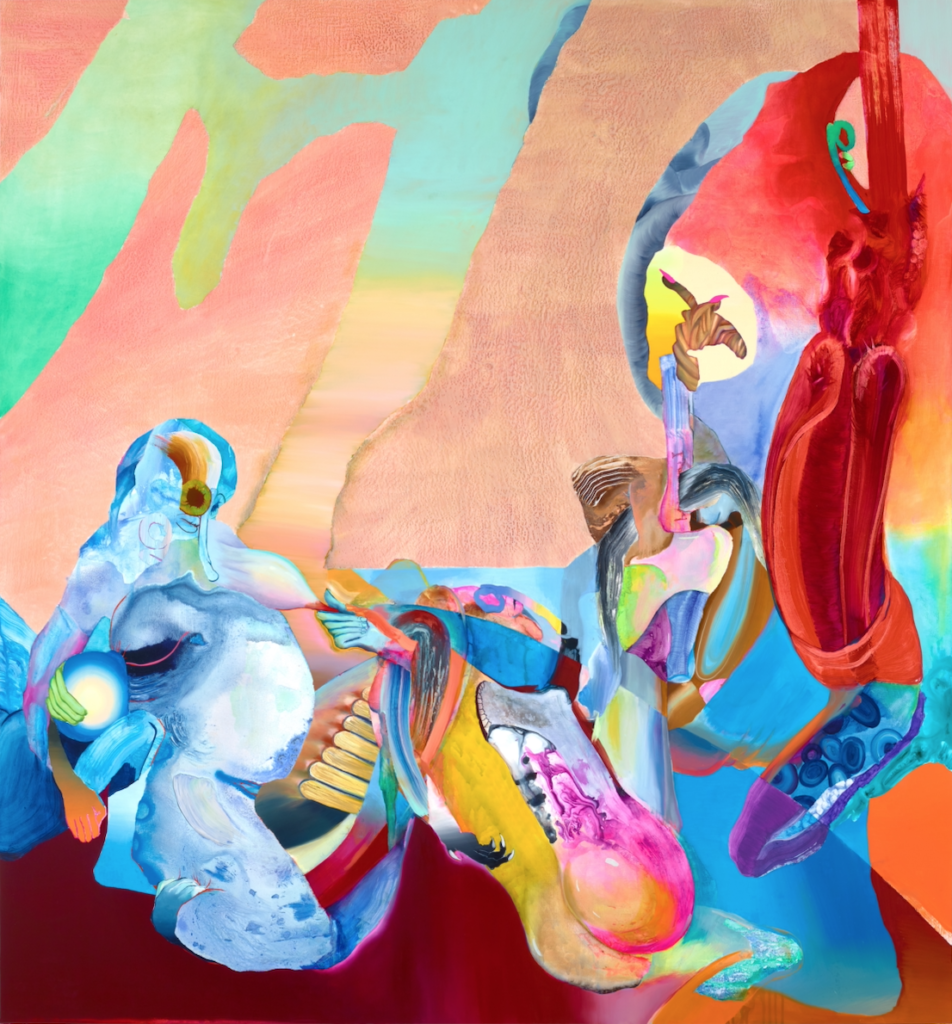
February 16, 2021
Artist to Watch
Kevin Brisco:
Kevin Brisco:
Beauty and Absence
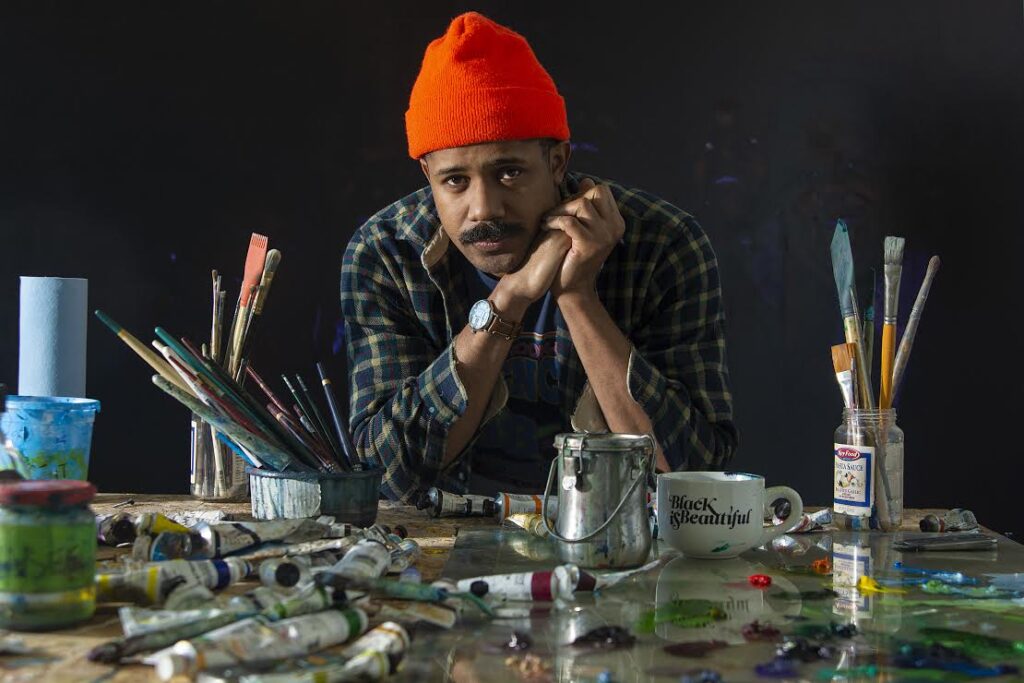
NB: Why don’t you tell us about your story up until you were accepted into the Yale MFA Program?
KB: I was born and raised in Memphis, Tennessee, same house 18 years. I grew up in a very religious household, Seventh-day Adventist and Baptist. So I would go to church twice every weekend. From there I ended up going to undergrad in Connecticut at Wesleyan University. I was originally studying Political Science and Arabic and was convinced I would be a Foreign Service Officer. Low and behold I ended up taking art courses and found my passion. This is where I was willing to stay up all night to get the work done. From there I moved to New Orleans, where I worked in the film industry as a lighting technician. It was a wonderful gig, where you’re on set for a couple months and you have enough money for the year, so I could keep painting. I really enjoyed it in Louisiana. I was showing and receiving attention for my work. I had the feeling that “Ok, this could be a successful career.” However I felt that there were still a lot of gaps in my knowledge. There’s the things you know you don’t know and then on top of that there are the things you don’t even know you don’t know. I figured it was as good a time as any to reapply to grad school. It was my second time applying. I applied to Yale after undergrad and was waitlisted after a difficult interview experience. The second time I interviewed and had a much more generative experience. In the span of a 30 minute interview the two professors asked questions about my work that I had never considered. Finally I was excited at the possibility of attending because here was a place that I could undoubtedly learn some things I didn’t know I didn’t know.
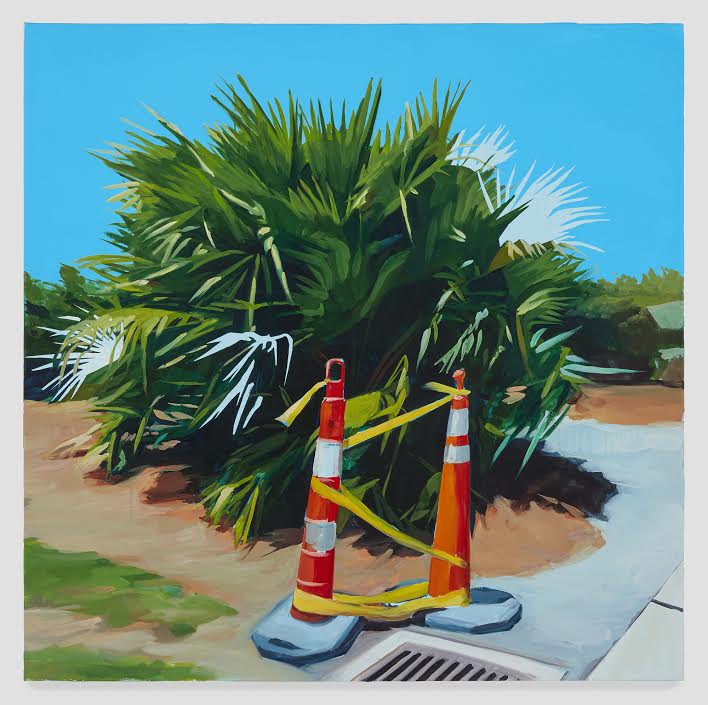
NB: What types of themes do you explore in your work? How has your journey of growing up in the South, going to school in Connecticut, and working in New Orleans contributed to your practice in the last two years?
KB: In the most simple sense, I’m interested in figure-ground relationships. Particularly the background of the South, the American U.S., and how written into the landscape is the history and narrative of the figures occupying it. It allows the space of imagination within the landscape. You aren’t immediately given the histories of the traumas but you can sort of see the history or legacy of it through the shadows. Light and shadow are also an important theme, and the conception around light being historically seen as knowledge, safety, and awe-inspiring. I’m interested in the idea that difficult things can still happen in broad day-light. Questions of joy and trauma are all wrapped into one. I think its Saidiya Hartman, a Wesleyan and Yale alum, she was talking about how she wasn’t interested in displaying outright trauma but rather the spaces where celebration and tragedy are so intertwined you can hardly separate them. I’m interested in this idea of light as both a harbinger of safety but at the same time, light casts shadows. You can’t have shadows without light. Light is intrinsically tied to falling out of view or being hidden.
NB: What really struck me in your work, particularly the pieces where the figure is absent, in the “Blue Series”, the freshness of the greens and the brightness of the blues, but the figure is missing. It’s jarring because it’s so fresh and inviting, yet there’s this history through the absence of the figure or through the homes or the landscape that’s gives it a darkness the viewer internalizes. Even though the painting is so vibrant and stunning, the trauma is internalized in the viewer but not on the canvas. It’s very clever.
KB: It’s meant to be a “spoonful of sugar”. It’s beautiful, inviting, bright, happy. But naturally in a lot of people there’s an idea of incredulity. Something’s up, something’s missing.
NB: Are there any writers, poets, or artists you’re looking at right now in the studio?
KB: Most definitely. I’ve actually been reading Dave Hickey’s first book, Invisible Dragon. He talks about how things should be beautiful. I felt that immensely when I went to Venice and visited the Galleria dell’Accademia to see the Tintoretto panels and Tiepolo ceiling paintings. It took me back. I was like “woah” this is inspiring. They’re from hundreds of years ago. From a time when people dedicated their entire lives – generations of lives – to making things beautiful. That’s a paramount goal in my work, I want to make beautiful paintings. It can still be beautiful and challenging.
NB: And it can still be dark!
KB: It can be dark! Again, spoonful of sugar. It helps you swallow some of the darker histories if they’re told in a beautiful way. At any rate I’m loving the book. The way he’s able to talk about how Caravaggio collapsed the space between the viewer and the painting. Even to look is to be involved with Doubting St. Thomas. To look is to doubt. The painting performs its ethos and message in its meaning. Some other artists – Hurvin Anderson, I’ve been looking at a lot. He won the Turner Prize a few years ago. Another person deeply invested in looking at background space and landscape to the point that he’s going over and over these spaces, redoing them, pulling them apart, reimagining them. And Patrick Caulfield, making these pretty paintings about composition and design in a very interesting sort of way. Other than that, I’m still reading Brothers of Karamazov by Dostoyevsky. I’ve been reading it for 7 years now. I’d gotten 500 pages in before grad school and put it down for a couple years, now I’m picking it back up. That’ll be a lifelong journey.
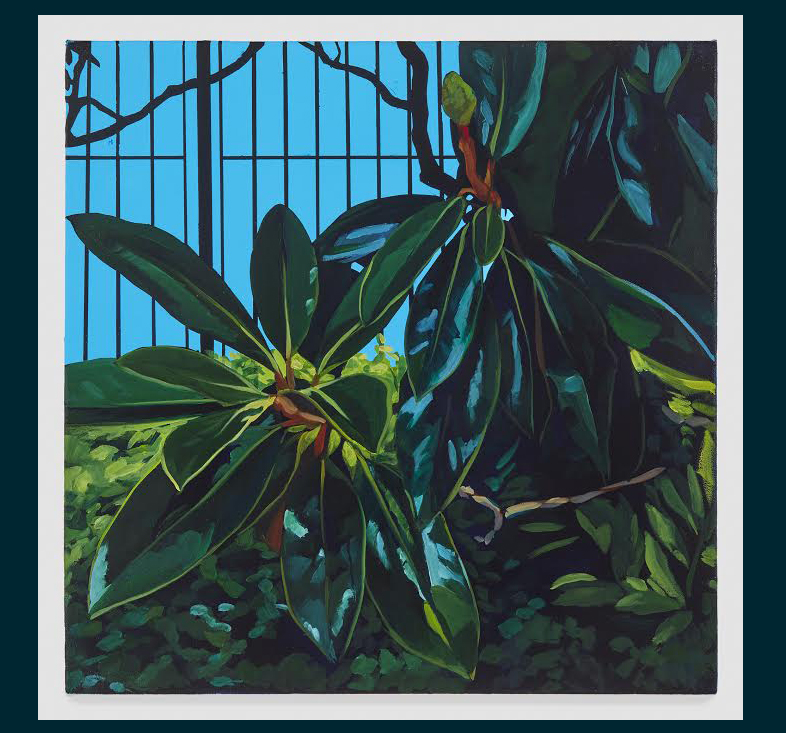
NB: Is there a body of work you’re focused on right now?
KB: I’m still fixated on the” Blue Series”. It hasn’t come to fruition the way I want it to. I want a complete show of these works. I have the title and I already know the organization, but I’m still working on building it up. Other than that, I’ve been working on a series of dark paintings, just playing around with how low of a value range I can work in. I think the two bodies sort of inform each other. In one you have the idea of the outdoors; the precarity and sublime of that outdoors tied to a radical blue sky, which is traditionally meant to connote safety, up against a series of works that are trying to convey intimacy and comfort in dark unseen spaces – which are traditionally meant to be scary or unsafe. It’s an inversion of traditional tropes of light in art history and culture. It’s not an wholly original thought: David Hammonds had that amazing piece where he blacked out an entire gallery and gave attendees flashlights that were impossible to use. To be seen is to be unsafe, and the safest point is in a corner in the dark where no one can see you.
NB: I think exploring the different levels of darkness in a series isn’t something you see all the time. Being able to find ways to interplay shades of darkness with some type of beautiful scene really plays against the notion we have in our minds that darkness is danger. I love how you’re exploring the binary of that darkness and light and how it plays on the viewer’s sense of safety and security and those traditional notions.
KB: I think also of the idea of wanting more, wanting to complete the picture with light. There’s a stoking of curiosity.
NB: And with that dark painting that you have, it invites the viewer to examine it closely to see how the shades are playing with each other to create that dimension. Do you want to talk about recent or upcoming shows?
KB: I was in a couple of interesting group shows towards the end of this year. “Voices” which was curated by Anwarii Musa had a really great collection of artists: Jeffrey Meris, Derrick Adams, Nate Lewis, my good friend Dominic Chambers. I was also in a smaller show in Brooklyn titled “American Socialist Realism” at Rumpelstiltskin gallery. I was shown alongside Martin Wong, Tseng Kwon Chi, Hannah La Follette Ryan and Clark Filio. I think the curators were asking interesting questions about figuration; placing realist figuration within the idea of propaganda. I think we can easily get locked into the idea of figuration/representation as an immediate celebration. Which isn’t always the case. You can represent terrible things. There’s various aspects of human life to represent. There are very important questions about who has traditionally been represented and a necessary redress of underrepresented bodies. But representation is complicated. Multiple poles can be brought into the idea of figuration.
NB: So you clearly have an inspirational story and I believe you’re destined for greatness. But what advice do you give to young artists? As a professor, what advice do you give to your students and to young artists figuring out if they should pursue a life as an artist?
KB: As an art professor, it’s funny how often this question comes up. I’ve had students come up and ask what they can do to become a successful artist. Sure take your work seriously, challenge yourself, but it really boils down to just not quitting. Don’t quit.

